Merlin Project Help
Download, Test & Subscribe
Welcome!
Thank you for using Merlin Project; the latest version of the leading project-management software.
This is the Merlin Project documentation for the Mac.
It will help you get off to a flying start, providing you with basic and further information.
|
|
If looking for documentation regarding the iOS app, please check Merlin Project on the iPhone and Merlin Project on the iPad. |
Help and support
Use the built-in help in the Help menu.
|
|
For further help and support, please visit the Support section on our website: www.projectwizards.net or email our support team support@projectwizards.net. |
System requirements
Merlin Project requires an Apple Mac with Intel processor and macOS 10.13 as a minimum.
Installation and trial period
Visit our website. This is where you will find all our products and further information.
Click Merlin Project.
30-day trial
Try Merlin Project for free and without restriction. The first time the program is started, the following message will appear.
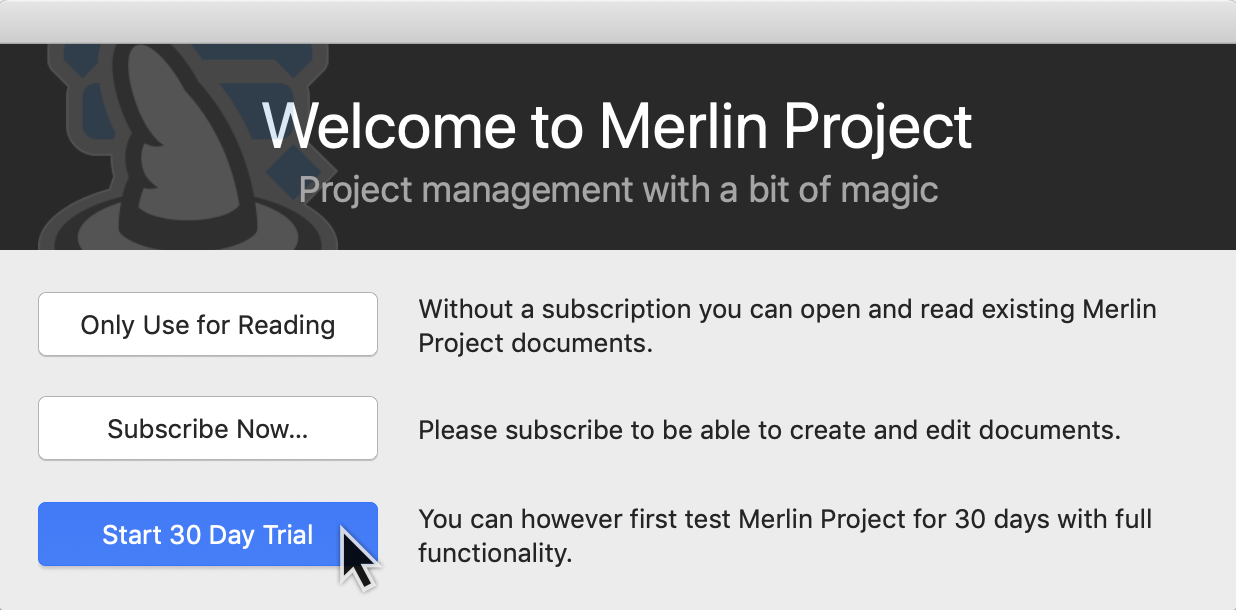
Click Start 30 Day Trial for your free 30-day demo.
The trial period allows you to test Merlin Project in full for 30 days starting from when you first launch the program.
During your 30-day trial period a notification will be displayed on the top right of the program window. This tells you how many days remain of the trial period.
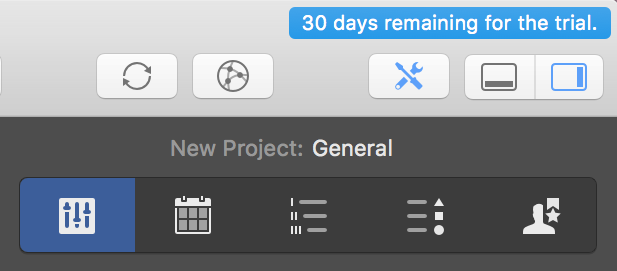
At the end of the trial period you’ll still be able to open and view project files, although you won’t be able to edit them. A subscription is required to edit projects again.
Subscription
If you start Merlin Project after the trial period, a Not licensed message will appear in the upper right corner of the main window.
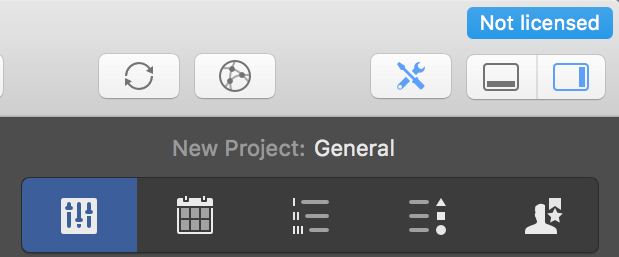
If you click Not licensed, the following window will appear.
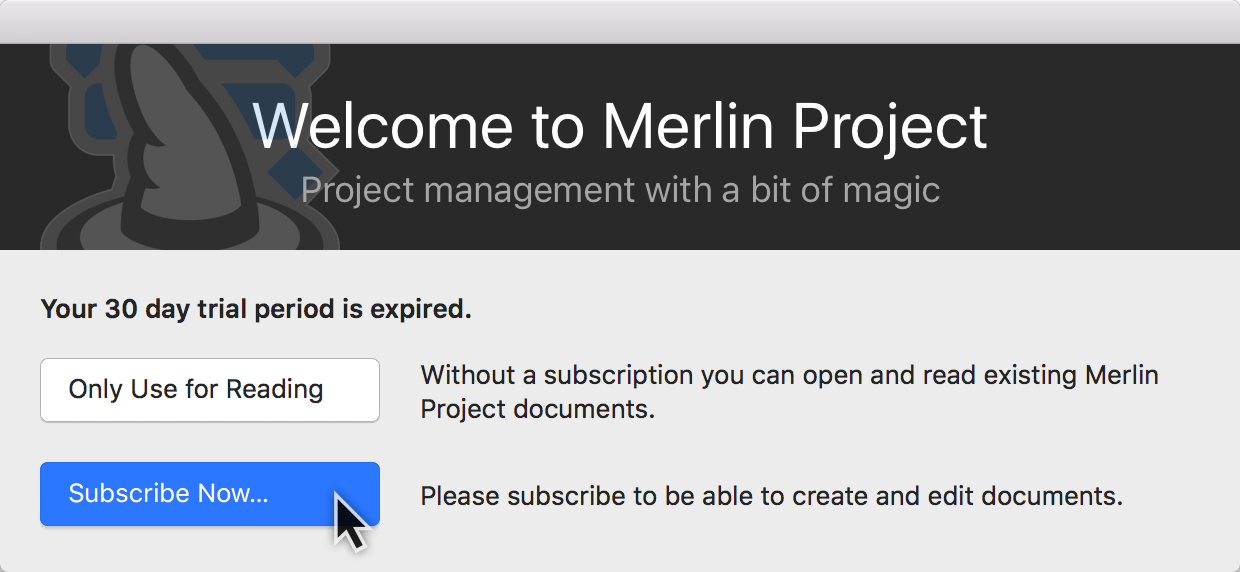
Click on Subscribe Now… to be able to create and edit documents.
Click Only Use for Reading, to use the application to open and read existing Merlin Project documents.
|
|
The Only Use for Reading option does not allow opening files of third party formats or the use of templates. |
Subscribe Now…
While your Merlin Project from our Website runs on trial mode, it will offer following options:
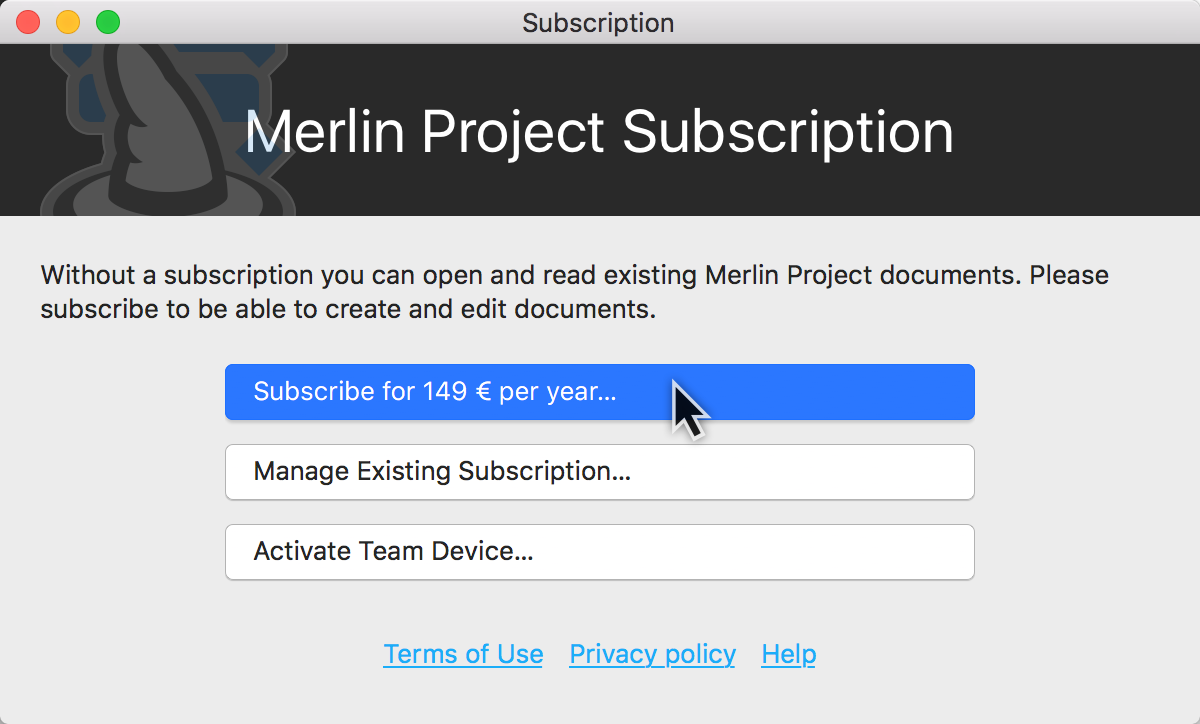
|
|
Volume discounts and central license management are only available if the software was downloaded from our website and not from the Mac App Store. |
|
|
Should you have an existing subscription, click on Manage Existing Subscription… and enter your email and password credentials. If you know your license number click on Activate This Device… |
To start a new subscription, click Subscribe for … .
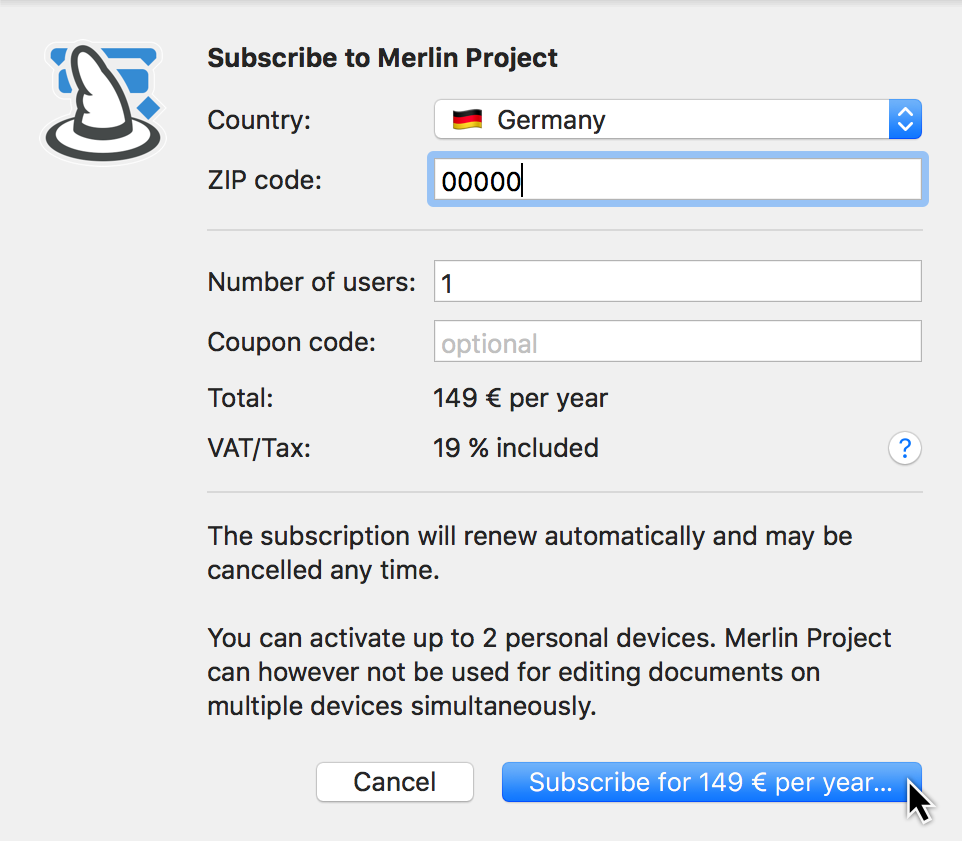
-
Select your Country from the drop-down menu.
-
Enter your Zip code.
-
Enter the Number of simultaneous users.
-
If you have a Coupon code, enter it in that field.
-
Click Subscribe.
Then enter a valid email address and set a password for the subscription credentials.
|
|
You’ll need your subscription credentials (email address and password) if you want to activate your Merlin Project subscription on another Mac. Please keep these details safe. And be sure to use an email address to which you have access. |
You downloaded the app from the App Store?
While your Merlin Project from the App Store runs on trial mode, it will offer following options:
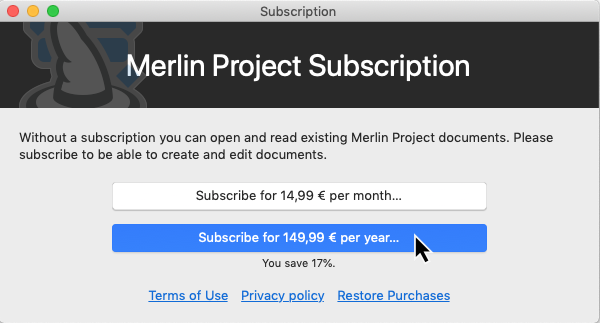
|
|
Volume discounts and central license management are only available if the software was downloaded from our website and not from the Mac App Store. |
Click the Subscribe for… button for the desired subscription payment interval. Your subscription will be billed as an in-app purchase by the App Store and will follow the standard procedures of Apple.
|
|
Should you need to restore your in-app purchase, click the Restore Purchases button. |
Manage Existing Subscription
You can manage your existing subscription in the Merlin Project > Subscription panel.
By a subscription which is activated on the current macOS device…
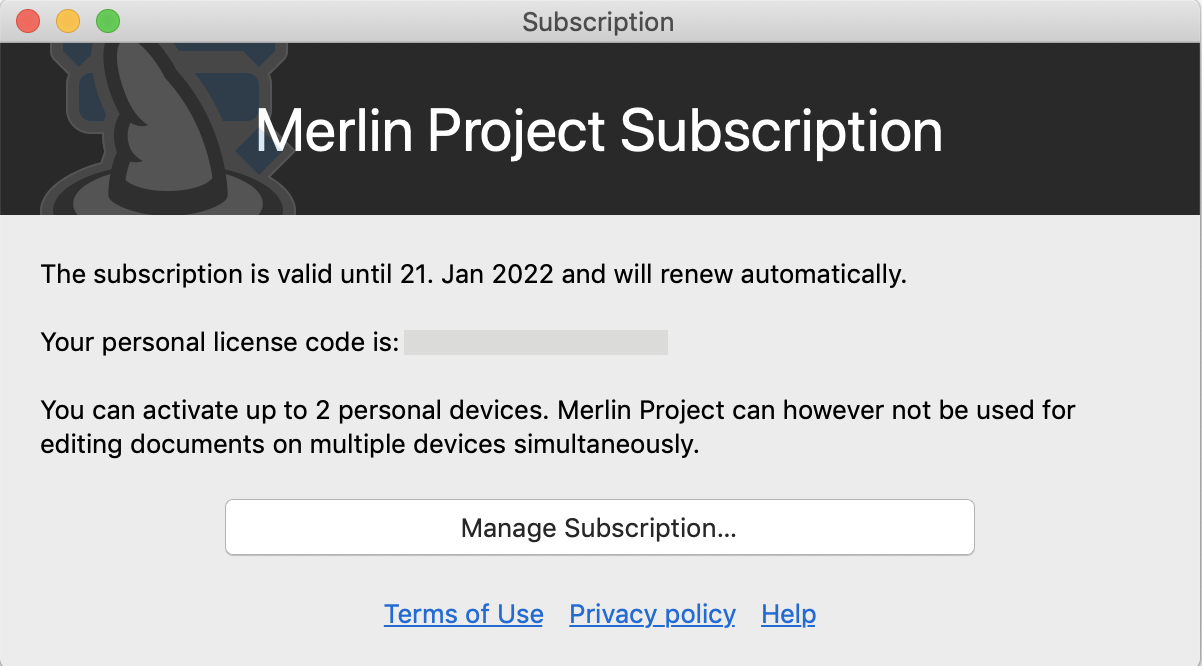
…click Manage Subscription… for further information.
By a subscription which hadn’t been activated on this macOS device…
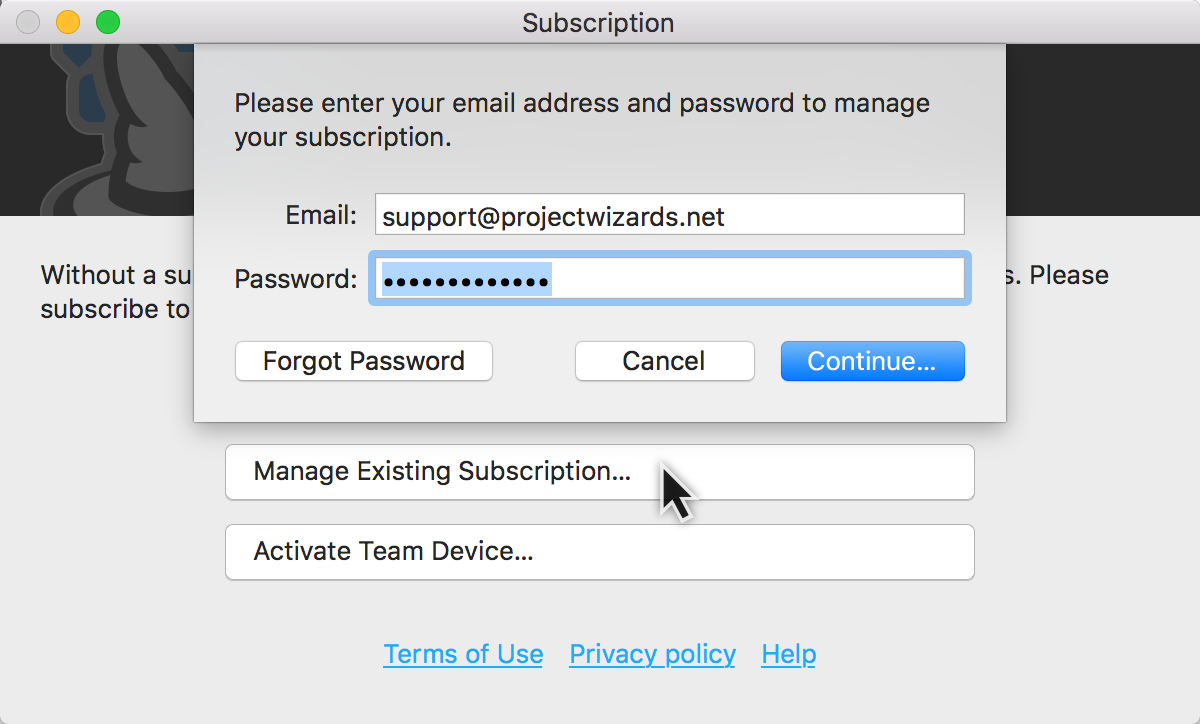
…click Manage Existing Subscription… for further information.
Enter the Email and Password for your subscription and click Continue….
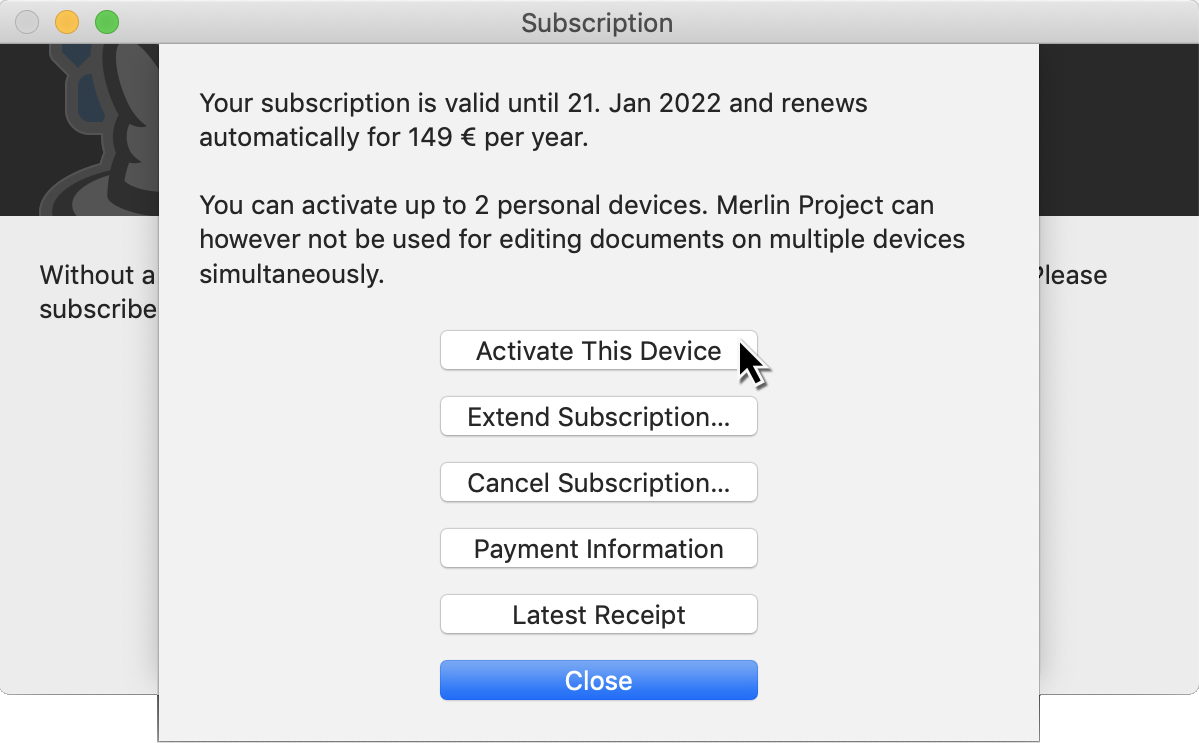
-
Extend Subscription… (and purchase licenses for additional users within the active subscription)
-
Latest Receipt
|
|
Those options are only available if you downloaded Merlin Project from our Website. |
Click on Close to close the dialog without making a selection.
You downloaded the app from the App Store?
Once subscribed, the dialogue changes as follows:
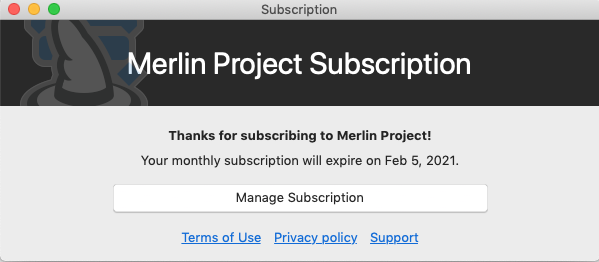
Click Manage Subscription, you’ll be redirected to the App Store, where you can view the settings for your subscription on the App Store.
Cancel Subscription
To cancel a subscription, go to Merlin Project > Subscription.
Click Manage Existing Subscription. Enter the Email and Password for your subscription and click Continue…. Now click Cancel Subscription….
|
|
For Multi User Subscription licenses, please use the Additional Options of the Central License Management… |
You downloaded the app from the App Store?
Click Manage Subscription. You’ll be redirected to the App Store where you can cancel your running subscription.
New projects
The following guide will help you get started with new projects.
Opening a new project
When Merlin Project starts without an open project, or when you call File > New… following window will be displayed:
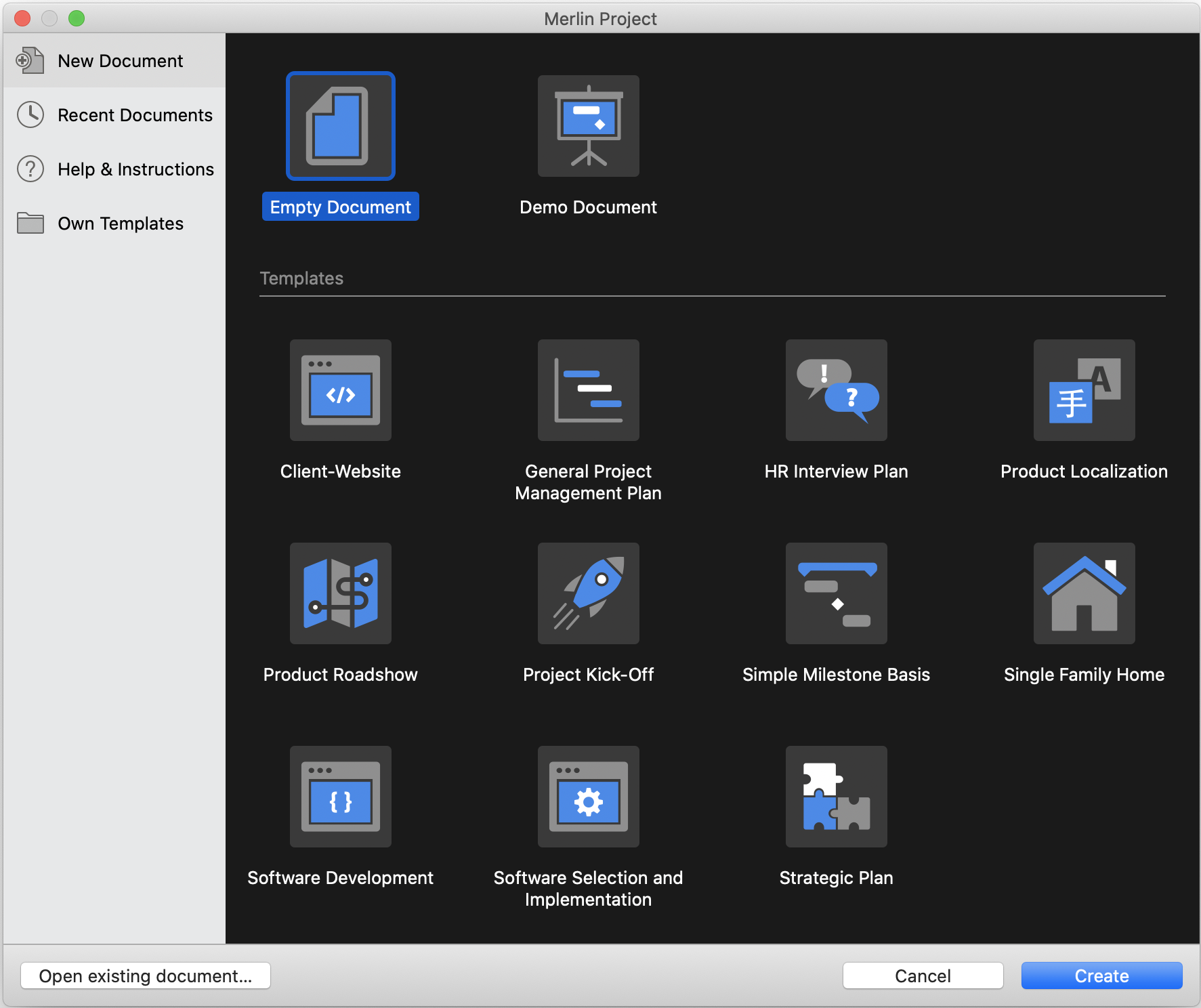
To create a new empty project, click the Empty Document button.
To start a project out a specific template, select the template and click the Create button.
To open an existing project, click the Open existing document button and select the file.
Recently opened files are listed in the Recent Documents area.
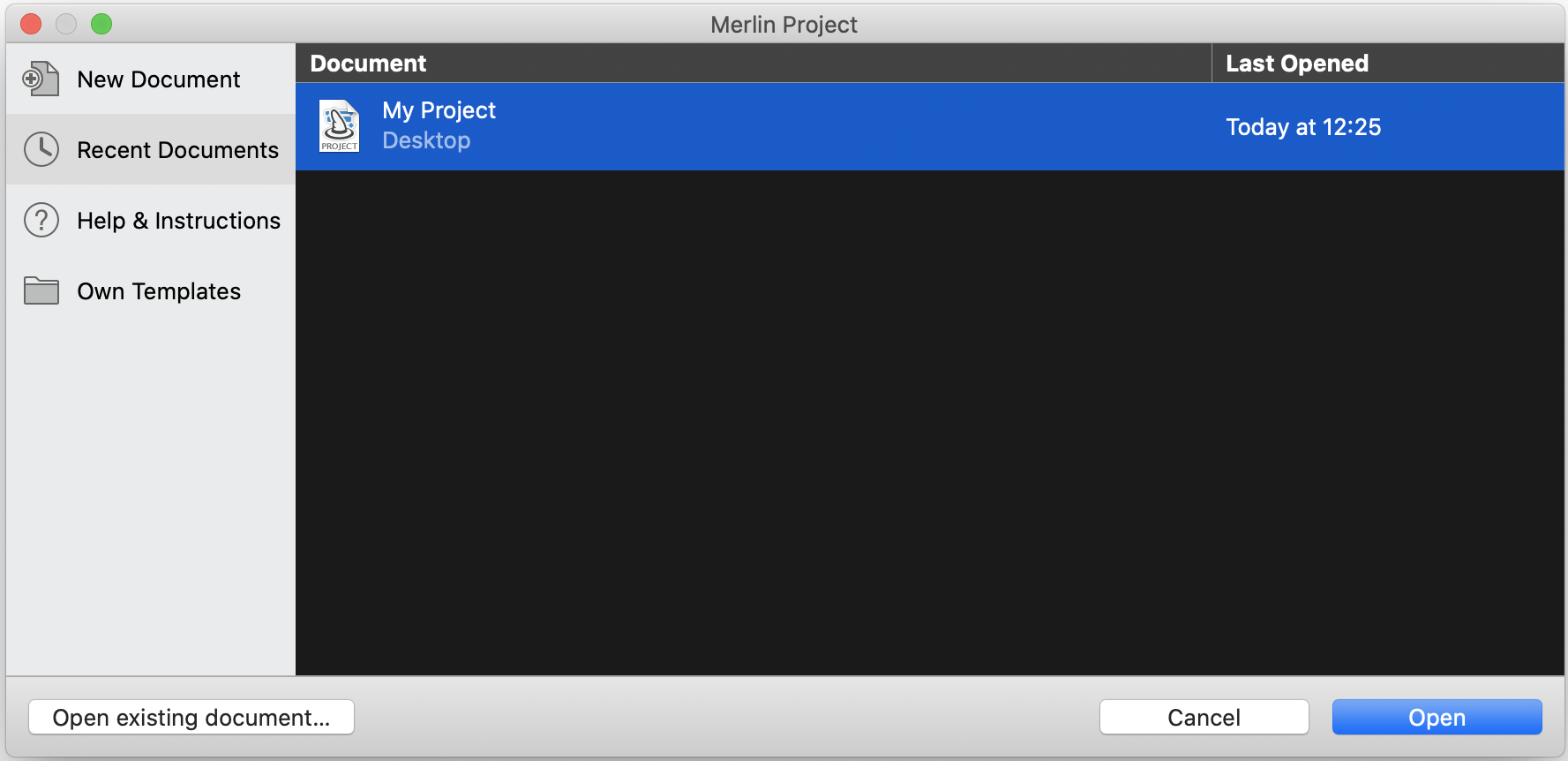
Naming your project
Name your project. To do this, double-click New Project in row #0 of the outline and give your project a new title.

Project Inspector
Display the Inspector by clicking row #0 (the project). It contains a number of options for the selected project. Here you can also change the title and start date of the project.
|
|
Each Inspector has multiple tabs containing further options. When you select elements, as in this case row #0, the corresponding Inspector always appears. |
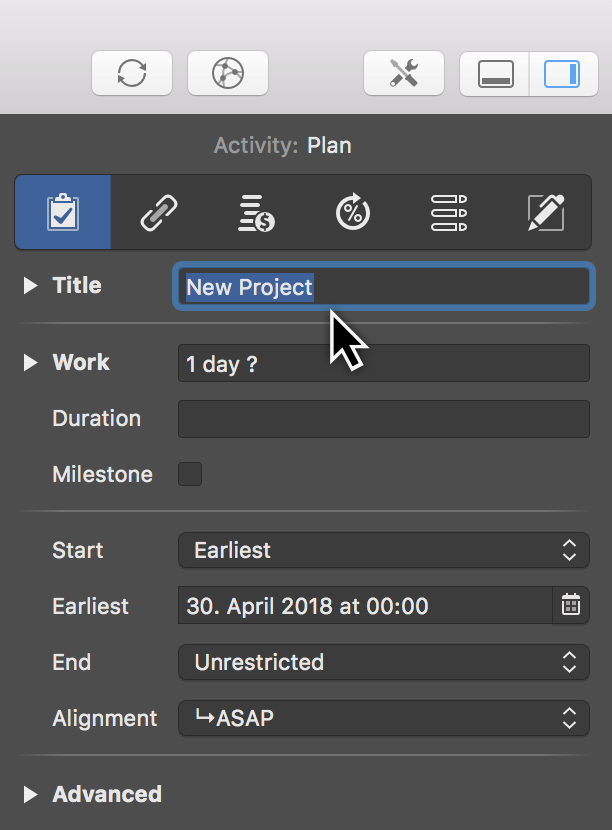
Setting the project’s direction
You can plan a project forwards or backwards. If you’ve already got a fixed end date for the overall project, you can also take a backward-looking approach. To do this, in your project click Settings and set the Direction to »Backward«.
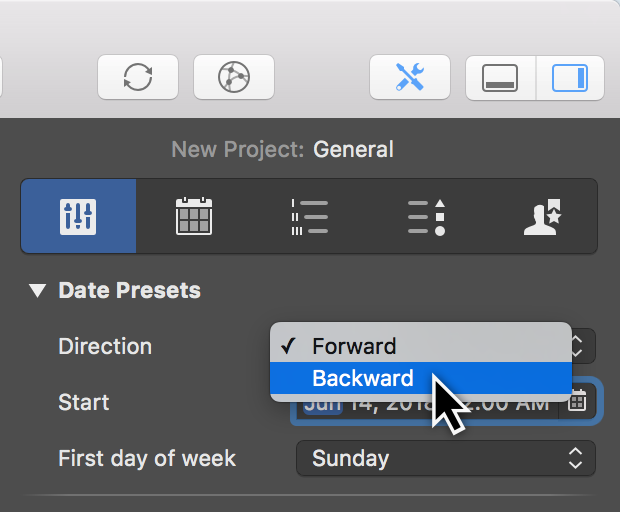
Start Date
In the Inspector, click the Calendar icon in the Start > Earliest field. Use the calendar to set the earliest planned start for the project.
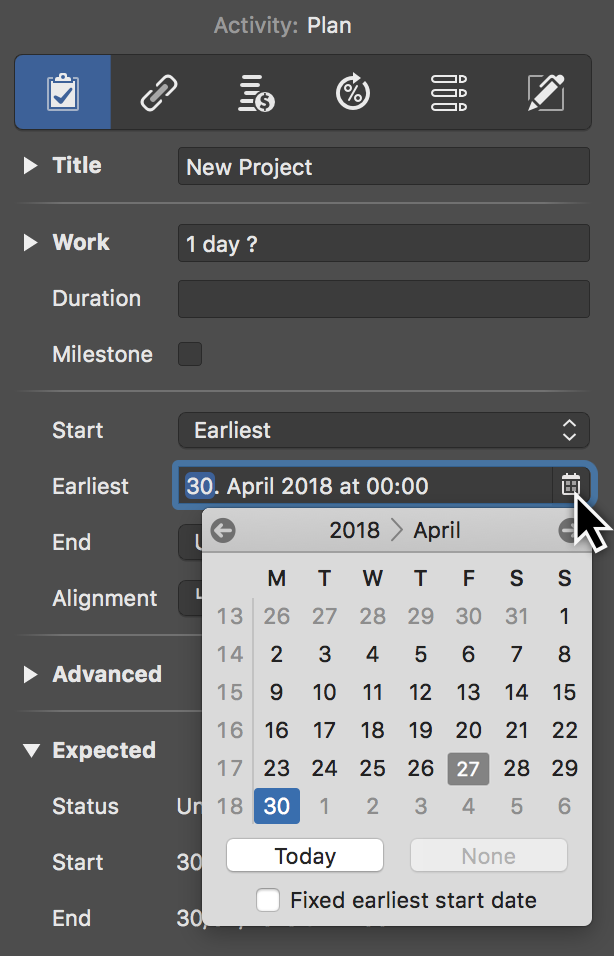
First day of week
Per default you’ll find Sunday to be the first day of week for new projects. To change it, just select another day in the Settings > General > Date Presets. You may need to do this for projects taking place abroad, for instance.
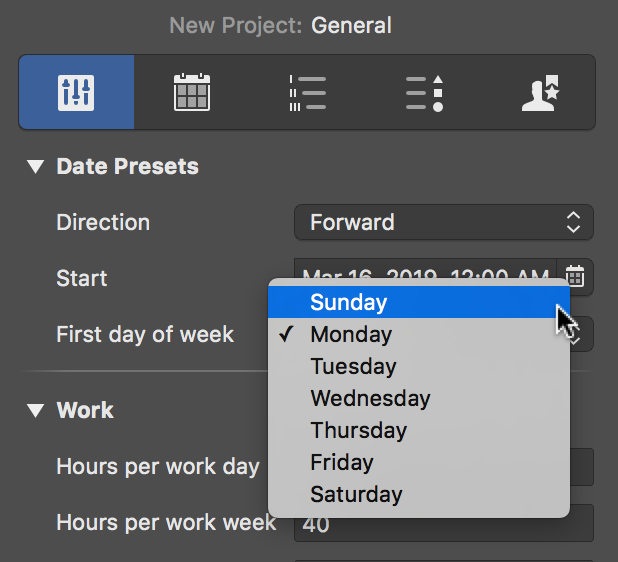
Regular working times
Working times are configured in the settings for each project. Click the Settings icon (1) and then the Calendar tab (2).
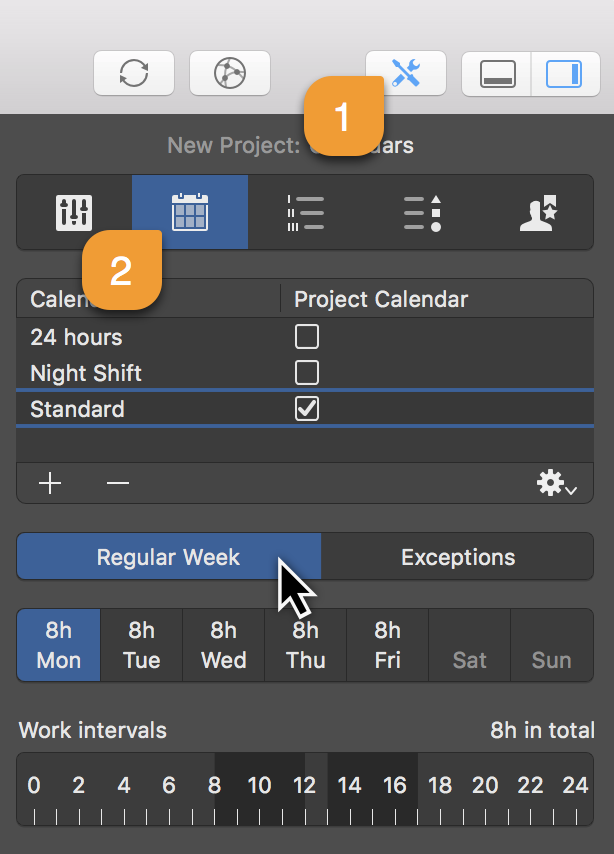
The Inspector shown here contains calendars for the Regular Week and Exceptions, such as vacation time and extra working time.
Click the Regular Week tab:
The default calendar is active (checkbox ticked). Further calendars are available in the list and can be configured as project calendars.
|
|
By clicking the plus or minus icons you can create new calendars or delete existing ones. |
Click one or more (while holding down the cmd key) weekdays and then click the Work intervals to change the calendar settings.
|
|
The calendar settings have a direct impact on project planning and the working time in the active project. |
The exceptions work according to the same principle. Read more about this in the Non-working Time guide.
Views
In Merlin Project there are several views for your project.
Merlin Project includes views for traditional Work Breakdown with Gantt chart, Net Plan, and Kanban board, but also for Resources, Assignments, Reports and Attachments.
The views support the Dark Mode, available in macOS Mojave or later, and let you display and edit your content in any way you find more fitting.
|
|
For the app to remain in Light Mode even if the system is in Dark Mode, enable the Always light setting for the Views Appearance in Preferences > General. |
|
|
Even if using the app in Dark Mode, printing always takes place in the light appearance, while image exports take place in the currently selected appearance. |
Merlin Project shows in the upper left corner the name of the current view.
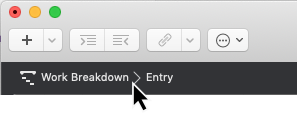
Click Work Breakdown for the selection list of all views.
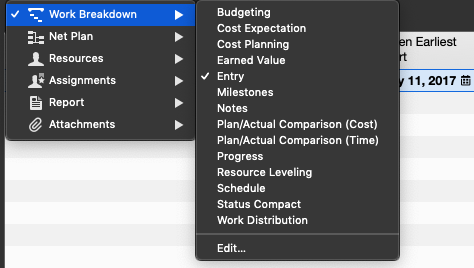
Click Entry to see all built-in Work Breakdown views.
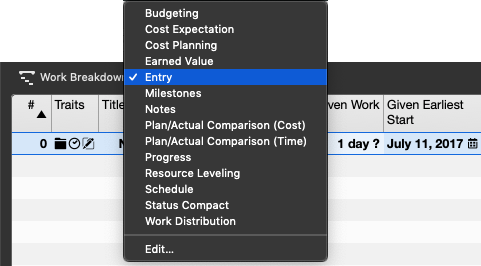
The Edit option lets you modify existing views and saves the changes as new, custom views.
Switching views
Switch to another view, by selecting another item from the view list.
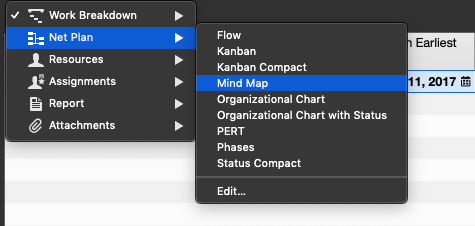
Work Breakdown
Typically, a Work Breakdown representation with an Outline and a Bar Gannt chart is used in project management.

For this purpose, you can find the following Work Breakdown views in Merlin Project:
-
Entry
-
Schedule
-
Progress
-
Milestones
-
Notes
-
Resource Leveling
-
Plan/Actual Comparison (Time)
-
Status Compact
If you need an evaluation of your Work Breakdown by time phase, you can use one of the following Work Breakdown views:
-
Workdistribution
-
Cost Expectation
-
Cost Planning
-
Budgeting
-
Plan/Actual Comparison (Cost)
-
Earned Value
You create further views with the Edit option. The Edit window lets you choose from the built-in views; you can create new views by clicking the plus icon.
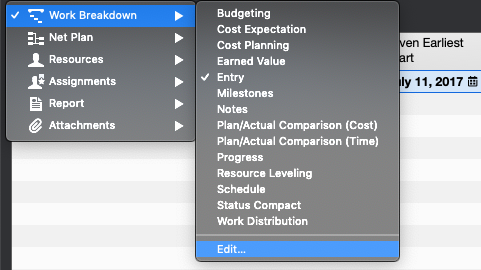
Net Plan
The Net Plan view lets you select various graphical plan views:
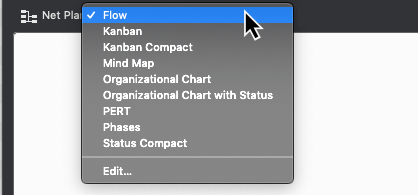
-
Organizational Chart with Status
-
PERT
-
Phases
-
Status Compact
|
|
You can create additional views by clicking the Edit option. The existing views are displayed in the window and you can create new views by clicking the plus icon. |
Flow
The Flow view contains the logical connections and the structure of the project in the form of a Net Plan.
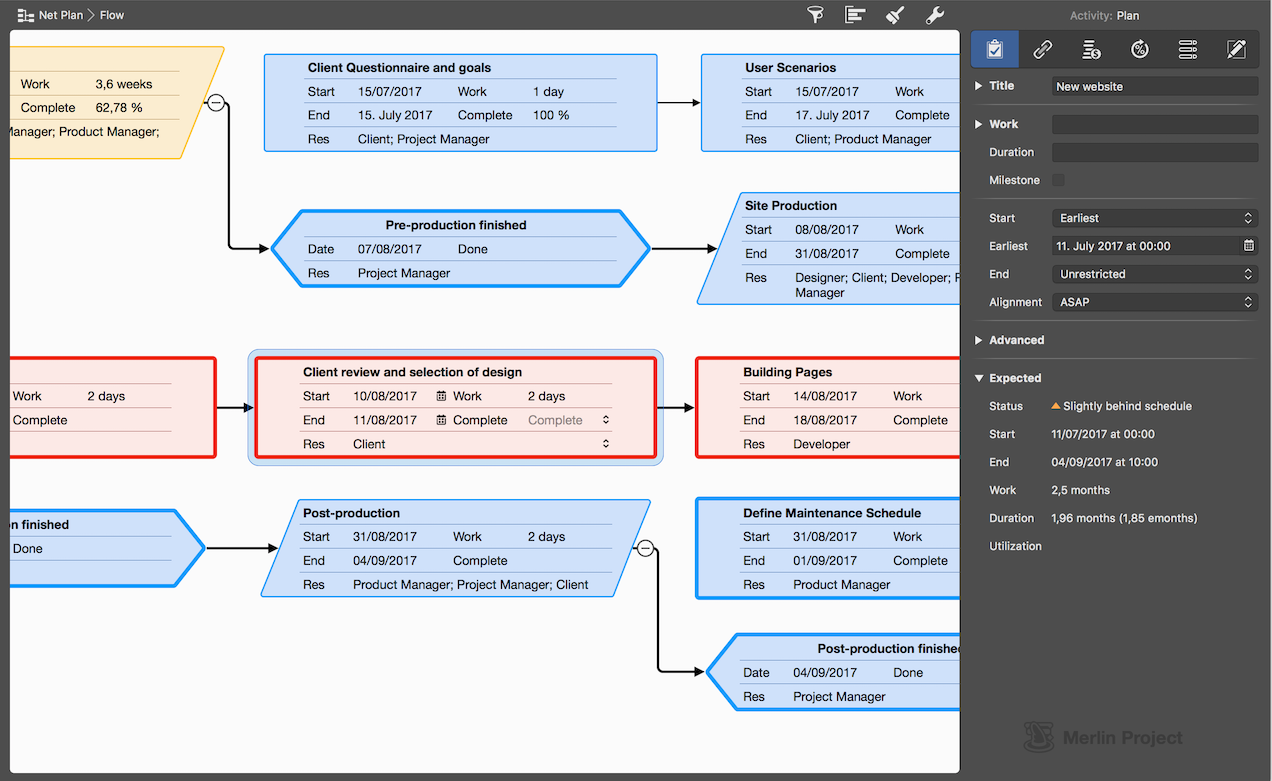
You can modify how the Net Plan is displayed in the View Options (1) using the Layout drop-down menu (2). The Inspector contains additional options for displaying the Net Plan.
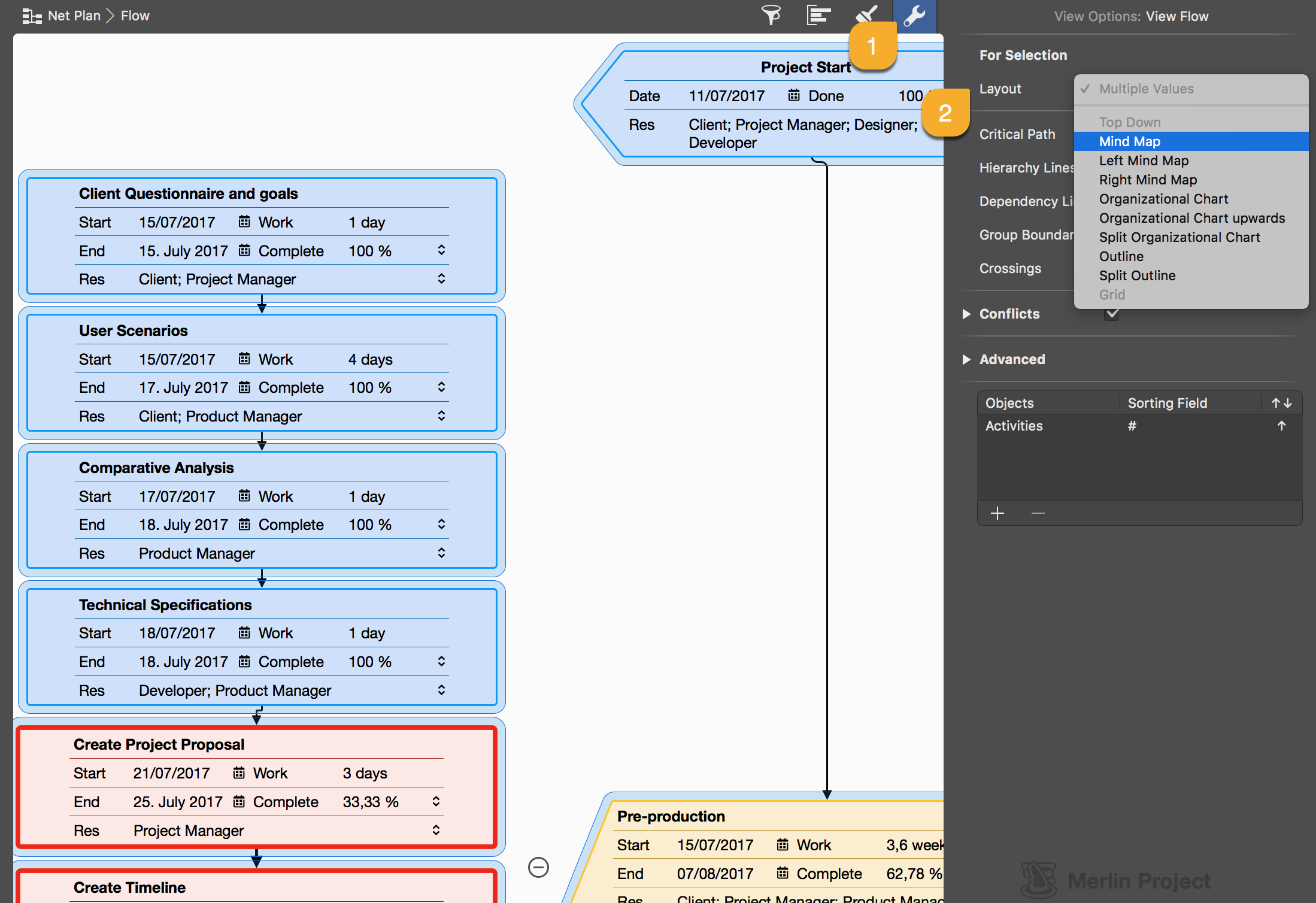
Kanban / Kanban Compact
The Kanban view is intended for agile project management and offers a variety of possible applications.
The Kanban Compact view is a slimmed-down variant of the Kanban view.

|
|
More about Kanban… |
Mind Map
The Mind Map view is perfect for displaying projects graphically. You can adjust the layout of the Mind Map in the »View Options« and change how it looks. Click the displayed icon.
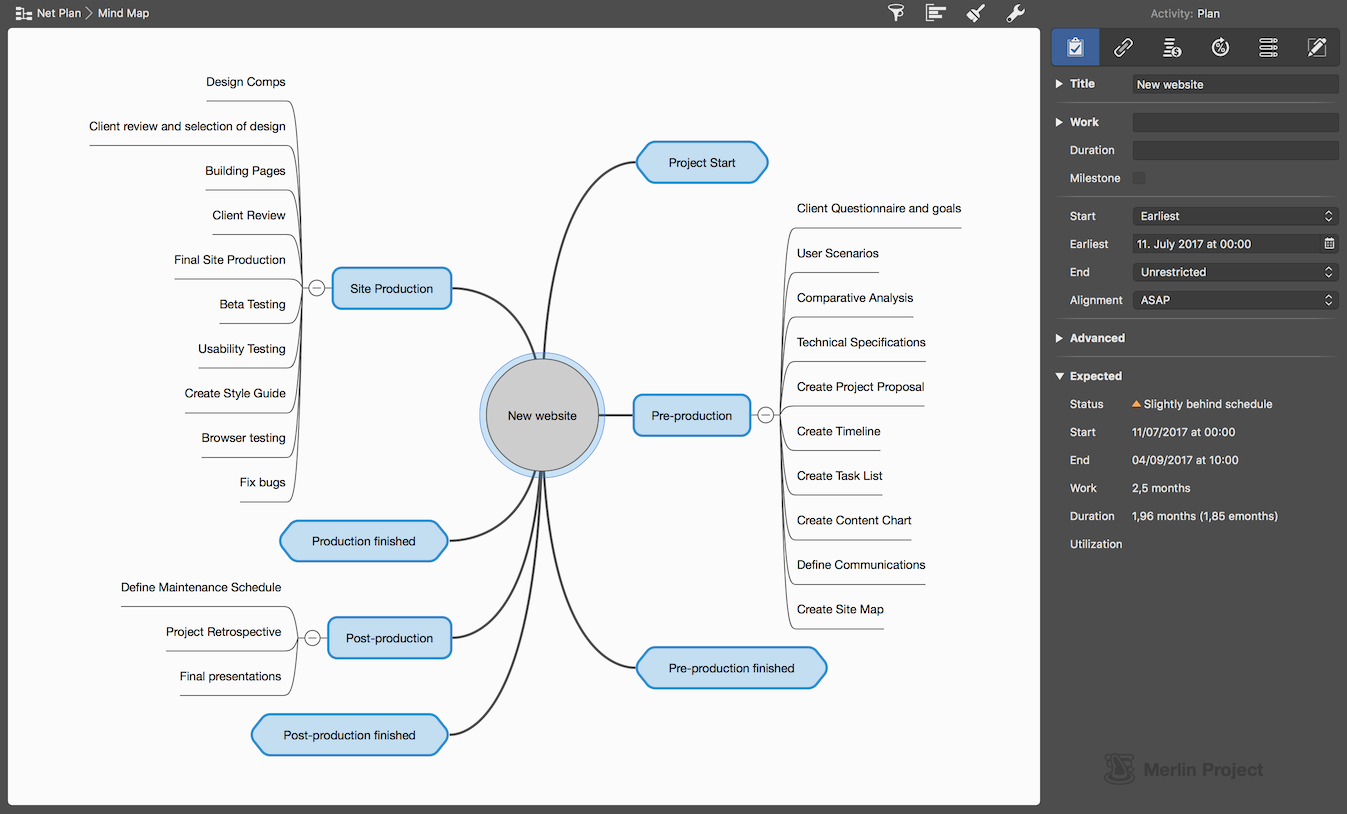
|
|
Further options for displaying the Mind Map can be edited using the Inspector View Options. To do this, click the wrench icon. |
Organizational Chart
The Organizational Chart view in the Net Plan is perfect for the hierarchical display of different projects.
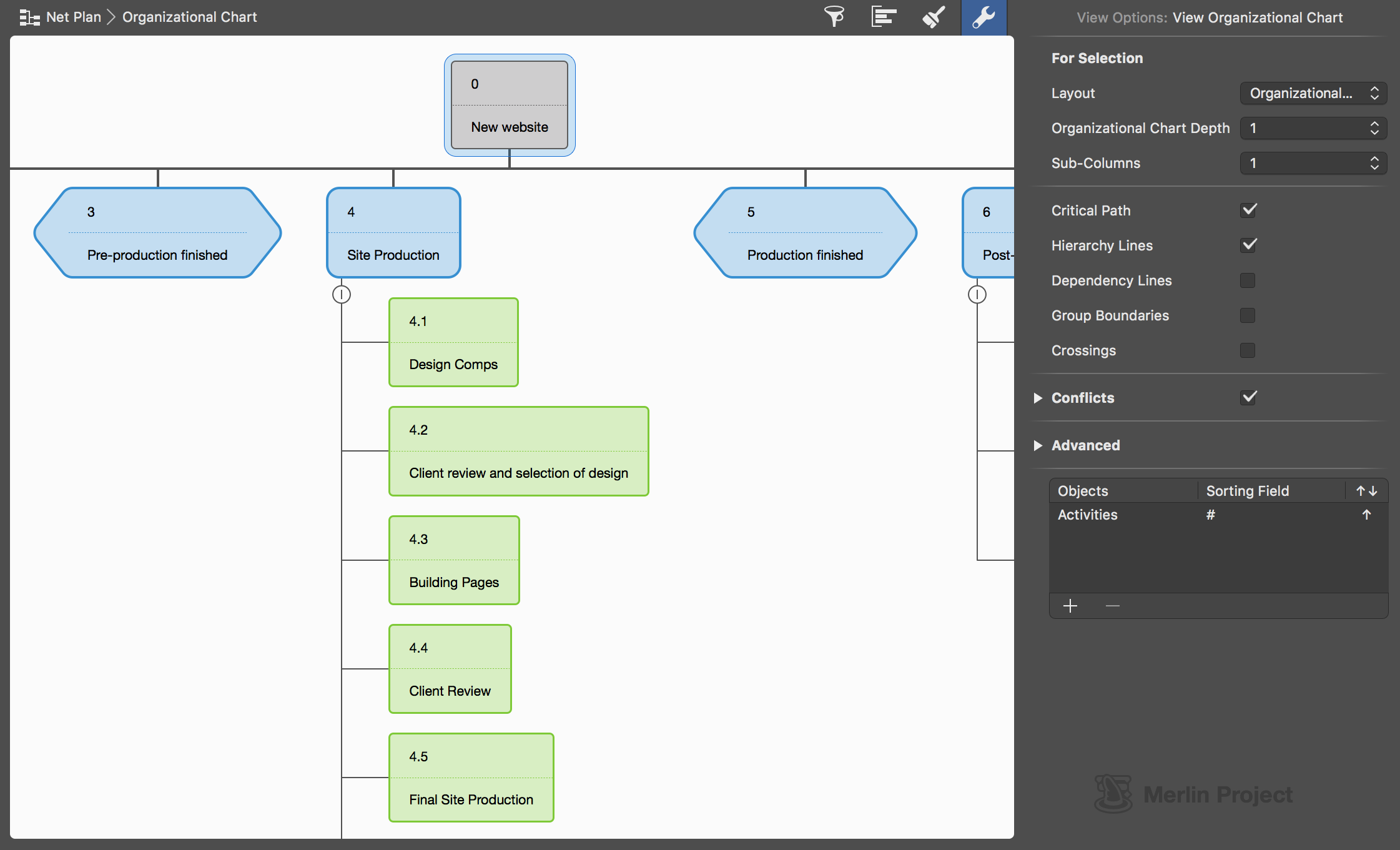
You can adjust the layout of the Organizational Chart in the »View Options« and change how it looks. Click the wrench icon.
Resources
The Resources view contains all resources involved and assigned in the project. This gives you an overview of the resources available in the project.
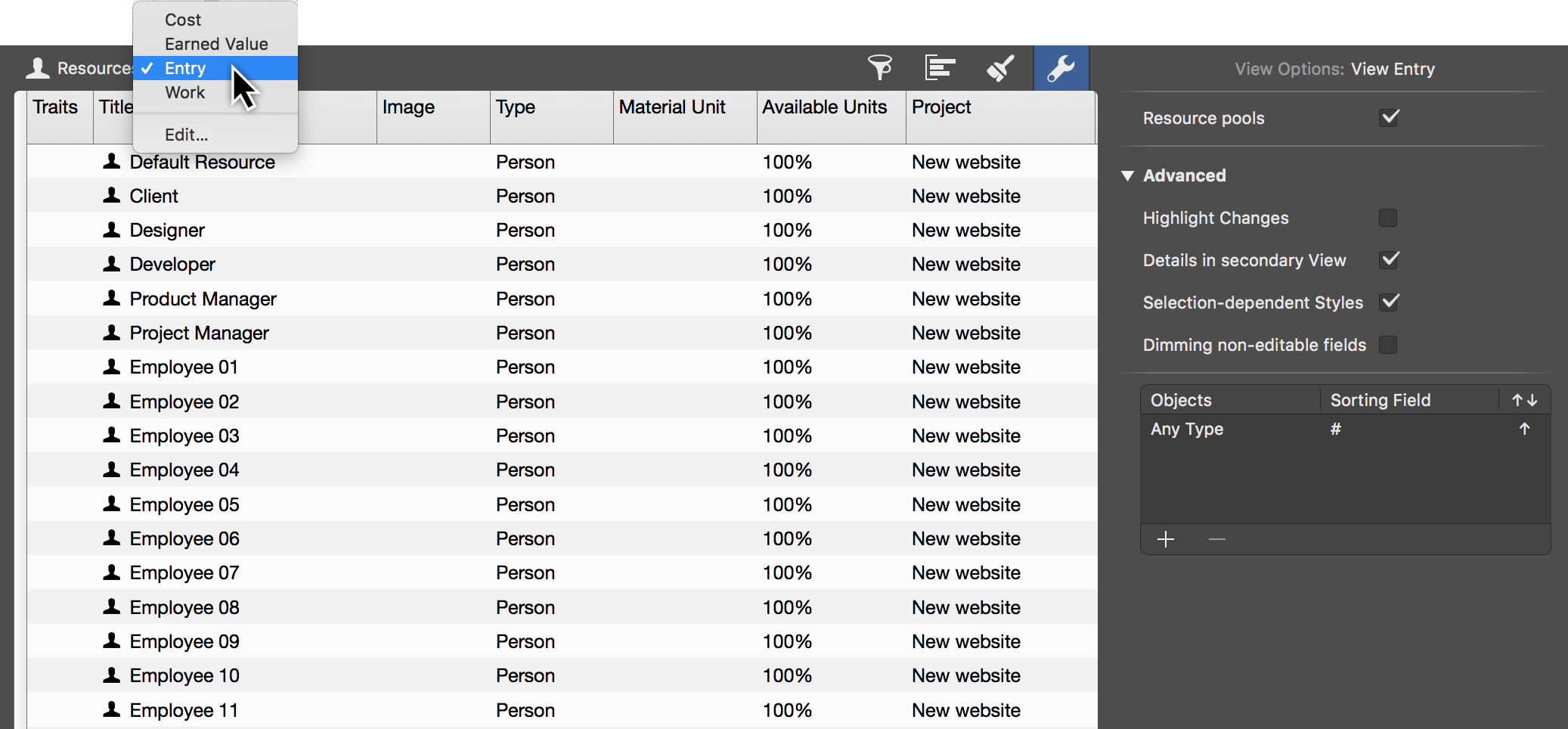
Resources can be viewed in the four following views:
-
Work
-
Entry
-
Costs
-
Earned Value
|
|
More about Resources… |
Assignments
The Assignments view contains all assigned resources in the project. The chart shows each resource’s utilization values for each day.
This gives you a quick overview of utilization levels (shown in red) of individual assignments, allowing you to spot potential cases of over-utilization and correct these.
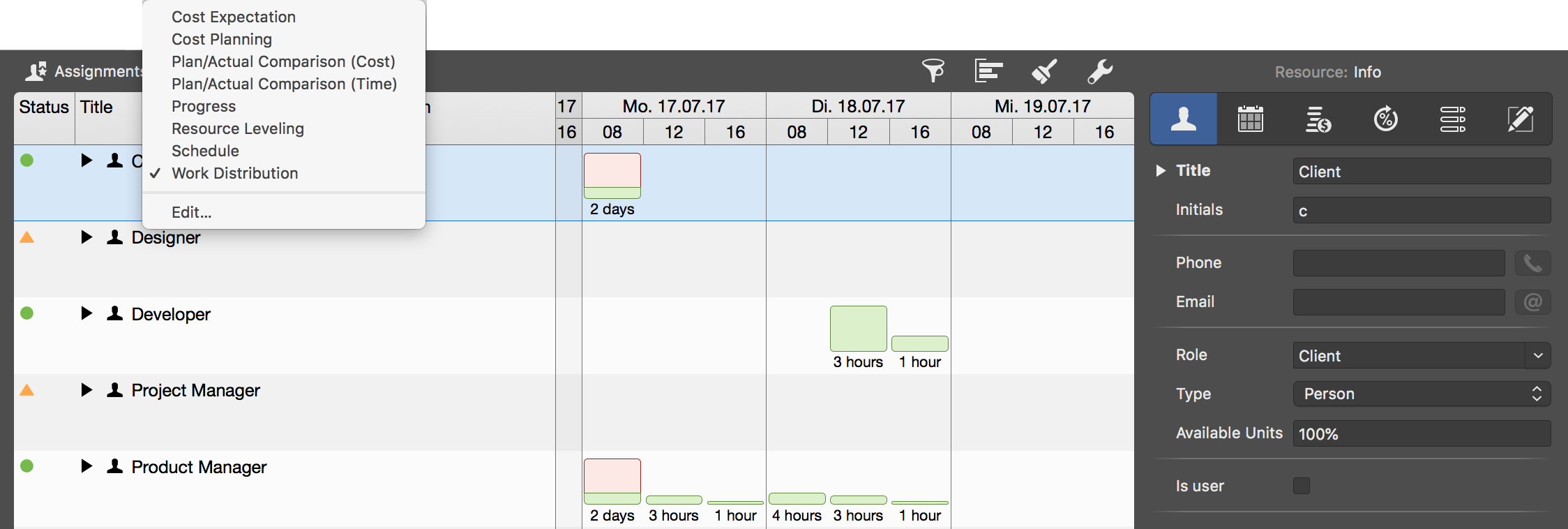
The available views for the assignments are:
-
Schedule
-
Work Distribution
-
Cost Expectation
-
Cost Planning
-
Resource Leveling
-
Plan/Actual Comparison (Cost)
-
Plan/Actual Comparison (Time)
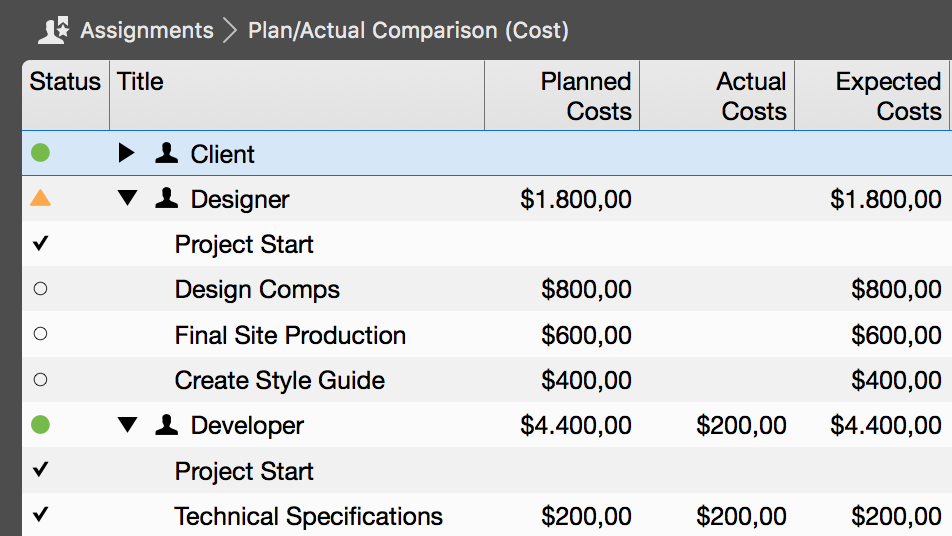
The views let you check the assigned project resources according to different aspects, for example according to the Expected Costs.
Report
The Report view lets you create reports from different view modules. Here you can combine any views to report the required project information.
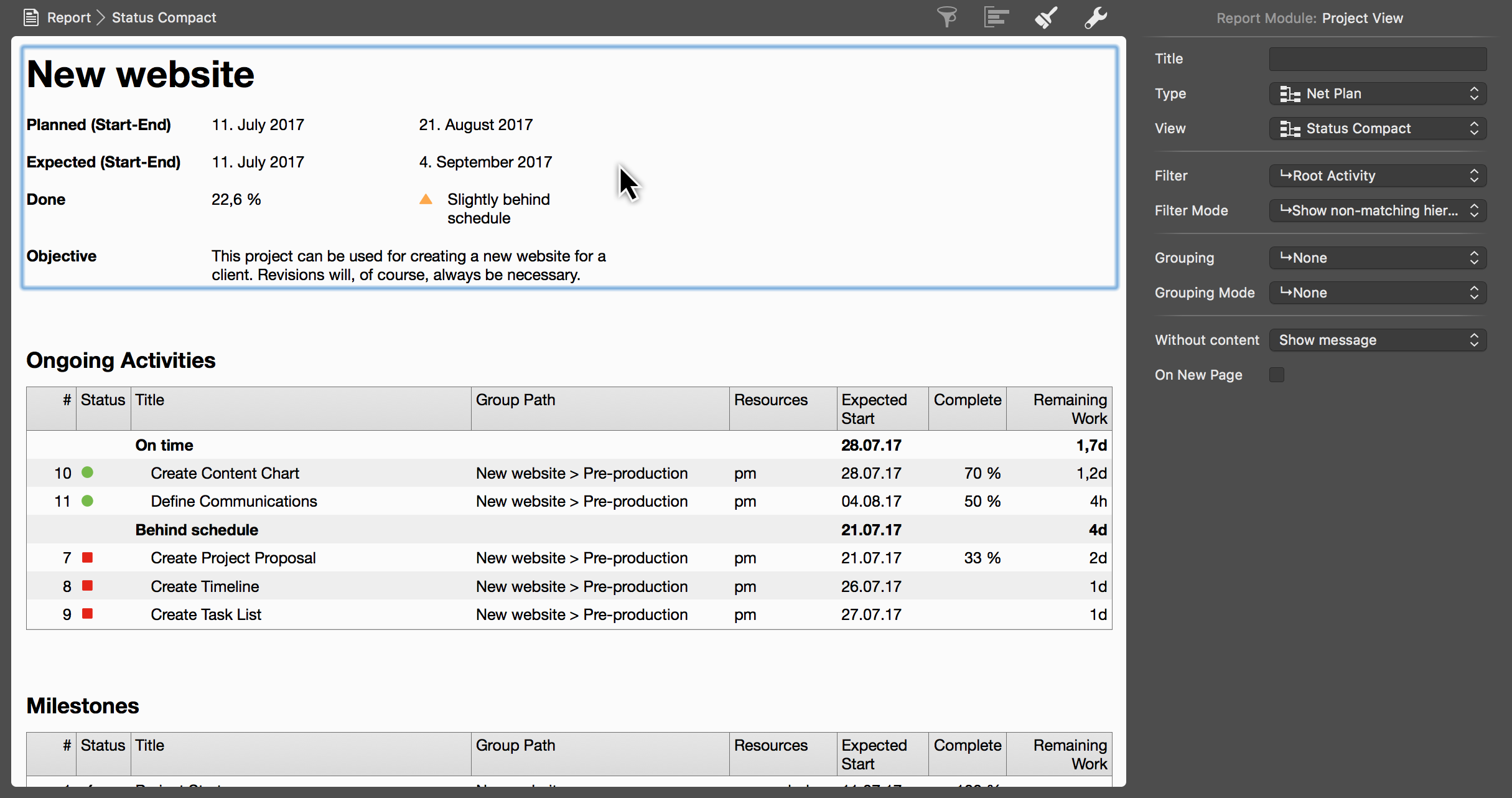
|
|
Read here how to Modify Reports… |
Attachments
The Attachments view provides an overview of all attachments in the project.

Using the drop-down menu, the attachments can be listed by type in the view:
-
Checklists
-
Files
-
Events
-
Information
-
Issues
-
Risks
View Options
The layout of the current view can be changed and graphically adjusted in the View Options. To do this, click on the wrench.

Depending on the selected view, this inspector is context sensitive and contains different options.
Inspector »View Options: Work Breakdown«
Following inspector appears when the Work Breakdown view is enabled.
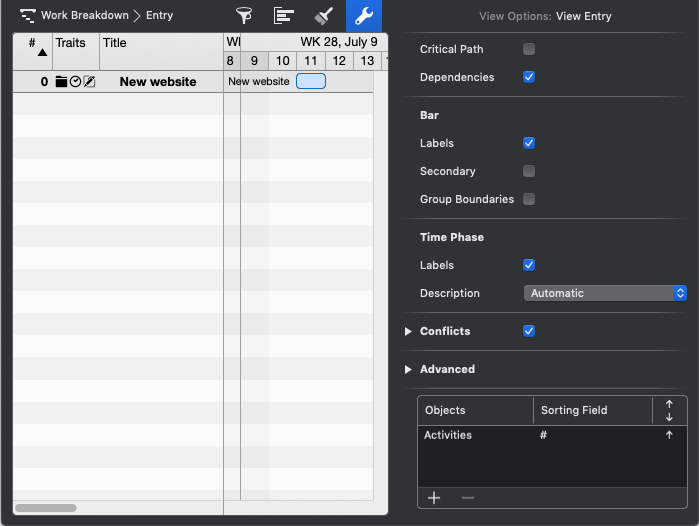
It contains the following options:
-
-
Labels
-
Secondary
-
Group Boundaries
-
-
-
Labels
-
Description (Automatic, Show and Hide)
-
-
-
Strong
-
Weak
-
Inspector »View Options: Resources«
This inspector appears when the Resources view is enabled.
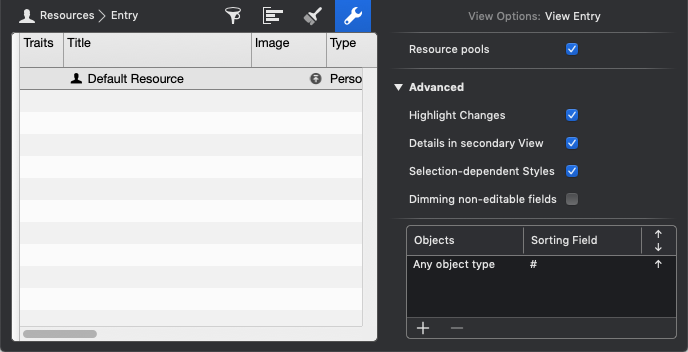
It contains the following options:
Inspector »View Options: Net plan«
This inspector appears when the Net plan view is enabled.
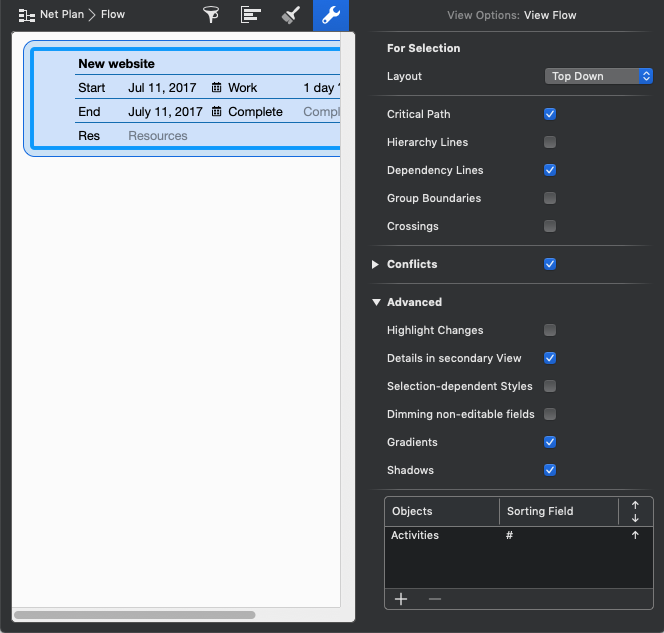
It contains the following options:
Inspector »View Options: Assignments«
This inspector appears when the Assignments view is enabled.
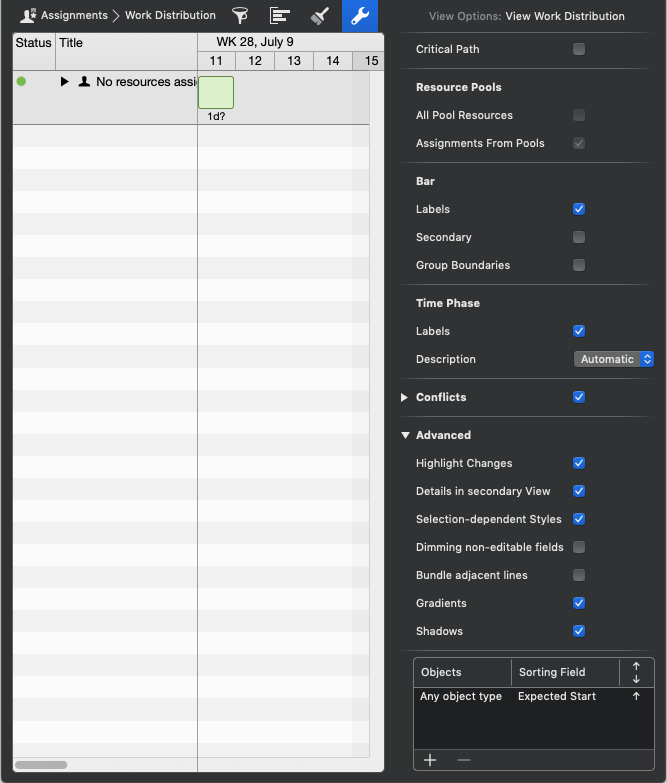
It contains the following options:
-
Resource pools (important if you use a Resource Pool)
-
-
Labels
-
Secondary
-
Group Boundaries
-
-
-
Labels
-
Description (Automatic, Show and Hide)
-
-
-
Strong
-
Weak
-
Inspector »View Options: Report«
This inspector appears when the Report view is enabled.
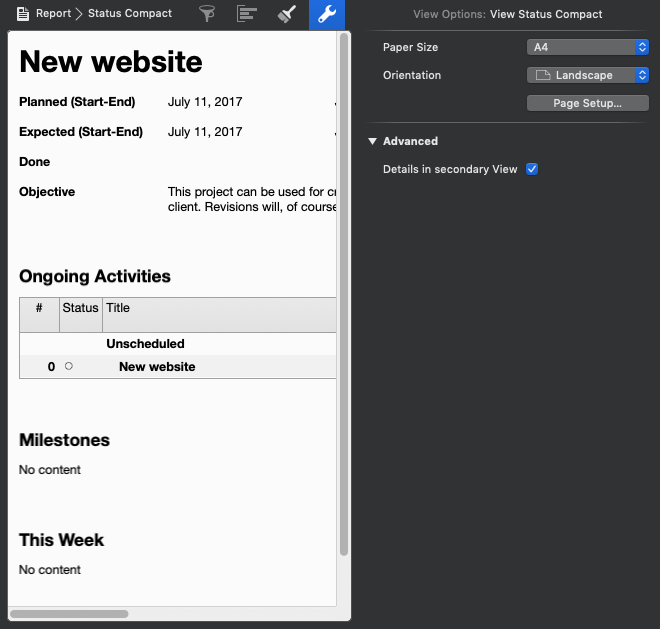
This inspector appears when the Report view is enabled. It contains the following options:
Inspector »View Options: Attachments«
This inspector appears when the Attachments view is enabled.
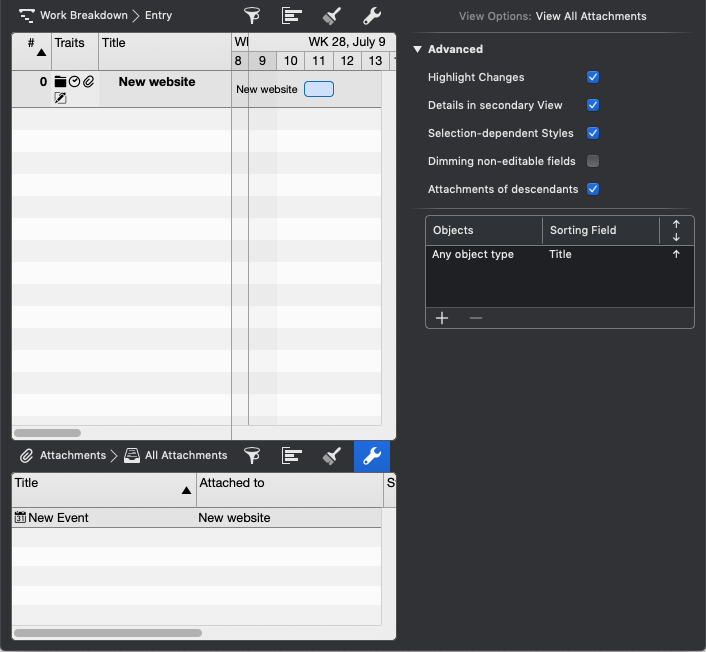
It contains the following options:
View Options in detail
Resource pools
The Resource pools option is available in the View Options of the Resources and Assignments views.
If you have included an resource pool file in your project, enable this option to list the resources of the resource pool in this view.
All Pool Resources
The All Pool Resources option is available in the View Options of the Assignments views.
If you have included an resource pool file in your project, activate this option to list all resources of the resource pool in this view. If this option is disabled, Merlin Project will only show those resources from the resource pool that have been adopted in the project.
Assignments From Pools
The Assignments From Pools option is available in the View Options of the Assignments views.
If you have included an resource pool file in your project, enable this option to also list in this view the assignments of the resources on other project where the resource pool was linked. If this option is disabled, Merlin Project does not list all assignments for Resource Pool Resources. Assignments of resources in other projects will be hidden.
For Selection
The options section For Selection is available in Net Plan views and influences the layout of the tiles.

The layout of a Net plan can be set as follows:
-
Top Down
-
Mind Map
-
Left Mind Map
-
Right Mind Map
-
Organizational Chart (more options: Organizational Chart Depth, Sub-Columns)
-
Organizational Chart upwards (more options: Organizational Chart Depth, Sub-Columns)
-
Split Organizational Chart (more options: Organizational Chart Depth, Sub-Columns)
-
Outline (additional option: Sub-Columns)
-
Split Outline (additional option: Sub-Columns)
-
Grid (more options: Row Layout, Swimlane, Sub-Columns)
|
|
The background shape of the cards of a Net plan > Organizational Chart view will not change to circles when you change the layout from Organizational Chart to Mind Map. To change the background shape of the cards, you must go to the Style and Content > Cards options. |
The grid options are designed for the Net plan > Kanban and Net plan > Kanban Compact views.
Critical Path
The Critical Path option enables/disables the display of the critical path in the Gantt chart. Here, the dependency lines between the operations are highlighted graphically.
The display of the Critical Path can also be activated by clicking the corresponding icon on the toolbar.

|
|
The critical path is always present when the linked tasks influence the end of the project. Any change to one of the linked tasks on the critical path automatically leads to a change in the end of the entire project. More information about the critical path can be found at Wikipedia.. |
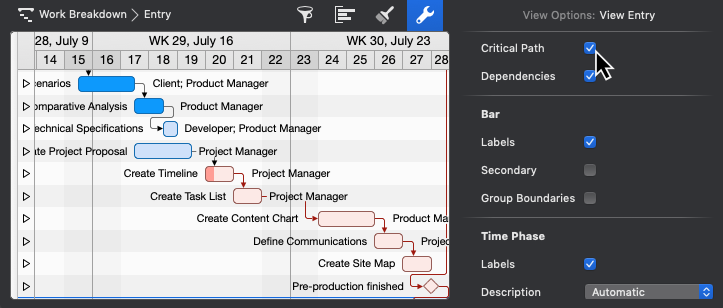
|
|
In the Net Plan > Mind Map view, where the dependency lines are not displayed by default, please activate the display of the link lines of the Dependency Lines in addition if you want to highlight the Critical Path. |
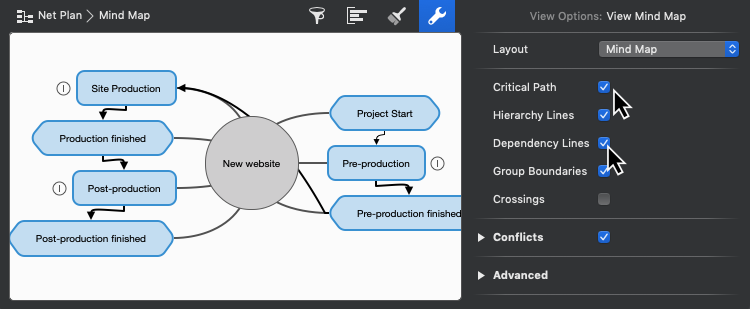
Dependency Lines
The Dependency Lines option is available in the View Options of the Work Breakdown and Net Plan views.
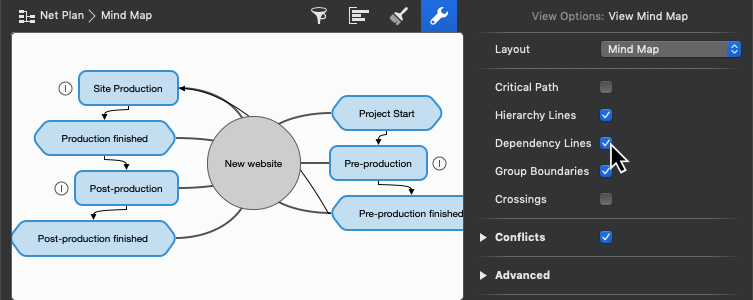
With it you can activate or deactivate the display of the dependency lines between the Gantts bars or cards in the Net plan views.

|
|
This option has no effect in a Work Breakdown view, if your Gantt chart is not a bar chart but a time phase representation. |
Hierarchy Lines
The Hierarchy Lines option is available in Net Plan views.
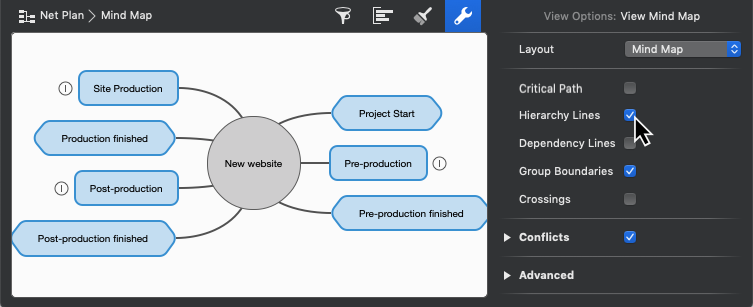
The option Hierarchy Lines activates/deactivates the display of lines that lead from higher structures to lower structures. These lines help understanding the hierarchy of the respective cards in the Net plan, but can be switched off if required.
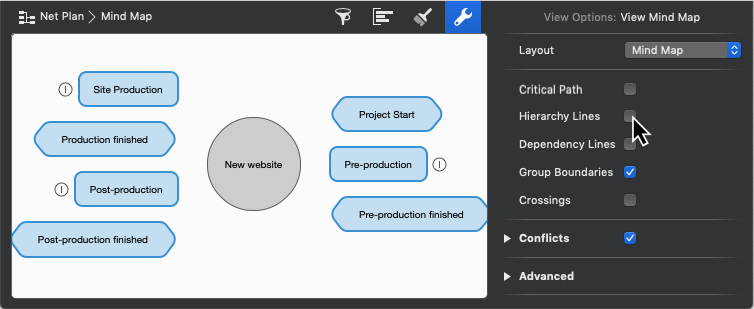
Crossings
The Crossings option is available in Net Plan views.

The option Crossings activates/deactivates the display of crossings at started and completed cards of Net plan views, which are coded according to the status. These are for example PERT, Organizational Chart with Status, Phases, Kanban , Kanban Compact and Flow. One line on the card indicates that an activity has be started, two lines indicate that the activity is 100% completed.

Bar
The Bar options section is available in the Work Breakdown and Assignments views and affects how bars are displayed in the Gantt chart.
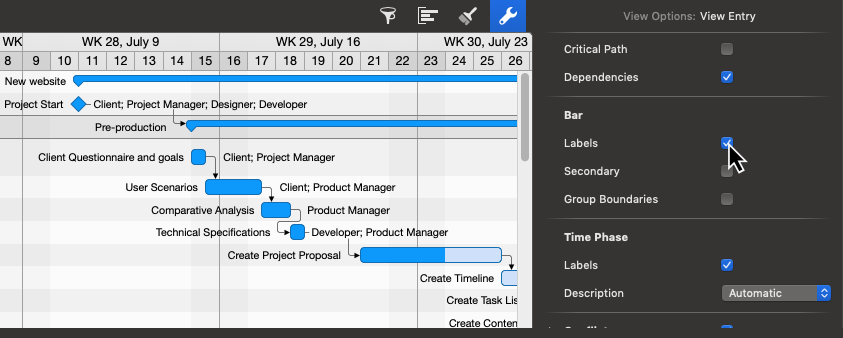
The Labels option enables/disables the bar labels display.
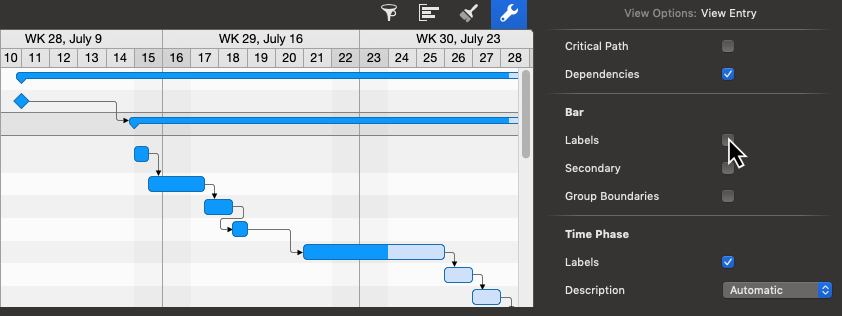
Up to three labels can be defined per Gantt element in the styles.
The Secondary option enables/disables the display of planned values. These values are displayed as a gray bar and appear automatically if the real values differ from the planned values.
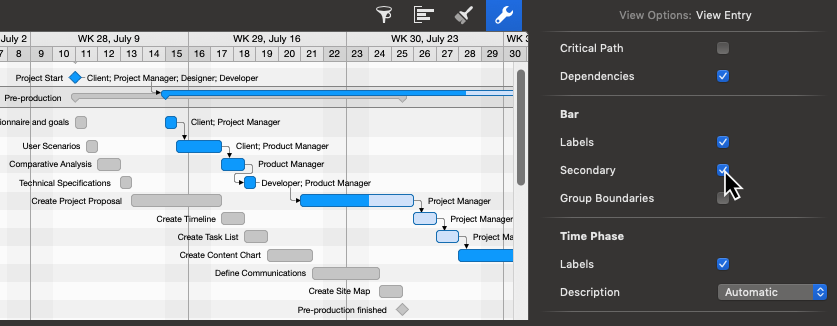
Group Boundaries
The Group Boundaries option enables/disables the display of graphical boundaries of groups in the Gantt chart.
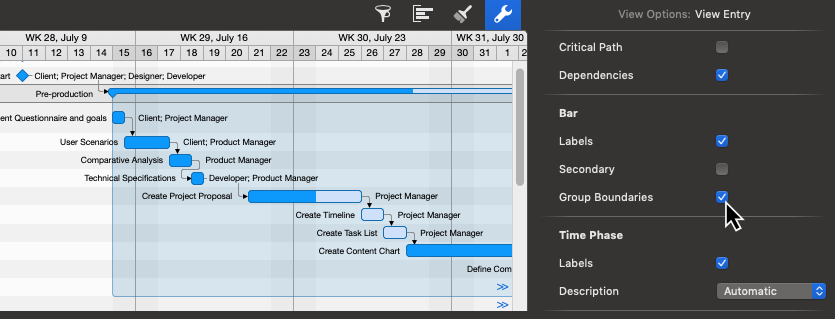
|
|
The Group Boundaries option increases the clarity of groups and subgroups. |
Time Phase
The Time Phase option section is available in the Work Breakdown and Assignment views and affects the display of Time Phases in the Gantt chart.
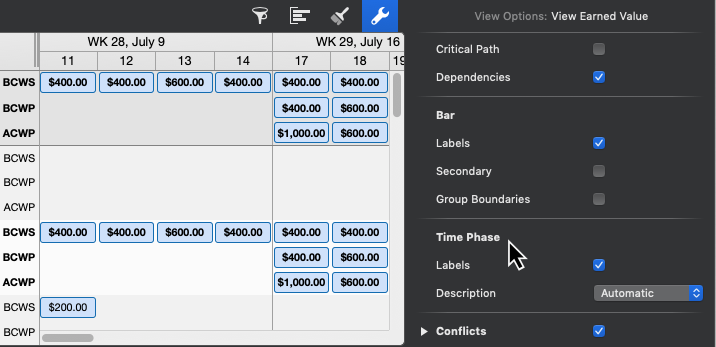
The Labels option enables/disables the display of labels in the respective Time Phase.
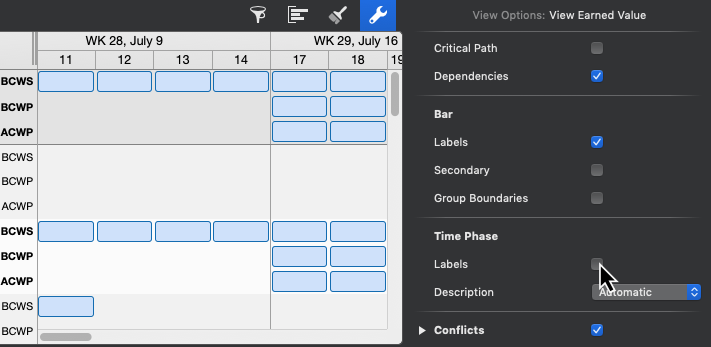
The Description option contains settings for displaying a descriptive title for the Time Phase lines and can have one of the following values:
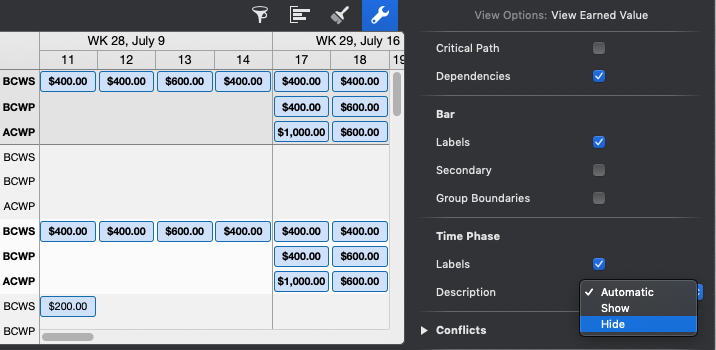
-
Show: Always show Time Phase Description
-
Hide: Always hide Time Phase Description
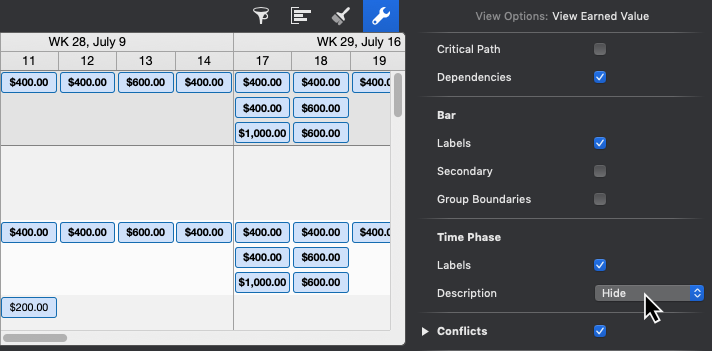
-
Automatic: Show Time Phase descriptions only if multiple Time Phase lines are enabled in the current view, e.g. in the Gantt of the Work Breakdown > Earned Value view. A maximum of 3 Time Phase rows can be activated.
Conflicts
These options allow to control the display of Conflicts in the Work Breakdown.

The Conflicts option enables/disables the display of all possible planning conflicts.

Expand them if you want to display Strong or Weak Conflicts differently.
The Strong option enables/disables the display of possible strong planning conflicts.
The Weak option enables/disables the display of possible weak planning conflicts
You can learn more about what Conflicts are and how to resolve them, here.
Paper Size
The Paper Size options section is available in the View Options of the Report views.
Select the desired paper size for the Report view from the list, or click the Paper Size… button to bring up the associated Page Setup dialog and use the options there.
|
|
The paper size settings for all other views (like Work Breakdown, Net plan, Resources, Assignments, Attachments) can be found in the Print dialog. |
Orientation
The Orientation options section is available in the View Options of the Report views.
Set the desired orientation for the Report view as Landscape or Portrait, or click the Paper Size… button to bring up the associated Page Setup dialog and use the options there.
|
|
The orientation settings for all other views (such as Work Breakdown, Net plan, Resources, Assignments, Attachments) can be found in the Print dialog. |
Page Setup…
The Page Setup… button is available in the View Options of the Report views.
It is a shortcut to the File > Page Setup… menu item. You can use this macOS dialogue to set the Page Attributes (Paper Size, Orientation, Scale) and Borders for the Report view.
|
|
The Page Setup settings for all other views (such as Work Breakdown, Net plan, Resources, Assignments, Attachments) can be found in the Print dialog. |
Advanced
The Advanced section contains advanced View Options.
Highlight Changes
The option Highlight Changes activates/deactivates the highlighting of the last changed values. This highlighting is only effective for the display and will not be printed.
Details in secondary View
The option Details in secondary View defines whether the information of the Details view refers only to the current selection of the main view or to the entire project.
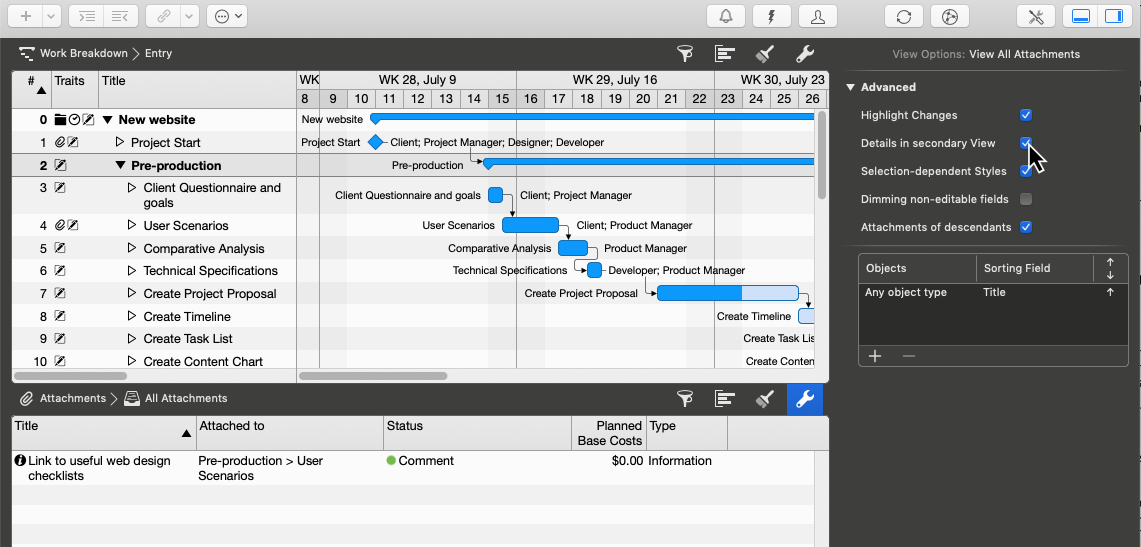
|
|
Disable this option if you want the Details view to show information for your complete project. |
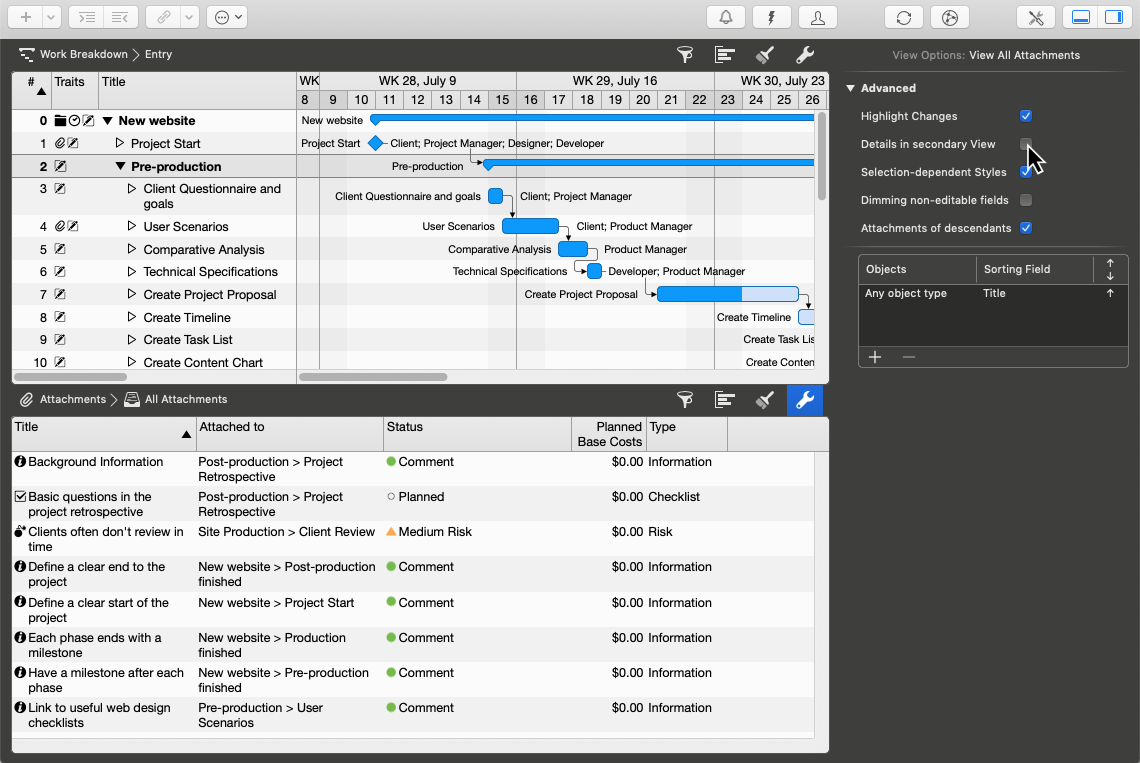
Selection-dependent Styles
The Selection-dependent Styles option enables/disables the display of styles depending on the selection.
Dimming non-editable fields
The Dimming non-editable fields option turns on/off the display of calculated fields in gray.
Attachments of descendants
The Attachments of descendants option is available in the View Options of Attachments views. It controls the display of attachments in the detail view if the project window is configured as a main view with a detail view.
If this option disabled, and you select a row in the main view in which some attachments are defined, the Attachments Detail view will show these attachments.
If this option is disabled and you select a row in the main view in which no attachments are defined, the Attachments Detail view will not show any attachments.
If this option is enabled and you select a row in the main view where attachments are defined in its substructure (in sub-activities or child activities), the Attachments Detail view will show the attachments of the substructure.
If this option is enabled, and you select a row in the main view where some attachments and in its substructure (in sub-activities or child activities) more attachments are defined, the Attachments Detail view will show the attachments of the selected row and those of the substructure.
Bundle adjacent lines
The Bundle adjacent lines option bundles the display of link lines in the bar chart. This makes the display of the links in the project more graphically appealing.
Gradients
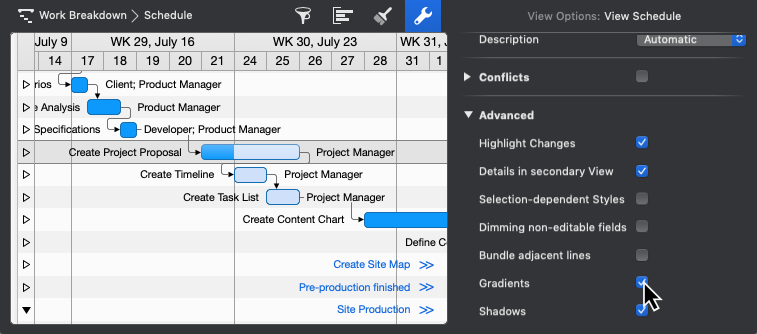
The Gradients option enables/disables the display of color gradients if the Gradients style is enabled for bar elements of this view.
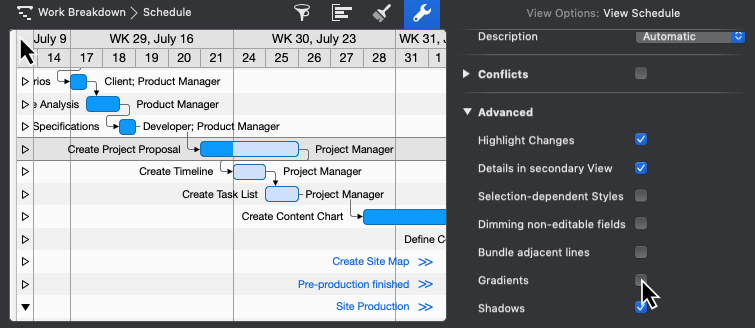
Shadows
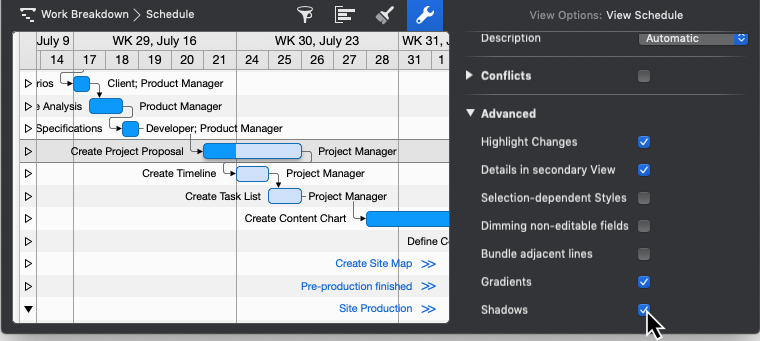
The Shadows option enables/disables the display of shadows if the Shadows style is enabled for bar elements of this view.
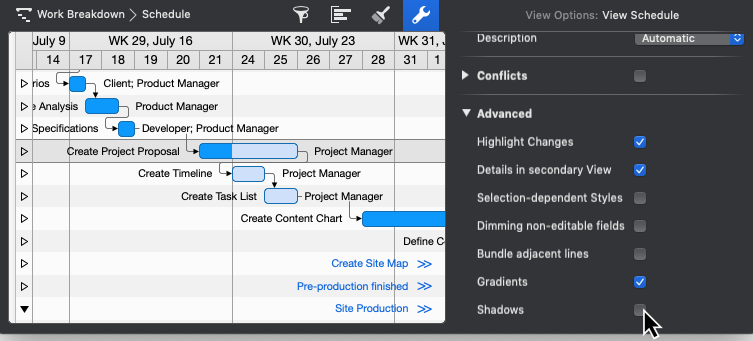
Objects and Sorting Fields
This table can be used to sort the current view by specific fields in descending or ascending order.
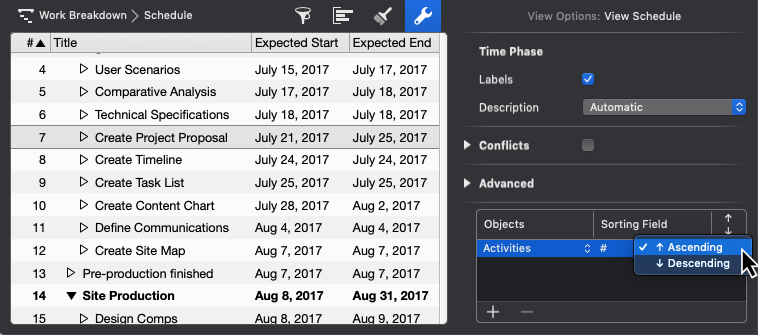
A mouse click on the + creates a new sorting option.
Project content
Below you will learn how to create project content (activities, milestones and more) in Merlin Project.
Plus icon
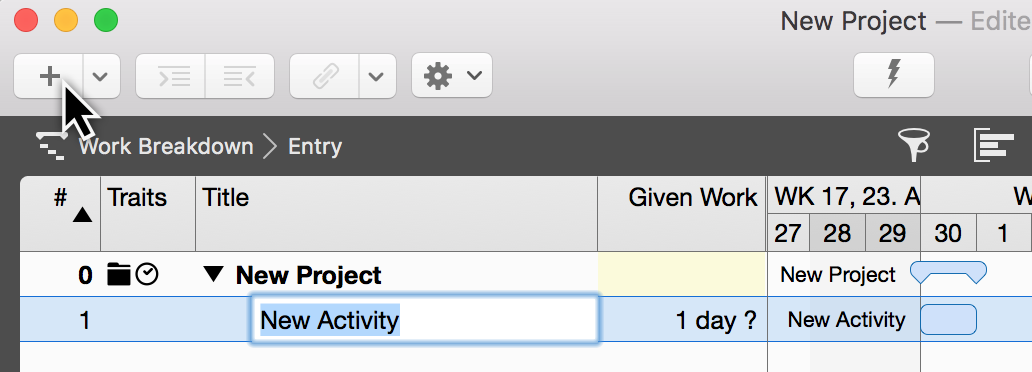
The easiest way to create new activities is to click New (the plus icon in the toolbar) or even faster with the keyboard shortcut cmd + N.
|
|
If you repeat the step several times, the activities appear in chronological order. |
Newly created content is activated and ready to be named. Add a title to the activity.
|
|
You can quickly convert an activity into a milestone. To do this, tick the checkbox next to the Milestone option in the Inspector. If you uncheck the box, a milestone will become an activity again. |
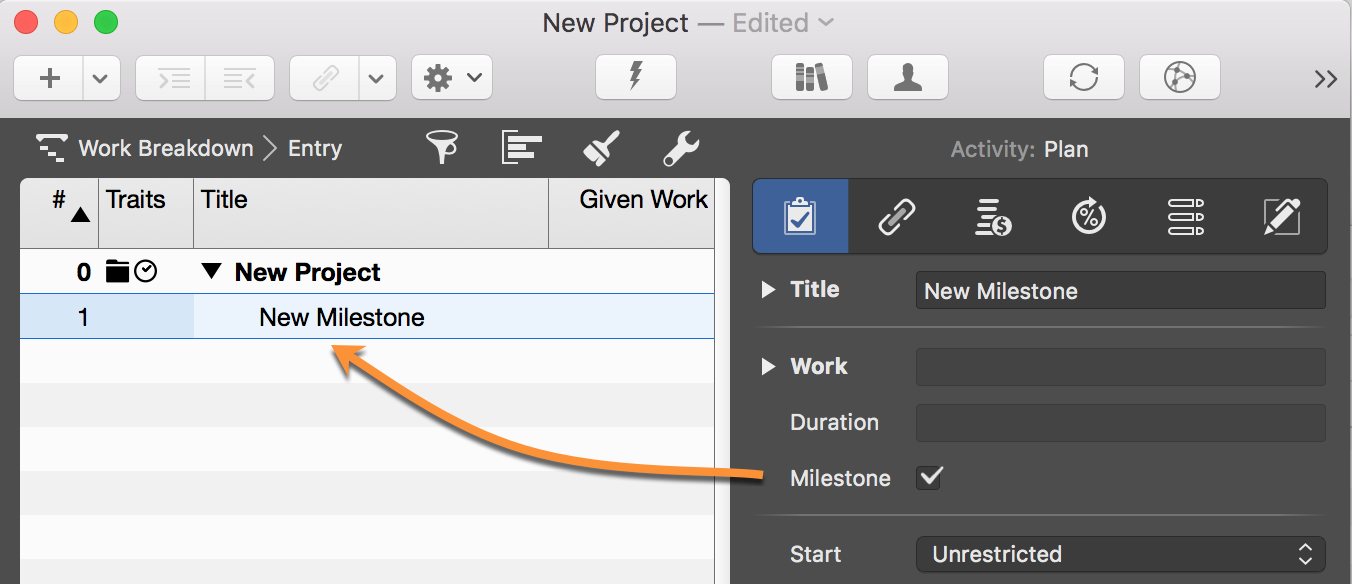
If you click the arrow to the right of the plus icon, a menu appears with further content for selection.
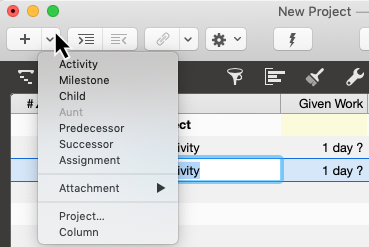
Depending on your current selection, you can create the following content:
-
Activity (creates an activity)
-
Milestone (creates a milestone)
-
Child (creates an indented activity)
-
Aunt (creates an outdented activity)
-
Predecessor (creates a link to the successor)
-
Successor (creates a link to the predecessor)
-
Assignment (creates an assigned resource)
-
Attachment (creates an attachment)
-
Project… (links another project as sub-project)
-
Column (inserts a column into the outline)
|
|
The aunt option remains grayed out until an indented activity is selected at least one level down. Only then will an outdented activity be created using the aunt option. |
Insert menu
You can also create the content listed above using the Insert menu item.
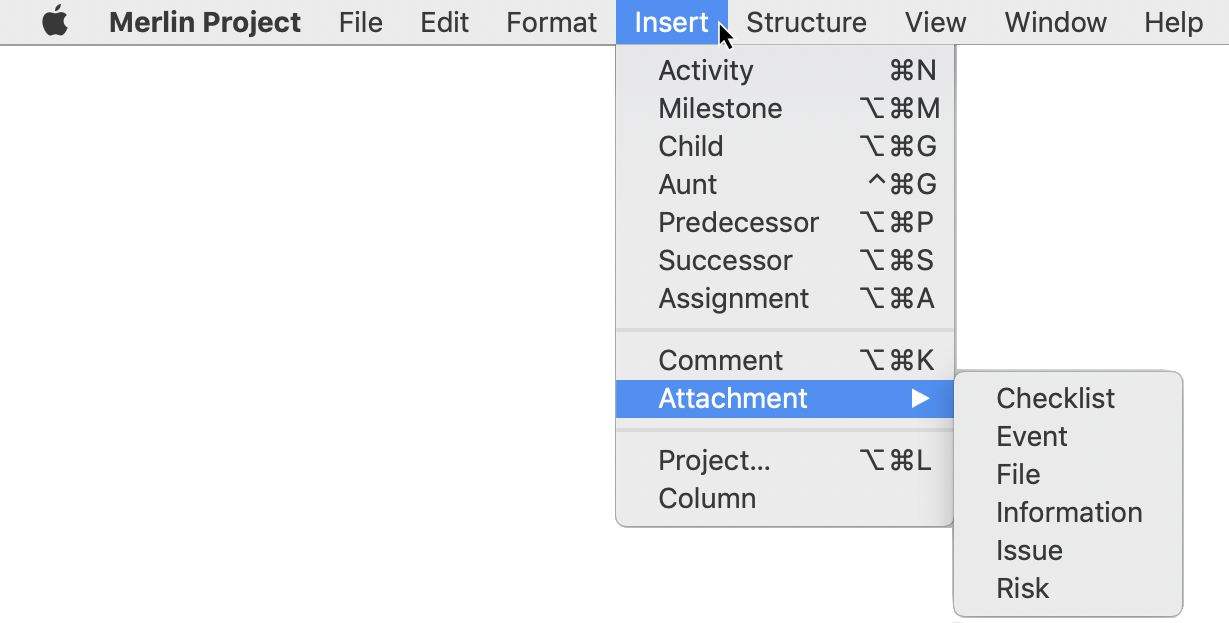
Insert menu - context menu
In addition, the context menu shown can be called up in the view by performing a secondary-click. Among other things, it includes the Insert option.
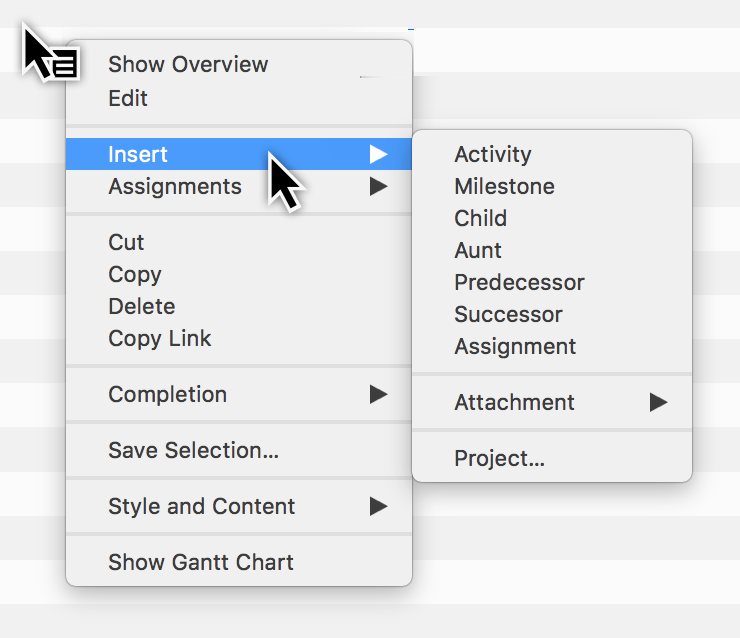
|
|
New content is created beneath the current selection. If nothing is selected in the main area, new content is created beneath the last row at the end of the project. |
More content
A project needs content. This content can be inserted manually, copied from a template, the library or imported from different documents.
|
|
The Library is a feature existing only in Merlin Project, not in Merlin Project Express. |
Import
Merlin Project can open various file formats:
-
CSV text (recommended for import of EXCEL sheets)
-
ics (iCalendar files)
-
Merlin 2
-
Microsoft Project (.mpp files from MS Project 2003, 2007, 2010, 2013 and 2016 as well as XML and MPX)
-
MindManager / FreeMind / NovaMind 4 & NovaMind 5
-
Omniplan 2
-
OPML
-
Merlin Project XML
There are two ways to import new content:
File > Open
Call the File → Open… menu item. It opens existing documents. If the format of the selected document is supported, Merlin Project imports the content and opens it in a new document.
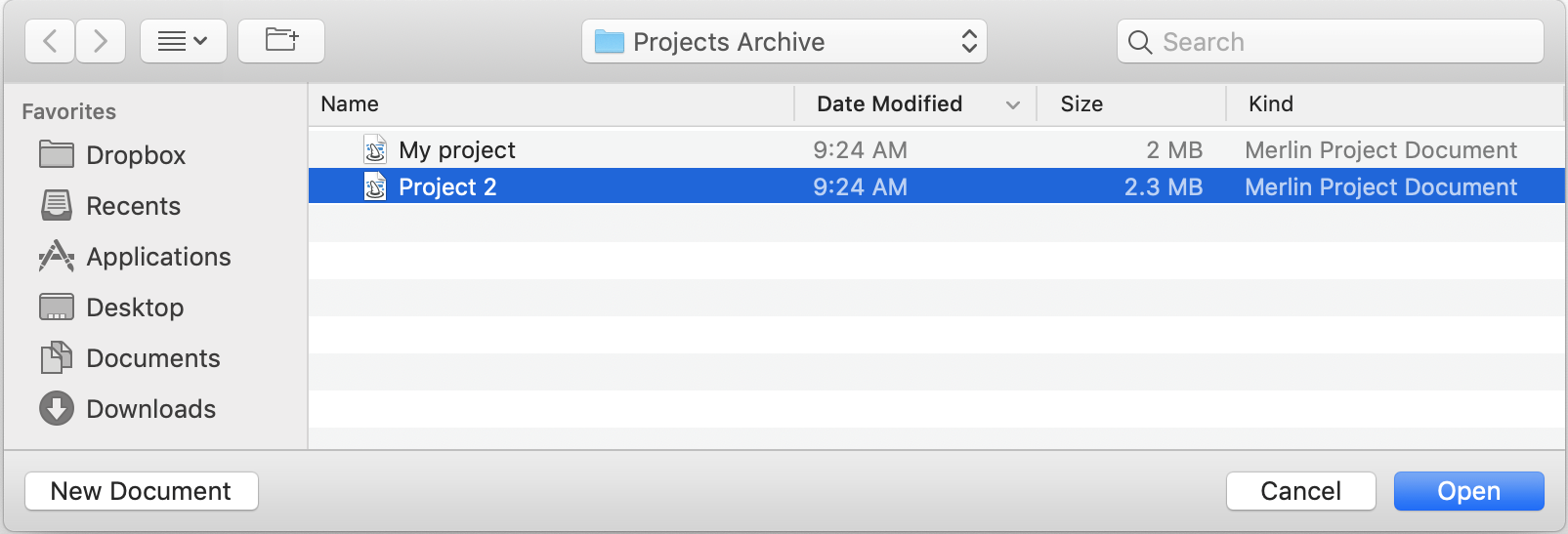
Drag & drop using the mouse
You can drag & drop a document directly onto the Merlin Project application icon or onto an existing project. Latter, imports the document into the existing project.
Content from templates
Project templates make working with recurring content easier. They are perfect for starting new projects quickly.
A large number of templates can be found in the File → New… (1) menu item.

You can save existing projects for later use as templates. To create a template of your own from a project, call the File → Save As Template… (2) menu item.
Library content
The Library contains content suitable for the modular creation of projects. Furthermore, you can store custom content in the Library and use it in any project whenever you want.
Call Windows → Library in the menu to open the Library.
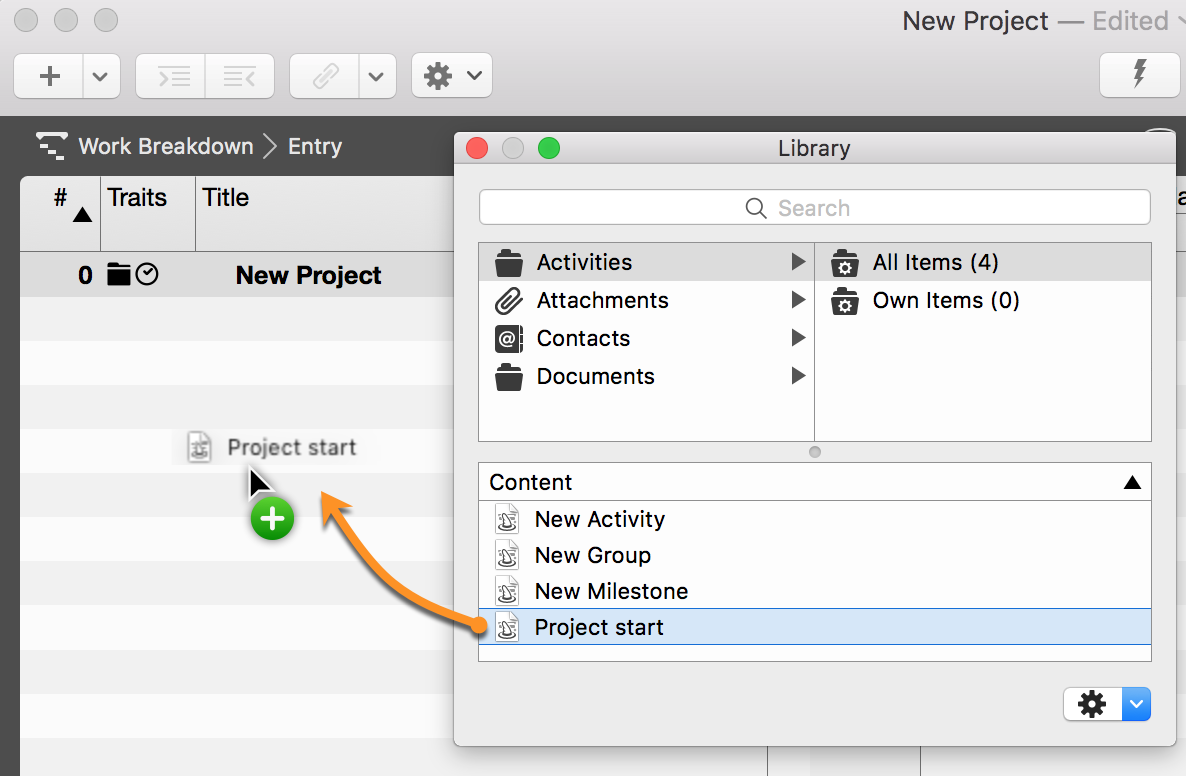
You drag & drop custom activity groups into the Library using the mouse pointer. This content is saved automatically in the Library for later use.
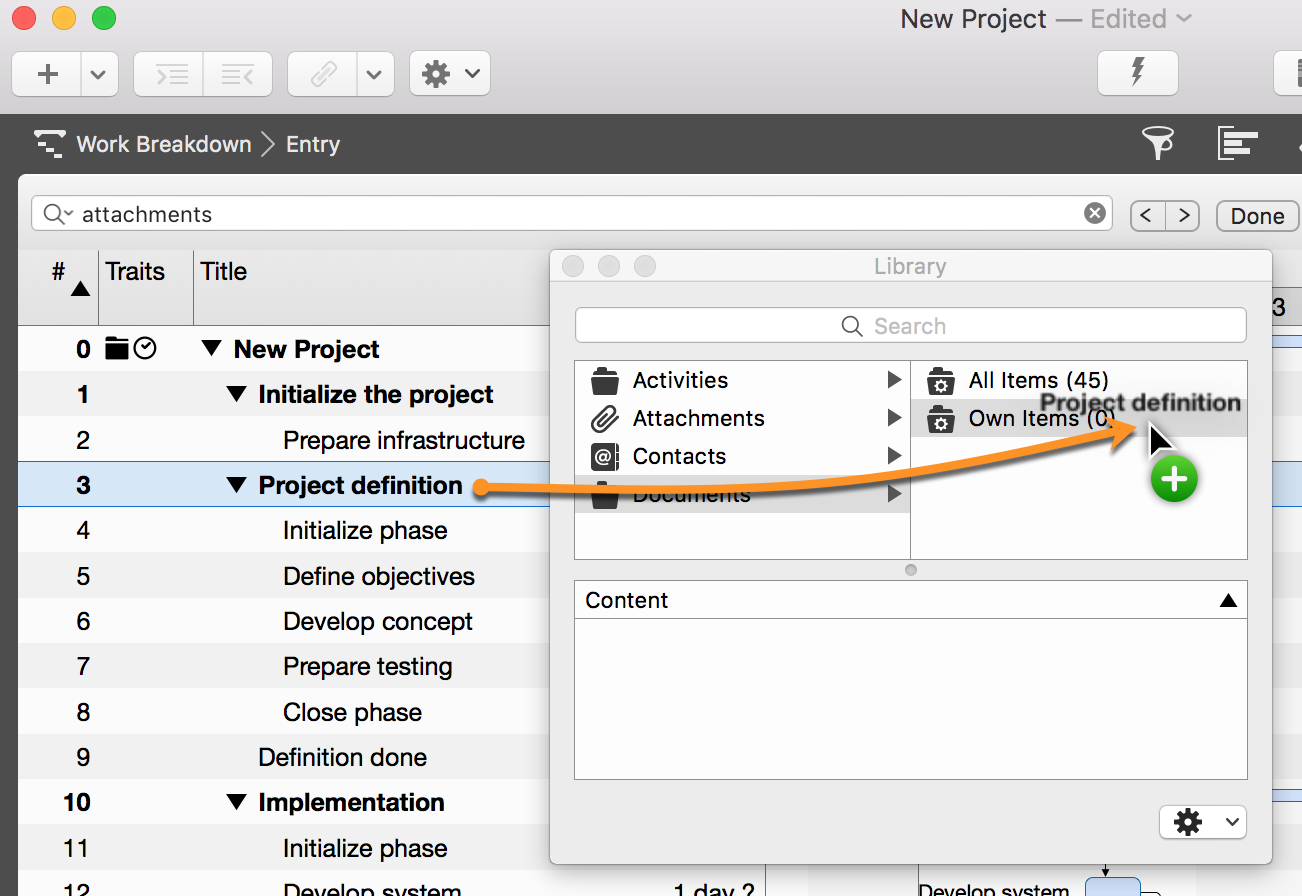
Work and duration
In Merlin Project you can schedule activities by work, duration, start and end date constrains.
Simply select an activity, use the Plan inspector and define your activity as required. Alternatively you can use related columns in the outline.
|
|
For flexible planning and easier adjustment throughout the life of your project, we recommend that you define as few start and finish dates as possible and as many as needed. |
Work
If you want to schedule your activity by the effort it will need to be completed, use the Plan inspector or enter the effort in the Given work outline column.
You want to schedule the painting of a room. You estimate the required effort for the activity as 2.5 working days. You expect that when assigning this activity to let’s say two resources, each resource’s effort will be half as much.
-
So you create a new activity.
-
Select it.
-
Check in Plan inspector.
-
Change the Work value to 2.5 days.
-
Leave the value in the Duration field empty.
|
|
You can adjust the Default Value '1 day ?' for work in Settings > General > Work The ? indicates that the value is estimated. Remove it when you are sure about the value or don’t need so much detail in your planning. |

Alternatively: You can edit the Given Work value in the outline column.
Duration
If you want to schedule your activity by the duration it will need to be completed, use the Plan inspector or enter the effort in the Given duration outline column.
You want to schedule a seminar. The duration for this seminar is 2 working days. You expect that when assigning it to your trainer personel, all assigned trainers will work throughout the complete duration of this seminar.
-
So you create a new activity.
-
Select it.
-
Check in Plan inspector.
-
Blank the Work value.
-
Enter 2 days in the Duration field.
|
|
You can adjust the Default Value for duration in Settings > General > Duration |

Alternatively: You can edit the Given Duration value in the outline column.
You schedule a team meeting on a remote location. You want to plan with 1.5 working days. But also need to block 3 working days of your team for the overall duration. Within those 3 days, your team transfers to the remote location, works for those 1.5 working days and transfers back to its base.
-
So you create a new activity.
-
Select it.
-
Check in Plan inspector.
-
Change the Work value to 1.5 days.
-
Enter 3 days in the Duration field.

You want to schedule an event for which you know it will be 3 calendar days long. It starts on Friday and the weekend (which is usually non working time) should be included in the overall duration.
-
So you create a new activity.
-
Select it.
-
Check in Plan inspector.
-
Blank the Work value.
-
Enter 3 edays in the Duration field.

Alternatively: You can edit the Given Duration value in the outline column.
|
|
Such an event starting first thing on Friday and ending on first thing on Monday, includes only working times on Friday. If you want to adjust the included effort, modify the Work value accordingly. |
You want to schedule the placing of a concrete slab. You estimate the required effort for the activity as 1.5 working days. You know concrete starts drying directly as you pour it and requires at least 1 calendar week of overall drying time.
-
So you create a new activity.
-
Select it.
-
Check in Plan inspector.
-
Change the Work value to 1.5 days.
-
Enter 1 eweek in the Duration field.

Alternatively: You can edit the Given Work and Given Duration values in the outline columns.
Working times
In the above examples we used the terms working days, working week.
For simplicity reasons, we enter them in Merlin Project as '2 days' or '1 week'.
Let’s check the defaults in Settings > General > Work
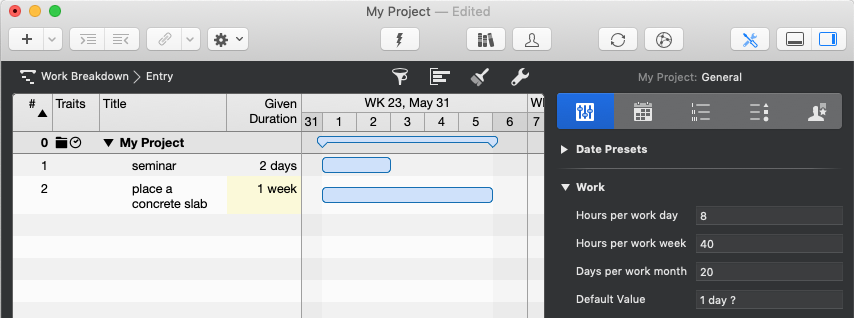
Per default, 1 working day are 8 working hours, 40 working hours make a week and 20 days a month.
So '2 days' are those '2 working days' of '8 working hours' each. '1 week' means '40 working hours' which calculates as '5 working days' or '8 working hours' each.
Let’s check the defaults Settings > Calendars
-
Select the calendar on which the checkbox Project Calendar is enabled
-
Check the Regular Week tab
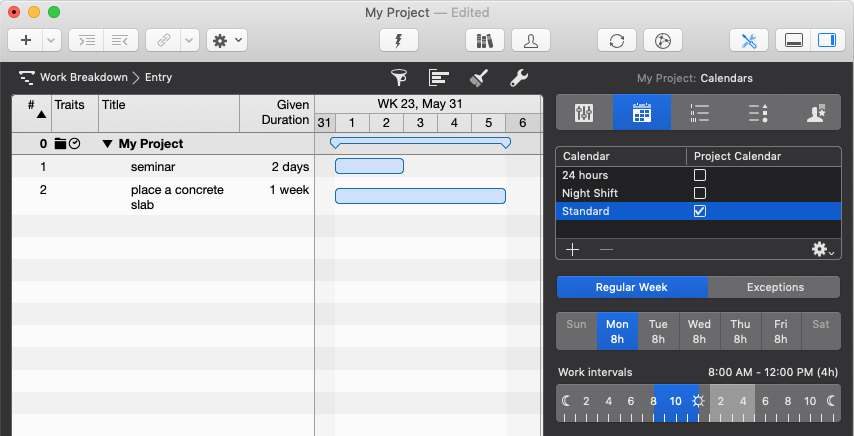
Per default, there are 5 work days: Monday to Friday. Each work day includes work intervals from 8am to 12pm and 1pm to 5pm.
So the working time on Monday starts at 8am and ends at 5pm.
|
|
Should you choose to adjust your regular week or work intervals in Settings > Calendars make sure you also adjust your defaults in Settings > General > Work to match the new values. |
Let’s select an activity of '2.5 days' work and open the Plan inspector.
We see in the Expected
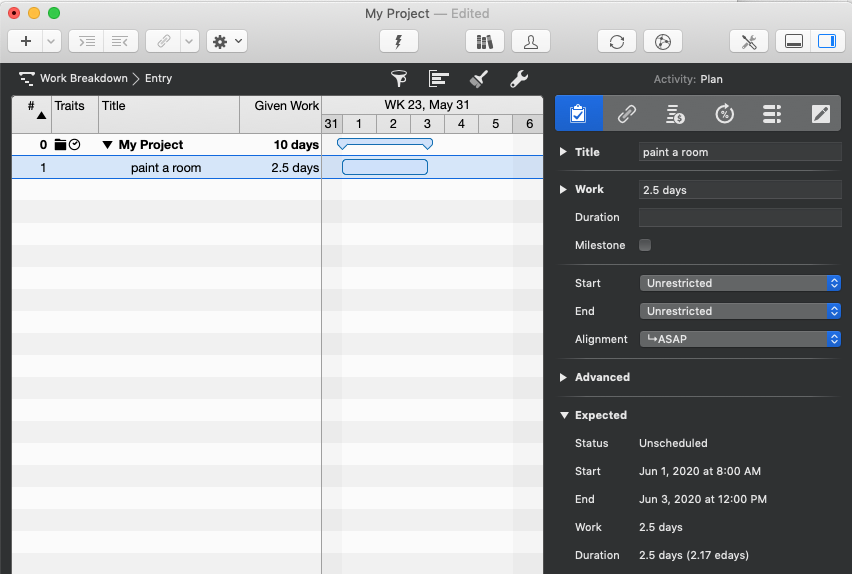
-
Work: 2.5 days
-
Duration: 2.5 days (2.17 edays)
We know that 2.5 days are 2.5 working days, 20 working hours. This activity has the same amount of effort and duration.
2.17 edays is the elapsed calendar time and time period to expect the activity to be completed. The prefix "e" denotes "elapsed".
The elapsed duration is the duration plus the free time contained.
By default and according to the settings (Settings > Calendars) a regular work day starts at 8am, contains a lunch break between 12pm and 1pm and ends at 5pm.
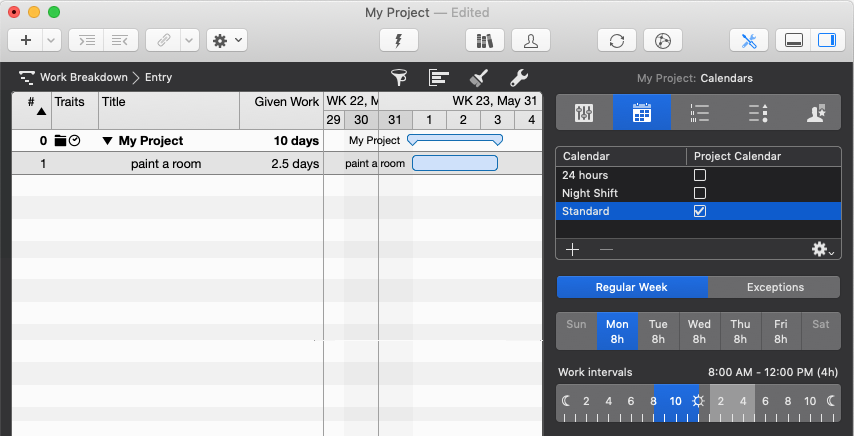
An activity with the planned 2.5 days of work, which starts at 8am requires for the first 8 hours (four in the morning, four in the afternoon) 9 consecutive hours (ehours) on the first day.
The works stop at 5pm and start next day at 8am. So there are 15 hours of free time. From 8am until 5pm on the second day there are further 8 hours (9 ehours), until once again at 5pm 15 hours of free time start again.
The remaining 4 hours can be scheduled on the third day to start at 8am and finish at 12pm. So to the 20 hours of work, you add 32 hours of free time which calculates as 52 ehours.
52 ehours divided by 24 ehours equals 2.16666 edays, or 2.17 edays.
Should you change the Calculation Unit to Hour in Settings > General > Duration …
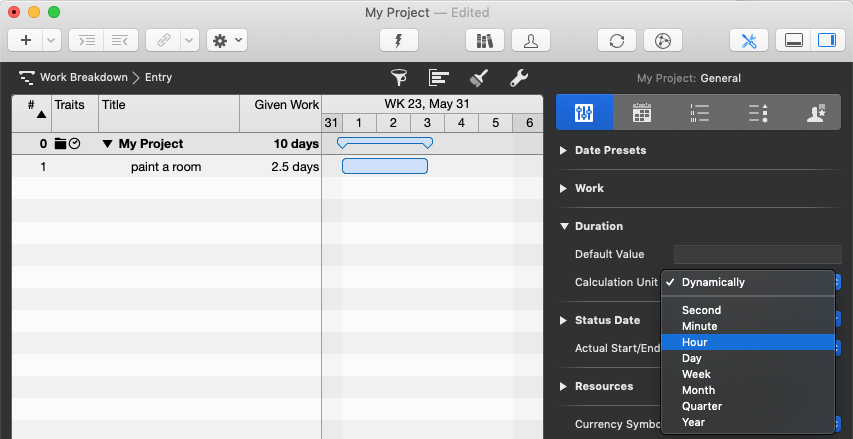
And select again your activity, you’ll see expected values in hours thus:
-
Work: 20 hours
-
Duration: 20 hours (52 ehours)
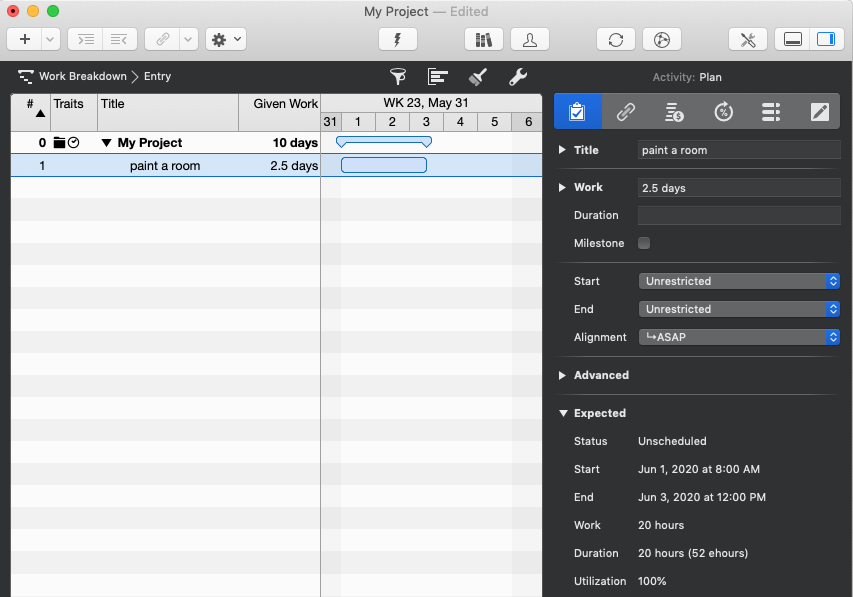
Project structure
It’s a good idea to group activities together to structure your project. This gives a clearer picture of the individual project phases.

Indent
The indention of activities in the outline creates groups and, if required, further indented child activities (children) and child groups automatically.

Indenting to another level creates a child activity and a resulting group automatically.

The activity above the indented content becomes a group automatically, which is identifiable graphically by the group bar.
|
|
A project is always a group and, like all groups, can be expanded and collapsed using the small triangle. |
Outdent
The outdent icon moves activities out of a group and its child groups.

Select one or more activities and then click the outdent icon.
Outdenting is only active if the selected activities or milestones are already in a group. An outdented activity is called an aunt.
|
|
You can indent multiple selected activities/milestones. Additionally, you can use your mouse to nest activities in other activities or indent or outdent activities in the levels using the Structure → Indent or Structure → Outdent menu item or the corresponding keyboard shortcuts cmd + → or cmd + ←. |
Link and connect
This guide shows you how to create dependencies in Merlin Project.
Why link
The aim of linking content in a project is to define the sequence in which the activities are worked through logically.

Example: Only when Activity A is completed can Activity B begin. Activity A is the predecessor of Activity B, which is its successor.
Creating links
You can link project activities. When linking, dependencies are created that define a logical sequence.
Select at least two activities that you want to link together.

On the toolbar you will find the Link button. If you click the arrow to the right of the Link icon, the available link types and the option to separate existing links appear.
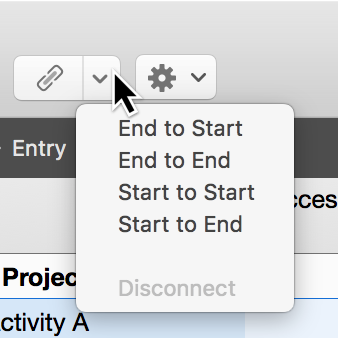
Click the Link icon or use the keyboard shortcut ctrl + cmd + L for the End to Start dependency type. The two activities are now linked with an arrow.

Alternatives
All roads lead to Rome, including the various possibilities for creating links.
Menu and context menu
In the Structure → Link menu item you will find the same options.
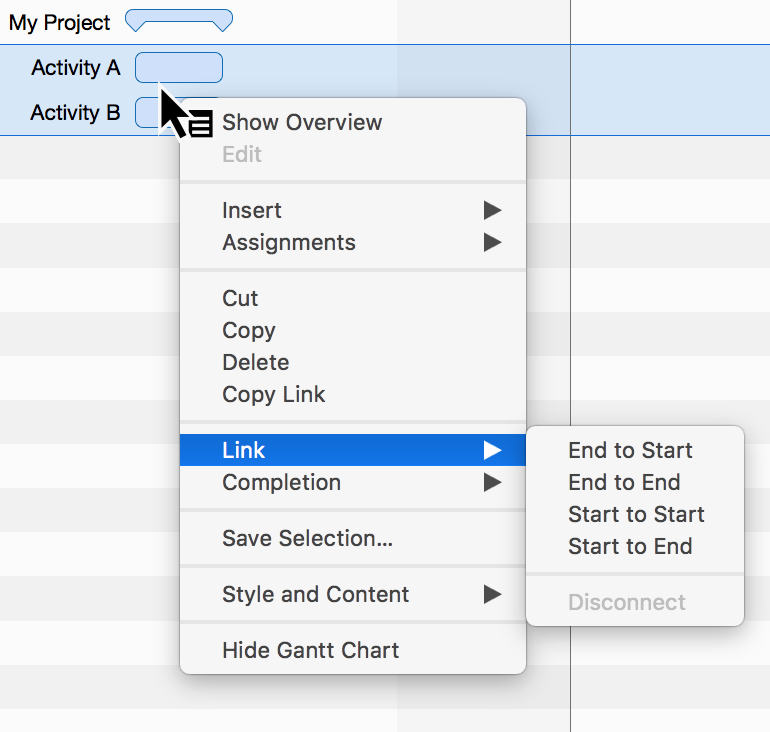
|
|
Secondary-clicking selected content will display the context menu. This contains the dependency option with the four dependency types. |
Linking using the mouse
You can also link activities in the Gantt chart using your mouse. Press and hold the alt button while hovering the mouse pointer over an activity bar or milestone.

A small black dot appears on the activity. While holding down the alt key, move the mouse to another activity (successor).
The dependency will be created as soon as you release the mouse button.
Linking with columns
In the Predecessor or Successor columns, you can see the predecessor or successor activity numbers (#).

Enter an activity number in the Predecessor or Successor columns, to create a dependency of the current activity row to that number.
|
|
The Successor column is not activated by default. |
Disconnecting links
To disconnect links, click a link line and press the delete key.

If you need to delete several links, select all activities and use the Disconnect option in one of the Link menus.
Dependency Inspector
If you select a link, the Dependency inspector appears.
The options contained in the Dependency inspector are responsible for the dependency of linked activities, groups, and milestones.
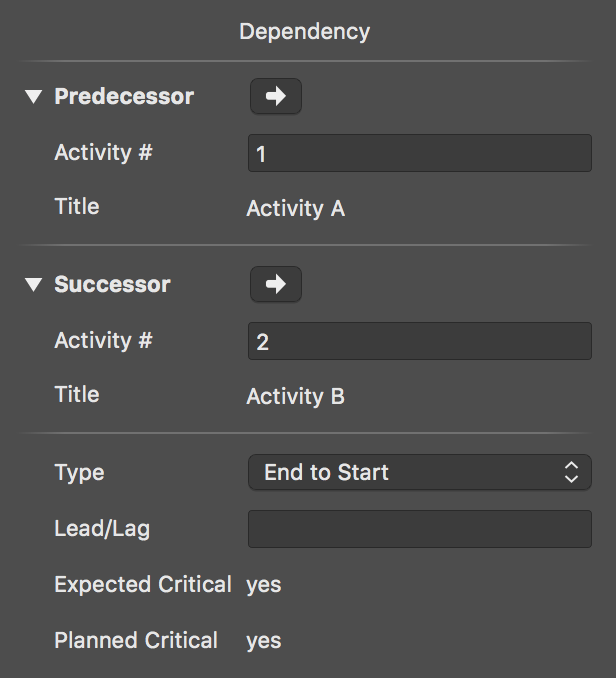
Here you can modify the predecessors and successors, and find them quickly in the project by clicking the arrow.
In the Type drop-down menu, you can select the dependency types. This lets you change the current dependency:
-
End to Start
-
End to End
-
Start to Start
-
Start to End
Lead/Lag in links
Click a link line to access the Dependency inspector.

Enter a time unit in the Lead/Lag field to lengthen the dependency between the linked activities.
If you enter a negative value, the dependency and the linked activity will move back along the timeline according to the entered lag value. For example, enter -2 days in the Lead/Lag field.
|
|
Lead/Lag can be entered manually in the Predecessor or Successor columns. |
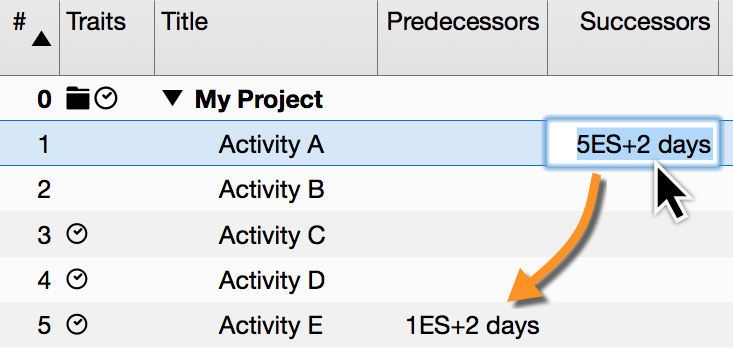
Example: If you enter the value 5ES+2 days in the Successor column for an activity, an End to Start dependency will be created with the Activity #5 and a lead/lag of 2 days.
At the same time, the Activity #5 will be also linked to Activity #1 by a lead/lag of 2 days. Its Predecessor column will show then: 1ES+2 days
Resources
This guide shows you how to create resources and assignments in Merlin Project.
What are resources
Resource is a term for people, materials and equipment used in the project.
Merlin Project offers the following resource types:
-
Person (involved in the project actively or inactively)
-
Material
-
Company
-
Equipment
|
|
The default resource type is Person. |
Creating resources
The Resources toolbar icon opens a pop-up window listing all resources in your project.
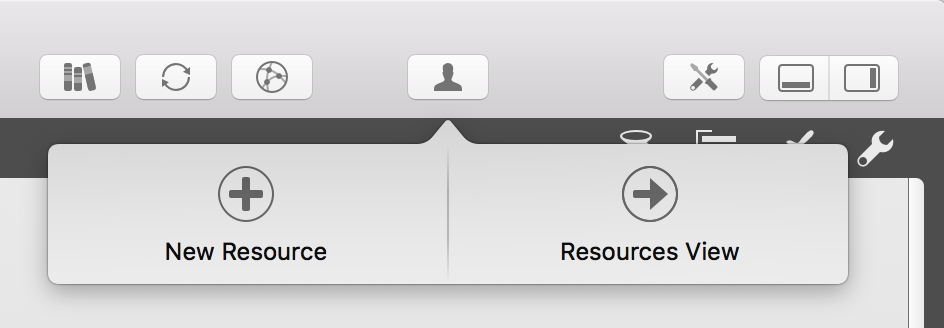
You can quickly create new resources in Merlin Project by clicking New Resource in the pop-up window.
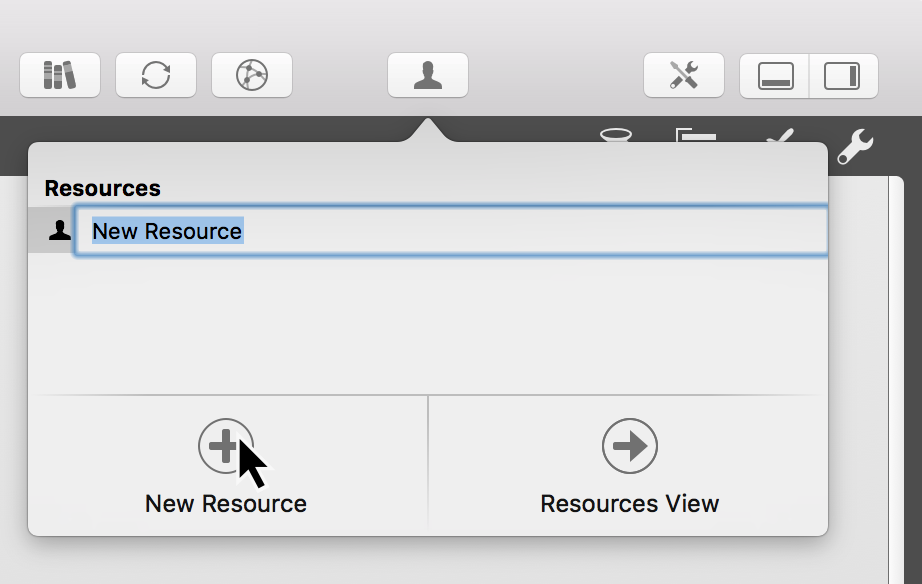
Using resources pop-up
The resources pop-up is perfect for gaining a quick overview of project resources.
For more information on your resources and for a more detailed edit of the values of your resources, click on Resources View. Merlin Project will switch quickly to that view.
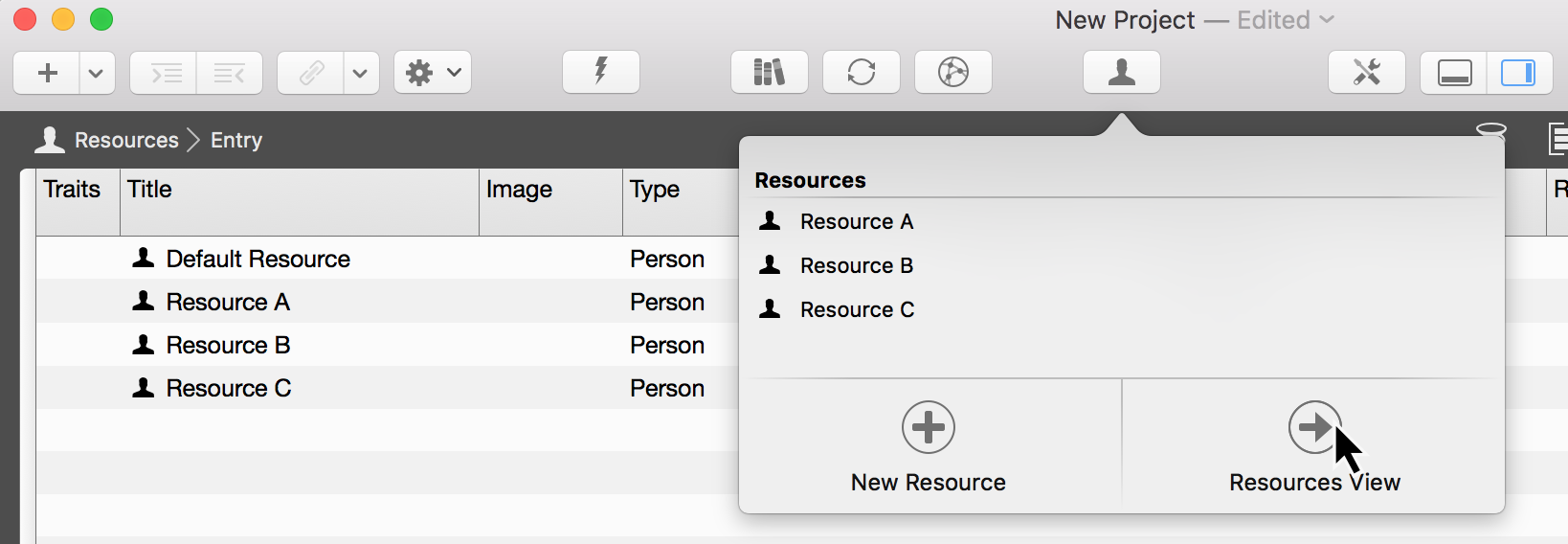
|
|
Switch to the Resources View to insert an image for your resource, thus… |
The resources pop-up can be used as a separate window. Move the window down with the mouse pointer.
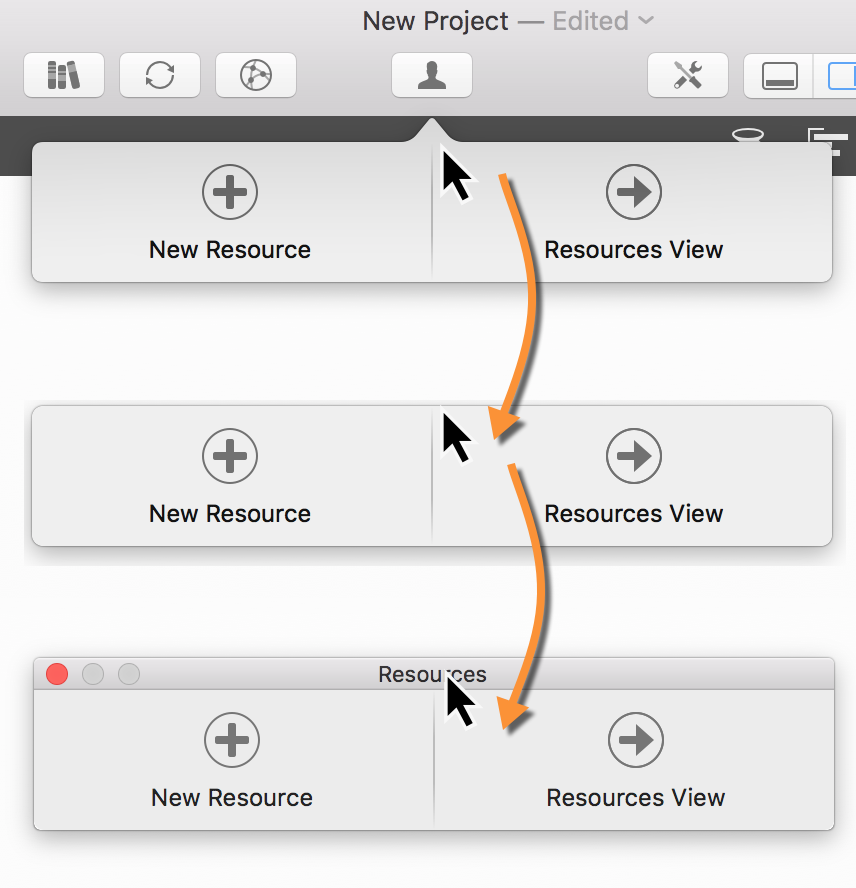
|
|
You can quickly show or hide the resources pop-up as a separate window using the F4 key or via the Window menu item. |
Creating assignments
Move a resource from the resources pop-up to an activity, group, or milestone. An assignment is created automatically.
|
|
A resource assigned to an activity is called an assignment. This resource works on the activity assigned to it in the project. |
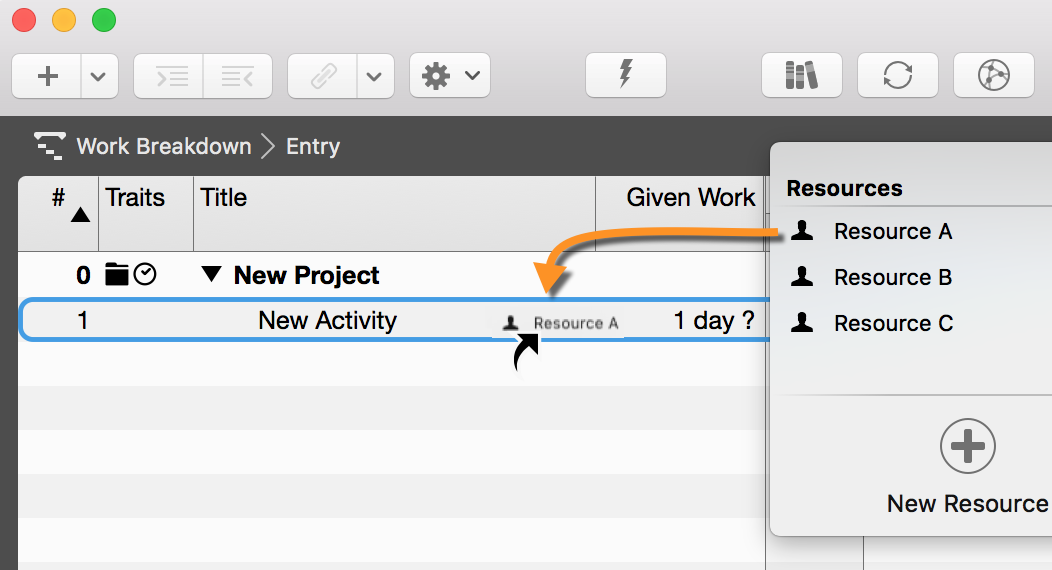
The assignments are identifiable by the white triangle. Multiple assignments can be created for an activity and these share the work automatically.
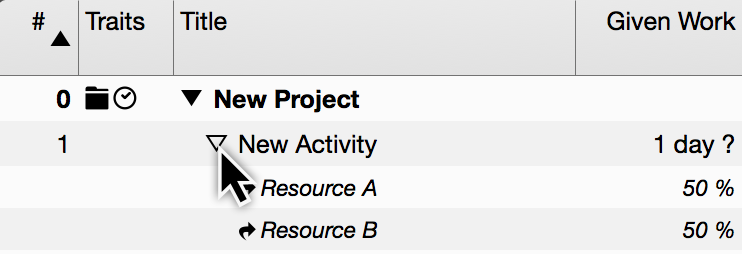
For selected activities in a view, the Assign option appears in the resources pop-up. This allows you to add additional resources as assignments to the activity quickly by marking the check box.
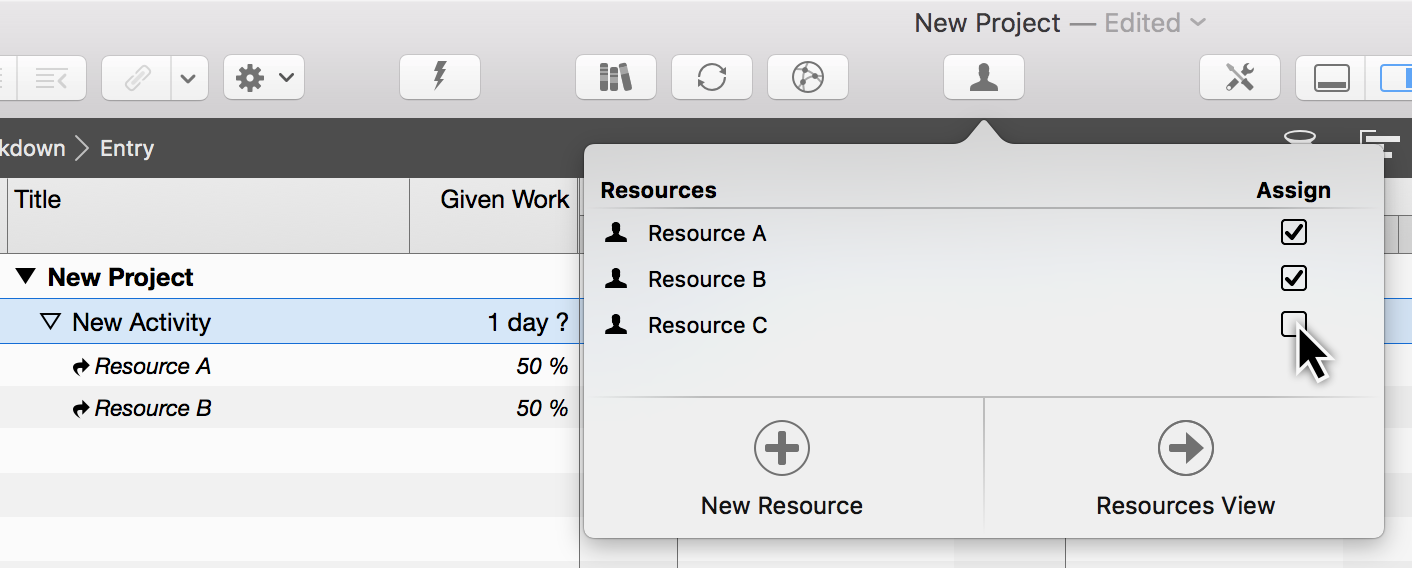
If the checkmark is removed, the assigned resource is also removed from the activity.
|
|
You can create new assignments for the selected activities automatically using the Insert → Assignment menu item or the corresponding shortcut option + cmd + A . |
Assign to contacts from the Contacts app
Merlin Project allows you to use contacts from the Contacts app as resources in your project.
Open the Contacts app, select the contacts in question. Use the mouse to drag and drop them on activities, milestones, or groups. These contacts are added as resources to the project and assigned to the activities automatically.
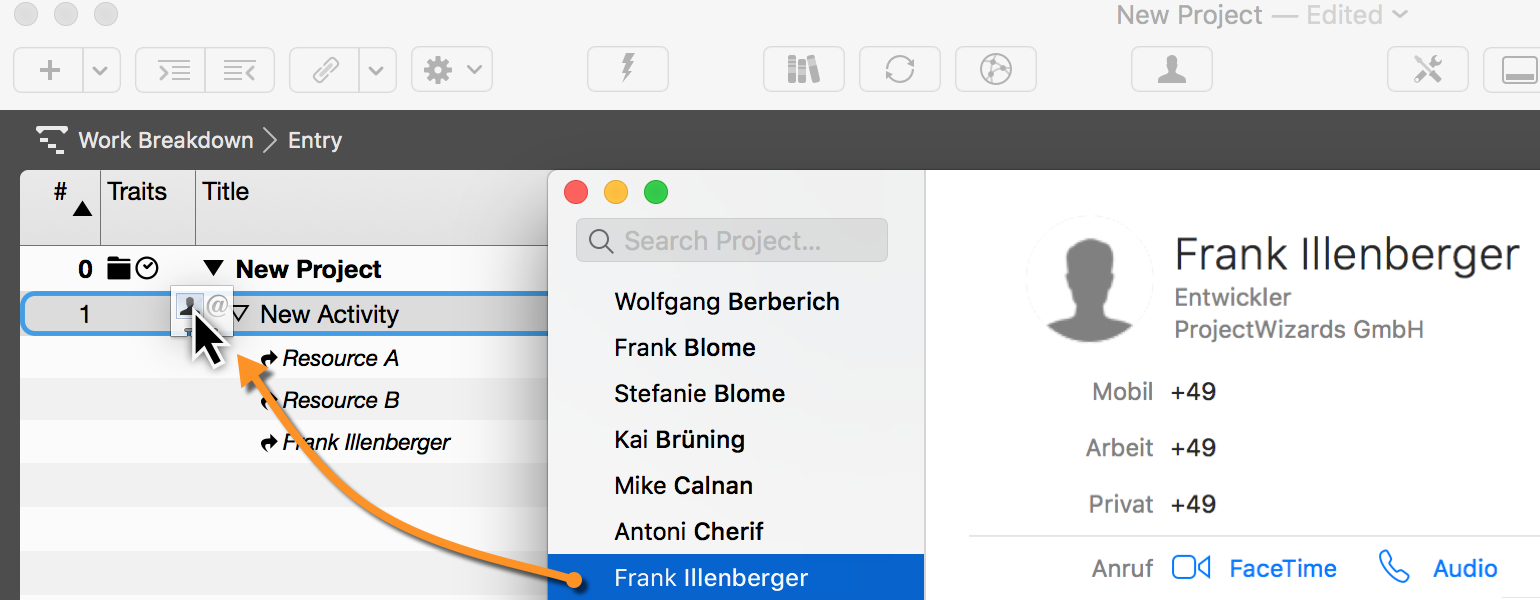
Time scale
What is the time scale
The time scale is the display of time in the Gantt chart. The default time scale contains two tiers, the upper and the lower one.
In the time scale Inspector, you can make a range of adjustments to the time units and other options.
Time scale Inspector
Click a row in the time scale to open the corresponding Inspector.
There you will find a range of options for adjusting the clicked time scale and settings for the Date Range and Non-working Time.
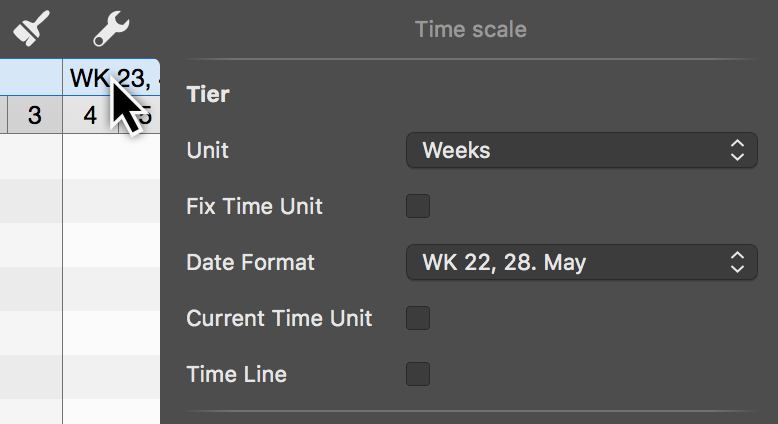
|
|
The selected time scale is shaded blue. The options only apply to this selected tier of the time scale. |
-
Unit (Minutes / Hours / Days / Weeks / Months / Quarters / Years)
-
Fix Time Unit (fixes the selected Gantt unit and preserves it even when zooming the view)
-
Date Format (absolute and relative formats for displaying the units, e.g. from project start or end)
Current Time Unit

If you enable the Current Time Unit option the time unit in the Gantt chart which contains the status date, will be shaded blue. This gives you an additional highlight on the Gantt of the project, to quickly visually identify the tasks that are due during this period.
Time line

Similar to the Current Time Unit option, the Time Line option allows you to add a vertical marker to the Gantt chart.
If you check the Time Line option, the status date will appear as a thin red line on the project Gantt.
|
|
The status date updates automatically by default and shows the macOS date and time, but can also be set in the project settings if required. |
Time scale context menu
Secondary-click the time scale to display the context menu.
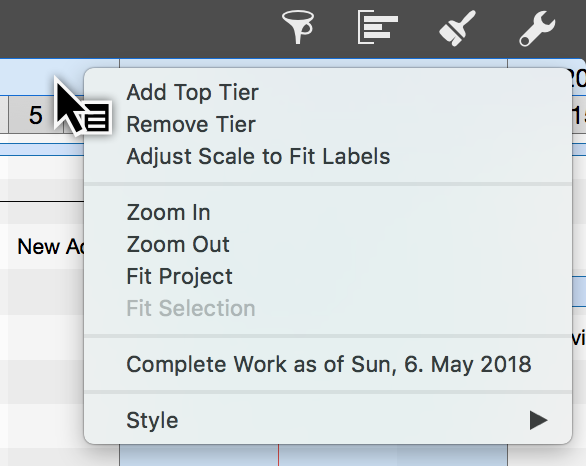
Add Top Tier
The Add Top Tier option lets you insert one more tier to the time scale.
|
|
The time scale can show up to four tiers. |
Remove Tier
The Remove Tier option lets you remove the selected tier from the time scale.
|
|
The time scale requires at least one tier. |
Adjust Scale to Fit Labels
The Adjust Scale to Fit Labels option adjusts the width of all active time scale columns automatically.
The available space on the time scale is set automatically to the best width.
Zoom In / Out
The time scale is enlarged or reduced according to the selection.
The content of the time scale grows or shrinks with it. The time units are adjusted automatically as required.
Fit Project
The Fit Project option adapts the time scale to the project.
The entire project is zoomed into until it fits into the visible area. The time scale grows automatically with it.
Fit Selection
The Fit Selection option adapts the time scale to the activities selected in the project.
The selection is zoomed into until it fits into the visible area. The time scale grows or shrinks automatically with it.
|
|
At least one activity, group, or milestone must be selected in the project for this option to be active. |
Complete Work as of
The Complete Work as of sets all activities contained in the project to the status Completed up to the date clicked in the time scale.
This makes it easy to determine the progress of the project just by clicking.
Style
The Style option changes the graphical appearance of the time scale.
|
|
For more information on style options, see the Styles and contents guide. |
Date range
The Date range option contains settings to restrict the visible date range in the project.
This is especially handy with large projects. Time phases in the past can be hidden. The focus is placed on the visible date range.
Restrict Date range
The date range is set in the Time scale Inspector.
Click the time scale. The Inspector will appear. This contains the Date Range options.
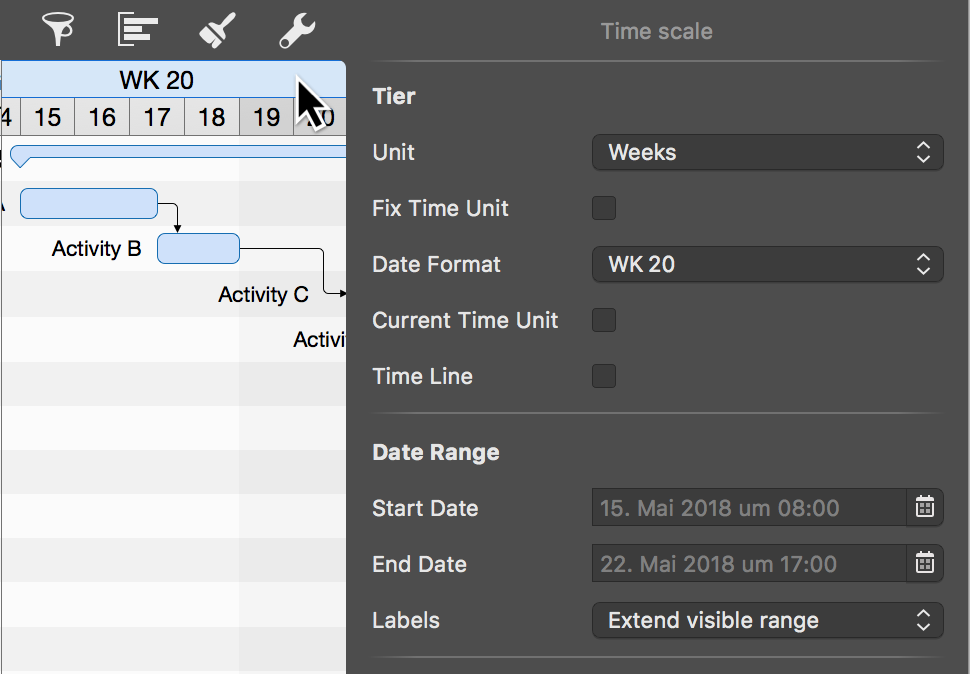
Enter the desired start and end date for how you want the date range displayed. To do this, click the calendar icon and the desired date.
|
|
If you leave the end date blank, the end of the project is adopted automatically as the end date for the end of the date range. |
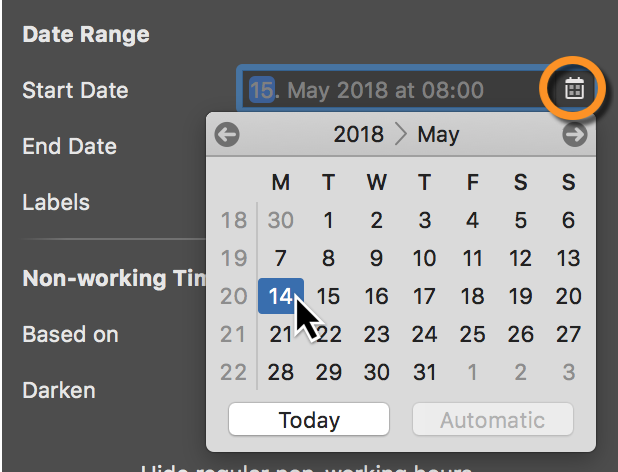
Once you’ve set the date range, the project displays the specified time period automatically. A blue bar above the Gantt chart (1) indicates the activated date range.
Hiding rows
Another option appears in the Inspector that lets you control the display of hidden rows in the outline.
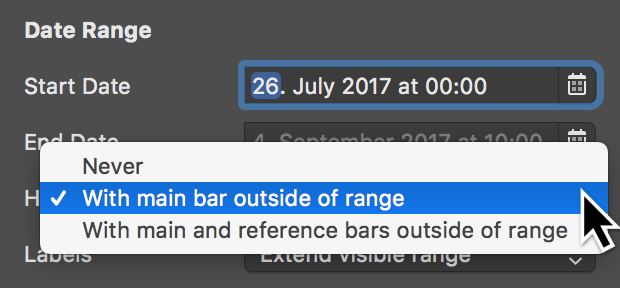
You have three options to choose from:
-
Never
-
With main bar out of range (default)
-
With main and reference bar outside of range
Never shows all rows, including those rows with link lines that are in the date range, but the corresponding activity bars are not visible in the date range.
With main bar outside of range refers to all rows containing an activity bar, but which are not in the date range.
With main and reference bars outside of range means all rows containing an activity bar and a reference bar, but which are not in the date range.
|
|
Reference bars are the grey bars that represent the originally planned state of the activity. They can be controlled in the View Options using the Secondary option. |
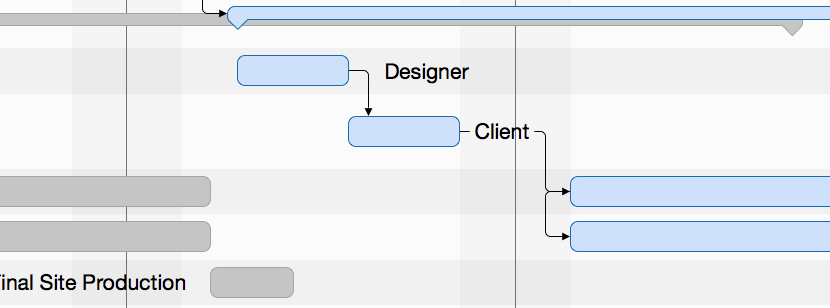
Labels
The Labels drop-down menu contains settings for controlling the display of labels in the activated date range.
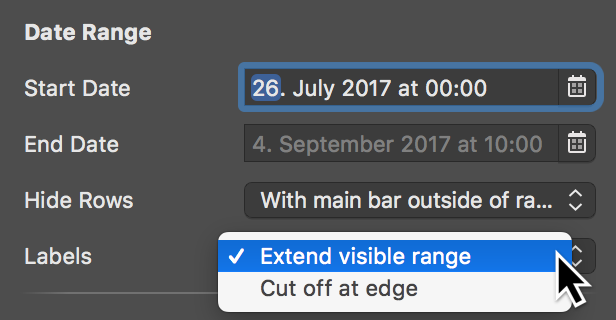
The default option Extend visible range displays the labels in full.
The Cut off at edge option cuts off the labels at the edge of the date range.
Non-working time
Non-working time is grayed out in Merlin Project. For example, the weekends in the project calendar are darkened by default.
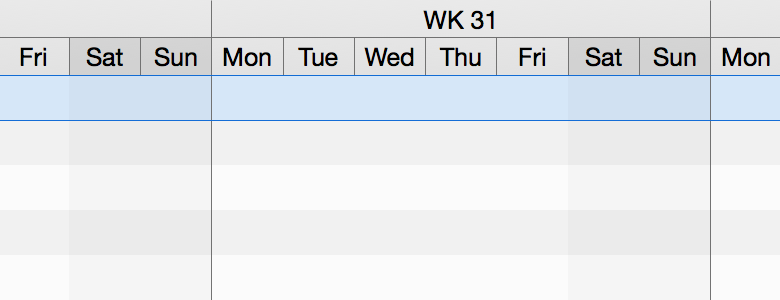
Click the time scale. In the Inspector you will find three options for adjusting the non-working time.
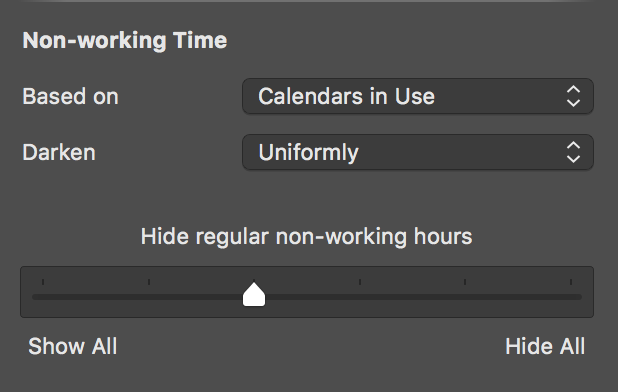
Based on
The Based on option lets you display the calendar based on its non-working time in the project.
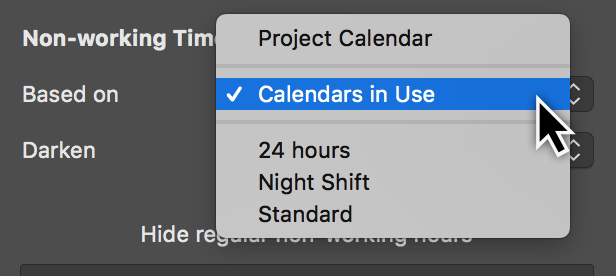
|
|
By default, the project calendar is preset as the base calendar for non-working time. There are further calendars to choose from in the drop-down menu. The calendar settings are located in the project settings and can be edited there. |
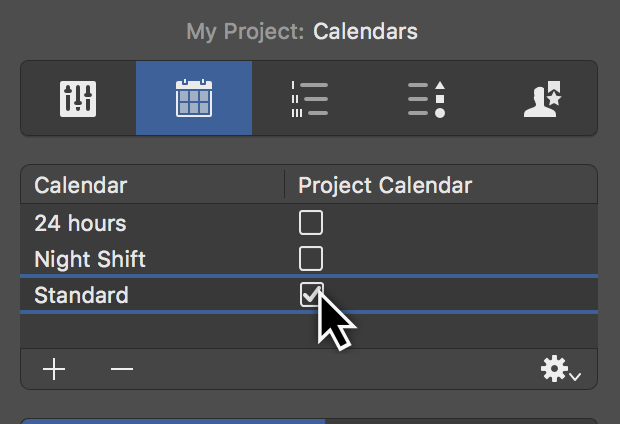
Darken
The Darken option has three configurations to control the display of non-working time in the project:
-
None
-
Uniformly
-
Individually per row
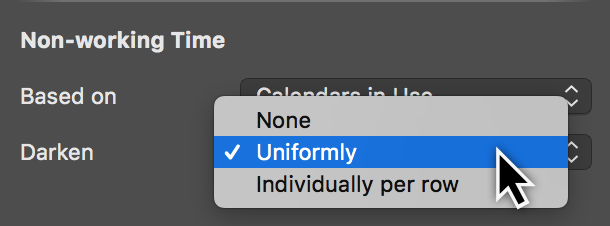
The Never option stops darkening the display of non-working time in the project.
The Uniformly option is set by default. The non-working times for the regular week in the project are displayed.
Activate the Individually per row option so that you can see the non-working times of resources and their vacation periods in the project in the respective row.
Regular non-working time
Using the slider, set whether you want the regular non-working times to be displayed or hidden.
Choose from the following options to display the working times:
-
Show All
-
Hide all regular non-working minutes
-
Hide regular non-working hours
-
Hide all regular non-working days
-
Hide all non-working days
-
Hide all non-working times
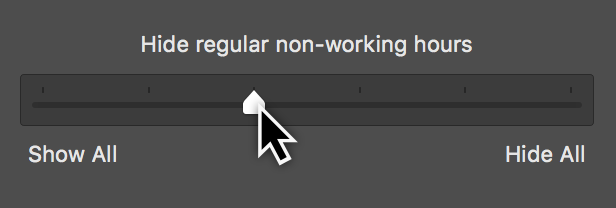
|
|
The effect of the slider setting depends on the selected zoom level in the active view. |
Comments
With Merlin Project you can use Comments to improve collaboration with your team members on your projects.
New comment
You may insert comments on every visible row item of any view if finding needed.
-
Select a row on its view
-
Call Insert → Comment in the menu (or use the keyboard shortcut alt + cmd + K)
-
Enter the desired text
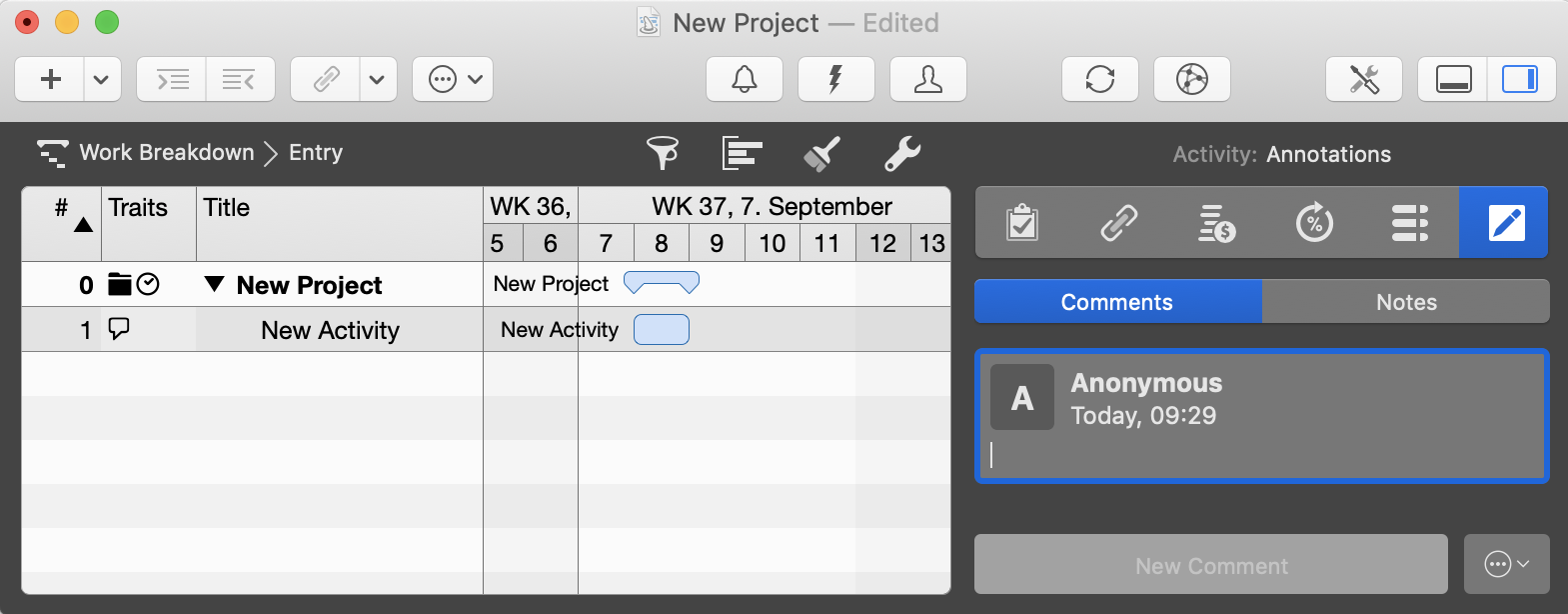
-
Press RETURN to confirm new comment
Alternatively
-
Select a row in its view
-
Open the Annotations inspector
-
Switch to the Comments tab
-
Click New Comment as shown at the bottom of the Annotations inspector
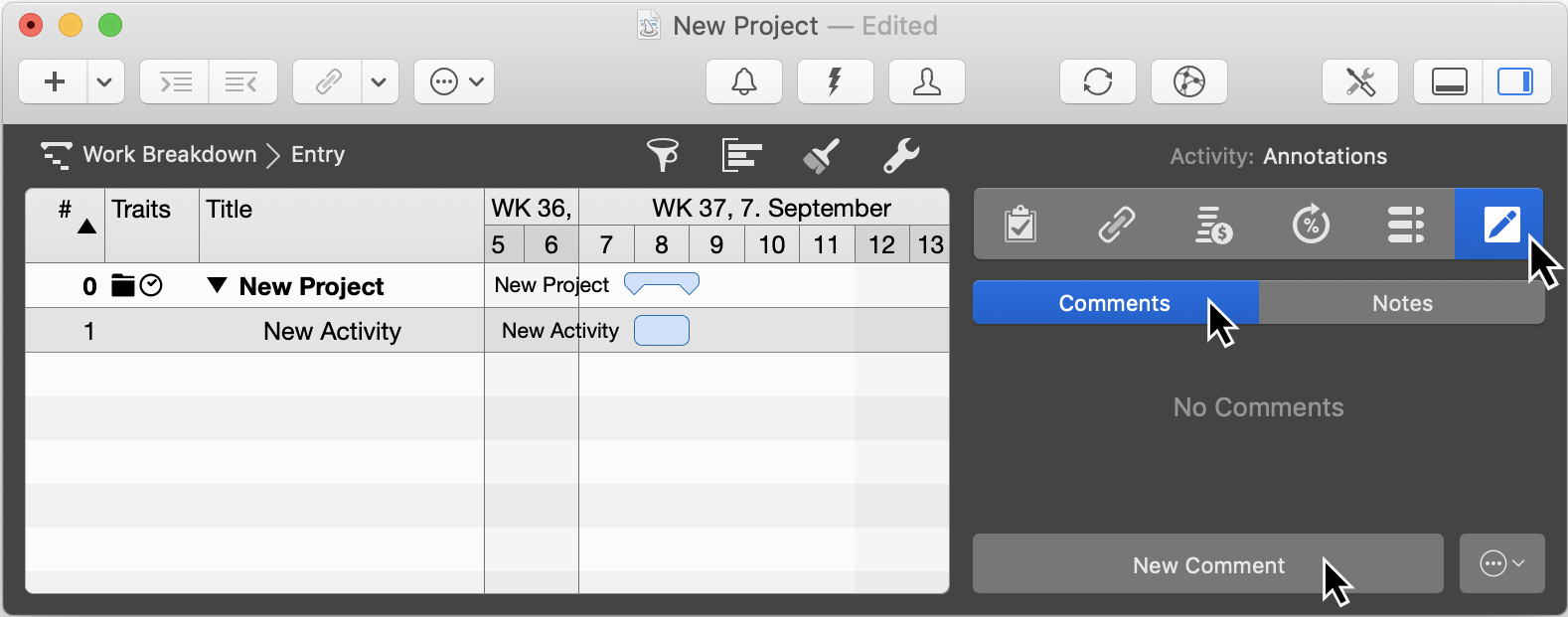
-
Enter the desired text.

-
Press RETURN to confirm new comment
Inserted comments show following information:
Creation date
Creation date shown as relative time point (today, yesterday, etc) and contains the date and time of any given comment.
Author
Merlin Project calculates the author’s name into the comment.
There are various cases:
New comments on project files show Anonymous as author.
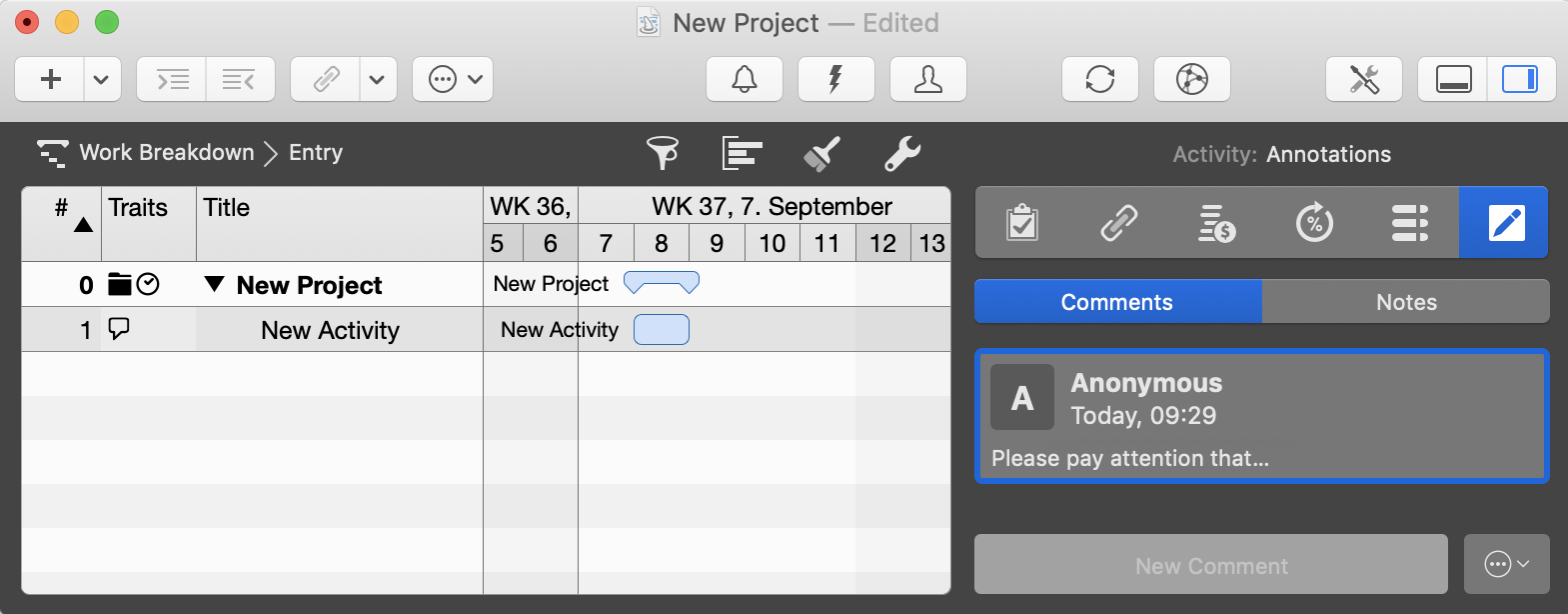
New comments on project files show Anonymous as author.
|
|
You can select a resource from the list to define the author of the comment. |
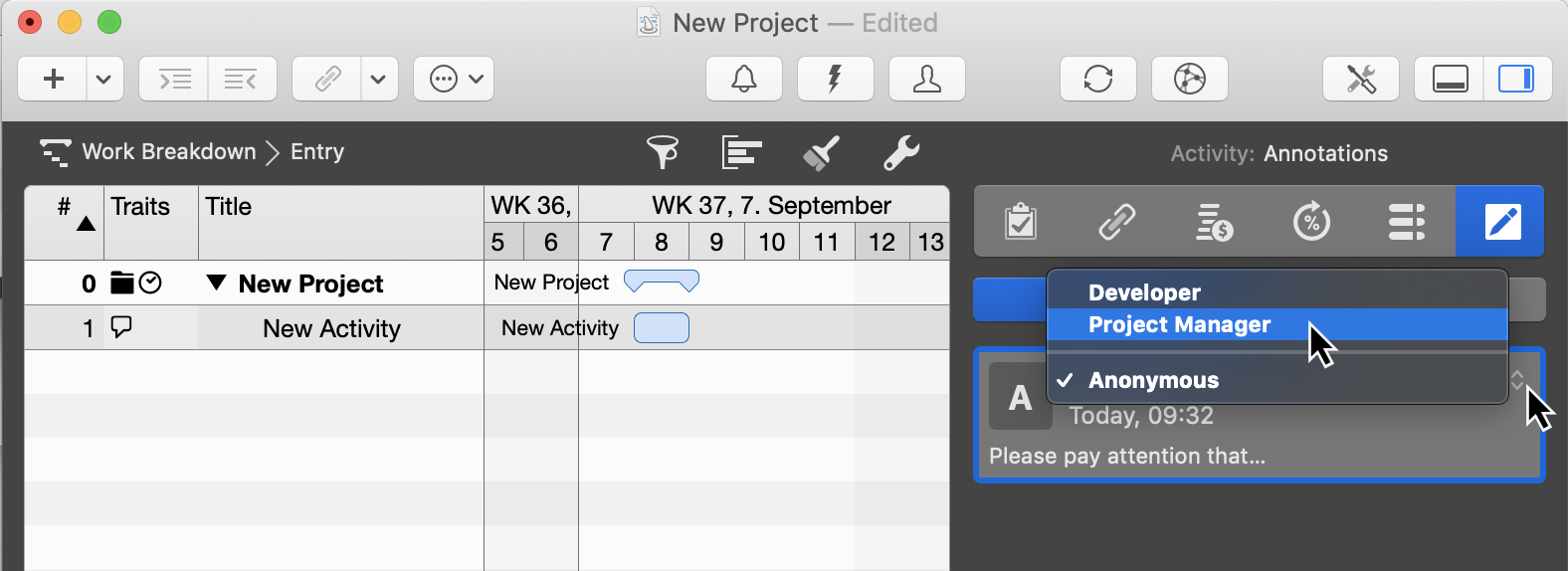
New comments on project files show the title of the user-resource which had inserted them.
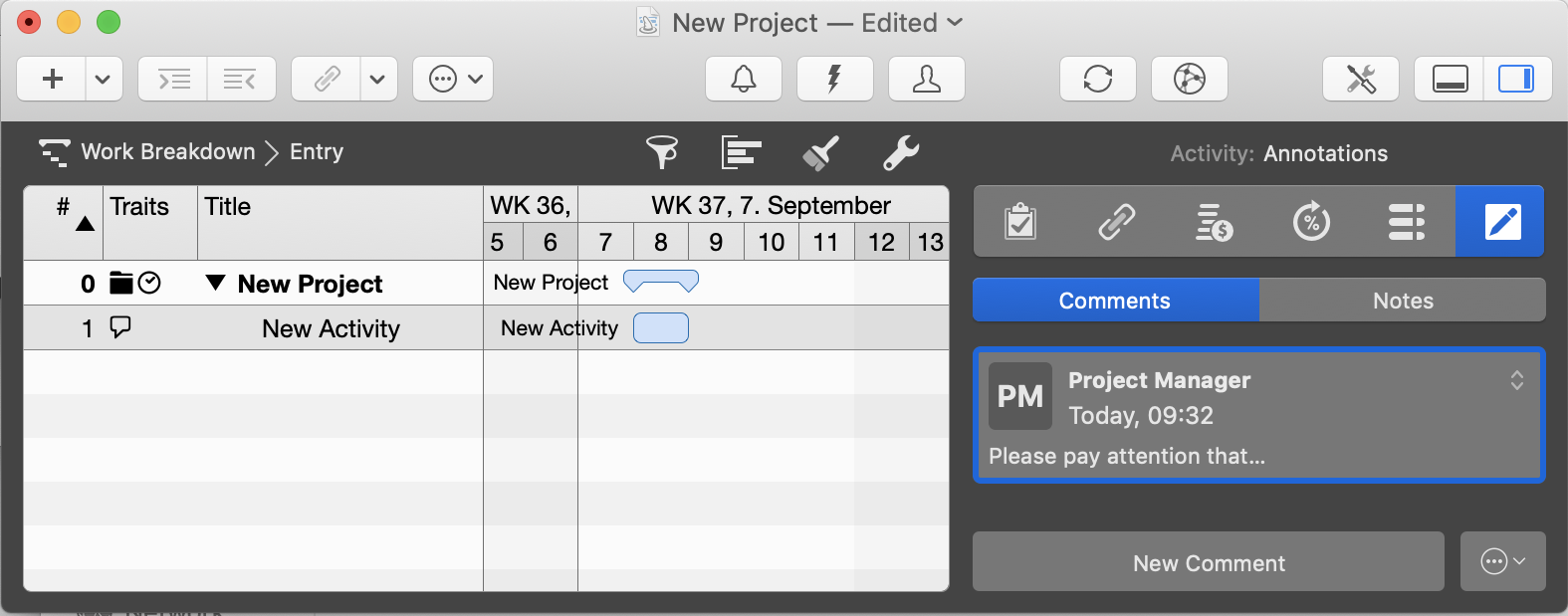
Author initials or image
There are various cases:
New comments show the initials of the resource.

New comments show a thumbnail of the author’s image.
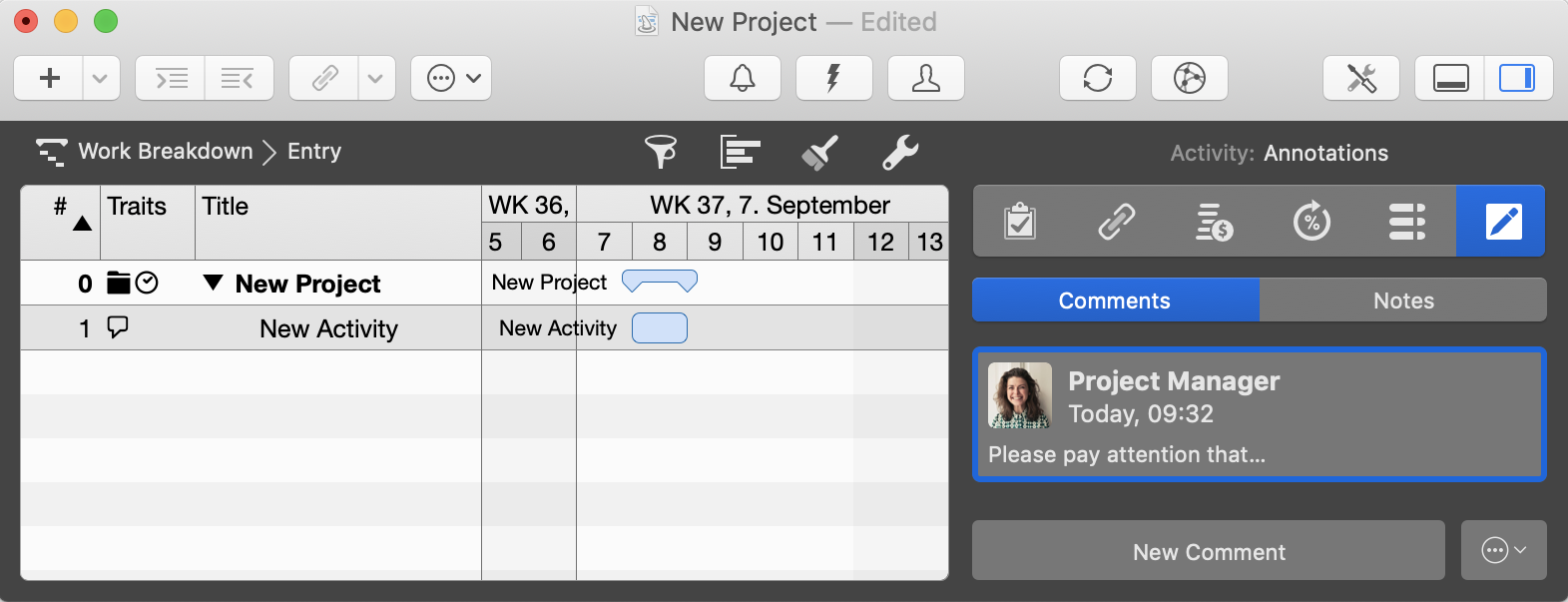
View comments
When opening a project having comments, there are various ways to view inserted comments.
-
Select a row in its view
-
Open the Annotations inspector
-
Switch to the Comments tab
If the traits column is visible in the outline, and there is a comment inserted on items of this view, just click the comment icon on any given row for Merlin Project to show all comments in the Annotations inspector for that specific row item.
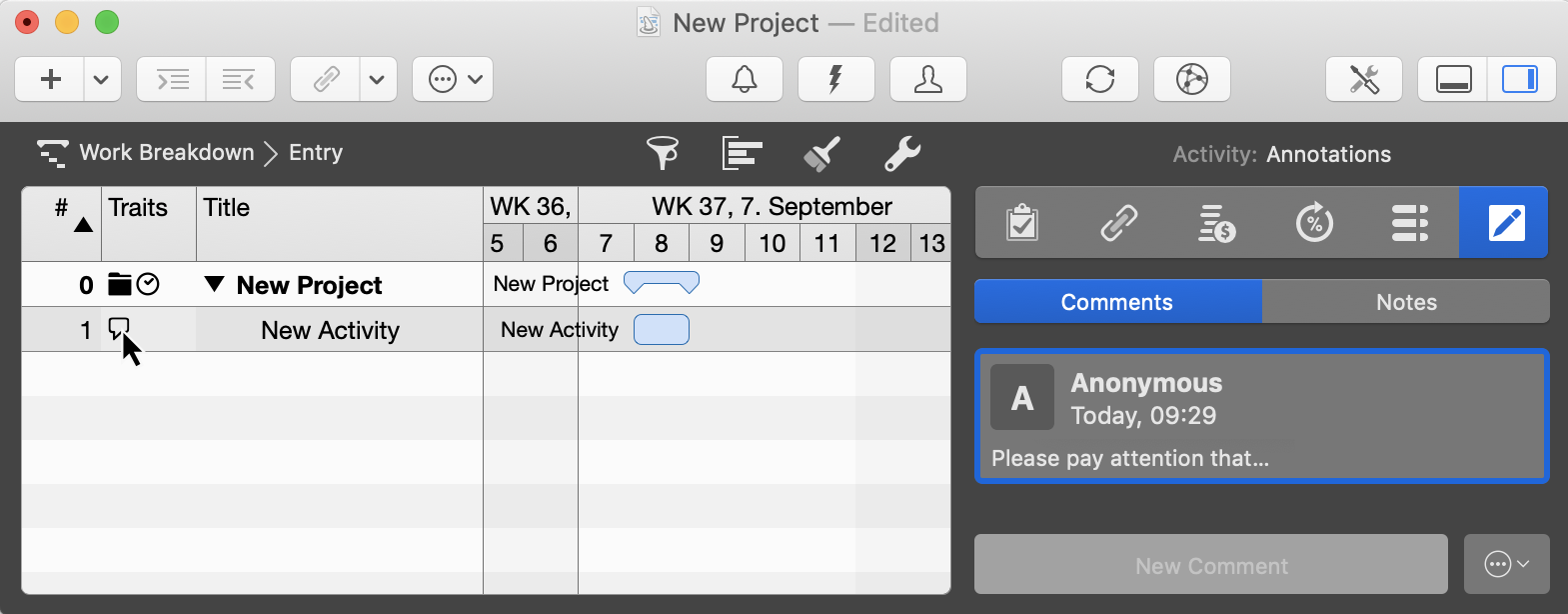
New comments are listed in the Notifications window.
-
Click the Notifications toolbar icon to open this window.

-
Switch to the Comments tab
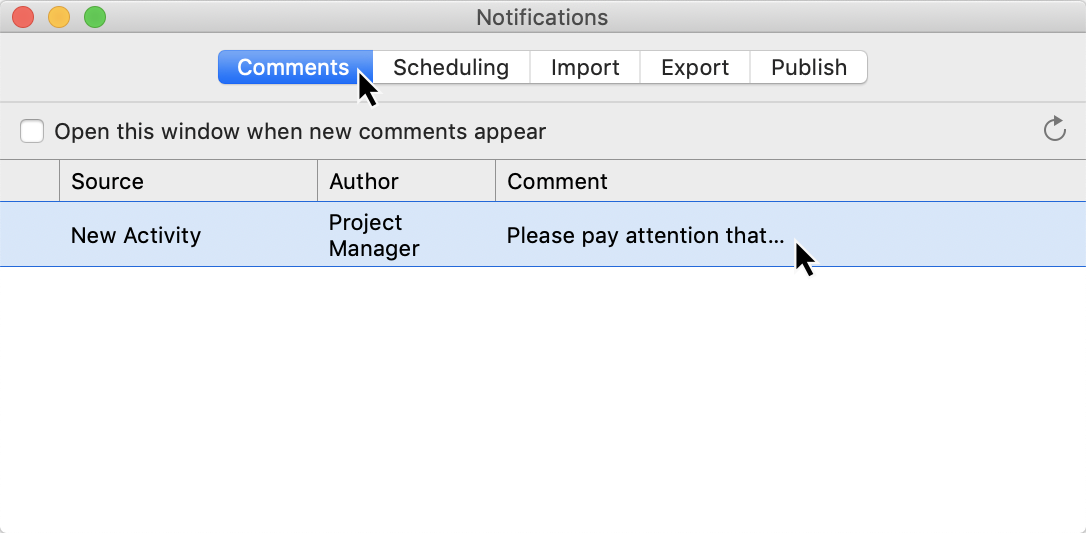
This view will list all comments inserted on all items. Double click any given row, for Merlin Project to switch focus to the given comment in the Annotations inspector, where you can reply by a new comment.
You may choose to remove read comments from the list. Just click the 'Remote read' button.

Edit
When wanting to edit comments, there are various use cases:
Anyone opening the file may edit any given comment.
-
Just select a comment rect in the inspector
-
Double click the text to enter edit mode
-
Edit the text
-
Select a comment rect in the inspector showing your user-resource
-
Double click the text to enter edit mode
-
Edit the text
|
|
You cannot edit comments entered anonymously or those of other user-resources. |
Alternatively
You can also select the Edit menu item from the (…) menu shown at the bottom of the Annotations inspector.
Delete
To delete any given comment:
-
Select its comment rect in the inspector showing your user-resource
-
Select Delete from the (…) menu shown at the bottom of the Annotations inspector.
Sorting order
Comments can be sorted in the following ways:
-
Newest Comments first
-
Oldest Comments first
Default order is Newest Comments first
To change the sorting order:
-
Open the Annotations inspector
-
Switch to the Comments tab
-
Select Newest Comments first or Oldest Comments first from the (…) menu shown at the bottom of the Annotations inspector.
Filters
What are Filter?
The Filter function allows information in the project to be made visible according to different presets. Other information is hidden. Several evaluation options are created by filtering the project contents.
|
|
Filters help you select certain information for large projects and to display them graphically in the different views. |
Click the funnel icon and the built-in filters will be displayed in the Inspector.

Tick the checkbox to the left of an entry in the Inspector to activate the filter. The relevant project content is then displayed automatically by the activated filter.
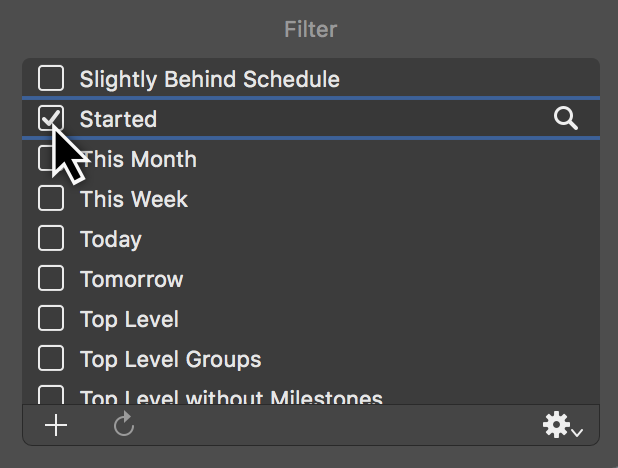
|
|
An active filter will keep on being displayed next to the funnel together with its name and remain active until you click the funnel again and remove the checkmark the active filter in the Inspector. |
Adjusting filters
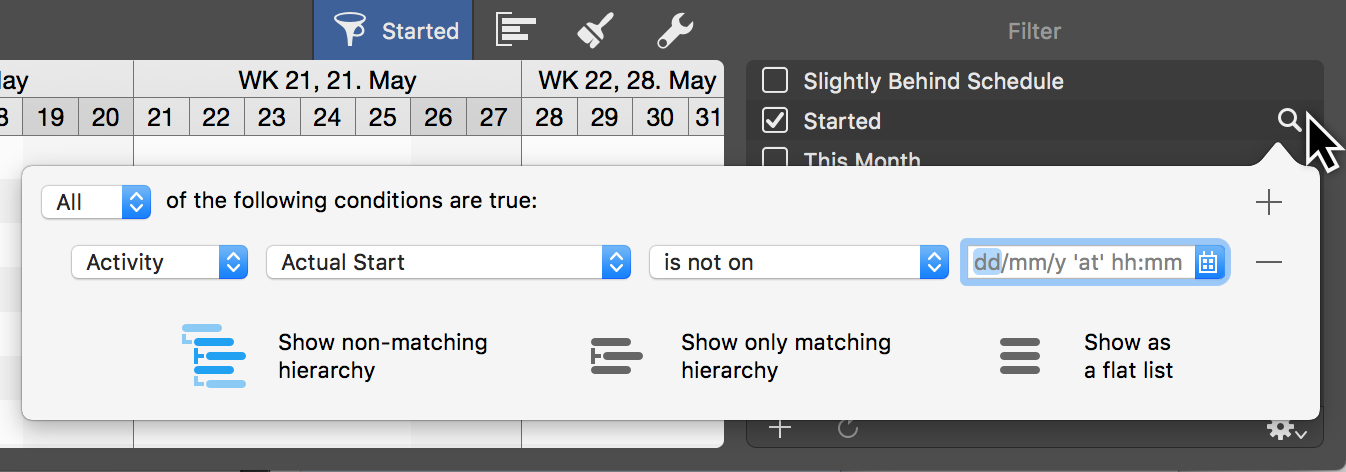
Click the magnifying glass to the right of an entry and a dialog will open in which you can see and modify the conditions for the active filter.
The drop-down menus contain information and values which allow you to configure the conditions for filtering your project.
Manage how the filtered results are displayed using these three options:
-
Show non-matching hierarchy
-
Show only matching hierarchy
-
Show as a flat list
Add new conditions for a filter by clicking the plus icon. Click the minus icon to remove existing conditions from the filter.
Creating Custom Filters
Create and add custom filters to the list of built-in filters. To do this, click the plus icon in the filter list.

The category Custom will be created. This allows you to differentiate custom (own) and supplied (built-in) filters from each other.
Give custom filters a unique name for easier identification later on.

Click the magnifying glass and create the conditions for the filter.
Use the options to adjust the filter in the drop-down menus. You can add further conditions by clicking the plus icon, or remove the existing conditions by clicking the minus icon.
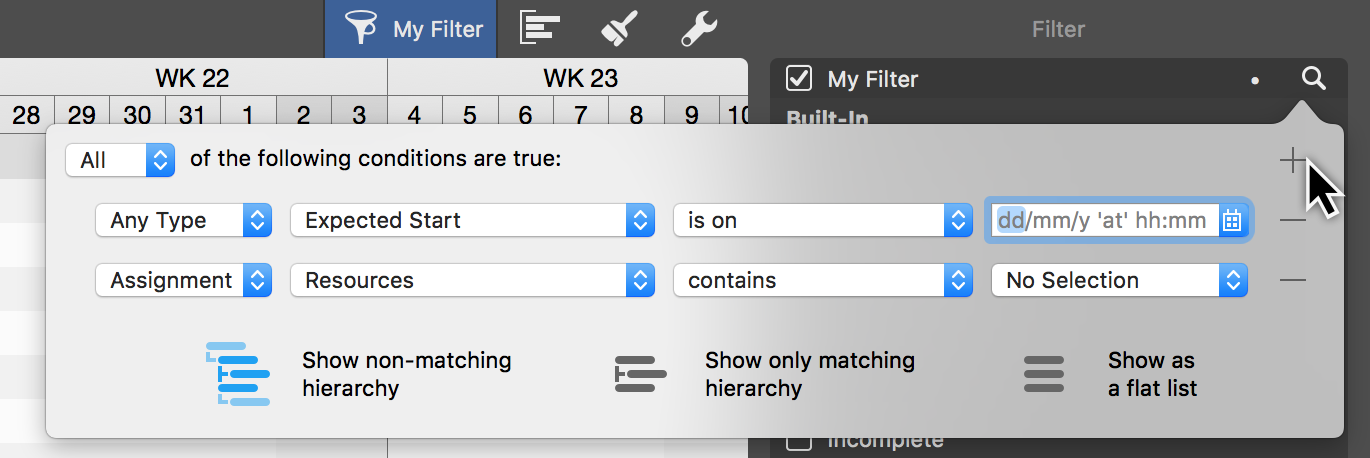
With the All drop-down menu you can filter the conditions to All or also to Any or None of the set values.
The graphical display of the filter is controlled with the three View Options for hierarchy and flat list.
|
|
You can delete custom filters from the list by clicking the filter and then pressing the delete key. |
Further filter options
The gear menu contains useful options for using the filters:
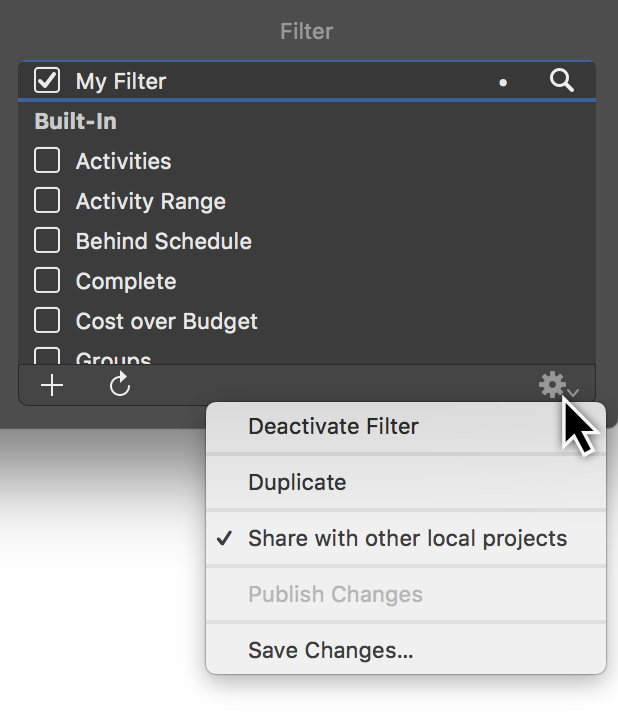
-
Deactivate Filter (disables the active filter)
-
Duplicate (makes a copy of an existing filter)
-
Duplicate (creates a copy of a filter)
-
Share with other local projects (the filter is available in all projects on the local Mac)
-
Publish Changes (for shared filters, the changes are published for all local projects)
-
Save Changes (for shared filters, the changes are only saved in the current project and not published)
Duplicate filter
Use this option to modify an existing filter. A copy will then be made.
Duplication saves you from having to go through the conditions from the original filter and set them manually.
All conditions are transferred during duplication and can be modified or added to.
The original filter remains unchanged.
Sharing filters locally
Use this option so you always have a filter available on your Mac for all local projects.
If changes are made in a locally shared filter, a white dot appears next to the filter.

Use the options under the gear menu to apply the changes:
-
Publish Changes
-
Save Changes
Resetting filters
You can reset changes in a shared filter.

To do so, click the rotated undo arrow. A dialog will then appear in which you can undo the changes.
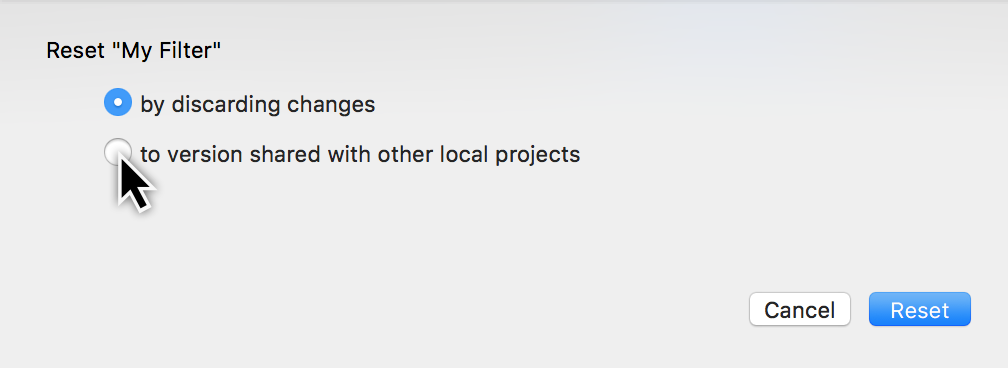
Reset the filter:
-
by discarding changes
-
to version shared with other local projects
Groupings
This guide contains information on creating and using groupings in Merlin Project.
What are groupings?
Groupings let you group project content by different requirements. This allows information to be sorted as required in the particular view.
Merlin Project comes with a range of pre-defined groupings. Plus, it’s quick and easy to create your own groupings.
|
|
The Kanban view groups by status field. For further information, see the Kanban guide. |
Advantages in project planning
Groupings are highlighted graphically and displayed with corresponding information in the current view.
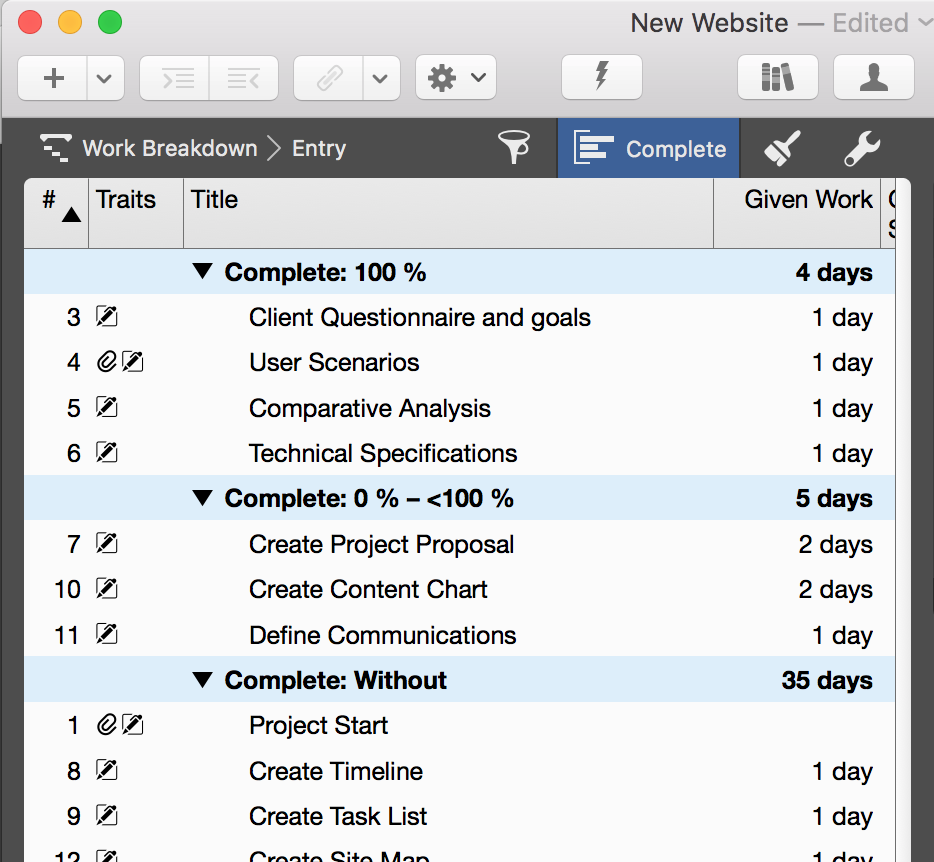
Among other things, this lets you make different levels of progress in the project visible quickly, classify activities rapidly, and evaluate and visualize information easily.
Using groupings
Click the Grouping icon and the Inspector will open with a list of built-in groupings.
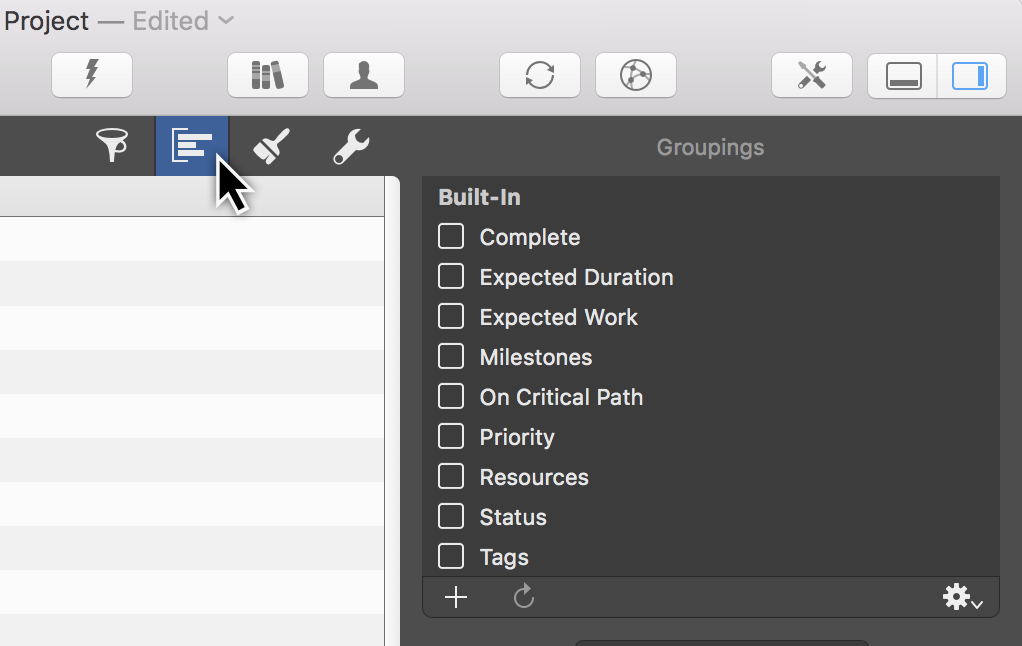
Mark the checkbox to the left of an entry to activate a grouping. The content in the current view will be sorted and displayed automatically based on the grouping.

|
|
An active grouping will be displayed next to the Groupings icon at the top with its name in blue and remains active until you unmark the checkbox in the list. |

Creating groupings
Create and add your own groupings to the list of built-in groupings. Click the plus icon on the left below the list.
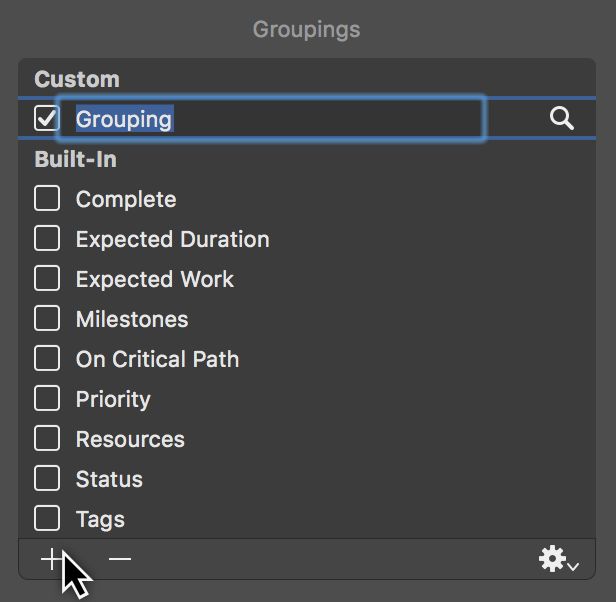
The category »Custom« will be created. This is to differentiate between the groupings you create yourself and those that are built-in. Give the grouping you created a distinctive name so it’s easy to tell what it is for future use.
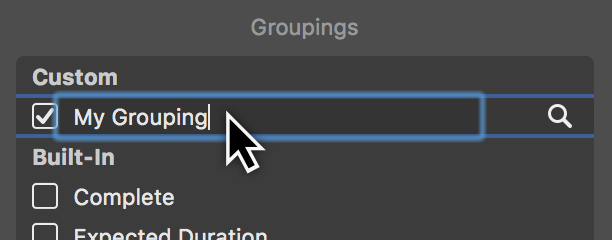
|
|
To remove your own groupings from the list, click a grouping and then press the delete key. |
Modifying groupings
Click the magnifying glass icon and use the grouping options.
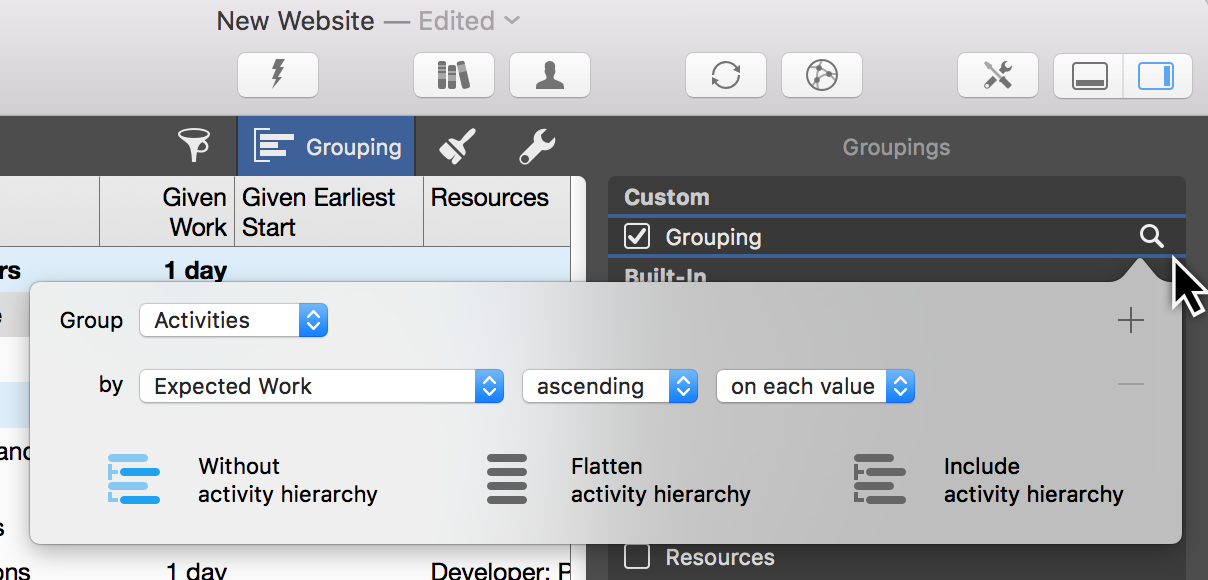
Use the »Group« drop-down menu to group. Depending on the active view, you can choose between the following grouping options in the drop-down menu:
-
Activities
-
Resources
-
Assignments
Set options according to which they are to be grouped. Use the drop-down menu to do this.
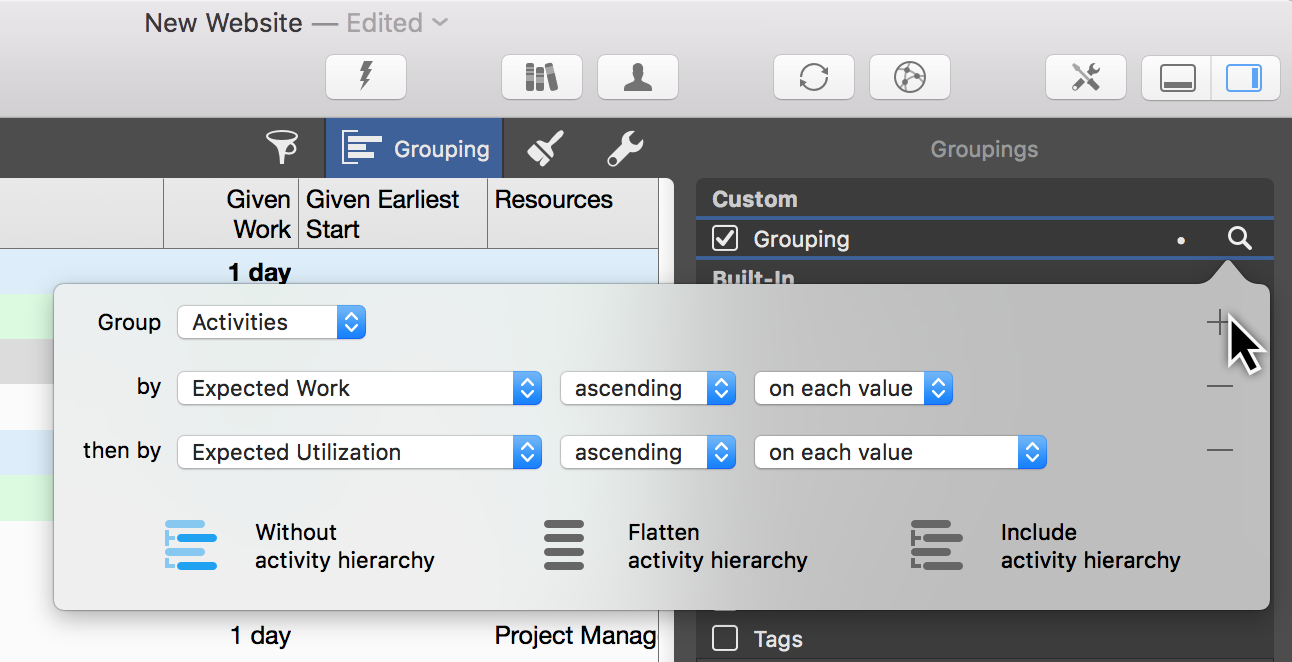
Click the plus icon to add further condition rows or remove options by clicking the minus icon.
The hierarchical display of the grouping can also be changed using the view options at the bottom.
-
Without activity hierarchy
-
Flatten activity hierarchy
-
Include activity hierarchy
Further grouping options
The gear icon includes additional grouping options.
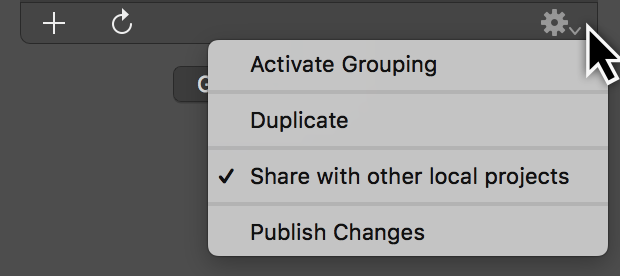
If you select a grouping in the list, you can choose from the following options under the gear menu:
-
Activate/Deactivate Grouping (mark/unmark the checkbox)
-
Duplicate (creates a copy of an existing grouping)
-
Share with other local projects (allows use in other local projects)
-
Publish Changes (publishes changes in a shared grouping to all local projects)
Duplicating groupings
This option can be handy to use an existing grouping as a template for a further grouping. A copy of the grouping is created.
Select a grouping and click the gear icon followed by Duplicate.
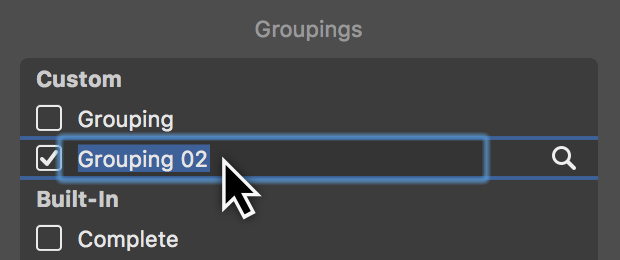
A copy of the grouping will be created and assigned a number. Name the grouping.
Following that, click the magnifying glass icon to modify and expand the grouping options.
Sharing groupings locally
The Share with other local projects option lets you share individual groupings with all other projects stored locally on your Mac.
The shared groupings are arranged in the list under the category Shared.
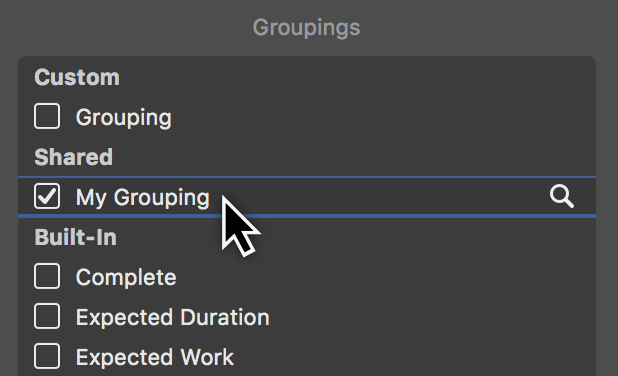
Publishing changes
If you want to publish changes in a shared grouping to local projects, click the gear icon and then the Publish Changes option.
Reverting changes
The arrow icon is handy to undo changes in shared groupings.

It undoes changes made in shared groupings.
If you click the icon, a dialog will appear with options to undo changes.
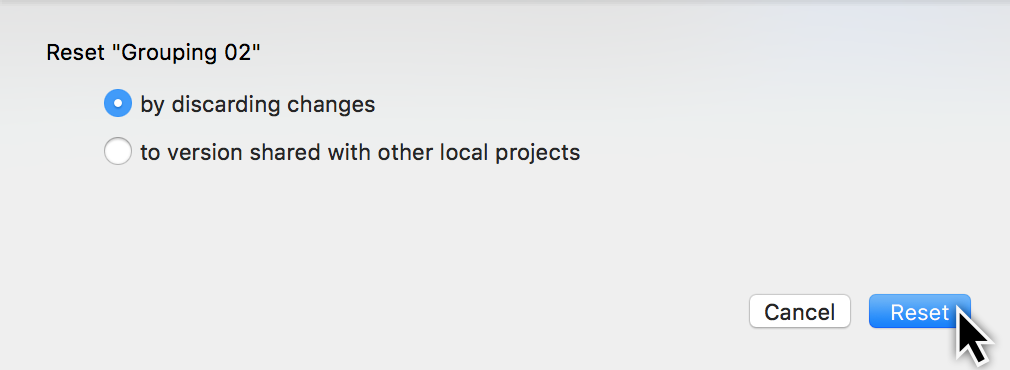
Select an undo option and then click the »Reset« button.
Stop sharing groupings
If you no longer want a grouping to be shared locally, click the desired grouping and then click the gear icon.
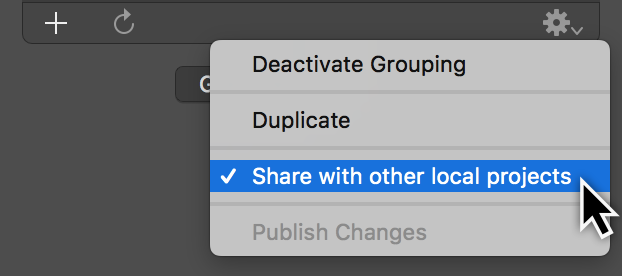
In the list, click Share with other local projects. A marked checkbox in front of the option indicates that the grouping is already being shared.
Manual ranking
If you sort manually in different views and activate a grouping, this produces a manual ranking.
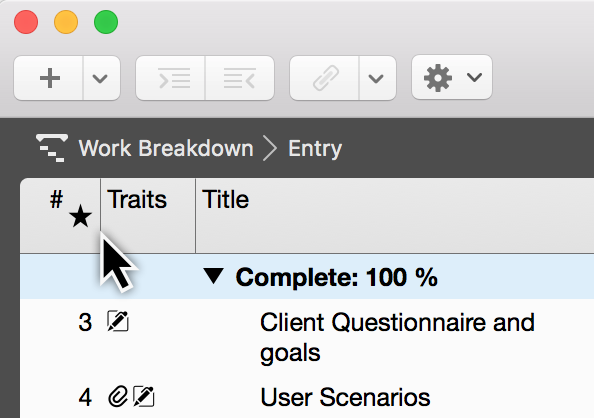
This option is indicated by a star icon in the # column.
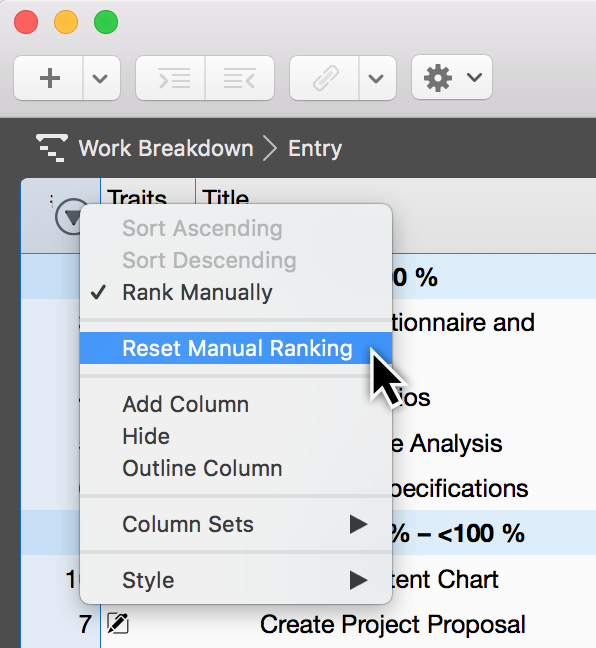
Click the column followed by Reset Manual Ranking to deactivate the option.
Styles and contents
This guide contains information on using and modifying styles and contents in Merlin Project.
What are styles?
Styles let you change how elements (bars, groups, milestones, columns, timescales, etc.) are displayed in the views to suit your preferences. You can do this using the style options for view elements, such as to change the format of colors, borders, shadows, or fonts.
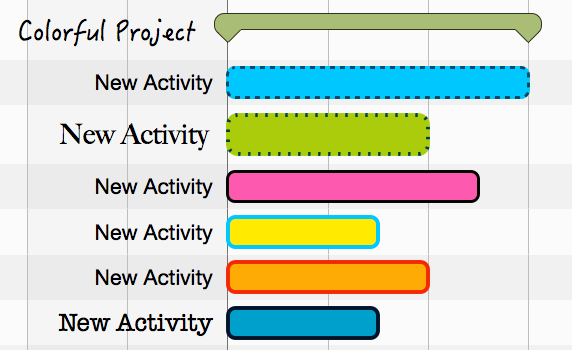
What are contents?
Contents let you store a range of project information in the view, for example in the labels (to the left and right of the bars and on the bars themselves) or in the Cards of the Net Plan or Kanban view.
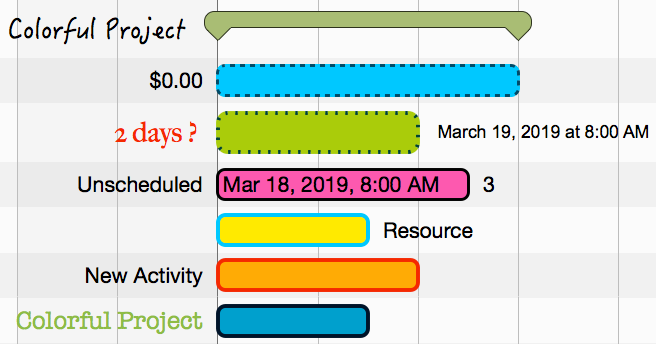
Style and Content Inspector
The Style and Content Inspector gives you control over styles and contents in a couple of mouse clicks.
You can access the Style and Content Inspector quickly by right-clicking an element in the active view and going to the associated context menu.
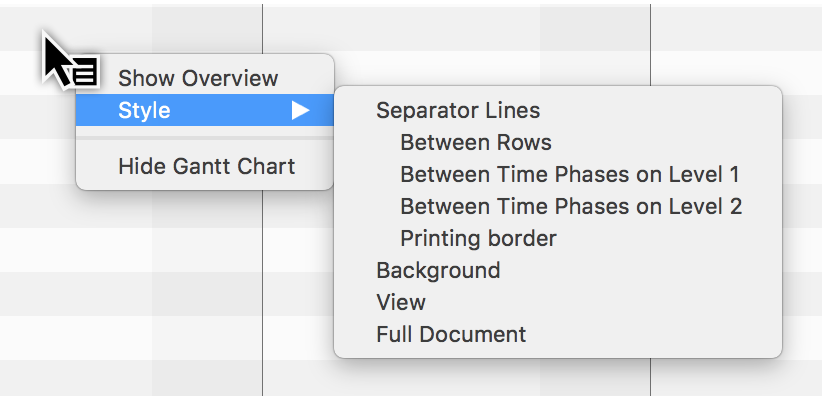
|
|
Depending on the element you right-clicked, either the Style option on its own or the Style and Content option will appear in the context menu. The selection options they include open the associated options in the Style and Content Inspector. |
There is also a new way to access the Style and Content Inspector by clicking the paintbrush icon.
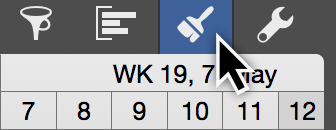
Elements are displayed graphically in the Style and Content Inspector.
Depending on the active view, you can see schematic displays for bars/groups or cards there.
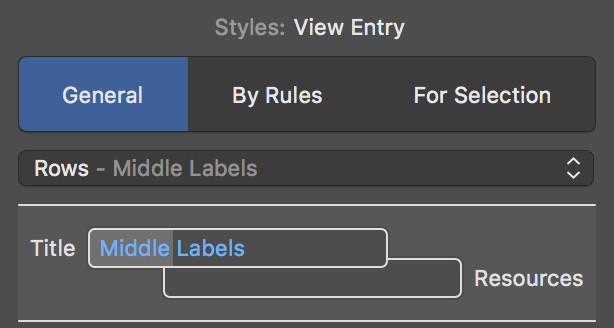

Using the Inspector
Click an element to access the style or content options. In the above drop-down menu, you can see the selection you made and the selected element will be highlighted in blue.
Style
In the following, the Bars (1), the entire Row (bar row type) (2) and the Reference Bars (3) are activated.
1

2
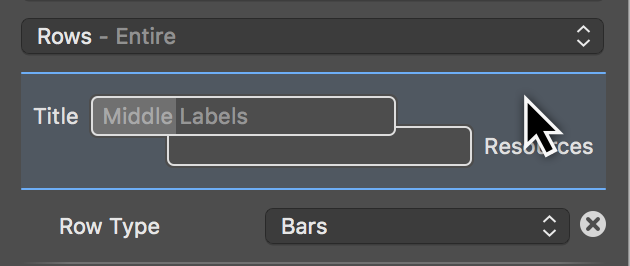
3

Content
Activate the left label by clicking Title and changing the content of the left label using the option in the drop-down menu with the same name. You’ll also find style options here for modifying the Color and Font of the content.
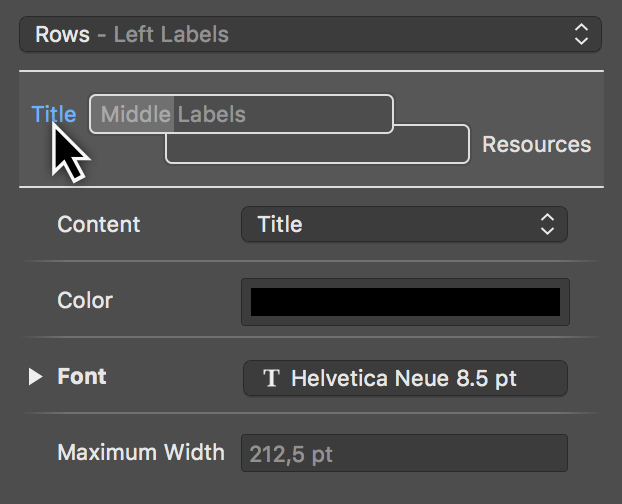
From the Content drop-down menu, select the Expected Start instead of the default Title selection. This will display the expected start of the activity as a date in the left-hand label.
General
The General tab controls the styles for the display of many general elements in the active view.
If no selection is active in the view and you click the magnifying glass icon, the Style Inspector will open with the General tab.
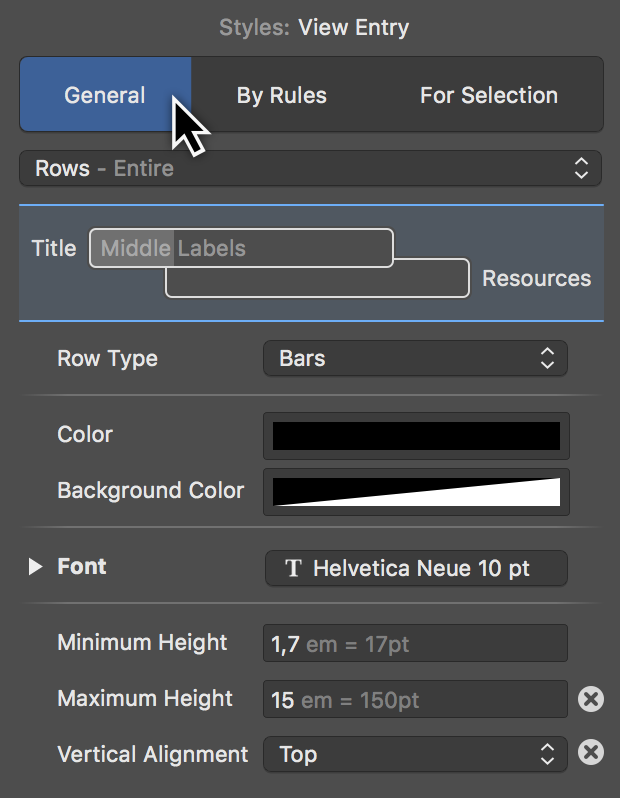
The general settings for Style and Content apply in principle to all style options across the project.
The elements for the particular view, which you can configure to suit using the options available in the Inspector, can be found in the drop-down menu.
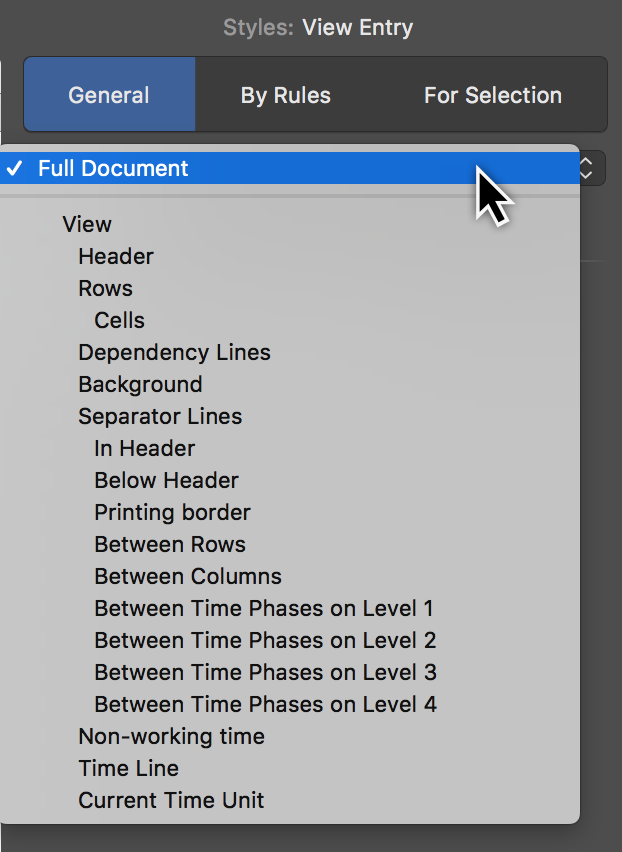
By Rules
The By Rules tab lets you control style and content options automatically depending on specific conditions.
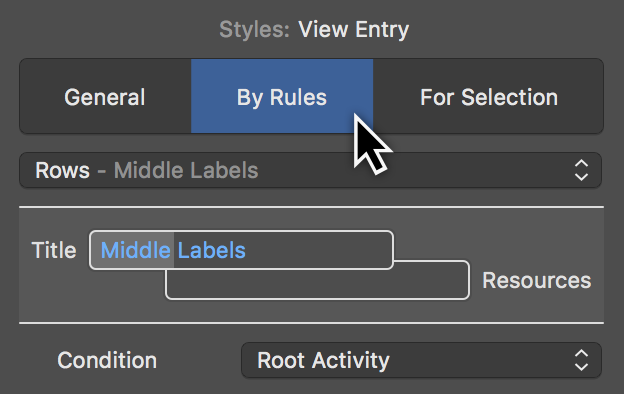
For example: You want all activities to which a specific resource has been assigned to appear in a specific color or alternate font automatically.
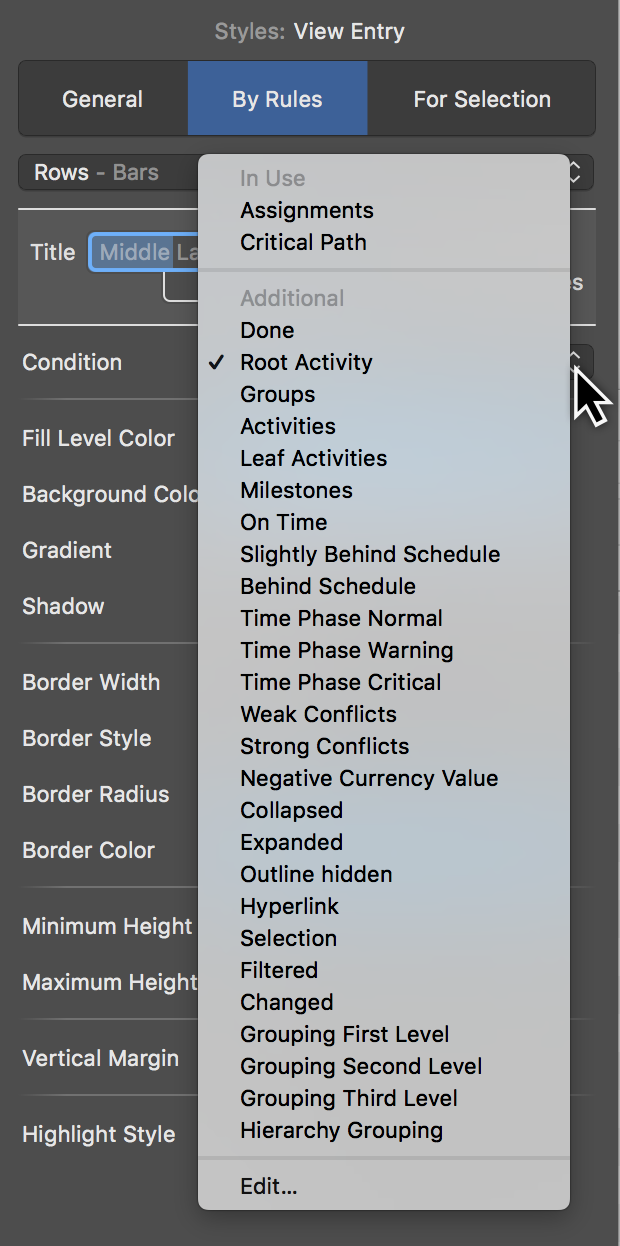
|
|
In "Merlin Project" you can define your own conditions. "Merlin Project Express" does not support this option. |
For Selection
The For Selection tab controls the styles and contents for the selection. This lets you adjust elements individually.
In a view, select an element and click the paintbrush icon. The Style Inspector will open with the Selection tab.
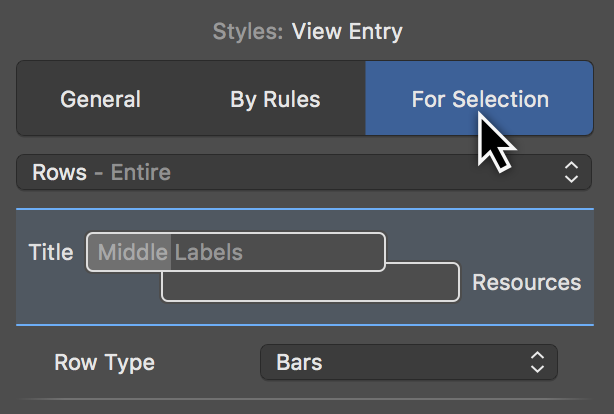
|
|
In principle, you can control styles and content by right-clicking and selecting the option Style or Style and Content from the context menu. |
Work Breakdown selection
Right-click a bar in the Work Breakdown view, a column row, or the Outline to access and edit the associated style and/or content options.
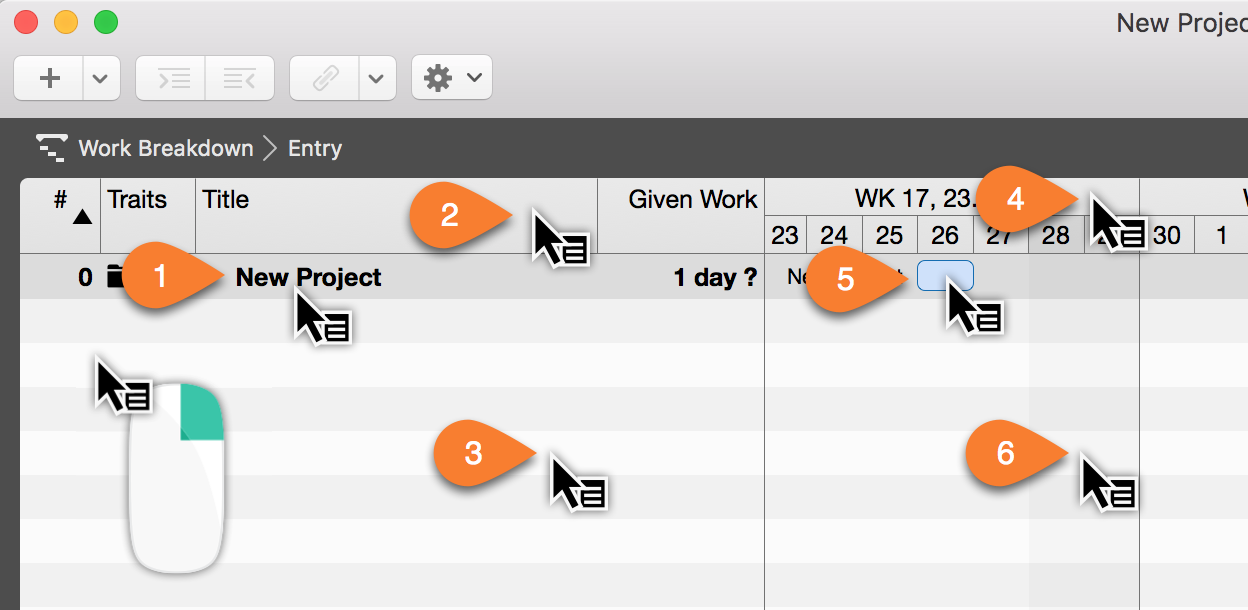
-
(1) Outline text style and content options
-
(2) Column row style options
-
(3) Outline style options
-
(4) Timescale style options
-
(5) Bar, milestone, and group style and content options
-
(6) Gantt chart style options
Style and content examples
Here is a small selection of practical examples.
Example 1: Modifying the color of non-working time
Right-click Non-working Time (6) in the Gantt chart and in the drop-down menu click the option Style > Non-working Time.
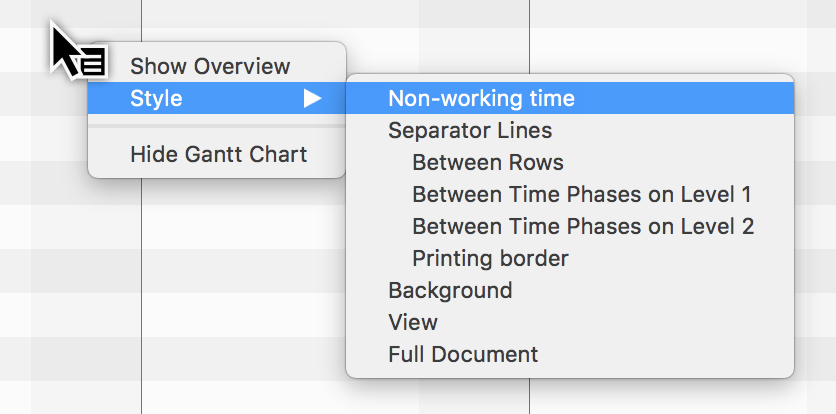
|
|
Alternatively, you can also click the paintbrush icon and then in the General tab select Non-working Time from the drop-down menu. |
The General tab will open in the Inspector with the style option for Non-working Time.
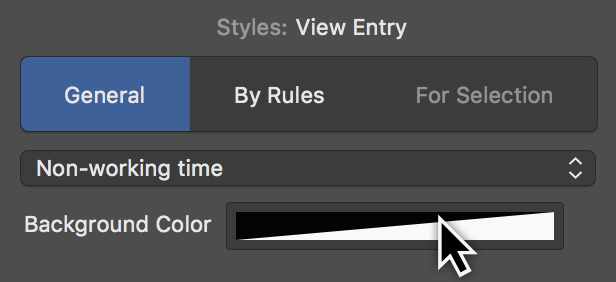
Click the Background Color color well to change the display color of the Non-working Time in the Gantt chart.
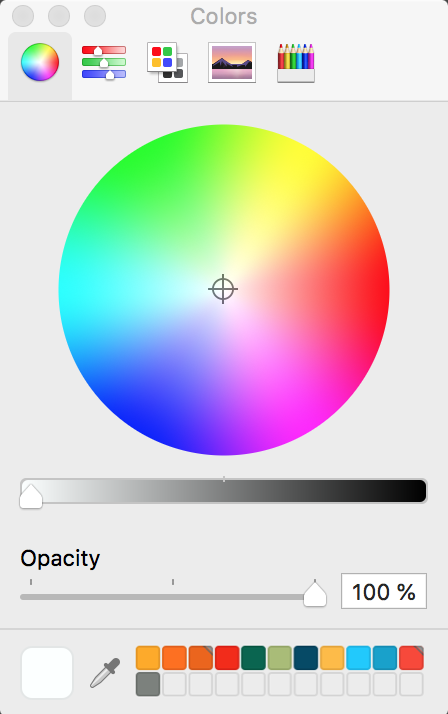
The macOS Colors window will then appear. This includes a range of options for setting colors and the opacity.
|
|
Learn more about macOS’s Colors window at Apple online. |
Changing the background color. Following that, Non-working Time will be displayed in the selected color in the Work Breakdown.
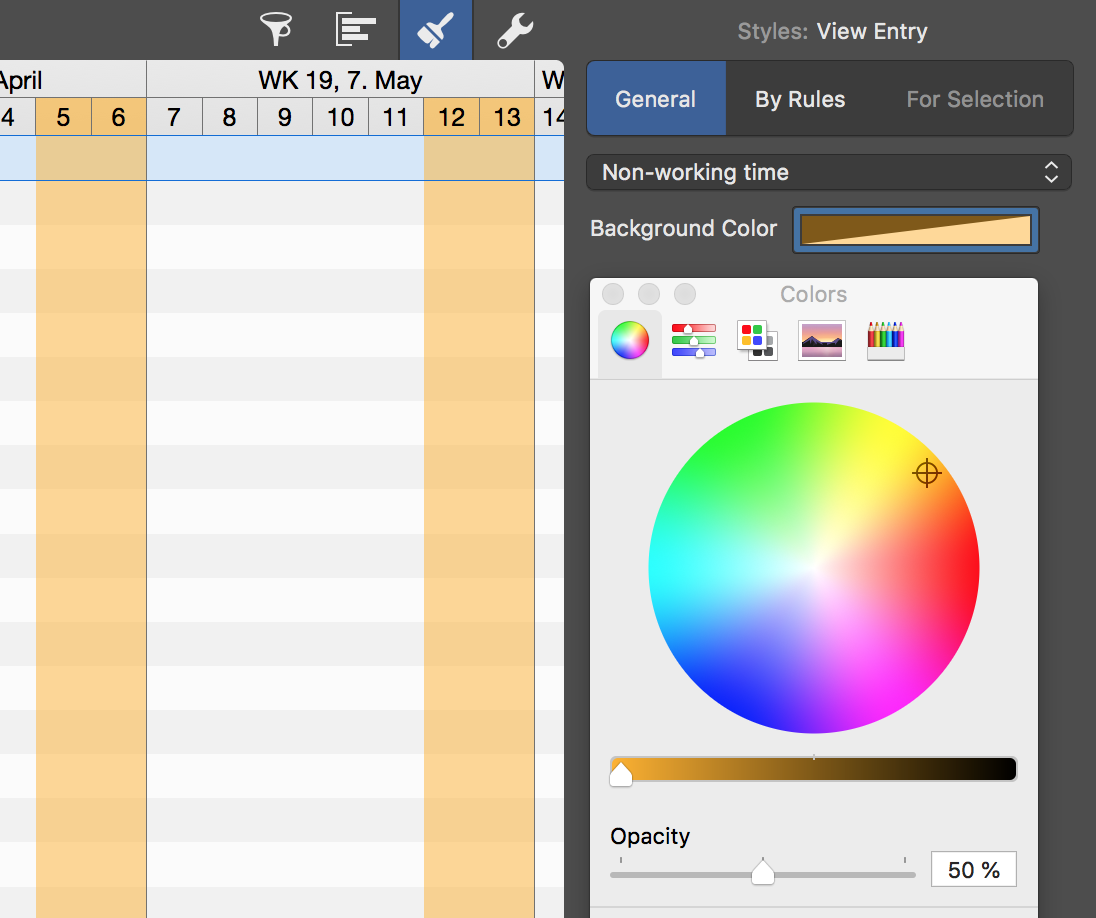
Example 2: Custom bar colors
Open a new or existing project in Merlin Project.
To change the color of a bar, milestone or group, first right-click a bar, group or milestone.
From the context menu, select the option Style and Content > Bars.
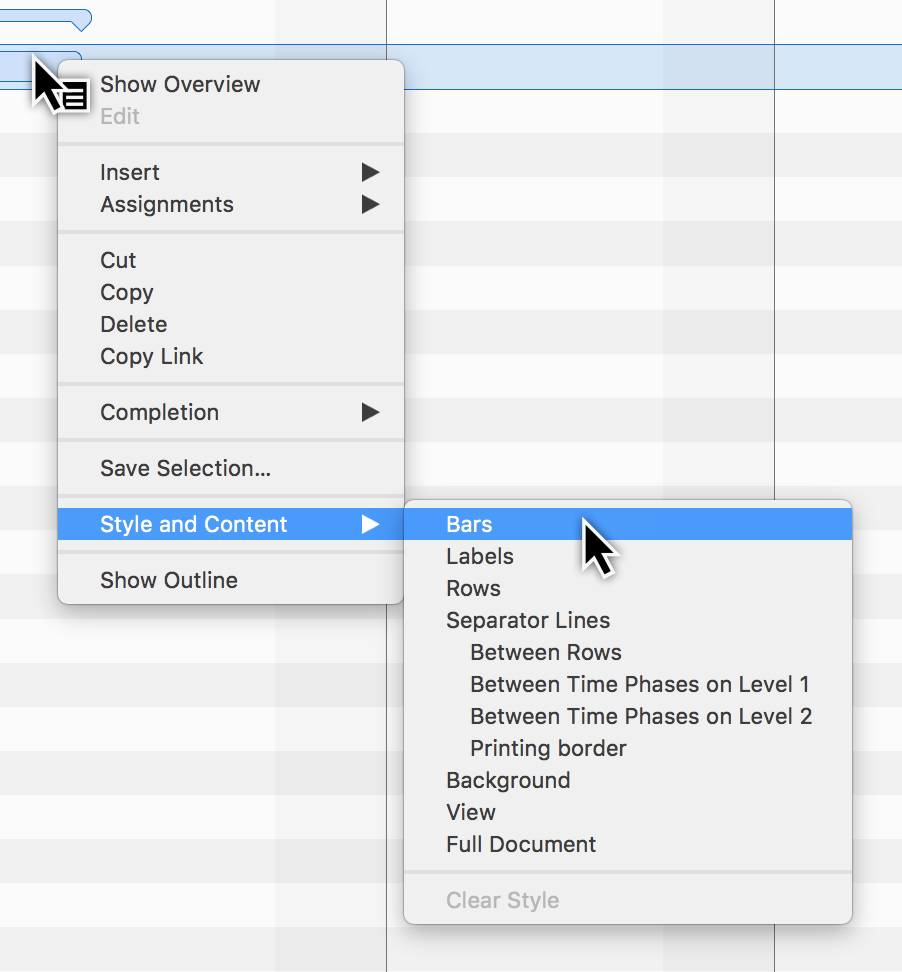
The For Selection tab will open in the Inspector. There you will find options to modify the styles for the selected bars.
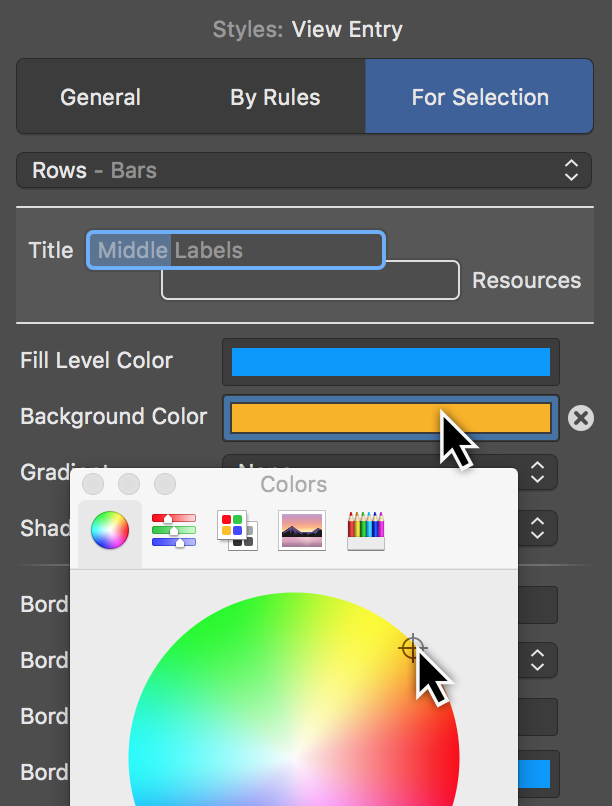
Click Background Color. In the Color window, choose the desired color. This will be adopted immediately for the selected bars. Repeat the process for the Fill Level Color.
|
|
The fill level color is displayed only once the activity has progressed in the rows. |
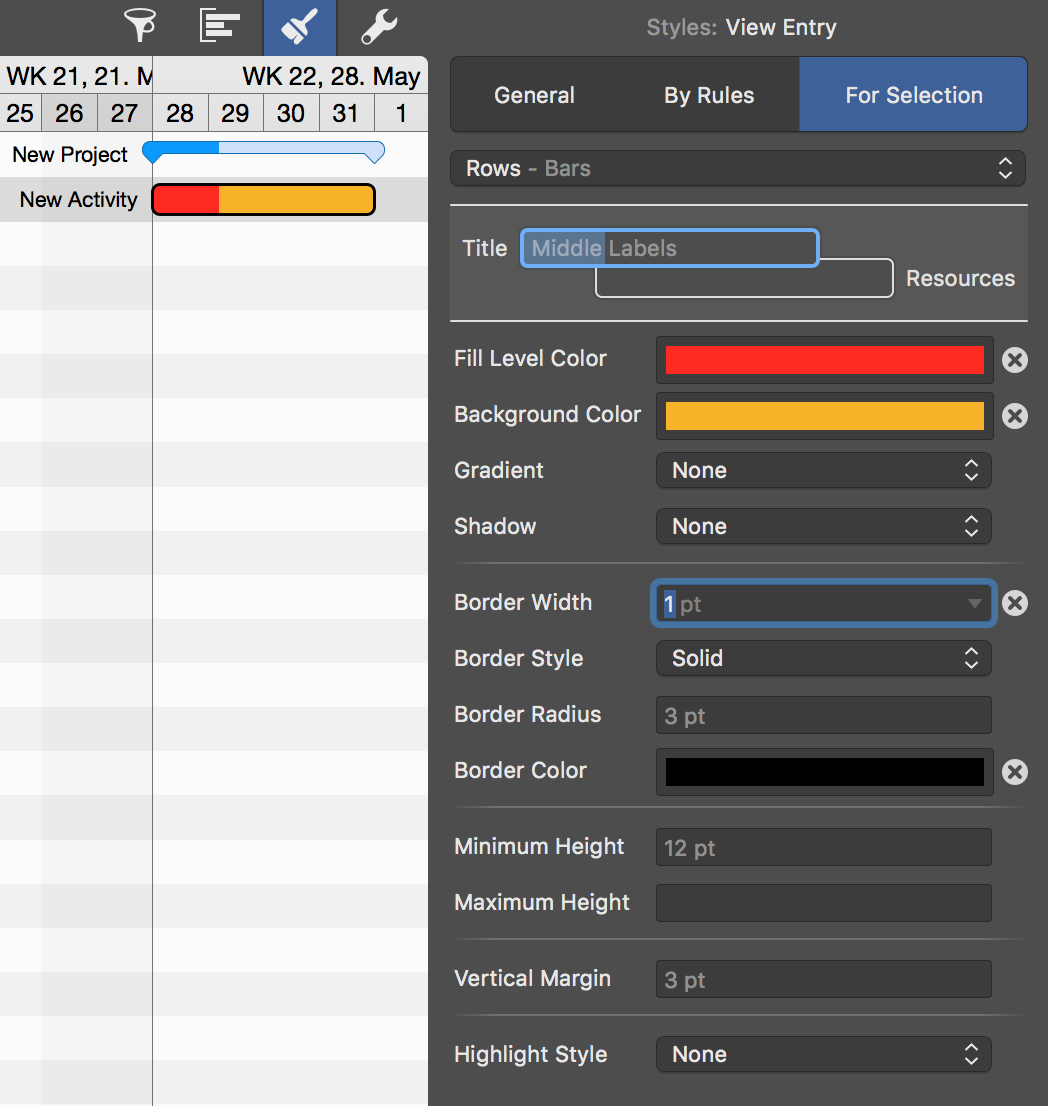
If required, make further changes to options in the Inspector to modify the style of the selected bars.
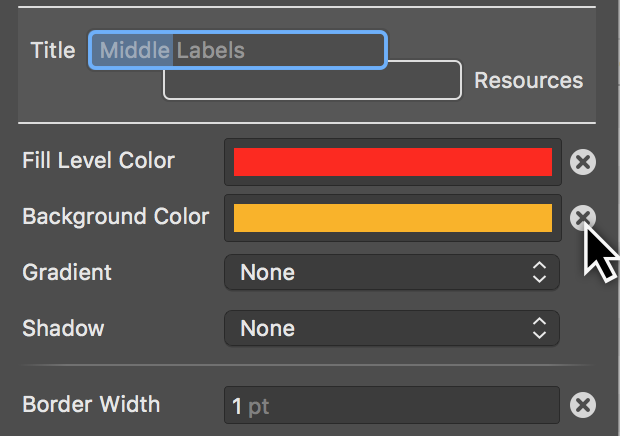
Click the cross icon if you want to undo the value of an option. In doing so, the value of the parent level or condition for the option will be used instead.
|
|
The above steps also work with multiple selections. You can select several bars using the Caps Lock key or cmd key and use the Inspector. |
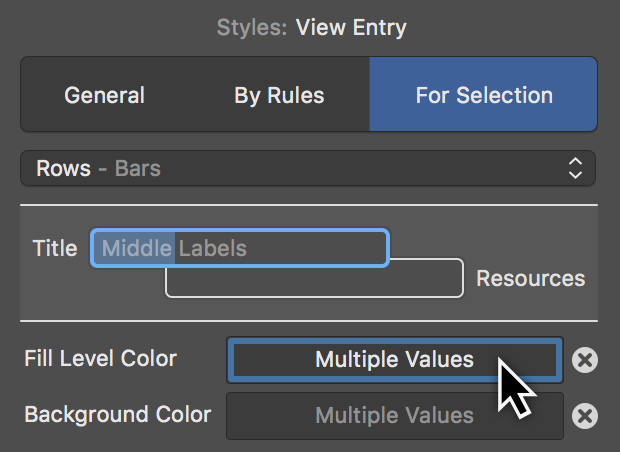
When making a multiple selection, if the bars have different values then Multiple Values will appear in the Info field. Click the field and adjust the color so that all selected bars are assigned the new color. This overwrites the old values.
Otherwise, click the cross icon to revert from multiple values to the default values.
Example 3: Activate labels in Gantt bars
Click the brush icon. In the Inspector, select the appropriate tab.

Select the General tab so that the change applies to all content in the view.
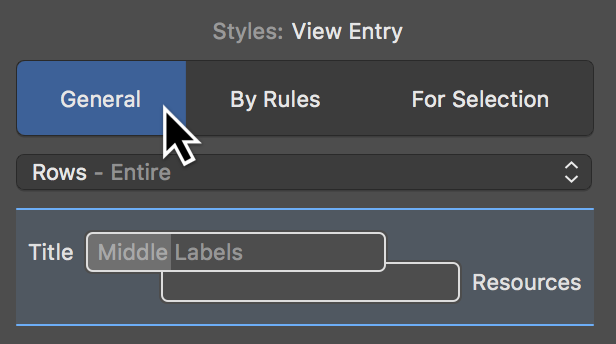
Click the desired label in the preview.
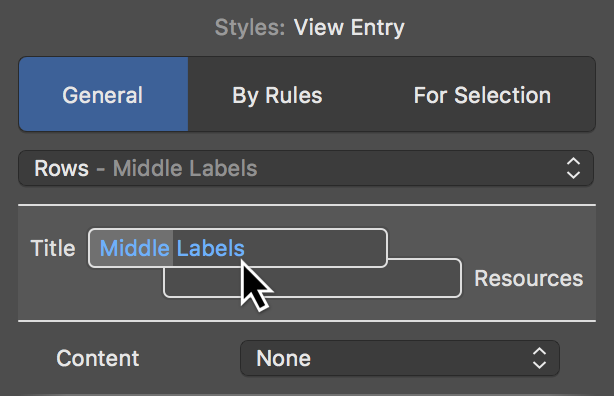
There are three labels to choose from:
-
Left Labels (title)
-
Middle Labels (middle labels)
-
Right Labels (resources)
Click the Content drop-down menu and select the desired content for the active label.
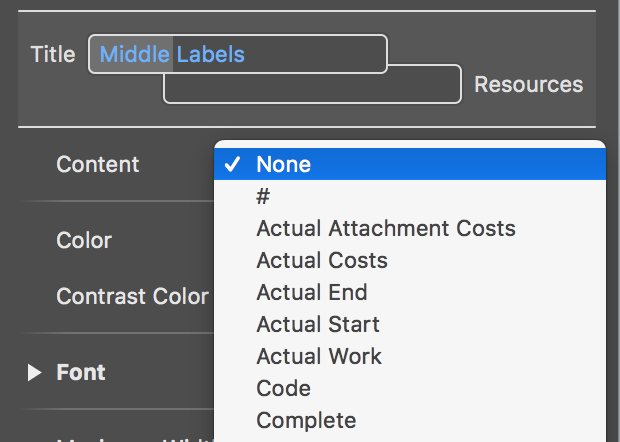
The Content drop-down menu contains all the information that can be used in labels.
Style properties
Outline style properties
All elements in the Outline include various options to change styles. These are summarized graphically in the following image.
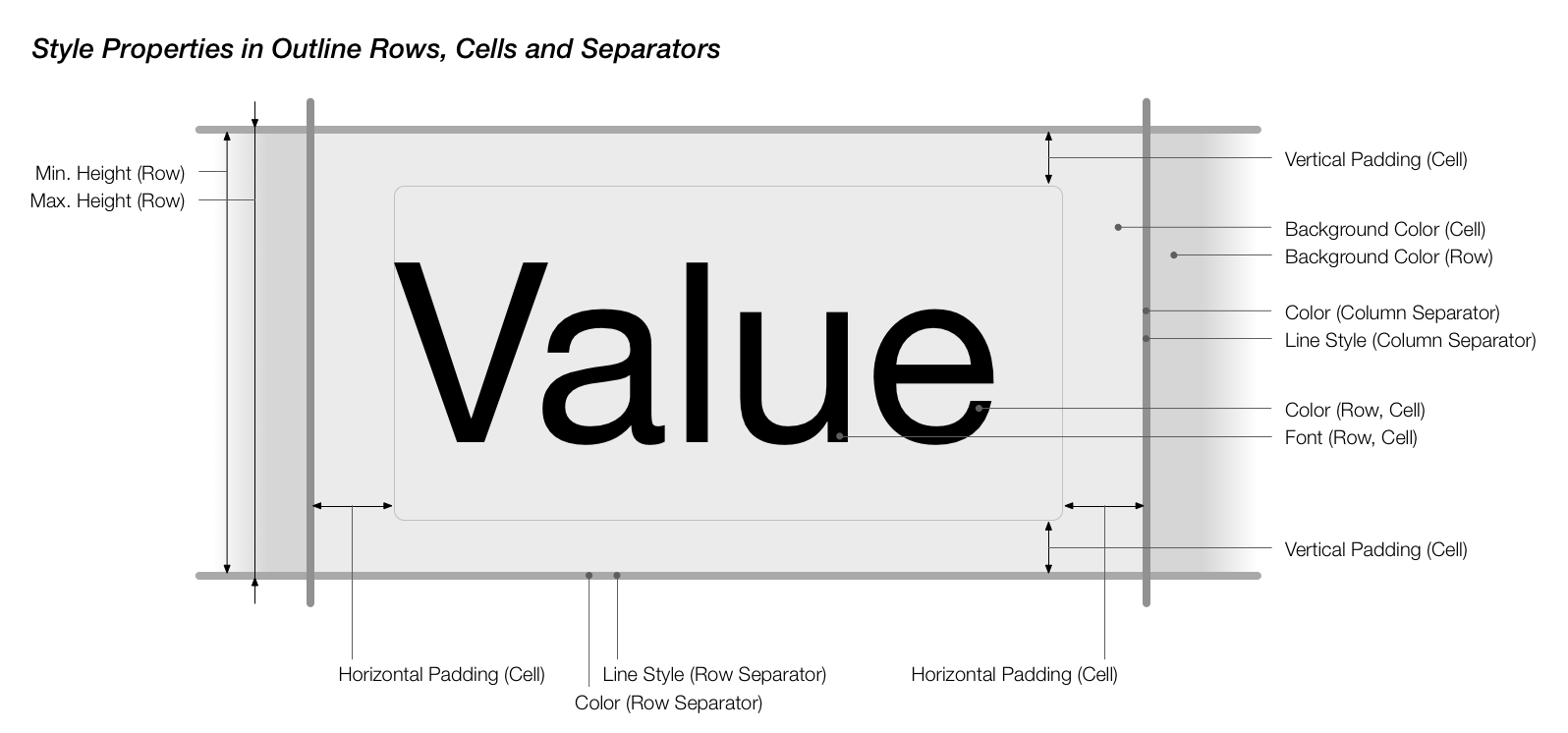
|
|
Right-click a title in the Outline. From the context menu, click the style options for Rows, Cells, and Separator Lines in the Outline. |
Outline column style properties
Outline columns include various options to change column styles. These are summarized graphically in the following image.
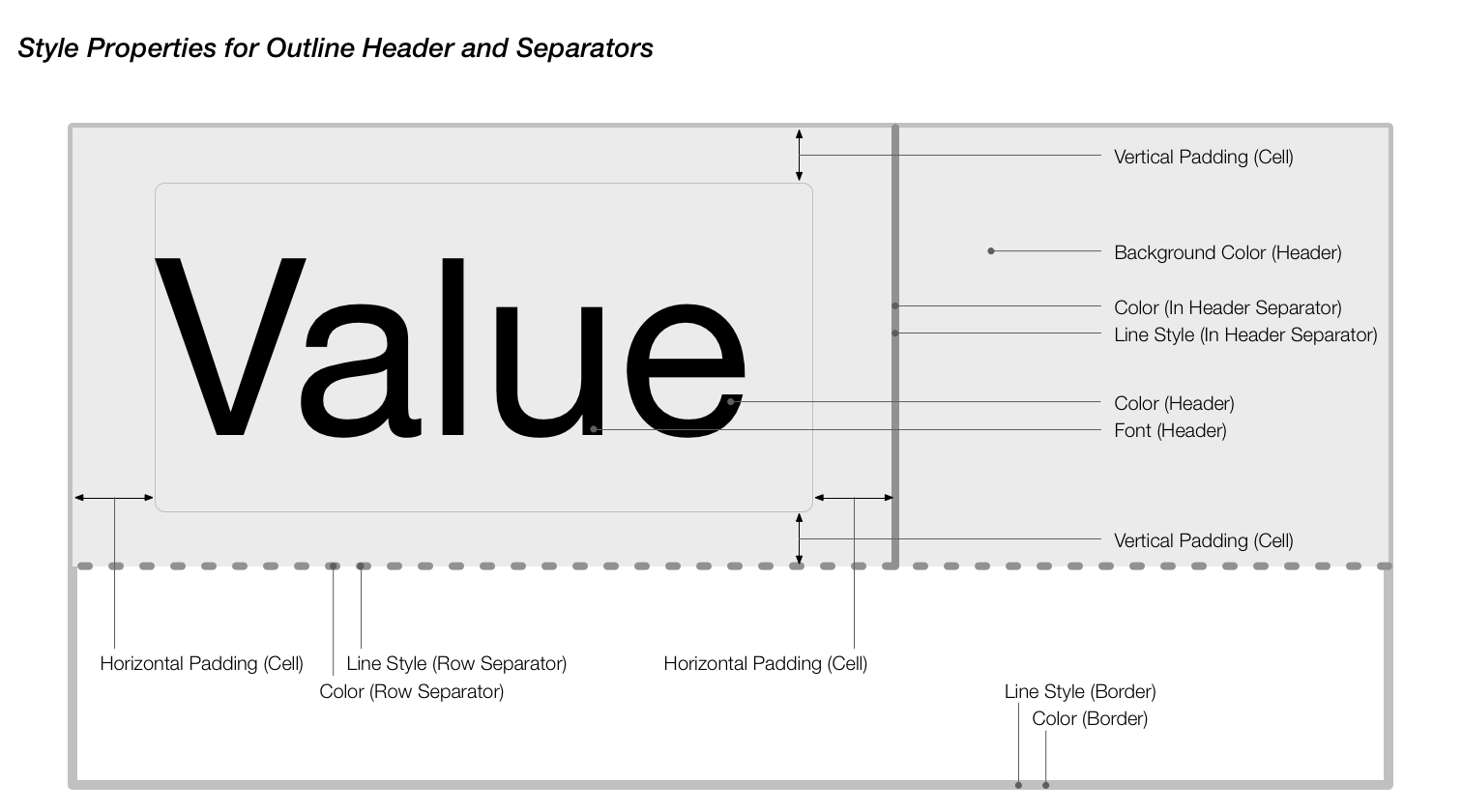
|
|
Right-click a column title above the Outline. From the context menu, click the style options for Rows, Cells, and Separator Lines in the Outline. |
Gantt chart bar style properties
Gantt chart bars include various options to change the bar styles. These are summarized graphically in the following image.
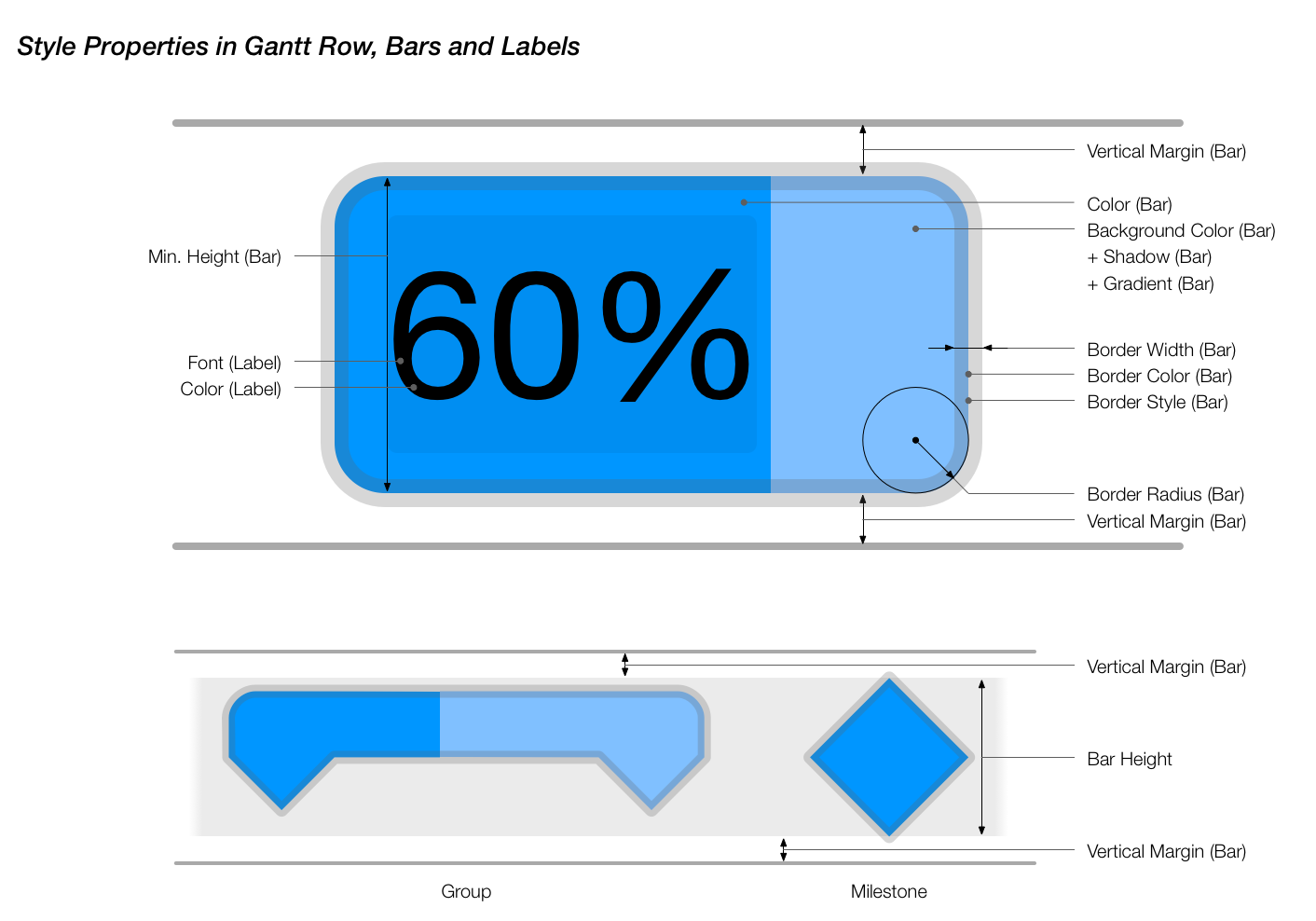
|
|
Right-click a bar, milestone or group. From the context menu click the style options for Bars in the Gantt chart. |
Net Plan box and histogram style properties
Net Plan boxes and histograms include various options to change the bar styles. These are summarized graphically in the following image.
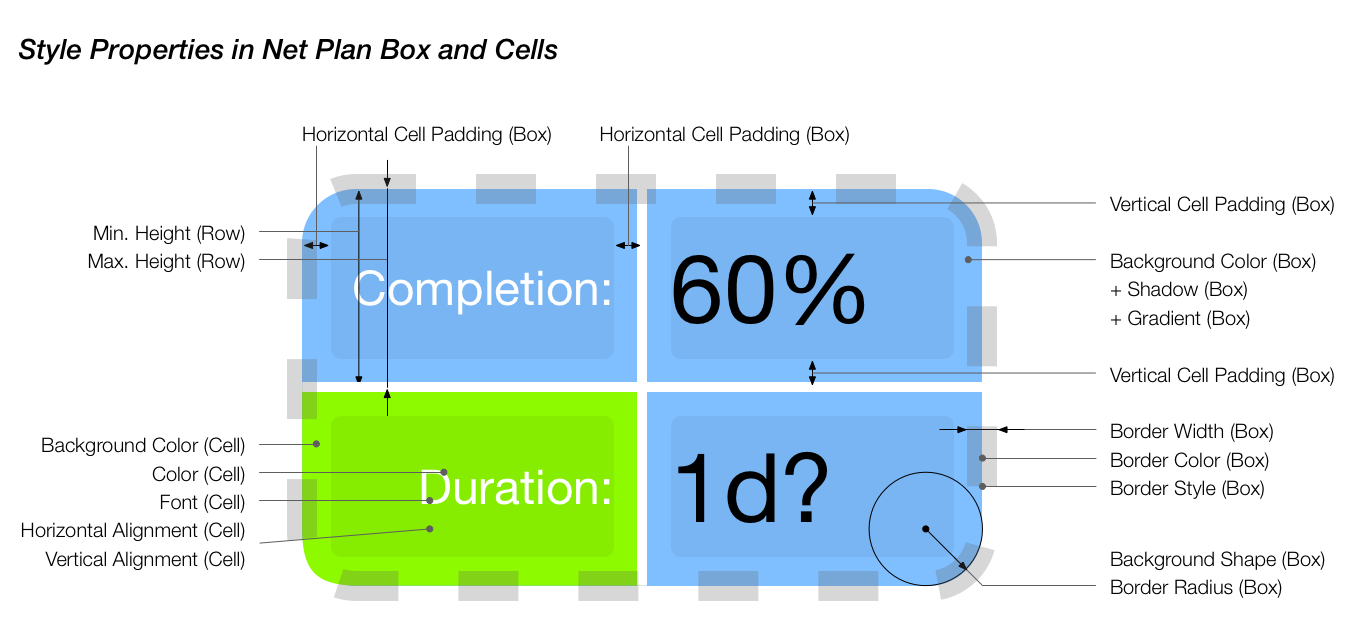
|
|
Right-click a bar, milestone, or group. Select Style and Content > Bars in the context menu. In the Inspector, in the Row Type drop-down menu select either Boxes or Histogram instead of Rows. |
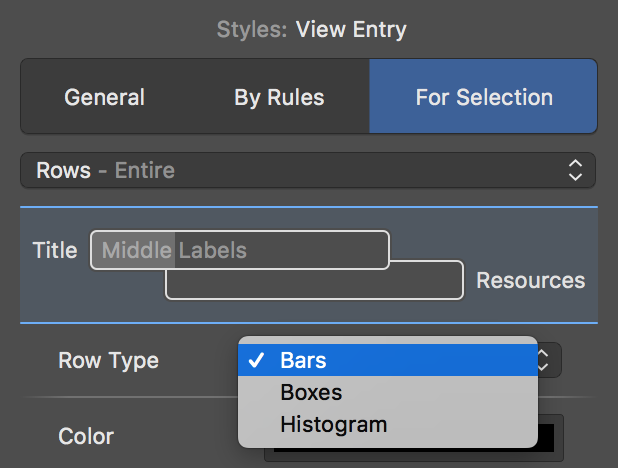
Search and replace
Merlin Project offers you a built-in Find function to search for content within projects.
Use the keyboard shortcut cmd + F to open the search box at the top of the active view.

|
|
You will find all the search options together with the relevant keyboard shortcuts under the menu item Edit → Find. |
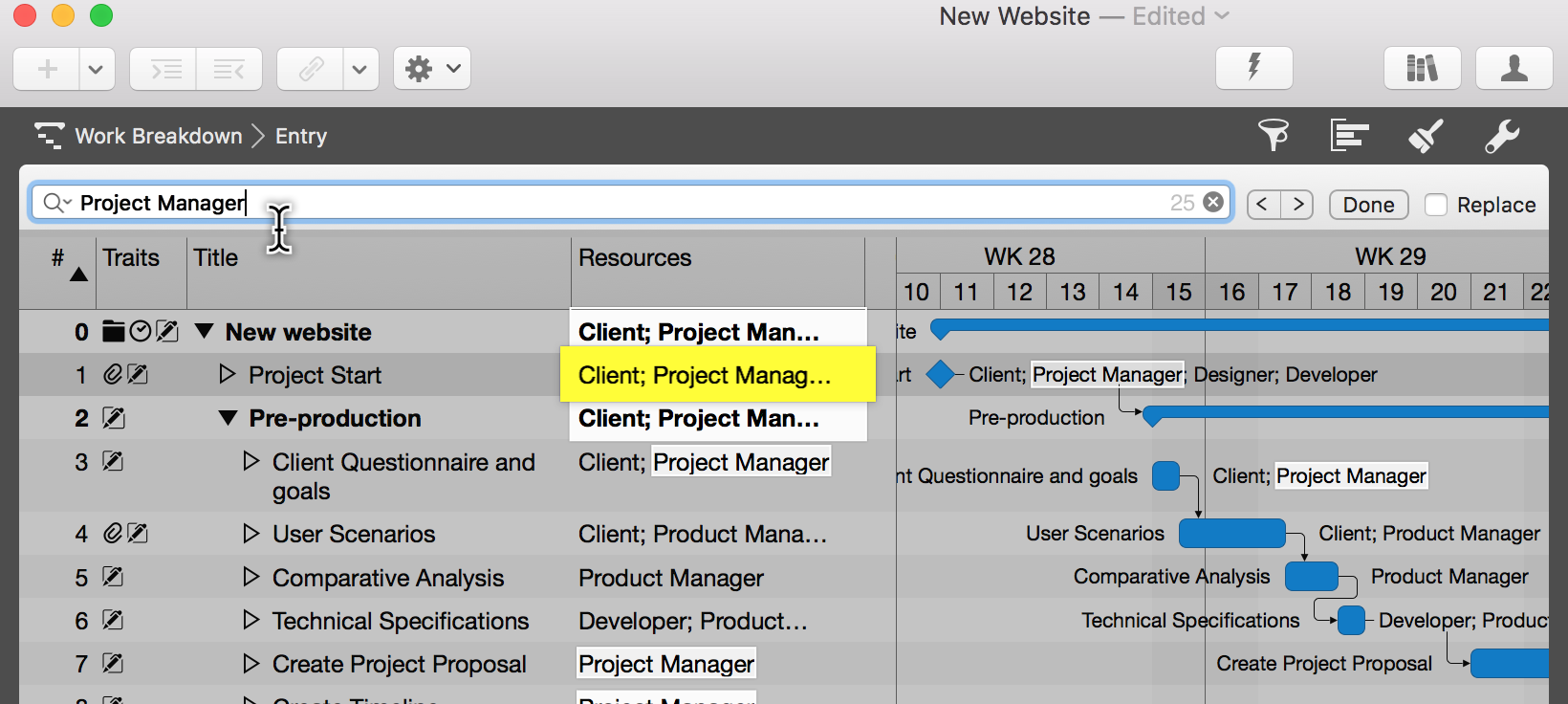
If you enter a term in the search box, all hits will be highlighted automatically in the view, making them easy to spot.
You will find the magnifying glass icon on the left in the search box. Click it and a menu will appear with the options shown.
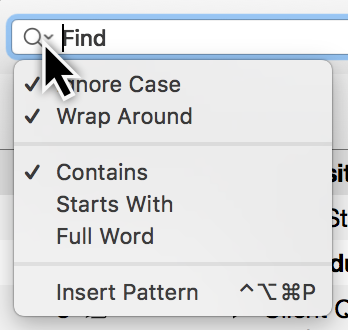
Click Insert Pattern and a further menu will open. There you will find a selection of pre-defined patterns. These patterns make it easier to search.
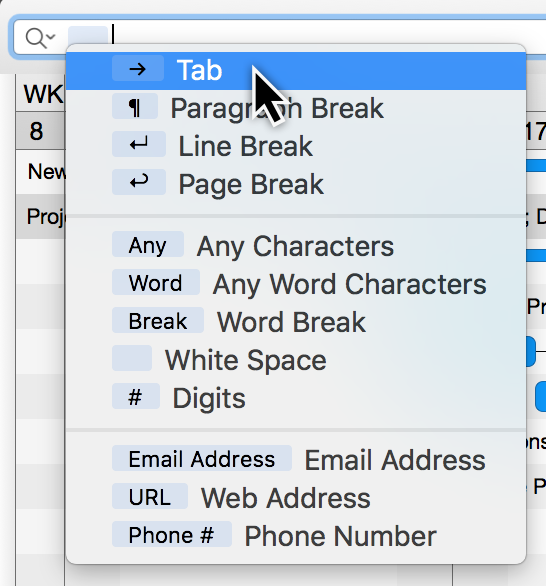
For example, if you select the option Word, individual characters of a word are marked automatically as hits.
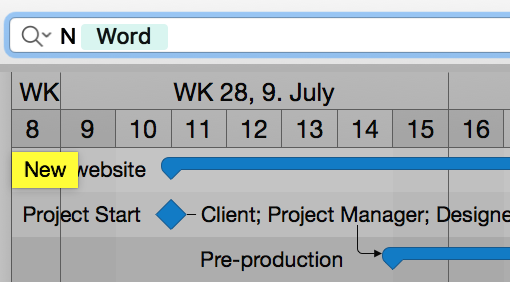
If you enter a letter before the word, e.g. an N, all words starting with N will be found in the project.
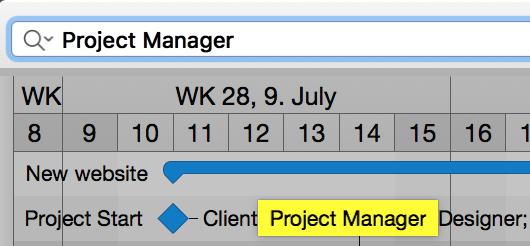
The right-hand corner of the search box displays the number of search hits and includes an x to delete the current search.
To the right of the search box are buttons for navigating the search results.
If there is more than one search hit, use the arrows to the left and right. This takes you to the next (→) or previous (←) search hit.

Click the Done button to exit the search and hide the search box again.
If you tick the checkbox next to the option Replace, another box appears. Now you can find and replace terms in the project.
Replace
The Replace function is very easy to use. Enter the word(s) to replace in the upper search box. In the lower box, enter the word you want to replace the hits with.

On the right next to the Replace box you will find three buttons:
-
Replace (_replaces search terms step by step)
-
All (replaces all search terms at once)
-
Done (finishes replacing)
Find menu
In the menu item Edit → Find you will find all the search options described above as well as the following ones.
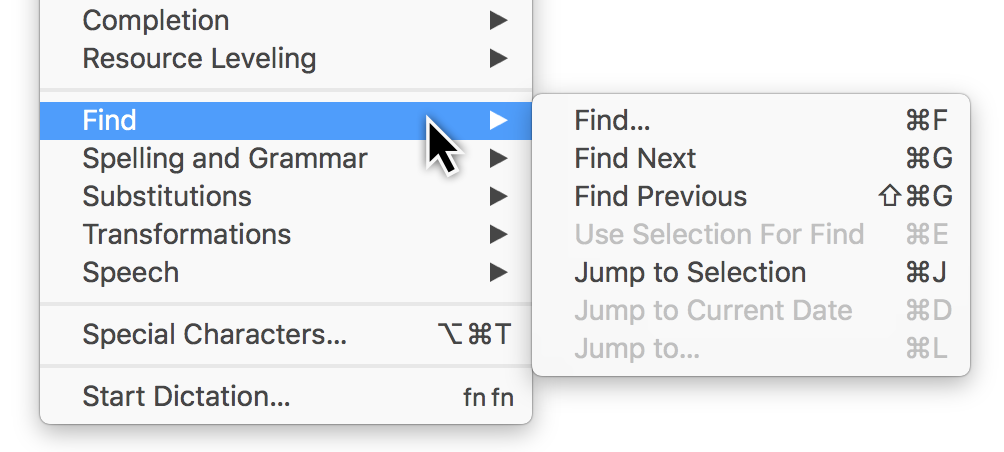
Using a selection for searching
Use Selection For Find lets you additionally search through hits.
Use the keyboard shortcut cmd + E for the option.
Jump to Selection
Jump to Selection lets you jump to a previously made selection, such as a selected activity or several items of selected content in the project.
Use the keyboard shortcut cmd + J for the option.
Jump to Current Date
Jump to Current Date lets you find the current day in the project quickly.
Use the keyboard shortcut cmd + D keys for the option.
Jump to…
Jump to… lets you jump quickly to individual project rows.
|
|
This feature is particularly useful for very large projects. |
Use the keyboard shortcut cmd + L keys for the option.

The Jump to box will appear in the active view. Enter the desired row number into the box.
By clicking the triangle you set your preferred numbering:
-
#
-
Code
-
WBS Code
|
|
If you also use custom Code or WBS Code in addition to the default # numbering, you should display the corresponding columns. |
Project settings
Merlin Project provides a number of settings for the open project. Click the Settings icon or use the File → Project Settings menu to open the Inspector.
General
The General tab contains the following settings for the project:
-
Date Presets
-
Work
-
Duration
-
Status Date
-
Resources
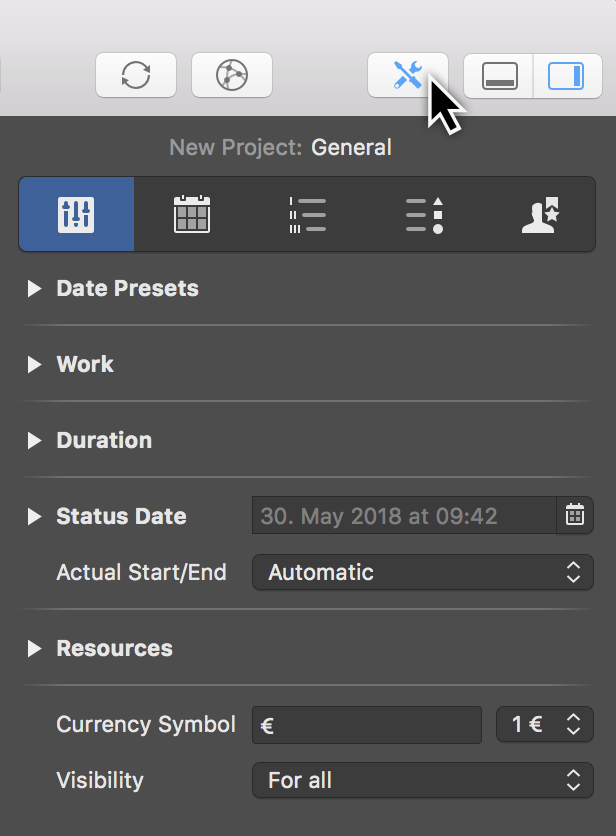
|
|
The visibility of the project relates to multi-user use and Merlin Server. |
Here you will also find settings for the currency sign used in the project and the visibility of the project.
Date Presets
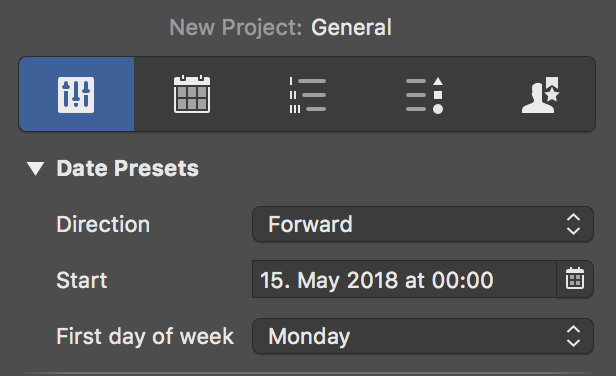
Date Presets relate to the project and are therefore important.
Direction
The direction sets whether the project is forward planned or backward planned.
The Forward option is active by default and lets you begin a project from the start date.
The Backward option allows you to work backwards in the project starting from an end date.
Start
The Start is the start date for the project and is required.
|
|
Whenever you create a new project, tomorrow’s date is always set automatically as the start. |
First day of week
The First day of the week option specifies the day on which the week begins. This varies from country to country. By default, in Europe a week starts on Monday.
Work
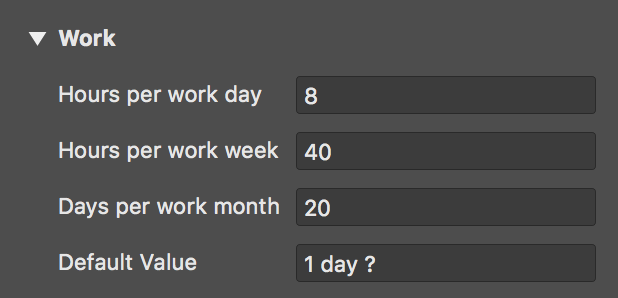
This is where you will find the project work settings.
The following values can be set:
-
Hours per working day
-
Hours per working week
-
Days per working month
Default Value
The Default Value is used for newly created activities. Each new activity is assigned the Default Value for Work automatically.
The ? is only an indication that the Default Value is estimated. Delete the ? if not required.
Duration

This is where you will find settings for the project duration.
As with work, a Default Value for Duration can optionally be set. This means that new activities are assigned the Default Value automatically for the duration.
Calculation unit
The calculation unit determines the unit for calculated fields. Per default it is set to Dynamically. This means that the units are calculated dynamically according to the Work project settings: 8 work hours become 1 work day, 40 work hours become 1 work week, 20 work days become 1 work month.
Units are available in the drop-down menu. Once you set a unit, it is used for calculations throughout the project.
Status Date

The current progress in the project is compared against this date. The status date updates automatically by default and shows the macOS date and time.
If a status date is set, the progress of the project can be viewed relative to this specific date. This can be handy if you need to create a status report retrospectively, for example at the end of the month.
If you have set the status date and want it to update automatically by default, click the icon next to the date and then the Auto button.
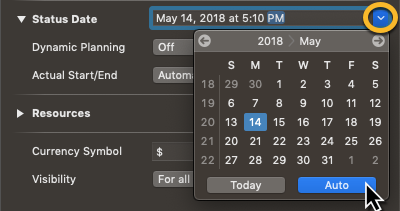
Dynamic Planning
Dynamic Planning is disabled by default.
When activated, Dynamic Planning shifts the content of the project based on the Status Date.
Two variants for Dynamic Planning are available in the drop-down menu:
-
Expected & planned values
-
Only expected values
If you select the first option, dynamic planning is applied to both the expected and planned values in the project.
|
|
If you activate the columns Expected Start and Planned Start, the consequences of dynamic planning are easier to see. |
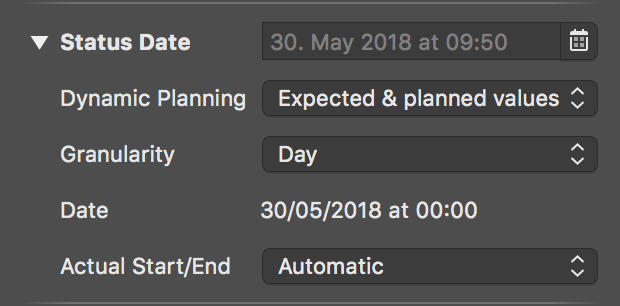
If dynamic planning is activated, further settings appear.
The granularity determines how detailed dynamic planning should be in relation to the status date. The time units are available in the drop-down menu.
For example, if week is selected as granularity, a different date appears calculated based on the status date and granularity. It serves as the basis for dynamic planning.
Actual Start/End
The Actual Start/End option is calculated automatically by default.
Two further options are available in the drop-down menu:
-
From expected values for change in completion
-
From status date when changing completion
These options take effect when changing the completion of activities and influence the actual start/end of the activities.
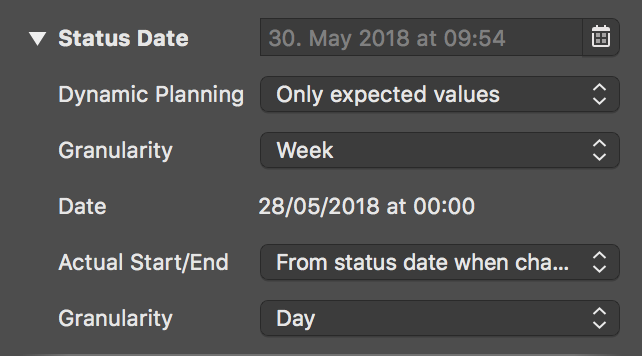
The setting for granularity is also displayed with the From status date when changing completion option.
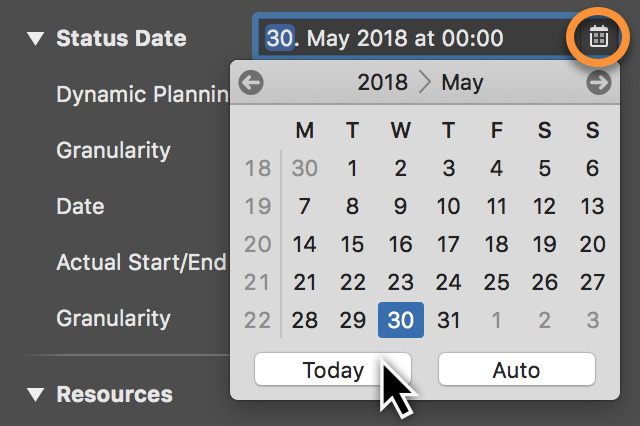
To deactivate the status date, click the calendar icon and the Today button. If you want the status date to move automatically, click Auto.
Resources

This is where you set the Initials Style for project resources. The Initials are under the Style options. The Format must then be set to Initials.
Share their Work
The Share their Work option is important when there are multiple simultaneous assignments. For example, if two resources are moved to one activity, both share the work equally.
Remove the checkmark to stop the automatic assignment of labor to assigned resources.
Calendars
In the Calendars section you can manage the various calendars in your project. Here you can edit, create new, rename, delete calendars and define which calendar should be the default Project Calendar.
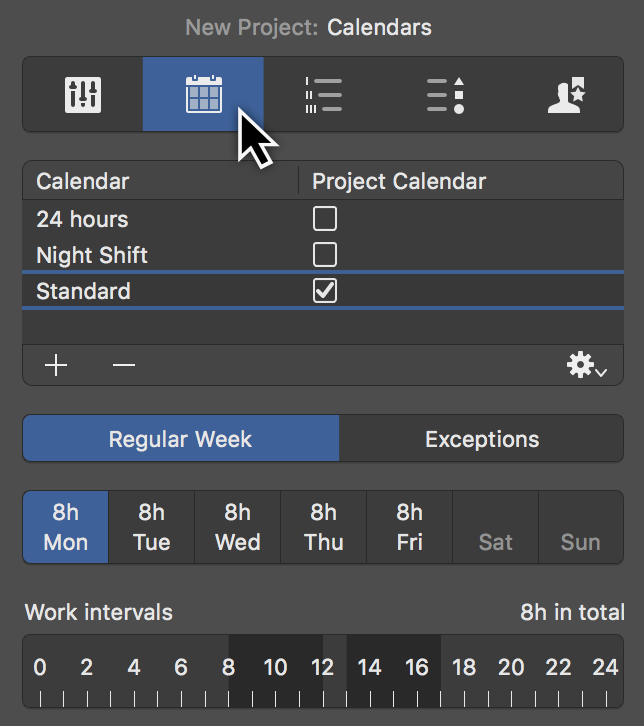
New Merlin Project documents come with following pre-defined calendars:
-
Standard - 5 days by 8 hours spread out over the day time (8am-12pm and 1pm-5pm).
-
Night Shift - 5 days by 8 hours, but spread out over the night hours (11pm-3am and 4am-8am).
-
24 hour - 7 days by 24 hours
|
|
The Project Calendar with the enabled tick, is the calendar which Merlin Project will use when scheduling new activities. Resource calendars applying for new resources are automatically based on the Project Calendar. |
New Calendars can be created by clicking the + icon.
To remove existing calendars, select the calendar you want to delete and click the - icon.
Regular Week
In the Regular Week section you can manage the regular work intervals per week day. Just select the Calendar you want to manage, select the various week days and edit its regular Work intervals as desired.
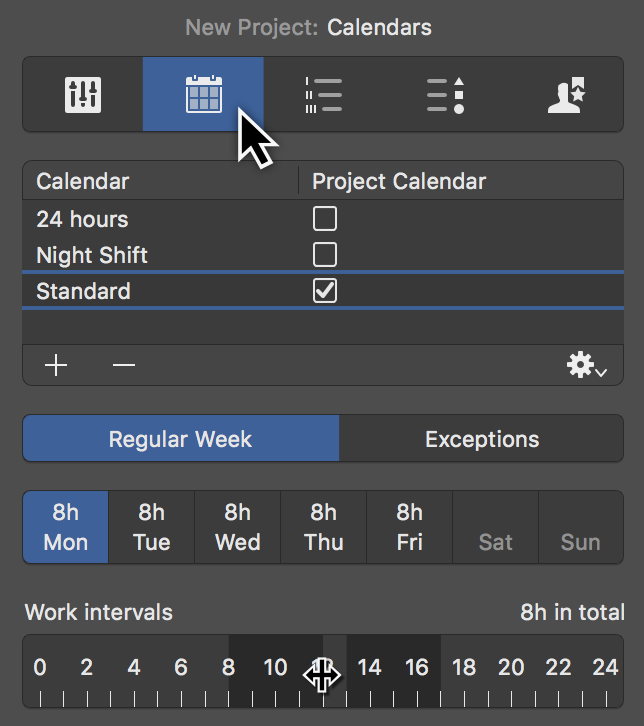
Exceptions
By clicking Exceptions (1) you can set single days or time phases as exceptions for free time and extra working time in the active calendar.
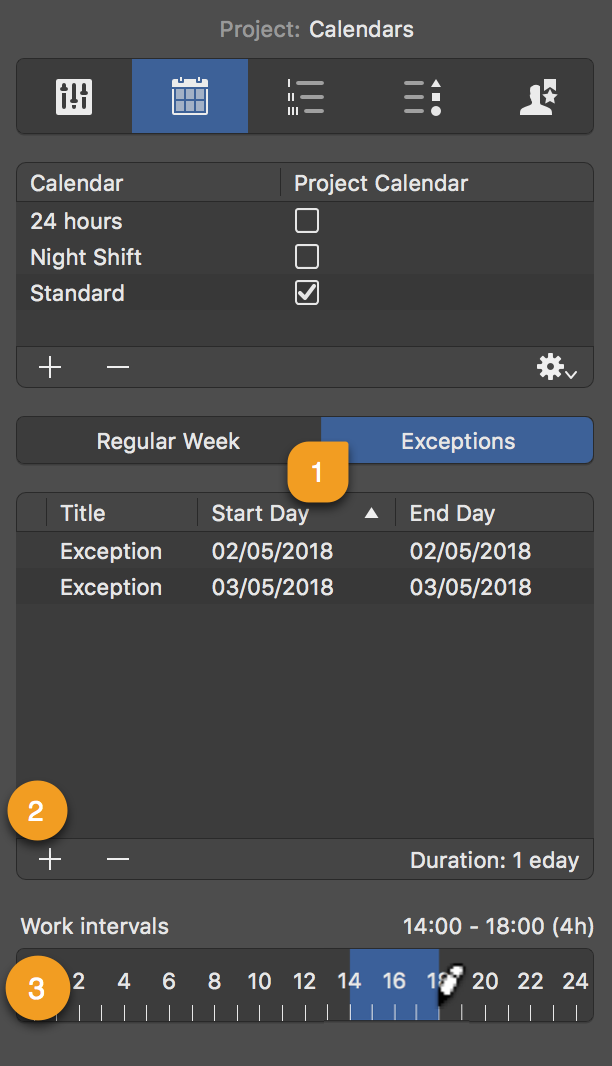
New exceptions are created by clicking the plus (2) icon. Each exception can be customized with the following information:
-
Title
-
Start Day
-
End Day
By default, new exceptions are defined as non-working hours.
These times are only active as additional working times (outside regular working time) when times are added in the Work intervals bar (3).
|
|
Exceptions with Work intervals show a clock icon in the list. |
Import / Export Calendars
Use Export option, to export a configured calendar from a project to be able to import in another Merlin Project document. The exported file will include the Calendar’s name, Regular Week and Exceptions.
Use Import option, to import a Merlin Project calendar you’ve previously exported, or to insert Exceptions in your existing project out of an ics calendar file.
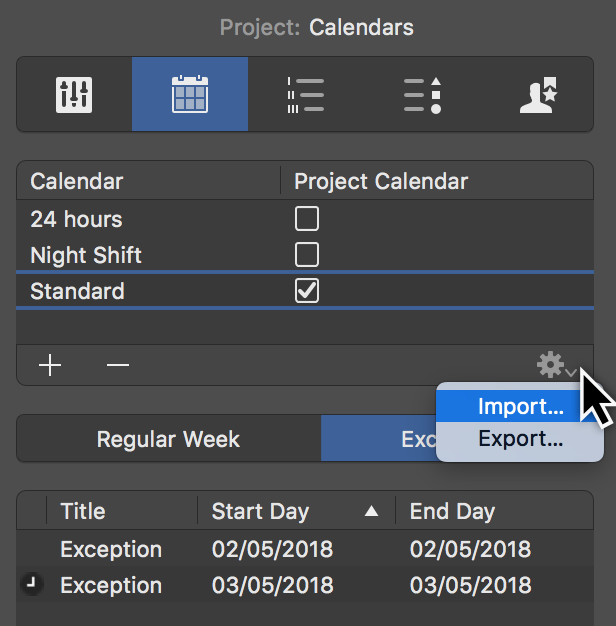
|
|
Importing an ics calendar file, imports all day events as Exceptions into the project. |
Working times for resources
You can configure the Regular Week and Exceptions of the working times for your Resources in the same way as for the project Calendars.
Just select a Resource row in a Resources or Assignments view, and click the Calendar tab in the Inspector.
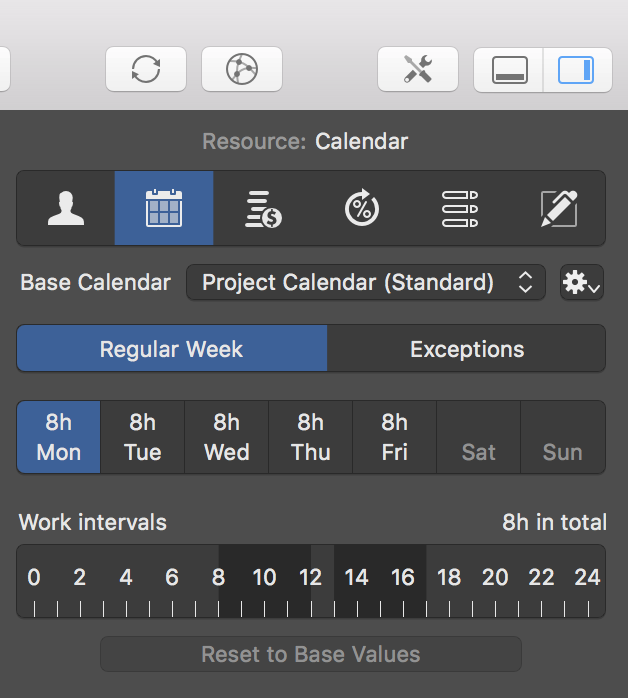
Resource calendars are per default based on the project calendar.
Use the Base Calendar drop-down menu to select another project calendar for the active resource if needed.
If you make changes to the resource calendar, these settings will take priority over the selected Base Calendar.
You can Reset to Base Values and remove changes from the resource calendar for the individual days.
The Calendar tab in the Resource Inspector offers some more options:
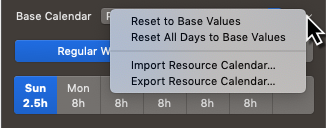
-
Reset to Base Values - resets changes for individual days
-
Reset All Days to Base Values - resets all changes for all days
-
Import Resource Calendar… - imports Merlin Project calendars or ics calendar files as Exceptions.
-
Export Resource Calendar… - exports Merlin Project calendars
Codes
Work breakdown structure (WBS) elements are typically numbered sequentially in a way revealing their hierarchical structure and providing consistent identification. For example, 1.1.2 identifies an item as a Level 3 WBS element, since there are three numbers separated by two decimal points.
The settings for Codes allow you to control the format of WBS Codes and Outline Codes.
Per default Codes and WBS Codes will use only numbers separated by points.
Should you want to define a custom coding scheme, click the + icon and configure your scheme accordingly.
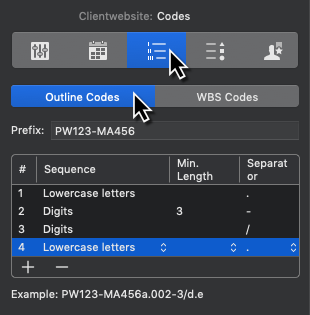
-
Prefix - You can enter a global prefix to be used for all items.
-
# - Shows the outline level for which a specific Sequence is defined.
-
Sequence - Select how this level should be coded. Available options: Digits (Default setting), Lowercase letters, Uppercase letters, Lowercase roman numerals, Uppercase roman numerals, Numbers - spelled out
-
Min. Length - Available options: unlimited (Default setting), min: 1, max: 10
-
Separator - Available options: ., -, /,
-
Example - Here you see a Code example for the custom coding scheme.
|
|
Activate the Code column in the outline, as label on the Gantt or in Net Plan cards. Code values are calculated and cannot be edited by the user. |
Should you want to define a custom coding scheme for the WBS Code, switch to the according tab, click the + icon and configure your scheme accordingly.
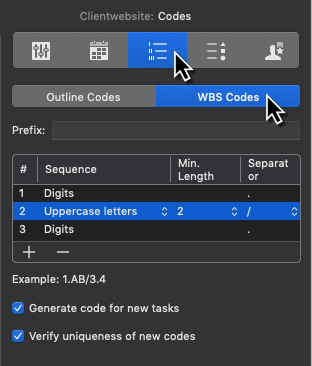
-
Prefix - You can enter a global prefix to be used for all items.
-
# - Shows the outline level for which a specific Sequence is defined.
To comply with project management standards, the WBS Code project settings offer you following Sequence options:
-
Sequence - Digits (Default setting), Lowercase letters, Uppercase letters, Characters
-
Min. Length - Available options: unlimited (Default setting), min: 1, max: 10
-
Separator - Available options: ., -, /,
-
Example - Here you see a WBS Code example for the custom coding scheme.
-
Generate code for new tasks - Disable this option if you want to leave the WBS Code empty when new activities get inserted.
-
Verify uniqueness of new codes - Disable this option if you want to be able to edit WBS Codes and the app should not check for duplicates.
|
|
Activate the WBS Code in the outline, as label on the Gantt or in Net Plan cards. WBS Code values are calculated but can be edited by the user if required. |
Value Lists
Here you can edit entries of Value Lists used in attachments or for cost.
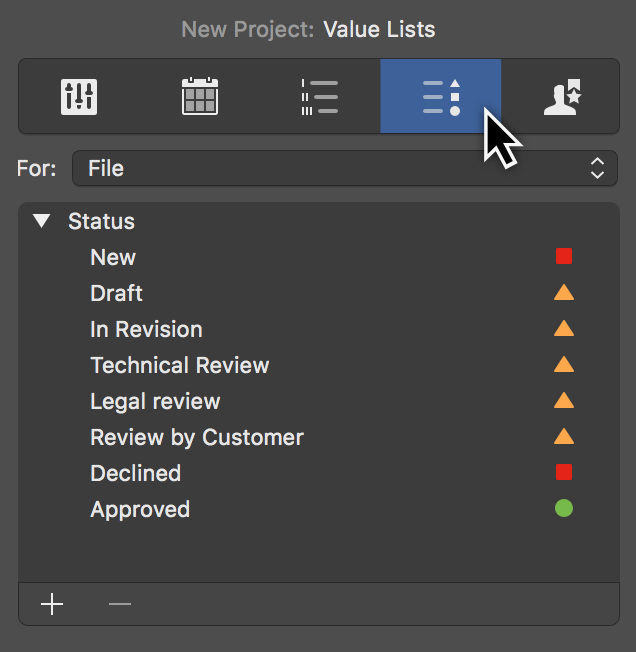
Lists are available for:
-
Cost (Type, Status)
-
File (Status)
-
Event (Status)
-
Information (Type)
-
Issue (Category, Type, Status)
-
Resource (Role)
-
Risk (Risk Group)
To insert new items in a Value List:
-
Select the relevant list from the For drop-down menu
-
Click the section of the list where you would like to insert a new entry
-
Click the + symbol to create a new entry.
-
Edit the entry as desired.
|
|
You may drag the new entry upwards or downwards to change its order. |
Change the name of existing entries by double-clicking the title of the entry.
Click the - symbol, to delete values from the list.
Some value lists allow you to set an attention symbol. Simply select the desired symbols as needed.
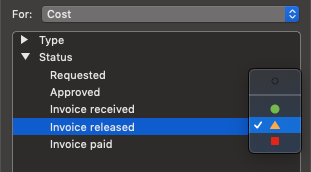
Utilization
The Utilization tab contains various options for Utilization Calculation, Resource Leveling, and for Resource Pools.
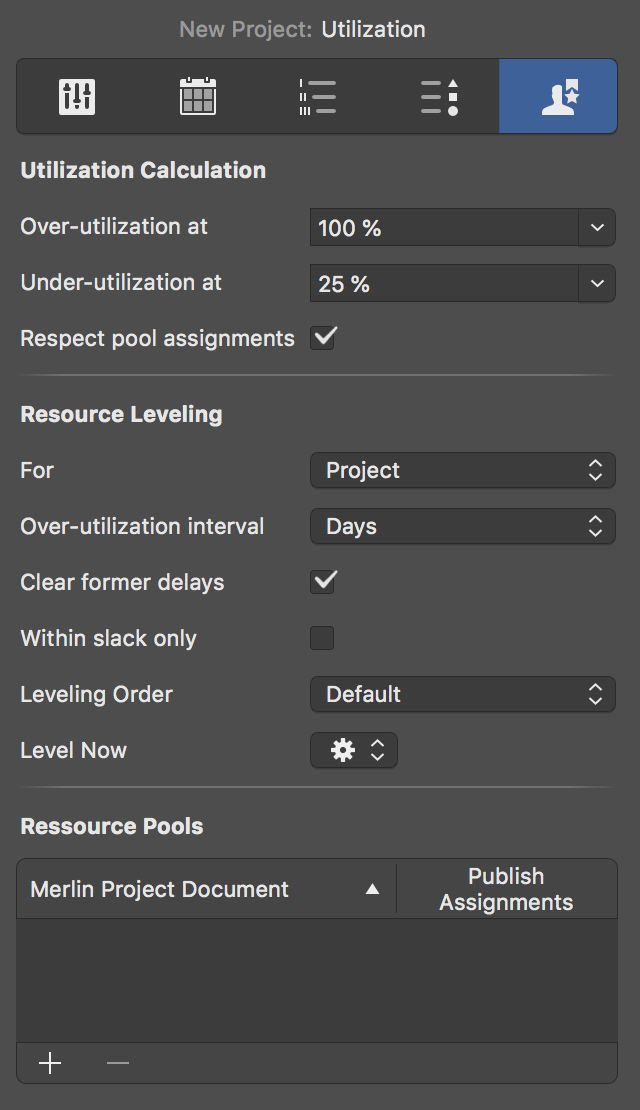
Utilization calculation
Three options are available for Utilization Calculation.
Here you can set the % values for the over-utilization and under-utilization thresholds. These values have a direct influence on the utilization calculation in the project.
The Respect pool assignments option also lets you include resources assigned from resource pools in the utilization calculation based on the thresholds.
Resource Leveling
You have a multitude of options at your disposal to perform resource leveling in the project:
-
For (entire project or an area)
-
Over-utilization interval (unit)
-
Clear former delays (on by default)
-
Within slack only (off by default)
-
Leveling Order (default, priority, or # manual order)
-
Level Now
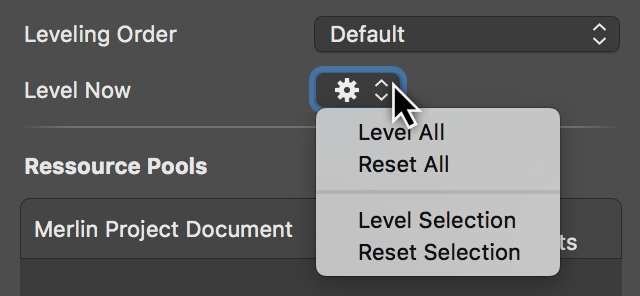
Click the Level Now gear icon and select one of the leveling options:
-
Level All
-
Reset All (restores the original state)
-
Level Selection
-
Reset Selection (restores the original state)
Resource pools
Project files can be added as pools in the Resource Pools list.
The Publish Assignments option lets you make the resource pool assignments visible.
|
|
Further information about resource pools can be found in the guide of the same name. |
Preferences
To open the »Preferences« dialogue, call the Merlin Project → Preferences… menu item.
The preference panes are:
Preferences - General
You can find the general options for using Merlin Project under Preferences > General.
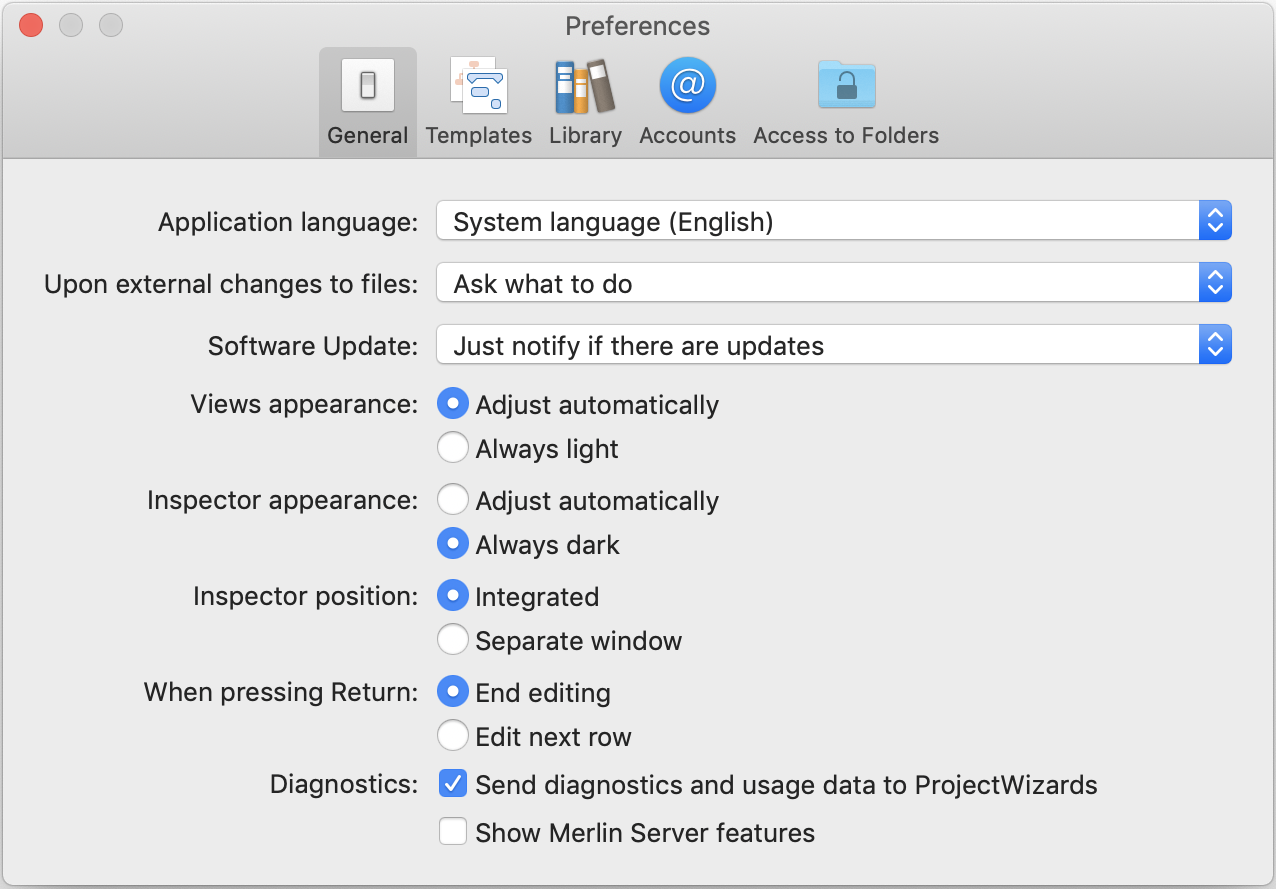
This option is only available when not purchased Merlin Project over the Mac App Store.
The Application language option lets you choose which language you want to use for the application. By default, the system language is used. If you want to use a different language in Merlin Project to the language used in macOS, change it by selecting another language from the drop-down menu.
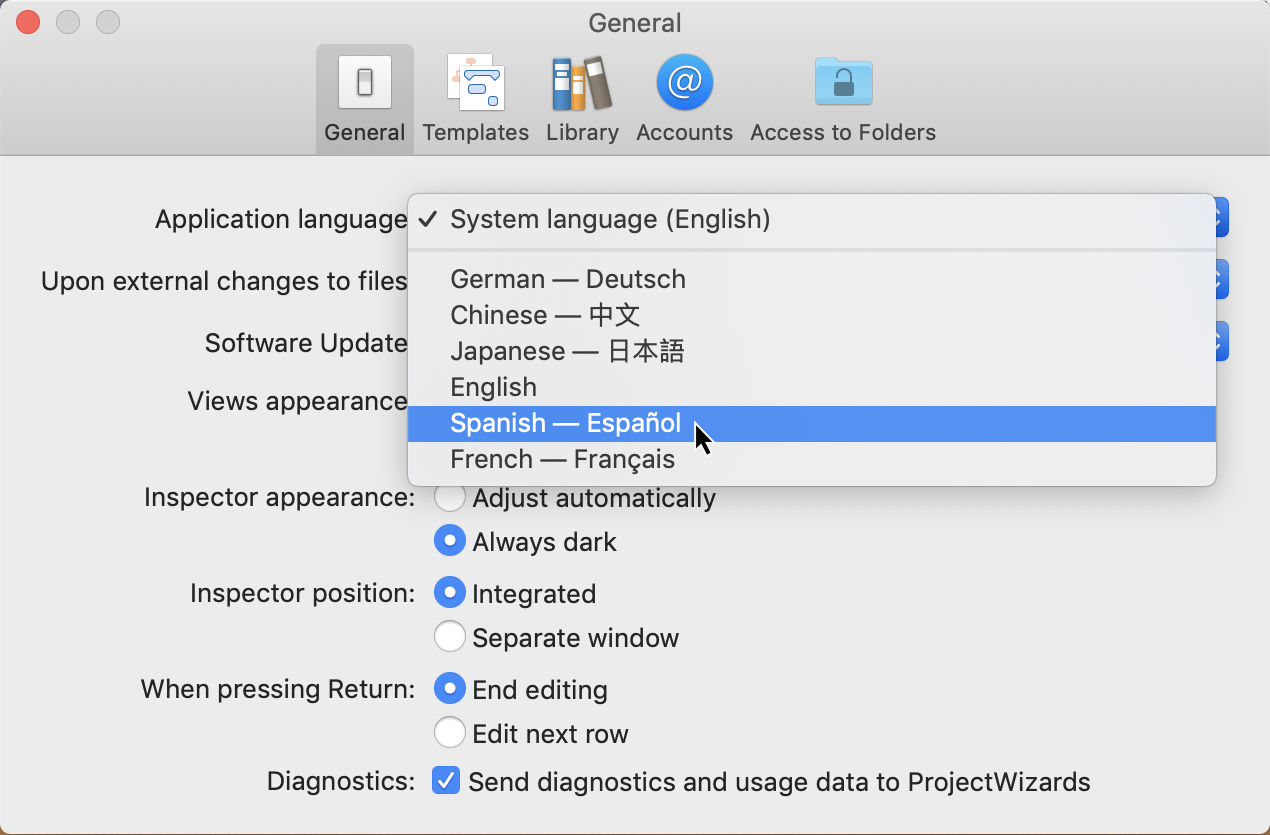
|
|
For example, macOS runs in English but Merlin Project should run in Spanish. |
The Upon external changes to files option contains three options which let you choose how changes made to File type attachments are handled.
-
Ask what to do
-
Ignore
-
Integrate into old version
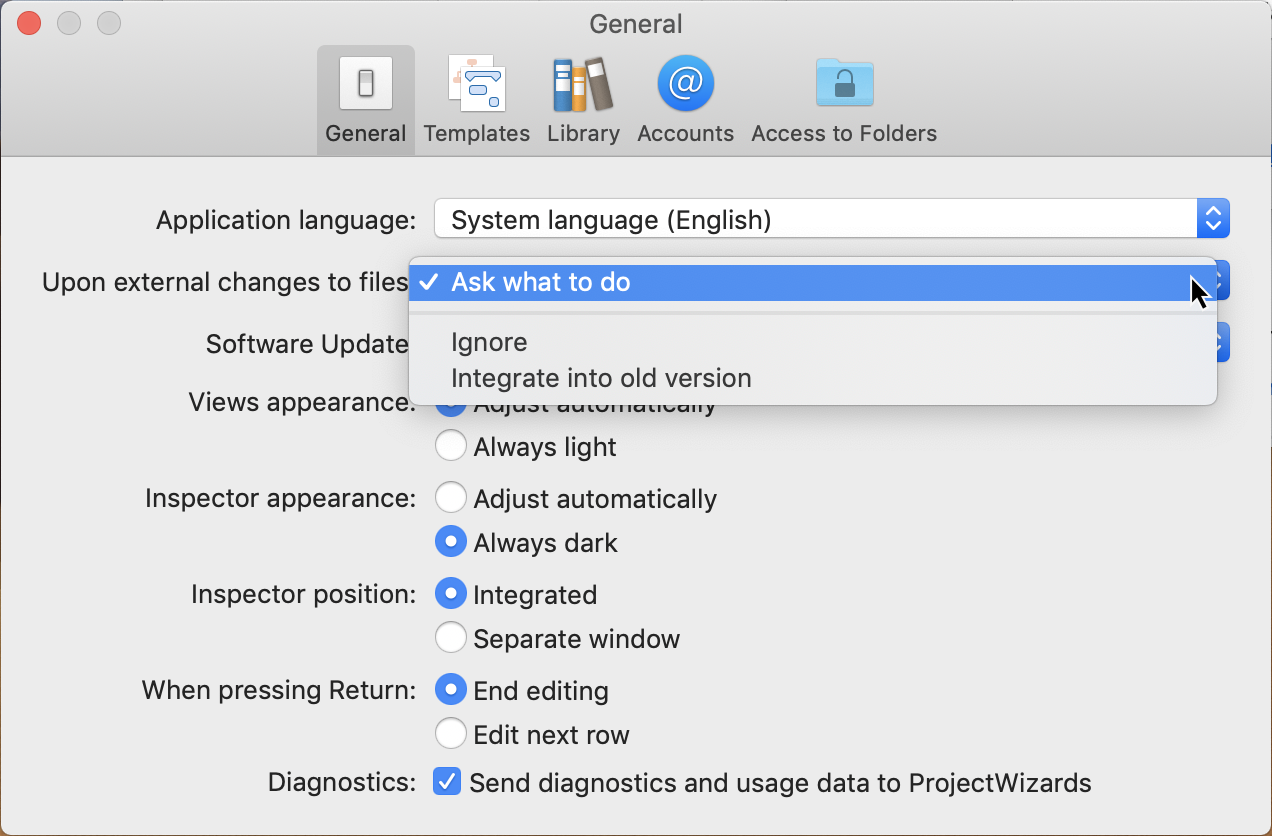
By default, the option is set to Ask what to do. You will be prompted whether you want to save the file as a new duplicate version with the changed content or if the new content should be adopted in the old file version.
Ignore ignores the changes and leaves the file in its original state.
Integrate into old version integrates the changes into the old file version.
This option is only available when not purchased Merlin Project over the Mac App Store.
You can choose between three settings for the Software Update option:
-
Automatically download and install updates
-
Just notify if there are updates
-
Don’t check for updates
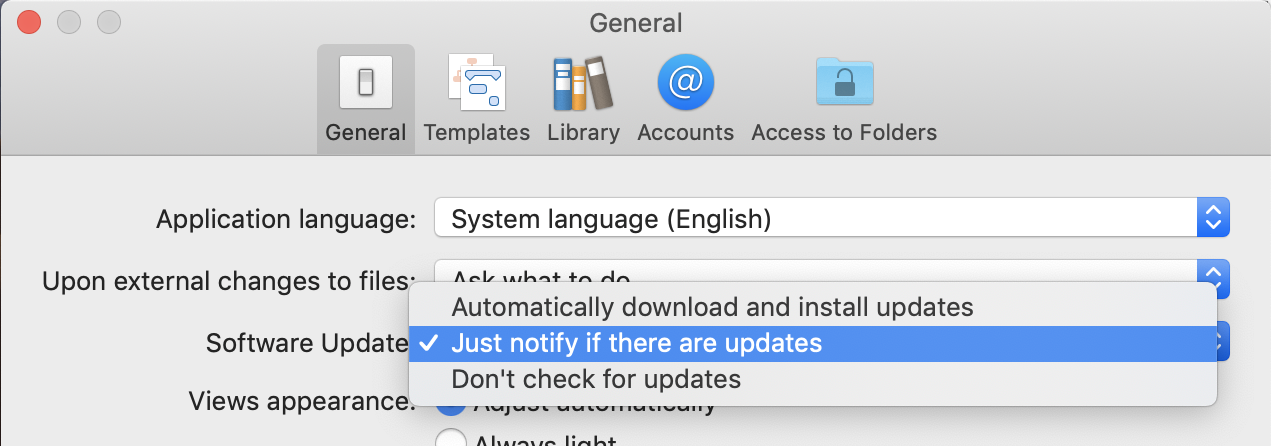
The Automatically download and install updates option searches for updates automatically. If a new program version is found, it is downloaded and installed automatically.
The Just notify if there are updates option notifies you of updates. You then download and install the update manually.
The Don’t check for updates option disables the update search.
|
|
Always use the latest version of Merlin Project. Using older program versions may lead to problems and produce unanticipated results. |
The Views appearance option contains two settings:
-
Adjust automatically
-
Always light
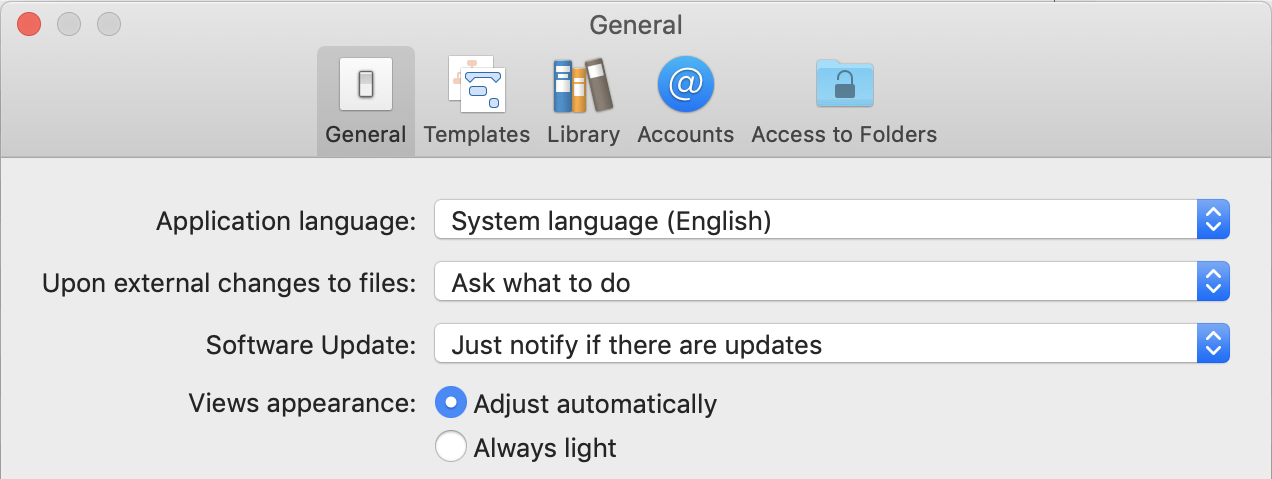
Select Adjust automatically for views to change into the Dark or Light mode as macOS Mojave or later offers it.
Select Always light to keep your views in Light mode even if your macOS is currently in Dark mode.
|
|
Even if using the app in Dark mode, printing always takes place in the light appearance, while image exports take place in the currently selected appearance. |
The Inspector appearance option contains two settings:
-
Adjust automatically
-
Always dark
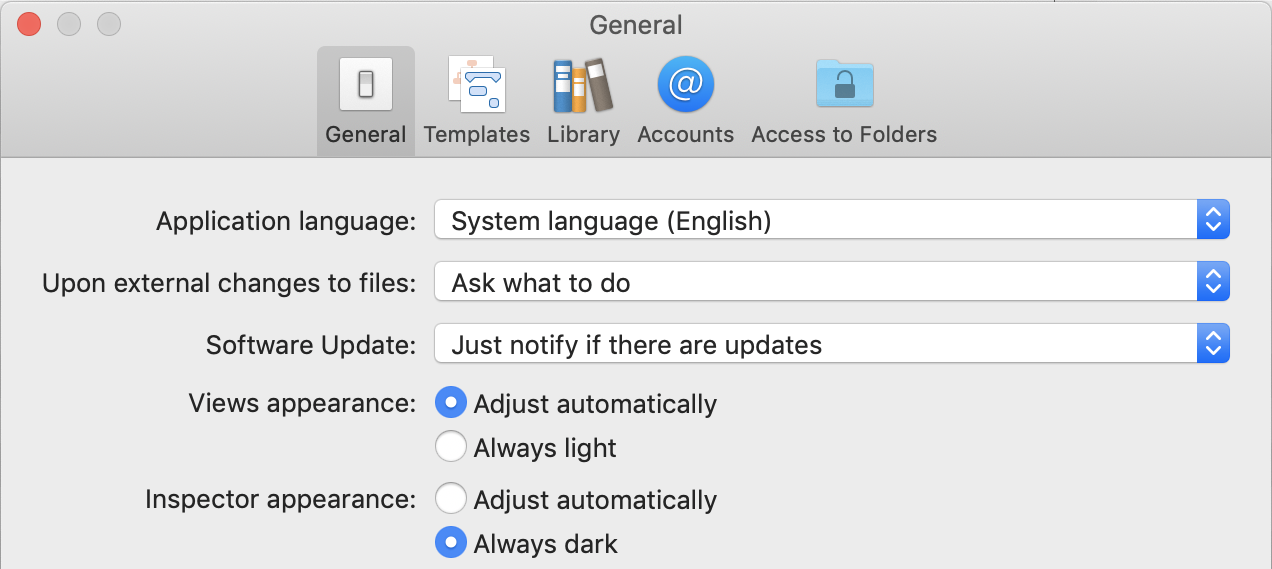
Select Adjust automatically for the inspector to change into the Dark or Light mode as macOS Mojave or later offers it.
Select Always dark to keep your inspector in its dark mode even if your macOS is currently in light mode.
The Inspector Position option contains two settings:
-
Integrated
-
Separate window
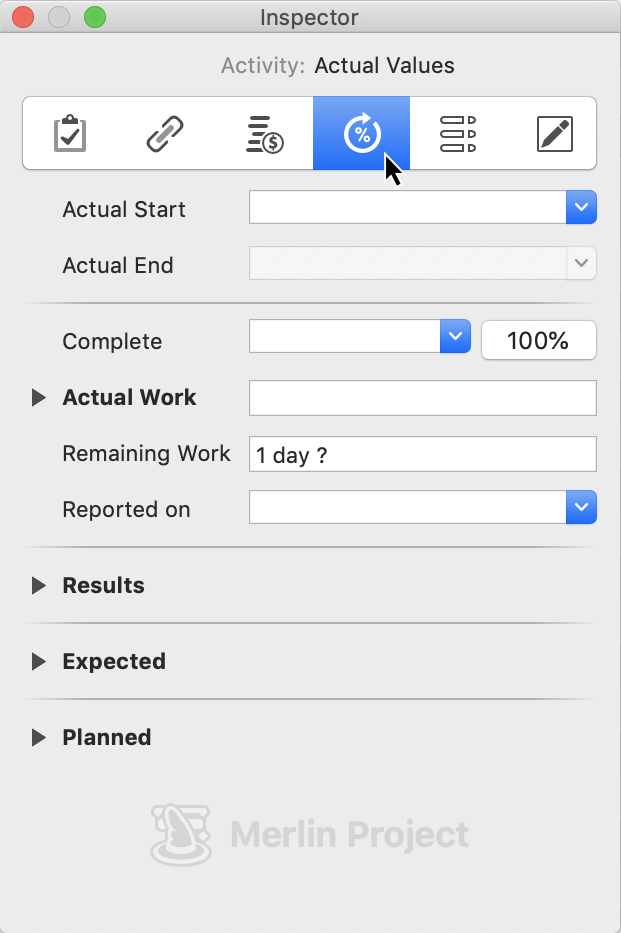
By default, the Inspector is integrated into the main window and part of it. Select the Separate window option to release the Inspector from the main window and use it in a separate window.
|
|
You may want to use the Inspector in its own separate window when using multiple monitors. You can position the main window on the main monitor and the Inspector on the secondary monitor. This frees up space in the main window for the content. |
You can choose between two settings for the When pressing Return option:
-
End editing
-
Edit next row
By default, the option is set to End editing. You can set it to Edit next row, if you are mostly using the keyboard when editing your content instead of the mouse or trackpad.
Enable this option to send diagnostics and usage data to ProjectWizards. By default, the option is disabled.
By default, this option is disabled. When enabled, Merlin Project will show the Merlin Server functions in the File menu.
Preferences - Templates
You can find the options for using Merlin Project under Preferences > Templates.
The »Templates« preference pane lets you select the language of the offered build-in templates and allows you to manage your own project files as templates:
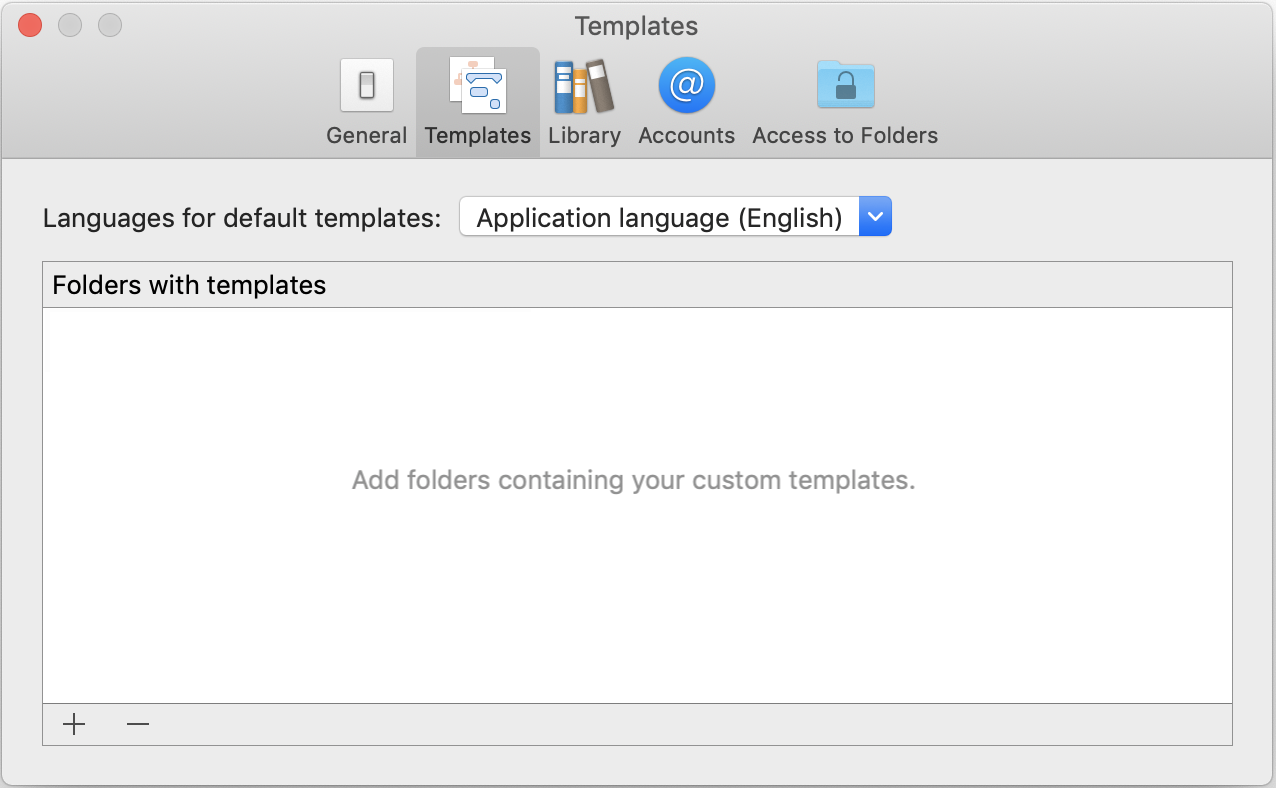
Merlin Project contains project templates in following localizations:
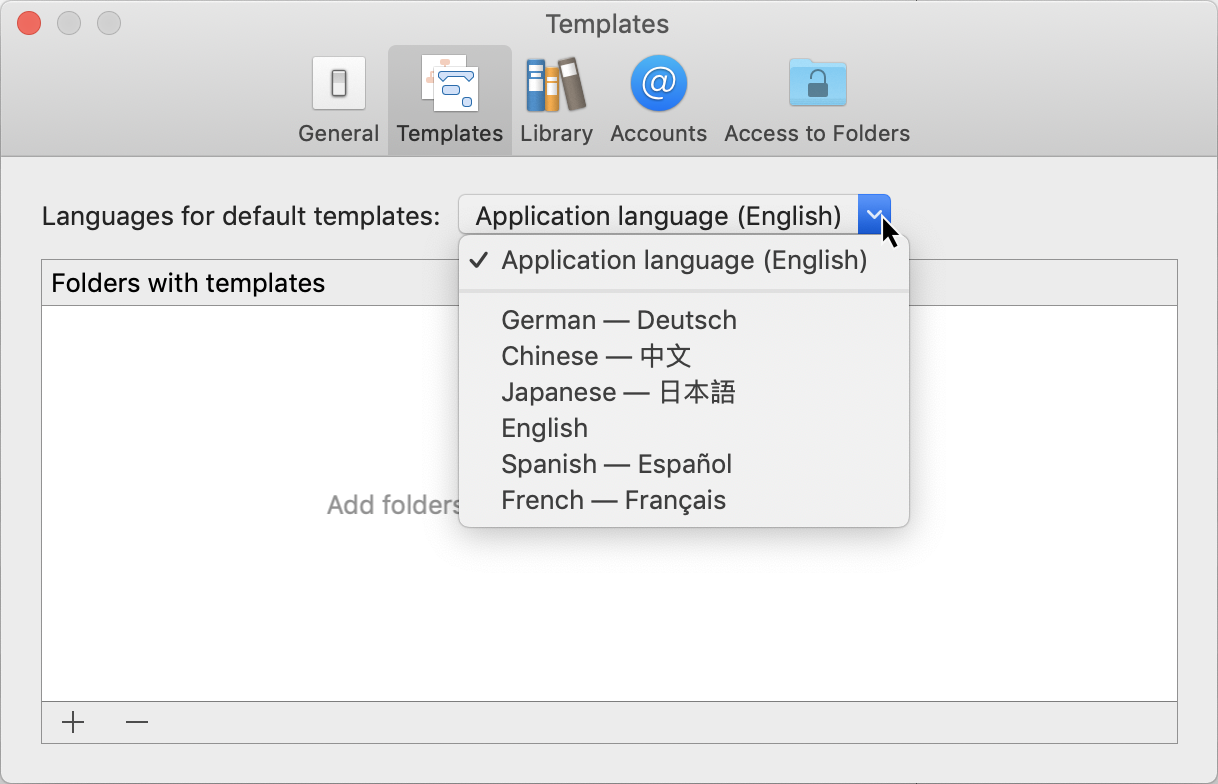
-
Chinese
-
English
-
French
-
German
-
Japanese
-
Spanish
The build-in templates are offered when you call File > New > New Document
By default Merlin Project, shows its build-in project templates in the application language.
If you want to use templates in a different language or enable templates from more languages, select the desired language(s) from the drop-down menu Languages for default templates. You can make multiple selections.
If you want to remove the build-in templates altogether, use the menu to deactivate the Application language
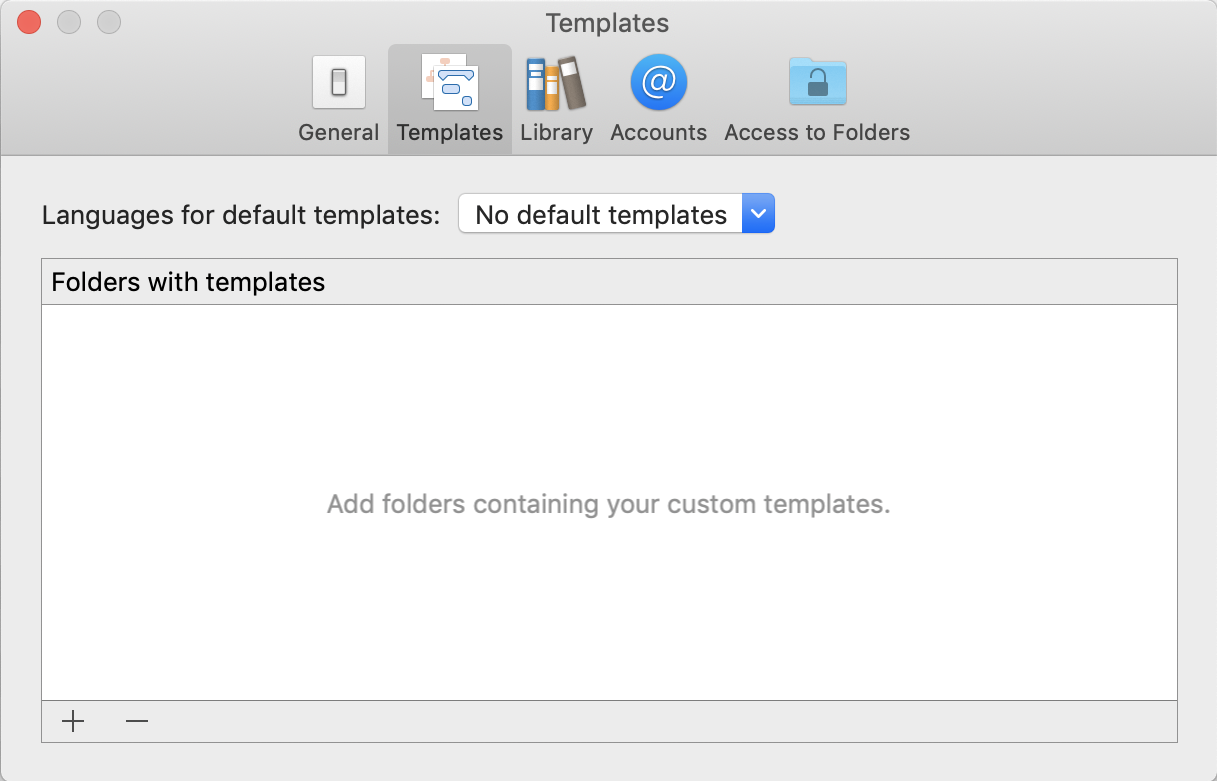
With Merlin Project you may in addition use folders containing existing project files as templates.
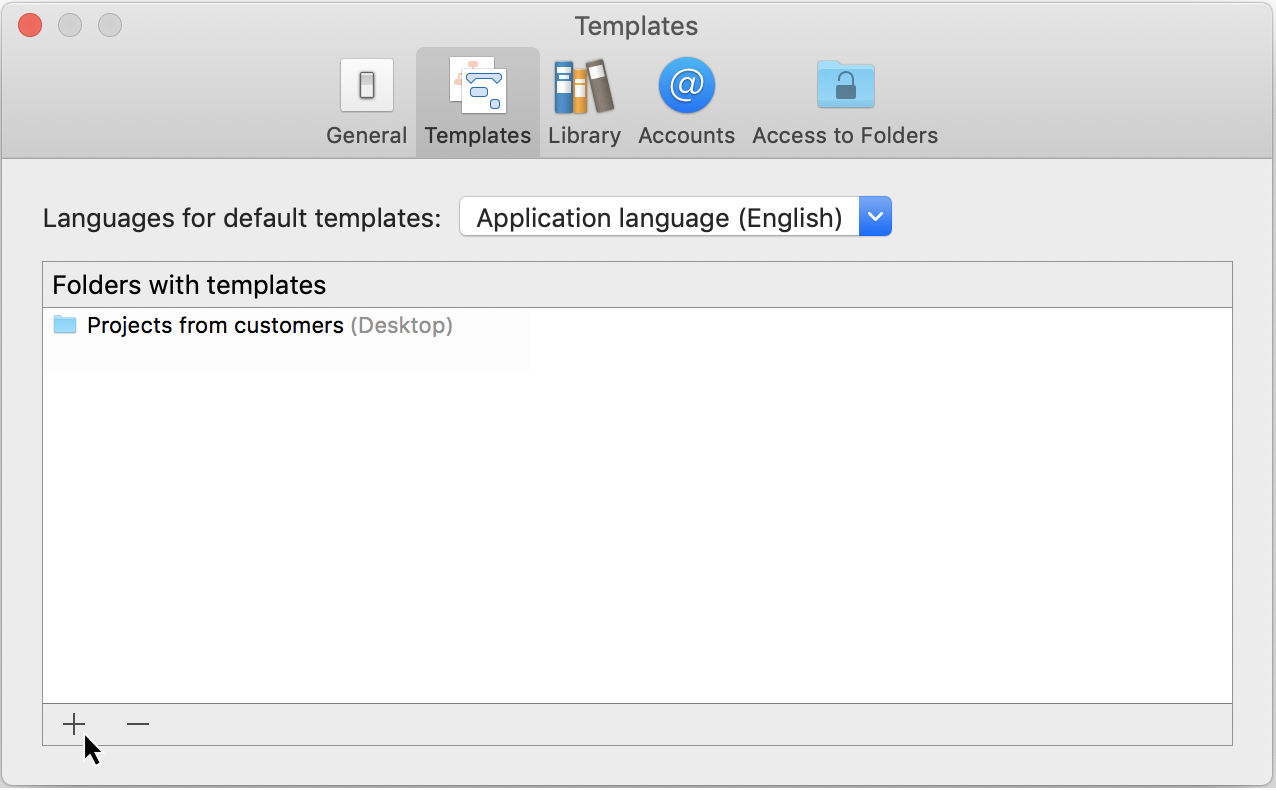
Click »+« and select a folder containing projects.
The folder will be offered when you call File > New in the sidebar. Select the item in the sidebar to see the contained project files and start new projects using their content.
Preferences - Library
You can find the options for using the Merlin Project Libray under Preferences > Library.
The »Library« pane is divided into two further tabs:
And offers in addition following two buttons:
Folders
The »Folders« tab lets you select the language of the offered build-in library items and allows you to manage your own library content:
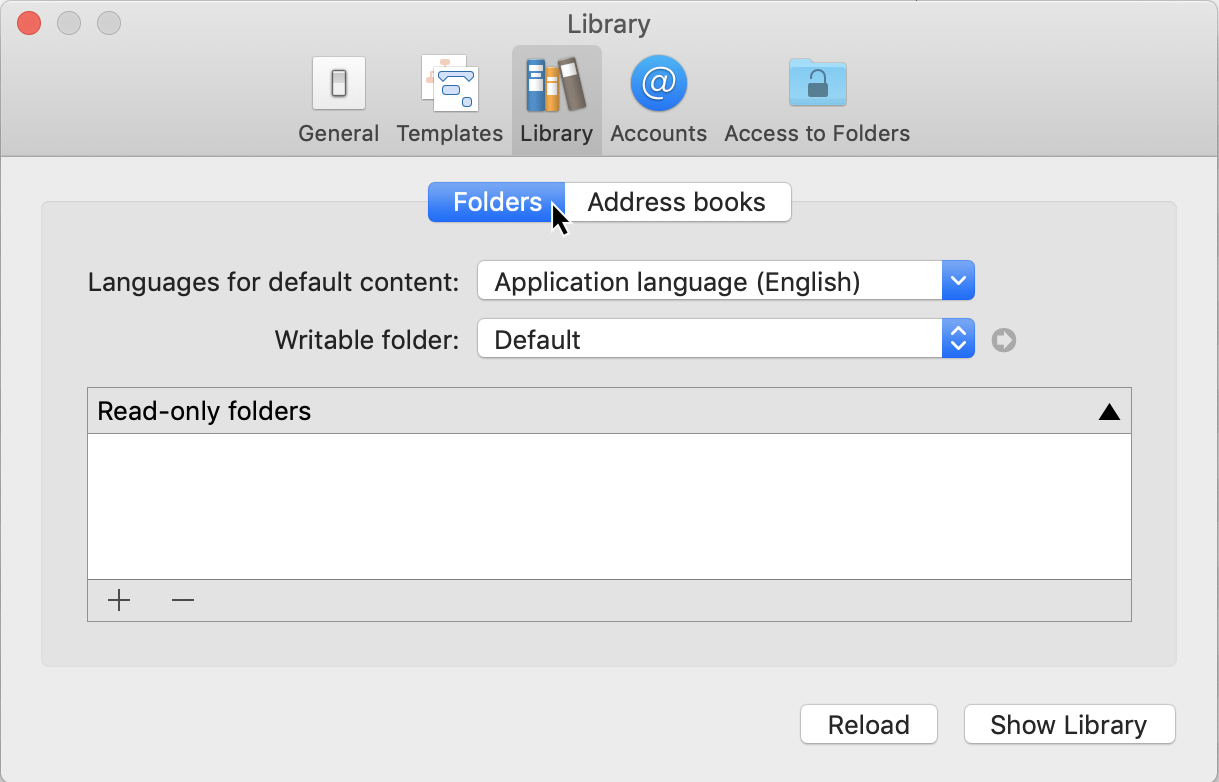
By default Merlin Project, shows its build-in library items in the application language.
If you want to use library content in a different language or enable more languages, select the desired language(s) from the drop-down menu Languages for default content. You can make multiple selections.
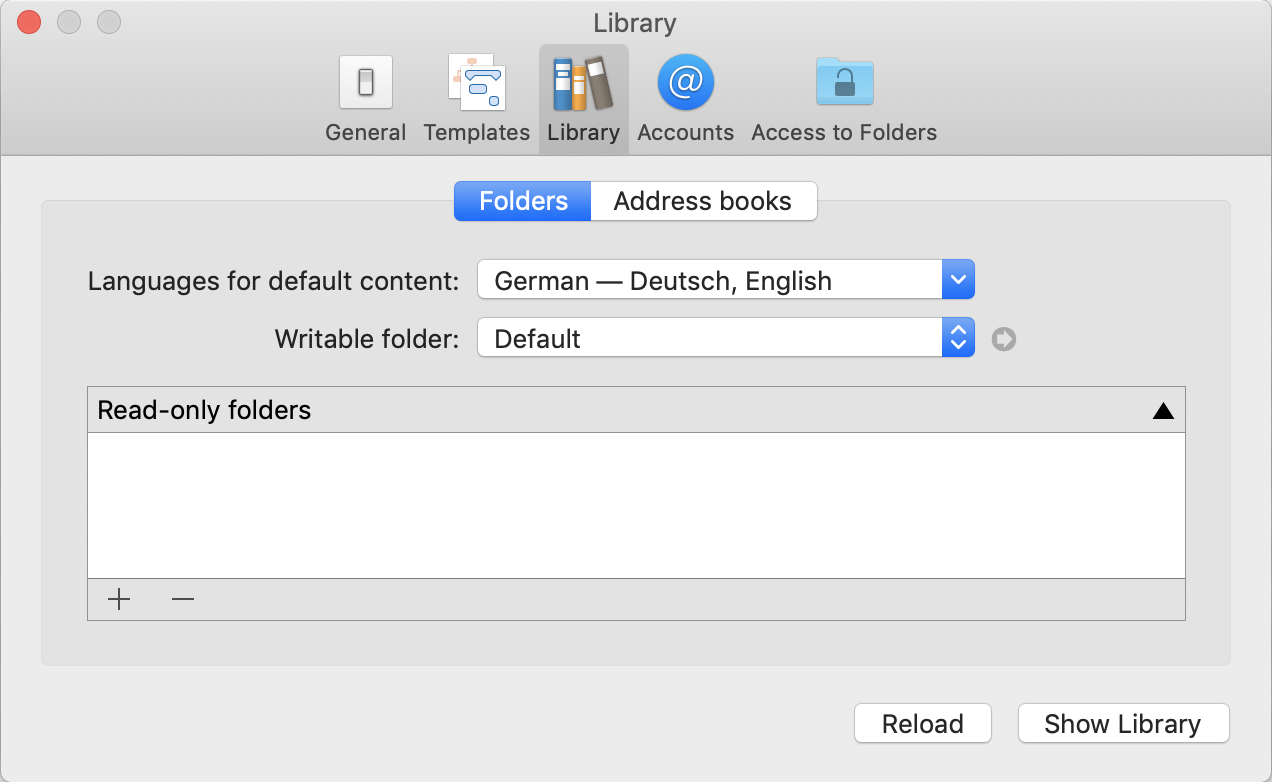
|
|
This setting is connected to the Languages for default templates option from the Preferences - Templates pane. |
The Writeable folder option lets you change the default folder where all Library content will be stored when drag and items in the Merlin Project Library.
Click the arrow icon, to open the selected Library folder in its Finder window.
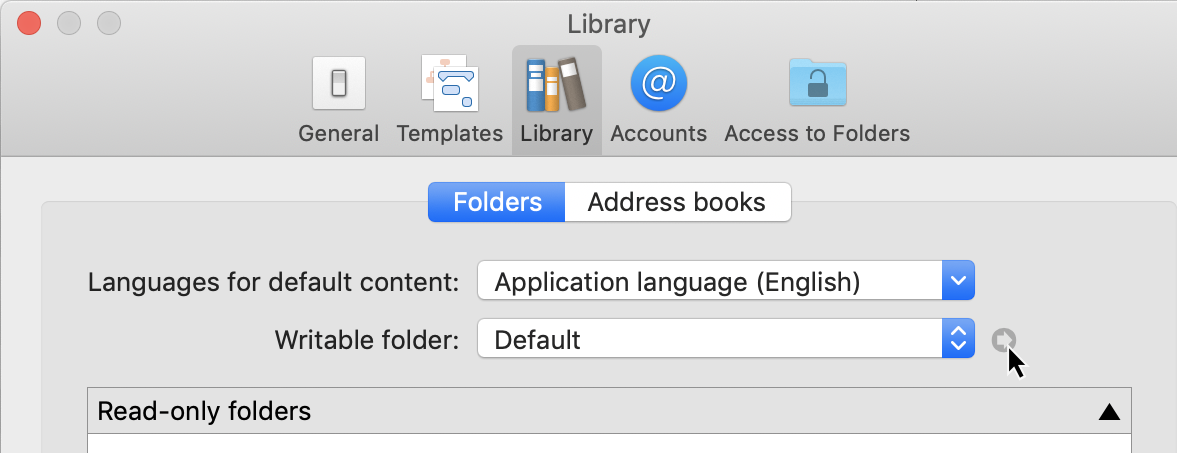
|
|
By default, the folder is located in the user folder. You can access it under the following path on the local volume of your Mac: HD > Users > User name > Library > Containers > net.projectwizards.merlinproject > Data > Library > Application Support > net.projectwizards.merlinproject > Library |
To change the default folder, click Default and select a desired folder.
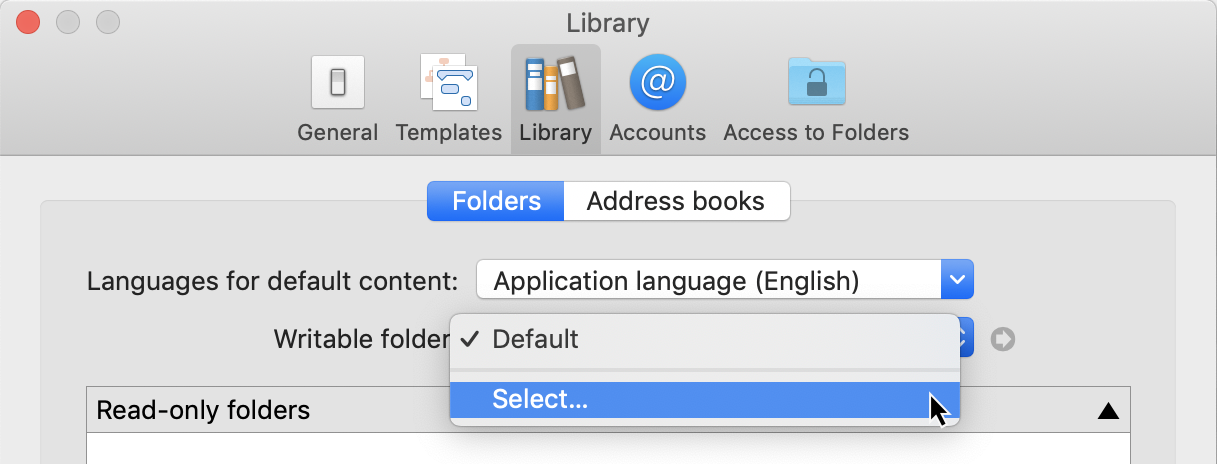
You can configure additional folders with content for the Library in the Read-only folders list. Click »+« to add new folders or »-« to remove them.
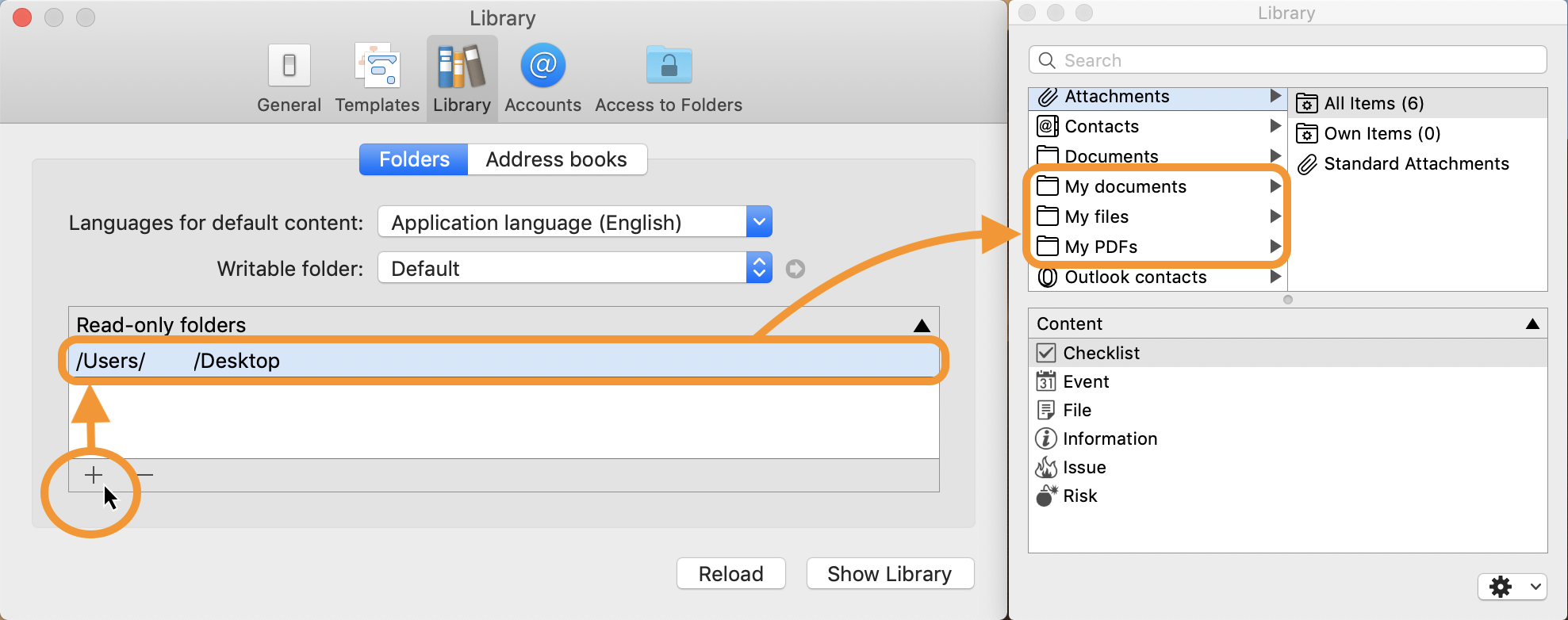
The Library will list all content and sub folders from the inserted Read-only folders.
Address books
The »Address books« tab lets you select and configure the address books the Library should use when listing Contacts.
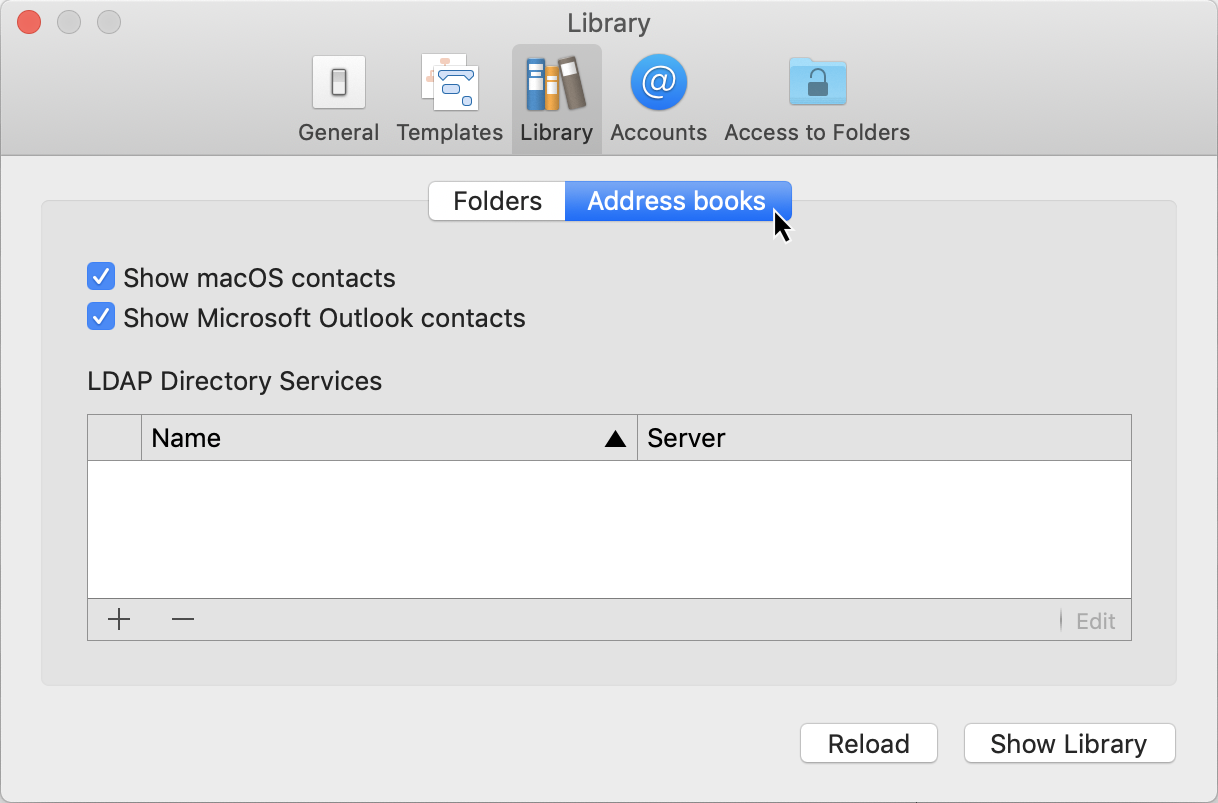
The Show macOS contacts option lets you show or hide in the Library Contacts from the Apple »Contacts.app«.
|
|
For the Merlin Project to able able to show your Contacts from the Apple »Contacts.app«, you’ll need to allow it to access your contacts as explained here. |
The Show Microsoft Outlook contacts option lets you show or hide in the Library Contacts from the »Outlook.app« which is part of the Microsoft Office suite.
|
|
For the Merlin Project to able able to show your Contacts from the »Outlook.app« in the Library, you’ll need to confirm that the app is allowed to control and perform actions with Outlook.app. Confirm granting permission when prompted, or enable in Security & Privacy > Privacy > Automation the checkbox for »Microsoft Outlook« as listed under »Merlin Project«. |
You can enter LDAP servers in the LDAP Directory Services list. This lets you use contacts from an LDAP directory service with the Library.
Click »+« to enter information to connect to and use an LDAP directory service.
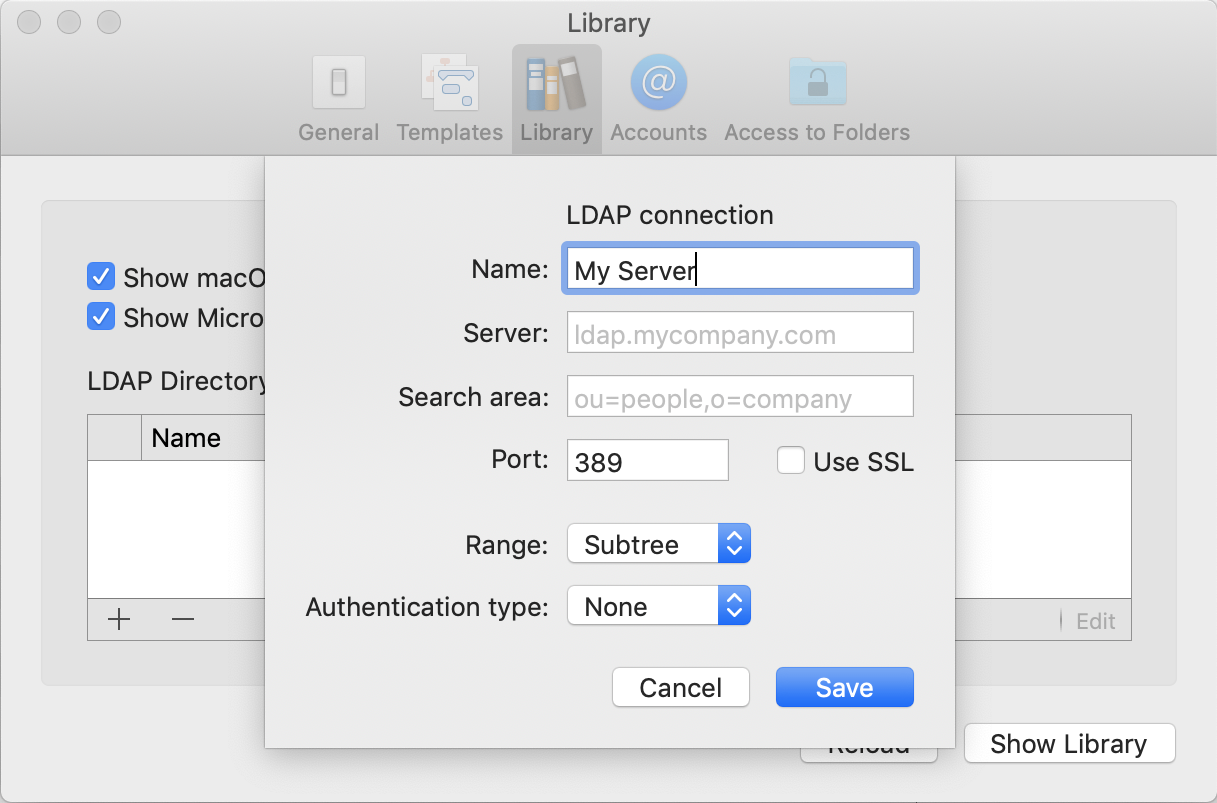
Click »-« to remove an entry. To edit entries, click »Edit«.
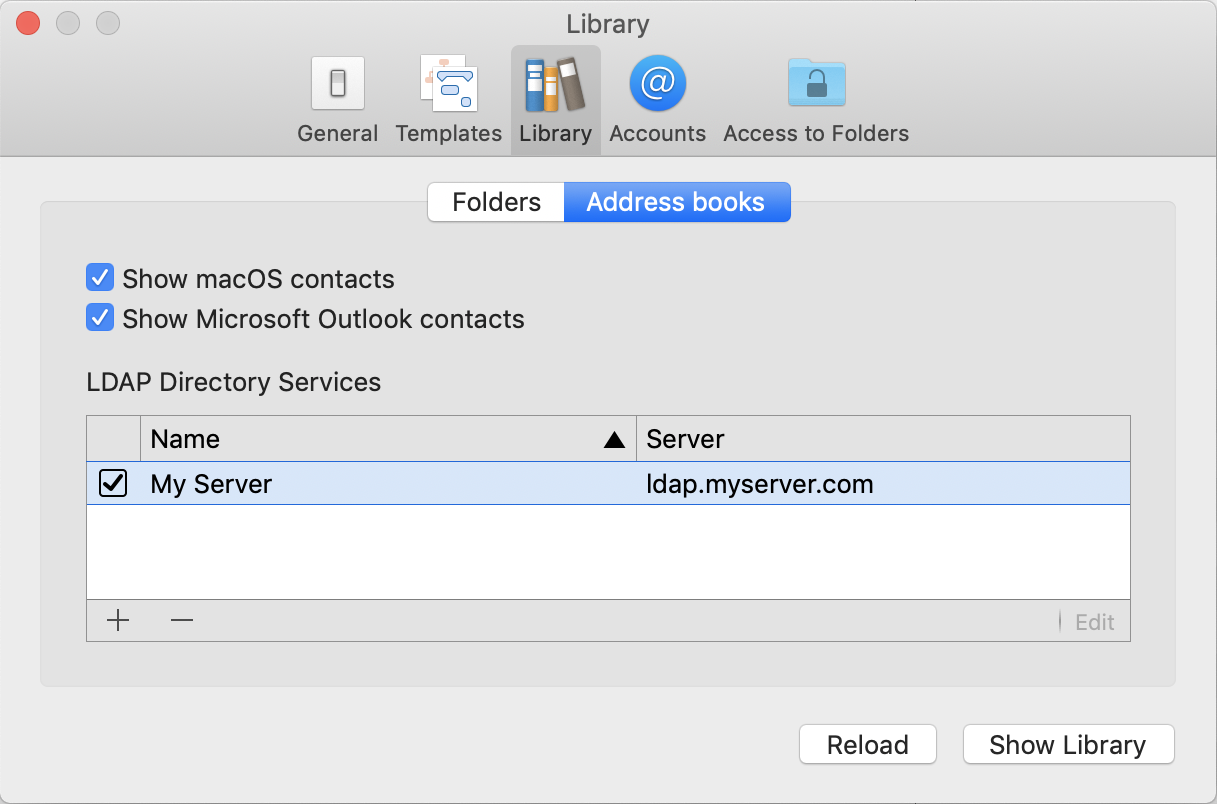
|
|
A linked LDAP server won’t show the complete list of its Contacts in the Merlin Project Library. To use contacts from that server, you need to start a search first. |
Show Library
Click Show Library to open the Library dialogue.
Reload
If having currently opened the Library dialogue and made any changes in the preferences pane, click Reload to update all content listed in the Library dialogue.
Preferences - Accounts
You can find the options for using Merlin Project Accounts under Preferences > Accounts.
You can insert and manage accounts for following protocols:
-
Merlin SErver
-
FTP
-
SMTP
-
WebDAV
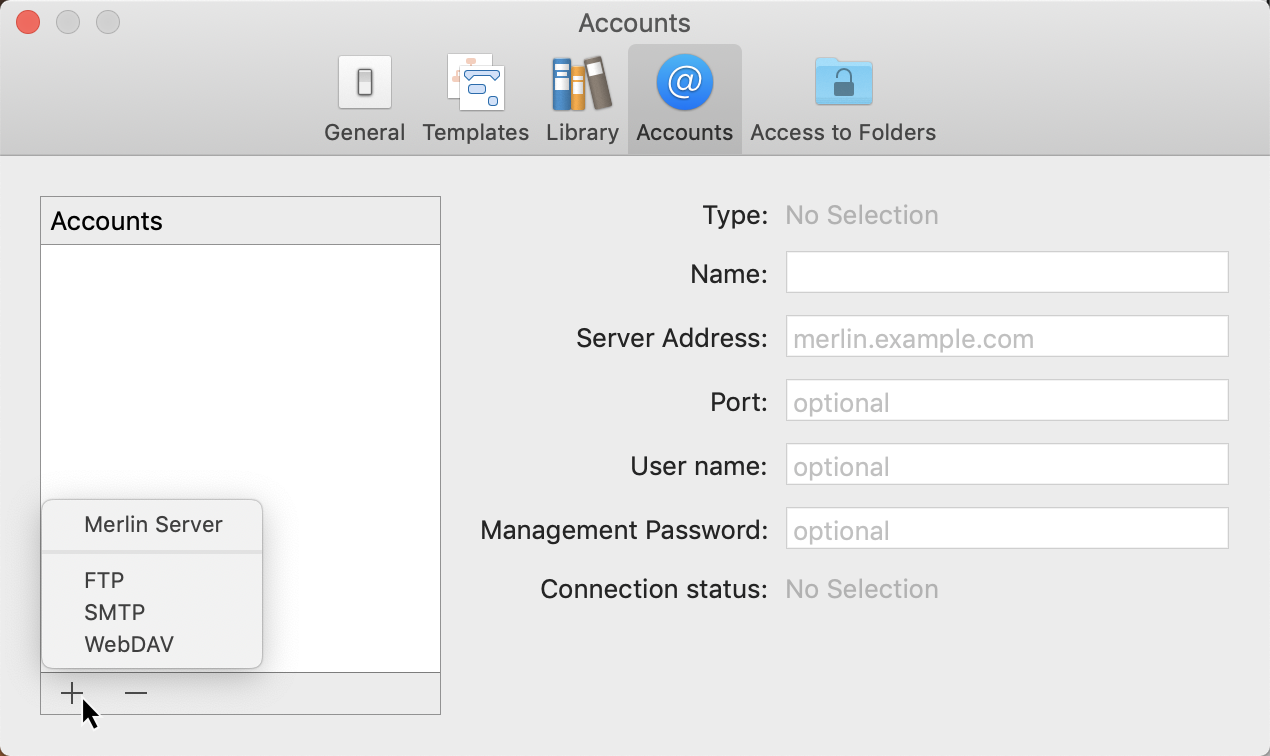
Click the »+« icon and then the server protocol to configure a new Account. Enter the particular server’s connection details on the right-hand side.
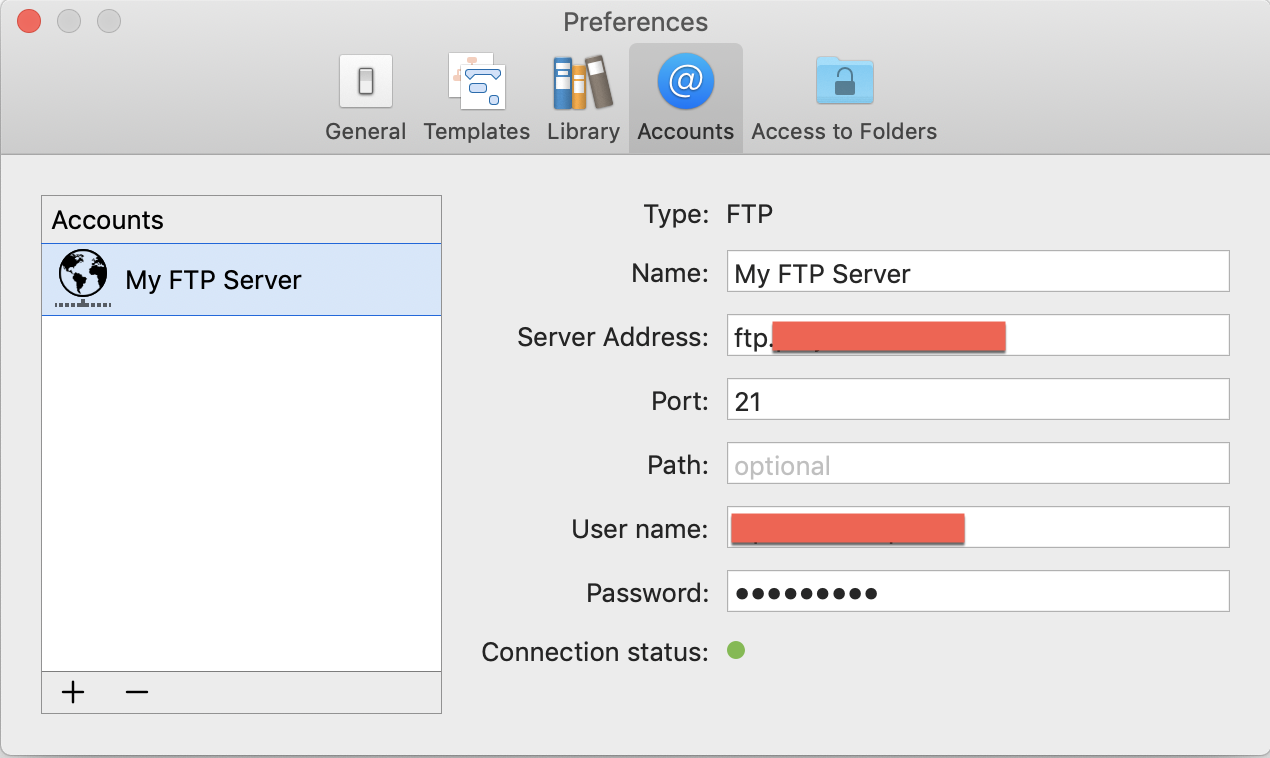
|
|
Here, an FTP server has been entered as an Account for use with Merlin Project and the Publishing export option. |
Preferences - Access to Folders
You can find the »Access to Folders« options under Preferences > Access to Folders.
This allows Merlin Project to sync documents from folders of Box Sync and resolve automatically conflicts which occur when working on the same documents with more than one users or devices.
You can insert folders manually or remove them as required.
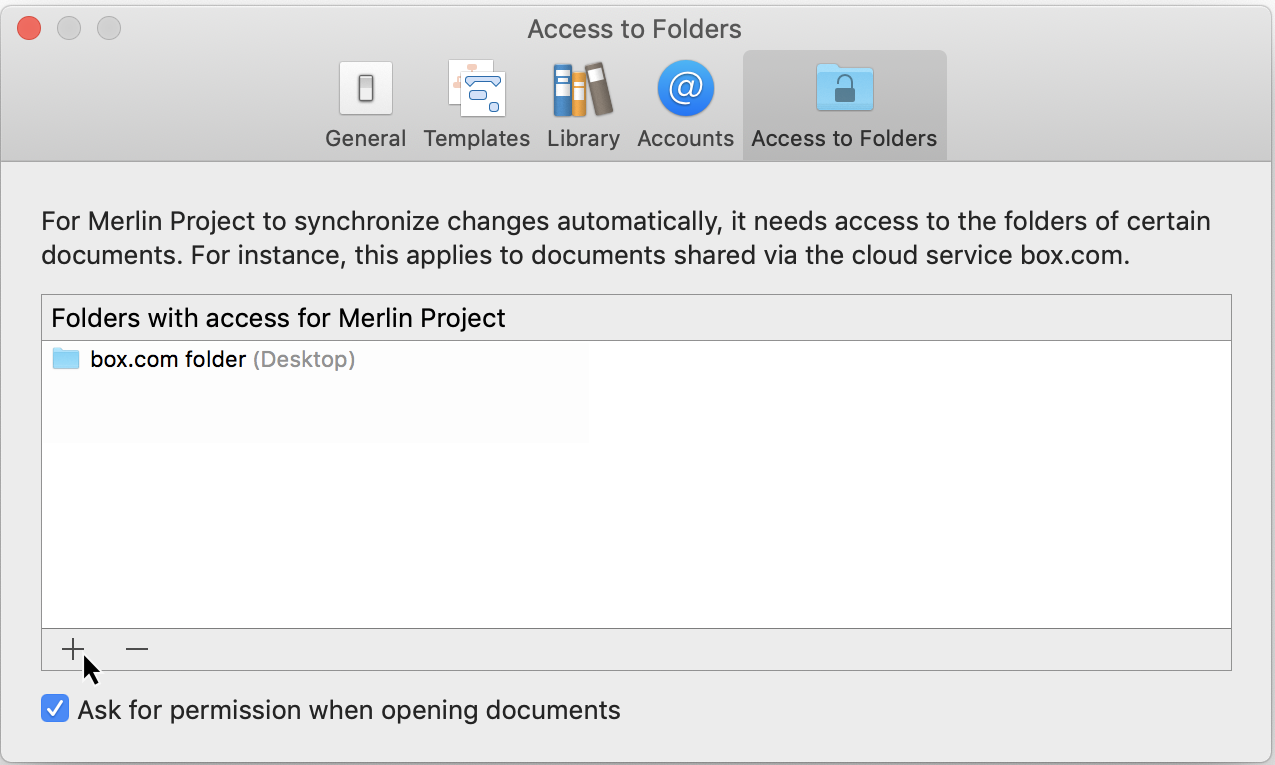
Click »+« or drag & drop folders into this area to grand access for Merlin Project.
Click »-« to remove an entry.
The "Ask for permission when opening documents" option displays a dialog when opening documents from Box Sync prompting to insert the document’s folder into the list of folders with access. You may confirm or choose to insert the folder manually later on.
By default the Ask for permission when opening documents option is enabled.
Save
File > Save…
The first time you save a document, you name it and choose where to save it—on your desktop or in a folder, for example.
Thereafter, Merlin Project automatically saves your document as you work.
-
Click anywhere in the document window to make it active
-
Choose 'File > Save'
-
Enter a name in the Save As field
-
Choose where to save the document
-
Click 'Save'
File > Duplicate…
You can duplicate an opened document. The copy is saved to the same location as the original.
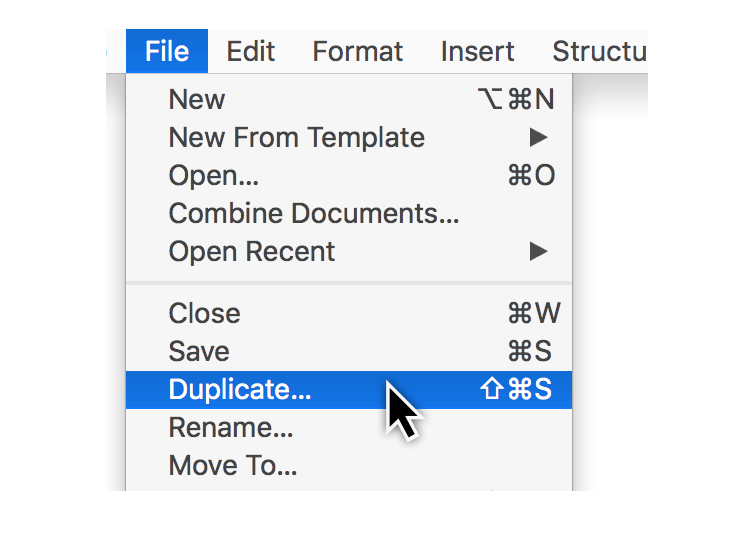
In Merlin Project you have two additional options:
Keep document history
Choose this option to create a duplicate with the same document history and be able to undo all your previous actions starting by document creation.
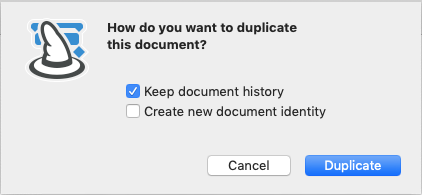
Create new document identity
Choose this option to remove document history in the duplicate and work in this document by a new identity. This would allow you to combine for example the old file with the new duplicate within master projects.
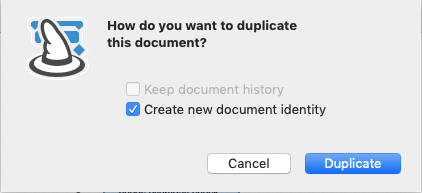
You can print from Merlin Project via the File → Print menu item. This uses the standard print dialog integrated into macOS. The Page Setup settings can be found there.
Print project content
The macOS print window has two views: One with fewer details and one with more details.
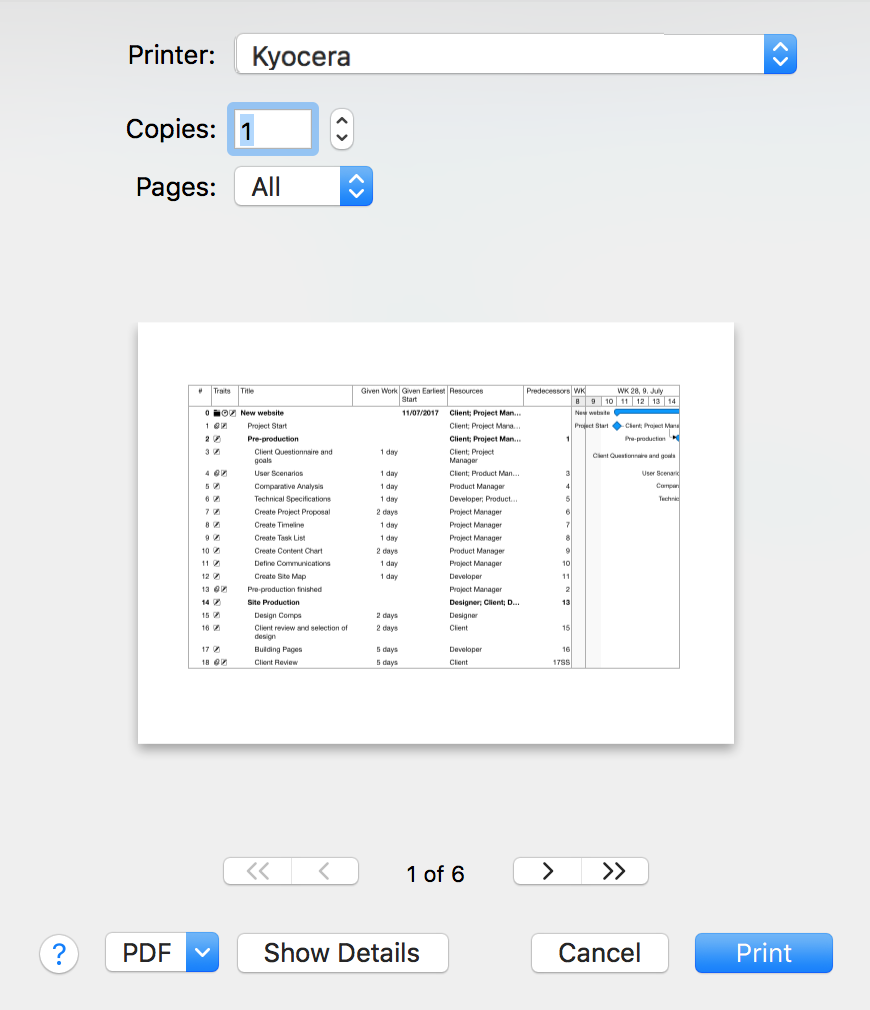
This basic view only offers a few options. Click the Show Details button. This opens the advanced print view. Here you will find the options described in the following.
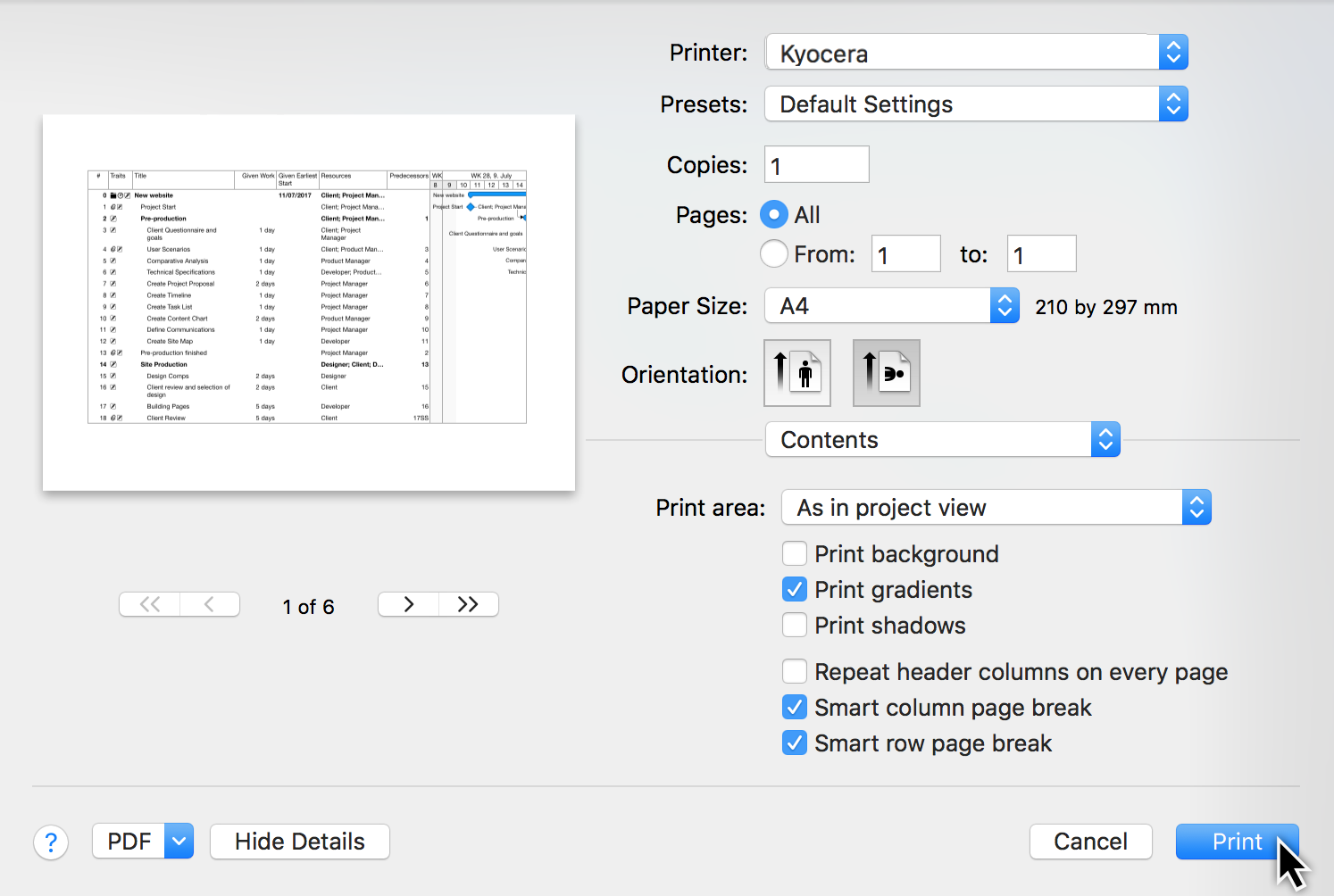
|
|
The page setup and orientation settings depend on the printer used. |
Content
The Content drop-down menu offers options for configuring the content to be printed.
For example, you can configure the print area:
-
As in project view
-
Outline and Gantt chart
-
Outline only
-
Gantt chart only
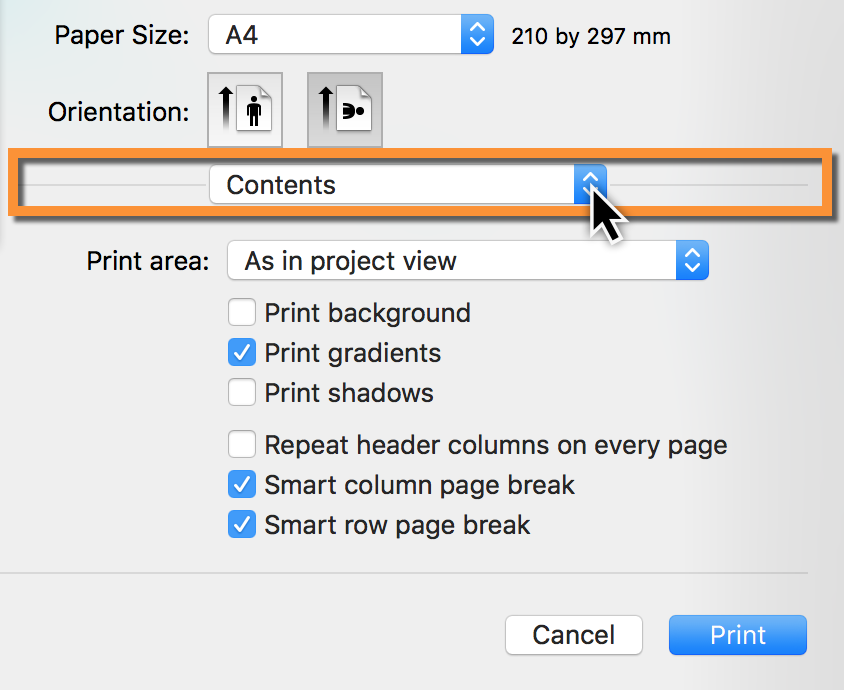
The other options control how the project is printed graphically:
-
Print background
-
Print gradients
-
Print shadow
-
Repeat header columns on every page (useful for printing over several pages)
-
Smart column page break (useful for printing over several pages)
-
Smart row page break (useful for a printout over several pages)
Scaling
Under Scaling you set the scaling of the project to the configured paper format. If you want to output a large project on A4 paper, it may come out looking very small.
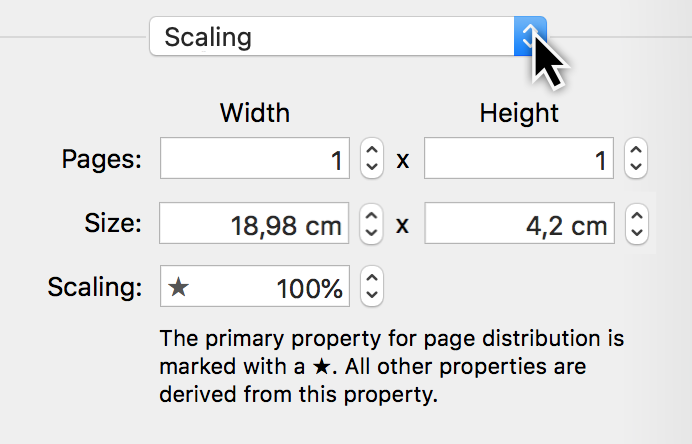
The number of pages, based on the width or height of the selected paper format, determines the size of the output.
|
|
If you set the width to one page, the project will be scaled to fit the width of the sheet. See the following section. |
Printing the project on a single sheet
Click the paper orientation option to select whether you want your project content printed in portrait or landscape format.
Then select Scaling from the drop-down menu. If, for instance, you have selected landscape, set the width to one page.
This resizes the entire project to fit the full width of one sheet.

|
|
This setting is marked with a star. All other values are derived from this setting. |
Header and Footer
The options for the header and footer offer a variety of settings. You will find pre-defined entries arranged at the bottom. The Format drop-down menu contains text formatting options.
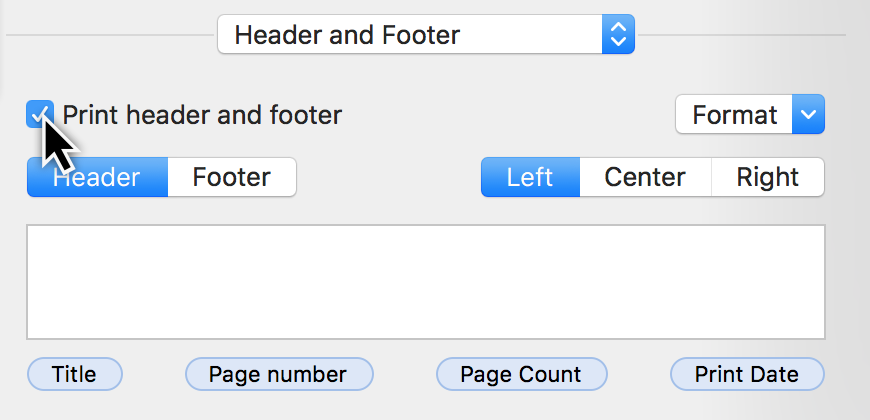
Select the information you want to appear in the header and footer, and select the alignment in the row (left, center, or right). Following that, you can drag & drop the entries in the field to move them around. You can also enter your own text to expand on the entries.
Borders
The Borders option can be used for headers and footers as well as a watermark.

Enlarge the borders if the header and footer as well as the watermark are covered when printing out project content.
|
|
The distance from the paper margin varies depending on the printer model. |
Watermark
The Watermark option lets you include a graphic in the printout. This allows you to include custom company logos in the printout.
The various options control the position, size, and opacity of the image in the printout.
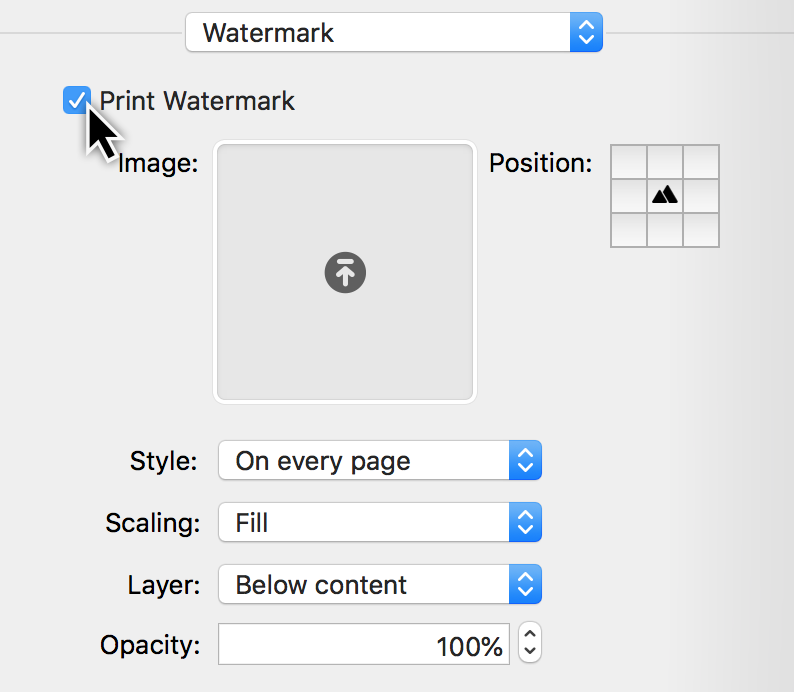
First tick the checkbox next to print watermark.
Then move a graphic file, which you want to use as a logo for the watermark, into the image field.
Next, set the position, style, scaling, layer, and opacity of the watermark.
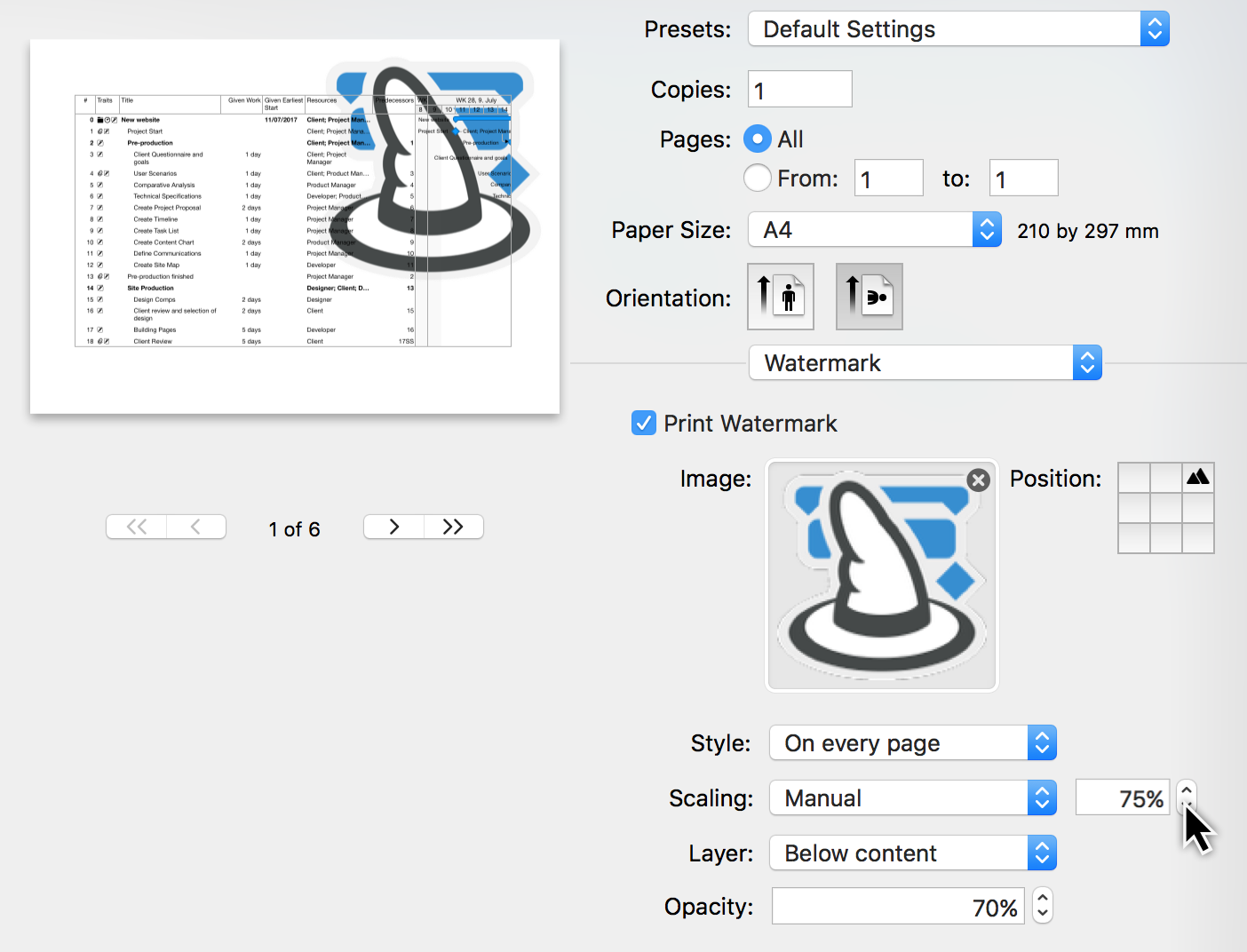
Set the scaling to manual, so that the size of the image can be changed in percentage terms.
In the mini preview you can see the result of the changes in real time.
|
|
Any graphic format supported by macOS and Preview can be used for the watermark (JPEG, GIF, TIFF, PNG and others). |
Printing PDFs
You can create PDF files quickly and easily via the print window.
Click the Show Details button. This opens the advanced print view. Configure the print options as necessary. Following that, click the PDF button on the bottom left.
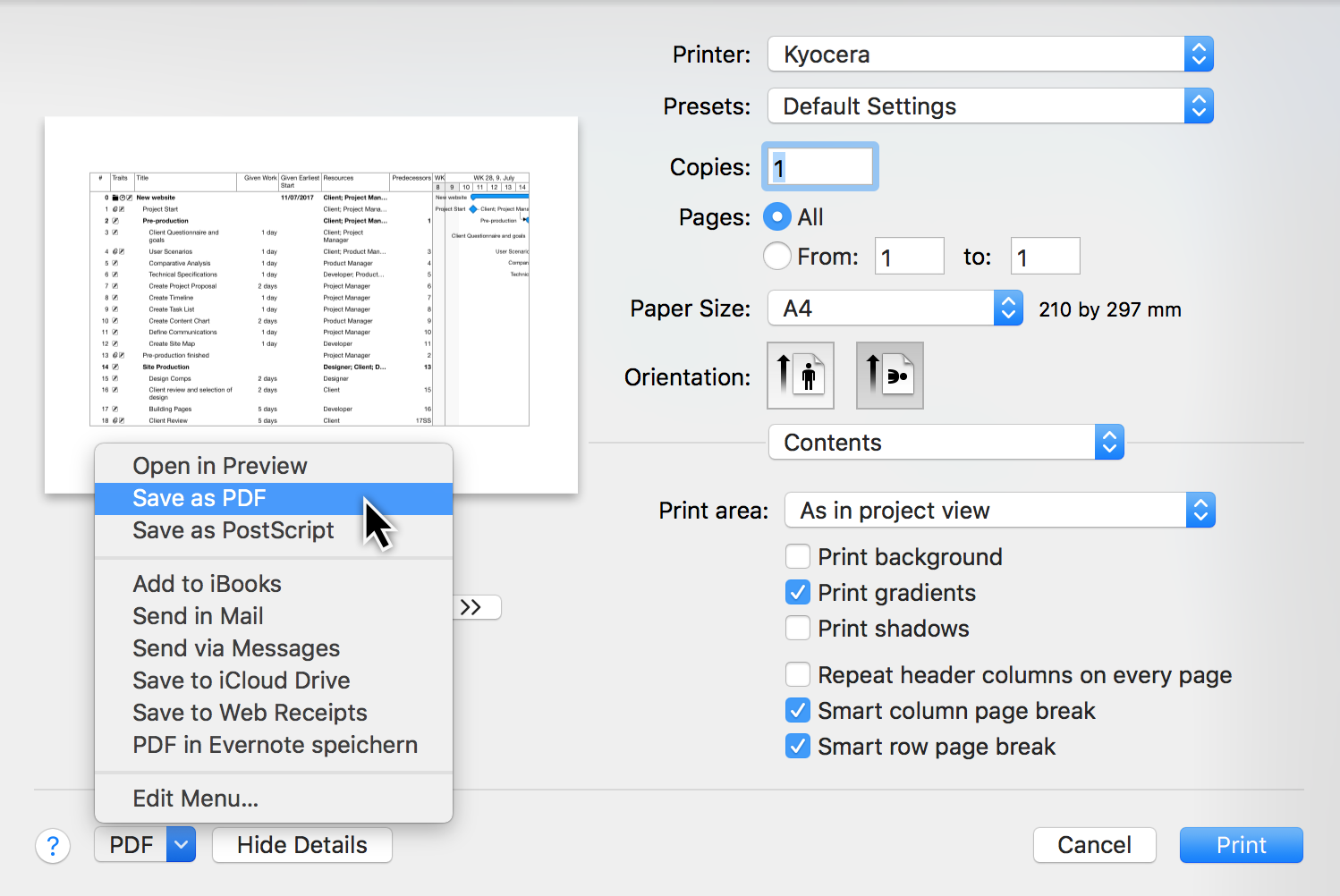
Click Save as PDF. The macOS Save dialog will open. Name the PDF file.
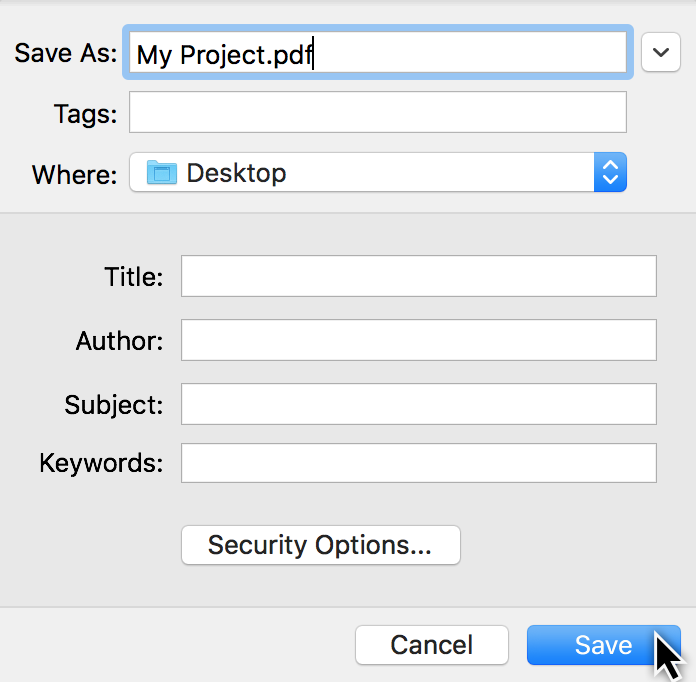
In addition, further options for creating the PDF file can be found here:
-
Tags (tags used in macOS Finder)
-
Title (document title)
-
Author (author and copyright holder of the document)
-
Subject
-
Keywords
|
|
These are optional settings that can be used if required. |
PDF security options
The Security Options… button gives you the option to password protect the PDF file and its contents.
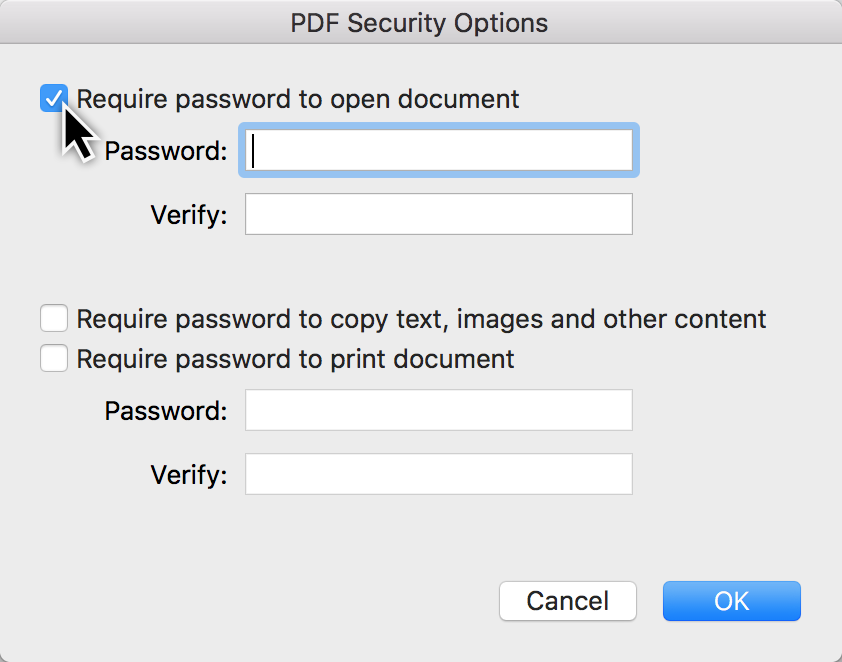
Export
Merlin Project can export in various file formats:
-
Text (recommended for exchange with EXCEL sheets)
-
Calendar (ics files)
-
Image (PDF, PNG, JPG, JPEG 2000, TIFF, BMP, GIF, all with watermarks and other settings)
-
OPML
-
Merlin Project XML
-
HTML
-
Microsoft Project (as MS Project XML)
-
Omniplan 2
-
MindManager / FreeMind / NovaMind 4 & NovaMind 5
To export, just select the menu item File → Export and the desired Format.
To export a single-sided PDF, select the menu item File → Export and click the Image format.
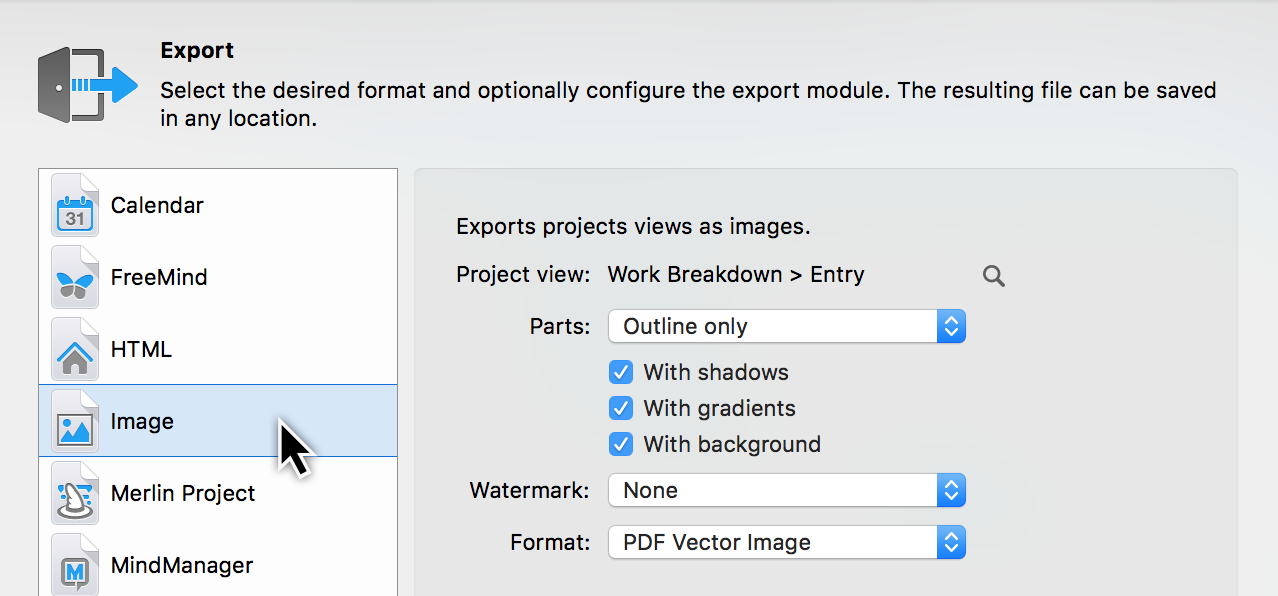
On the right-hand side you will see the settings for exporting the image.
-
Project view (click the magnifying glass to search for the project view for printing)
-
Parts (outline and Gantt chart or only one of the two ranges)
-
Watermark
-
Format (image format in our case PDF vector graphic )
Click the magnifying glass and specify which project view(s) should appear in the one-page PDF.
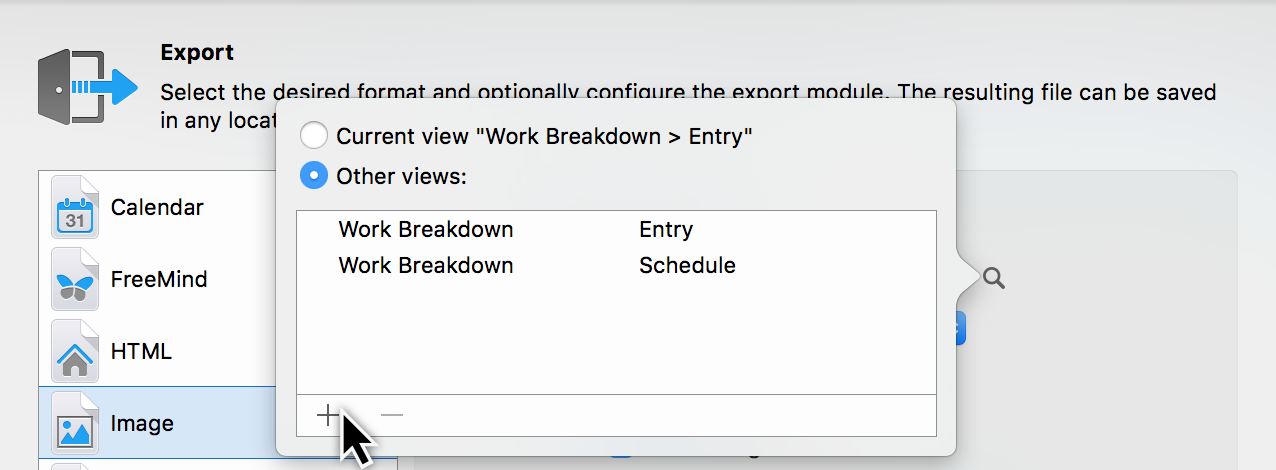
Add further project views by clicking the plus icon. Then click the entries in the list to set the views.
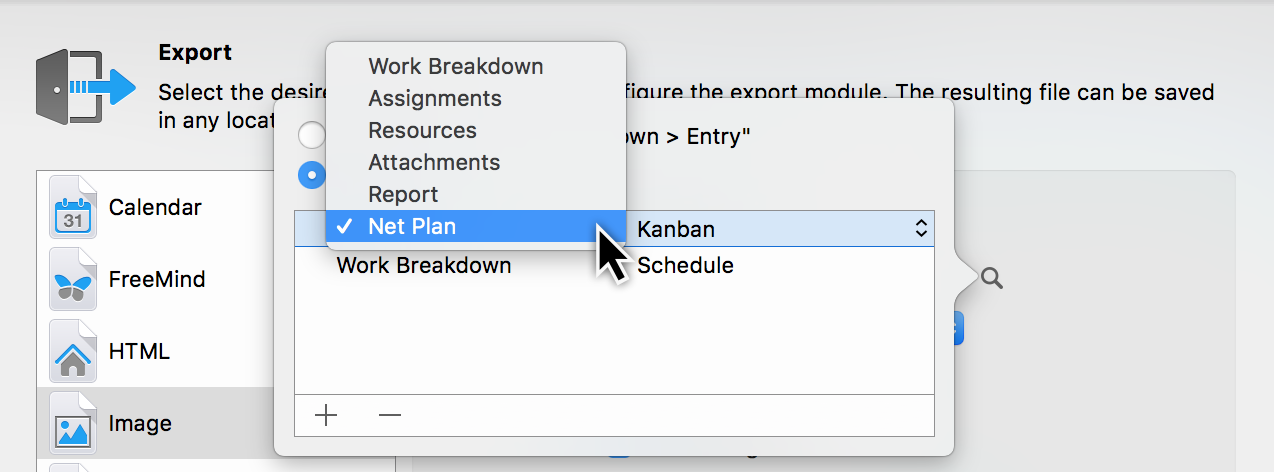
Specify which parts you want to export as a single-sided PDF.
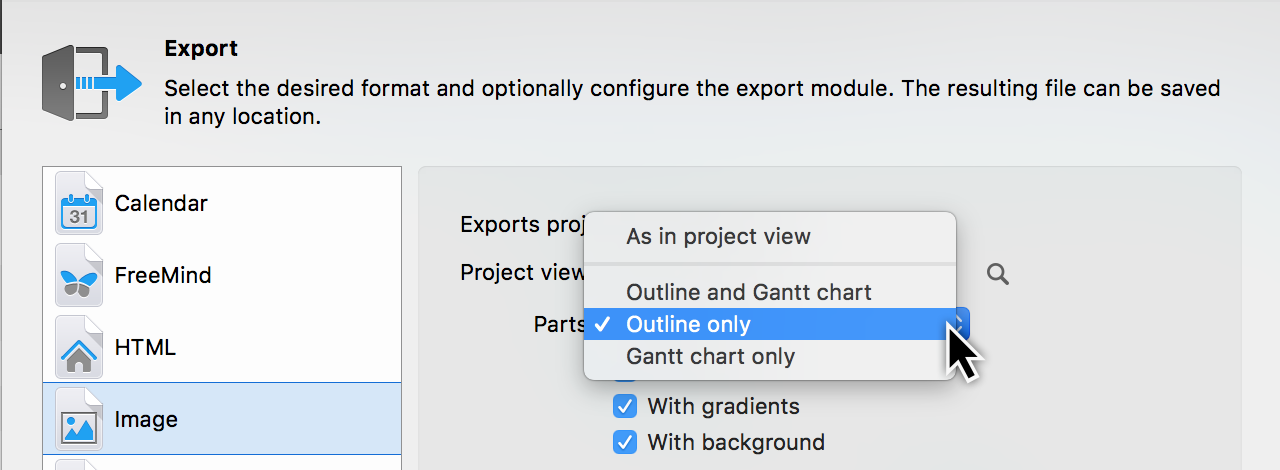
Further settings for modifying the PDF output can be found here.
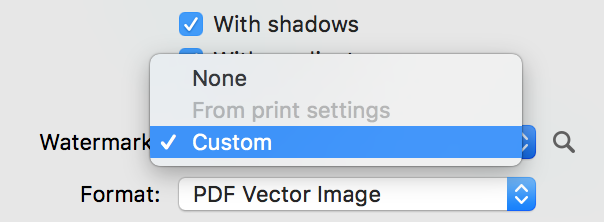
For instance, select the Watermark option to add a custom image to the PDF.
|
|
If a watermark is already used in the print settings of the project, it can be used directly. |
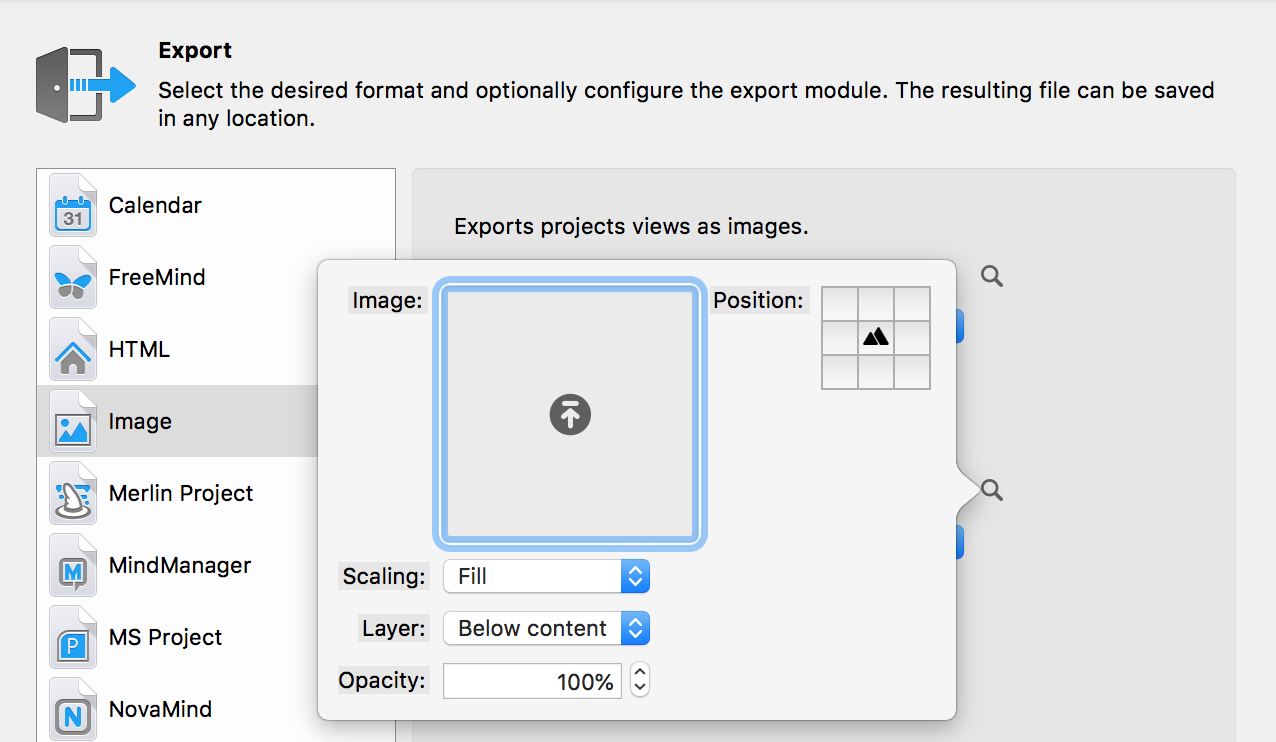
Click the magnifying glass and the settings for the watermark will appear.
Then click Next. In the dialog box, enter a filename for the PDF and select the desired storage location. Finally, click Export.
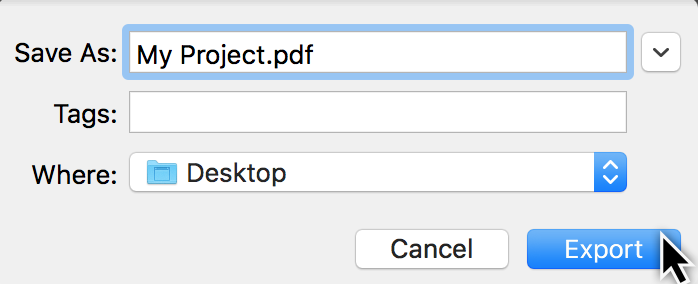
|
|
A single-sided PDF is suitable for forwarding the project to users with a large format printer. |
Mouse and keyboard
Both the mouse and keyboard are useful when using Merlin Project.
Many commands can be accessed directly and quickly with keyboard shortcuts; other tasks are accomplished easily using the mouse.

|
|
The keyboard shortcuts are displayed next to the commands in the menus. |
Mouse
The mouse is a device used to control the mouse pointer. For laptops, this can be the trackpad.
|
|
The latest Macs support a wide variety of input devices (mouse, trackpad, pen tablet, etc.). |
For videos explaining the different gestures you can use with mice and trackpads, go to System Preferences in macOS.
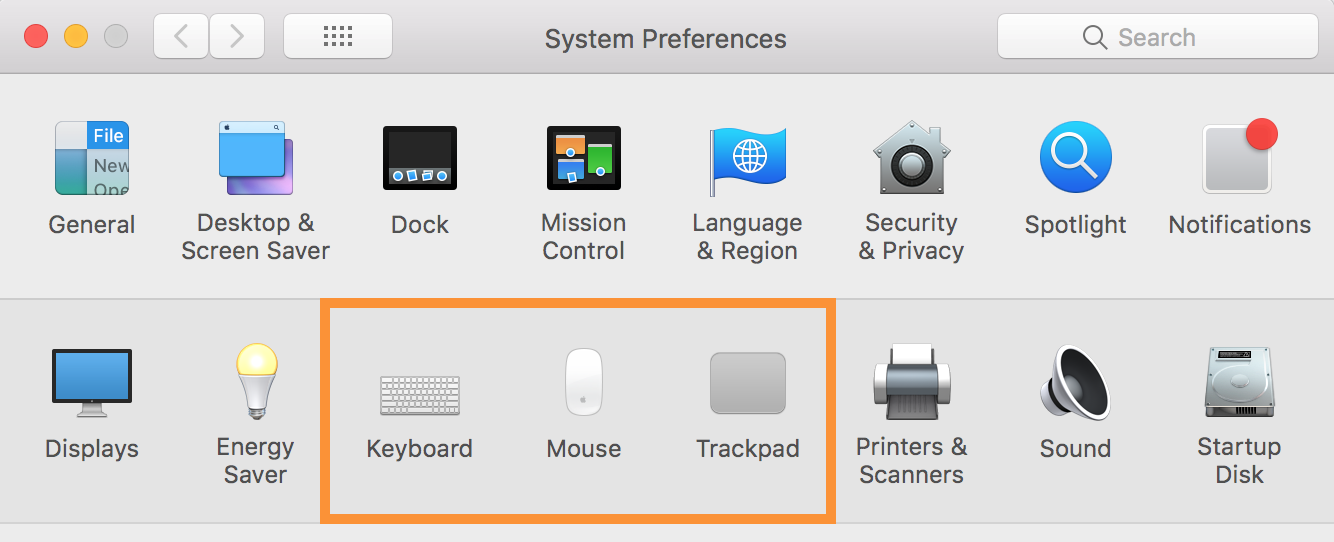
There you will also find options such as the secondary click (also known as the right-click in Windows).
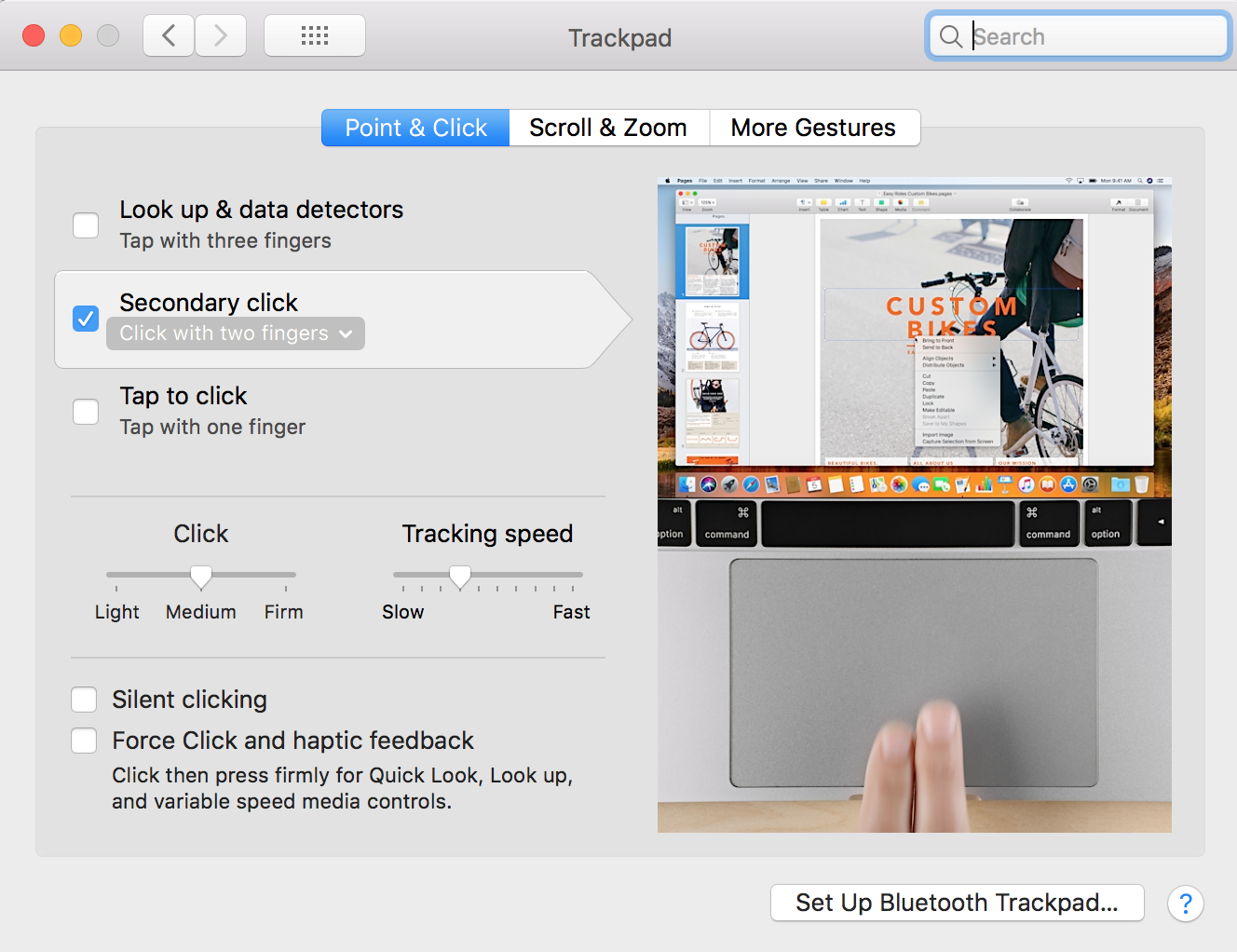
In System Preferences → Trackpad under the Point & Click tab you will find options for controlling the input gestures for your trackpad.
Context menus
Perform a secondary-click to open context menus in Merlin Project. This provides you with additional options for the clicked content.

Move (Drag & Drop)
You can drag & drop content using your input device. This lets you move content with ease.
|
|
This function lets you create new groups, arrange the sequence of project content in the Outline, assign resources to activities, and create attachments. |
The procedure is always the same:
-
Select object(s)
-
Move the selection while keeping the mouse button held depressed
-
Drop the selection over an object by releasing the mouse button
Creating a group using »drag & drop«
New groups are created using this technique in Merlin Project. You can drag several activities and drop them on another activity.
The activity the content is to be dropped on will be highlighted in blue. Once you release the mouse button it will turn into a group (bold) automatically and the activities will become its child activities (indented).
-
Click a selection and keep the mouse button held depressed
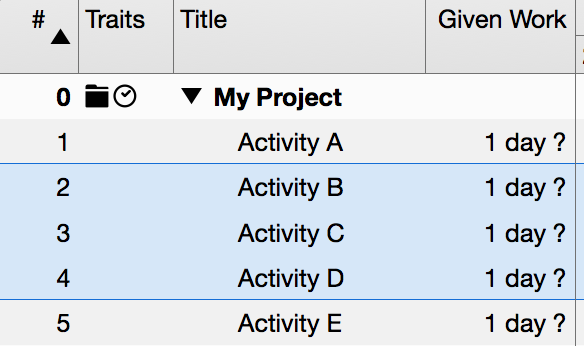
-
With the mouse button held depressed, drag the mouse pointer to an object - in this example an activity (don’t release the mouse button yet)
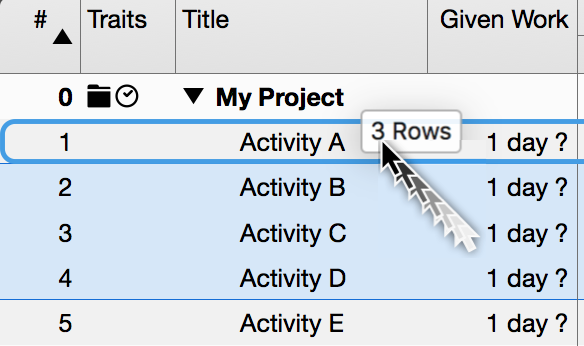
-
Release the mouse button to drop the selection
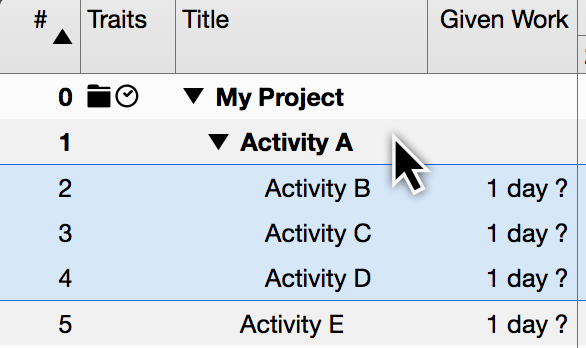
Changing the project structure sequence
In Merlin Project, you can re-sort the sequence of activities, groups, and milestones. To do so, drag several activities and drop them between other activities.
When doing this, blue line with a circle appears to mark the position between the content.
-
Click a selection and keep the mouse button held depressed
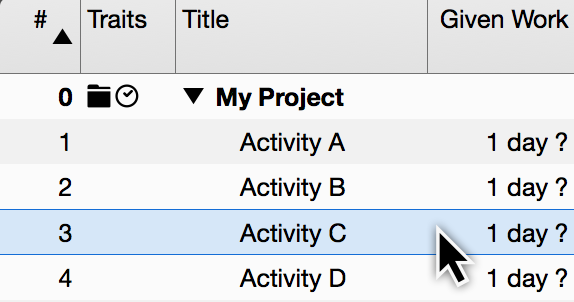
-
Move the mouse pointer between two objects, in this example between "Activity A" and "Activity B", with the mouse button held depressed (do not release the mouse button yet)
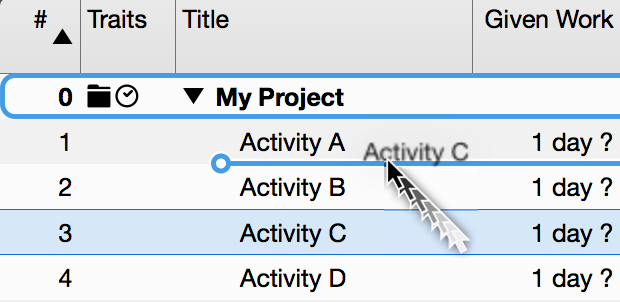
-
Release the mouse button to drop the selection
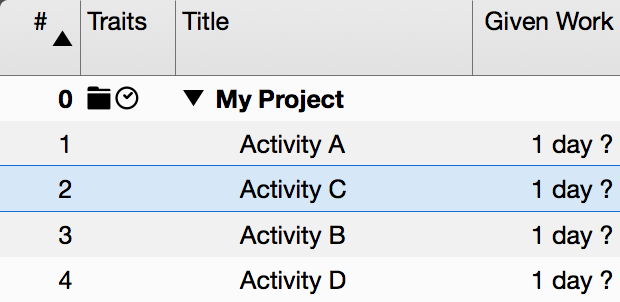
Activity C now appears between Activity A and Activity B.
Keyboard
The following keys are the important ones on a Mac for using keyboard shortcuts.
Important keys
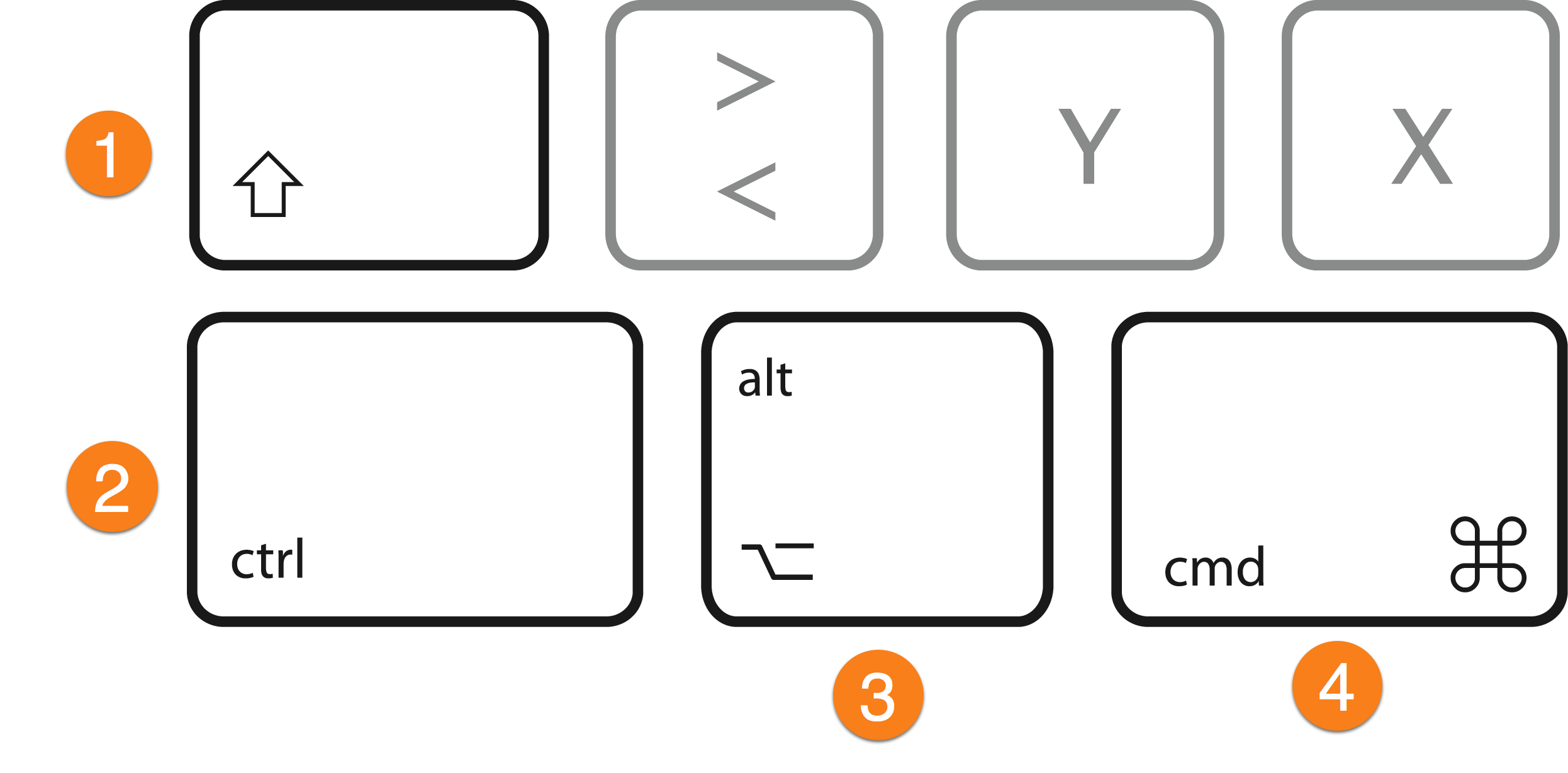
-
Shift key (shift) → upper-case key
-
Control key (control) → corresponds to Ctrl.
-
Option key (option) → corresponds to Alt/Alt Gr
-
Command (command) → corresponds to Windows
|
|
In the menus, the ctrl key is represented by the ^ icon. |
The command key is abbreviated to cmd.
For instance, the Enter/Exit Full Screen option under the menu item Window is controlled using the keyboard shortcut ctrl + cmd + F.
To edit content, the following keys are especially useful.
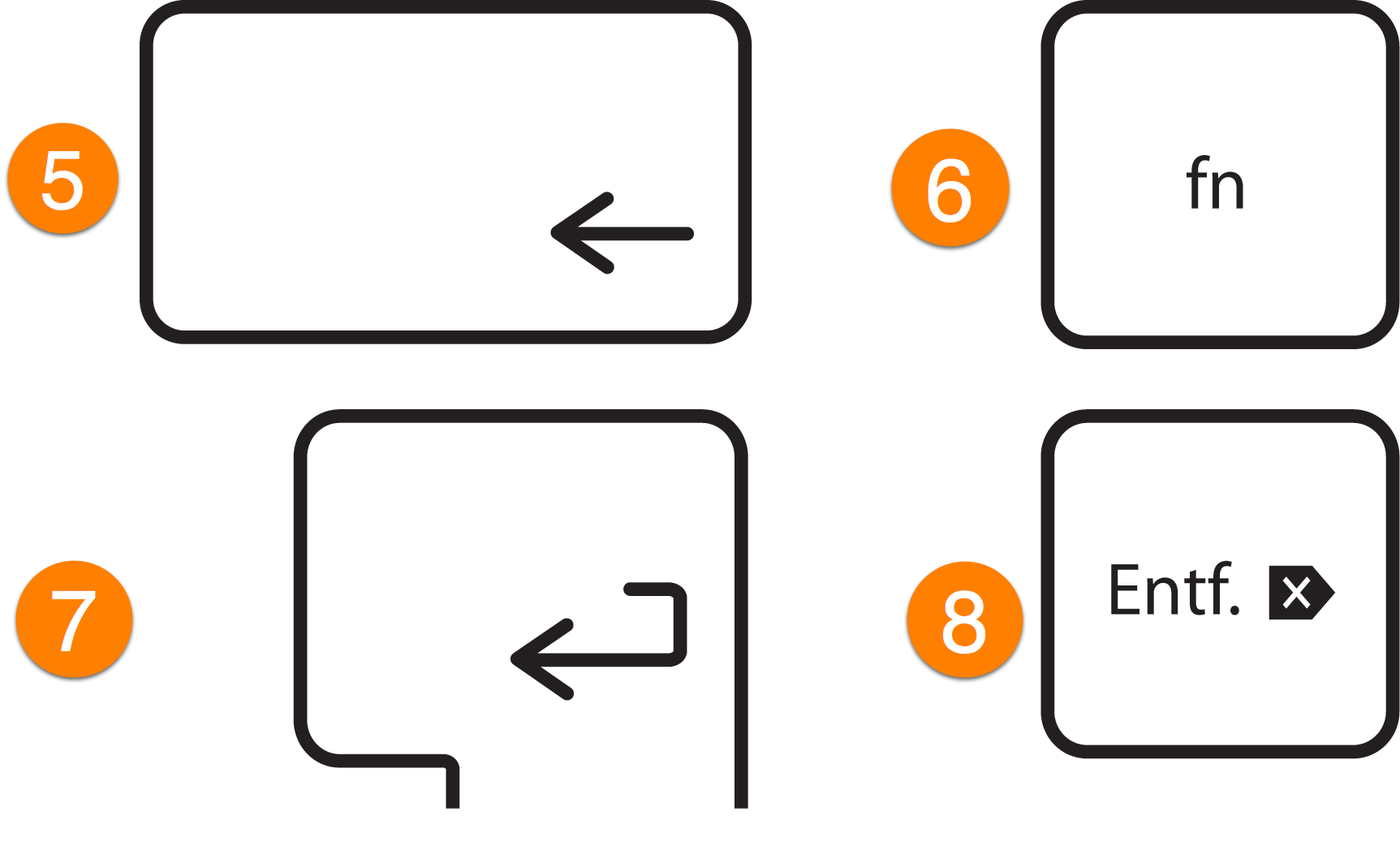
1.Delete key (backspace) → backspace key 2. Function key → (Function) → no corresponding key with Windows 3. Enter (Return) → Enter 4. Delete (Delete) → DEL
Keyboard shortcuts
Merlin Project uses a host of keyboard shortcuts.
Keyboard shortcuts consist of several keys pressed simultaneously, for example, saving projects is performed with cmd + S. F keys (F1,F2, etc.) are available on all newer Apple keyboards using the fn function key.

Most menu entries are provided with the corresponding keyboard shortcuts. They are located directly next to the individual menu entries. This lets you access these menu entries quickly and easily using the keyboard.
Scroll bars
Scroll bars are used to move the visible area in the program window.
System settings
|
|
The scroll bars and their behavior are controlled by the operating system. By default, scroll bars are only displayed in macOS when scrolling. |
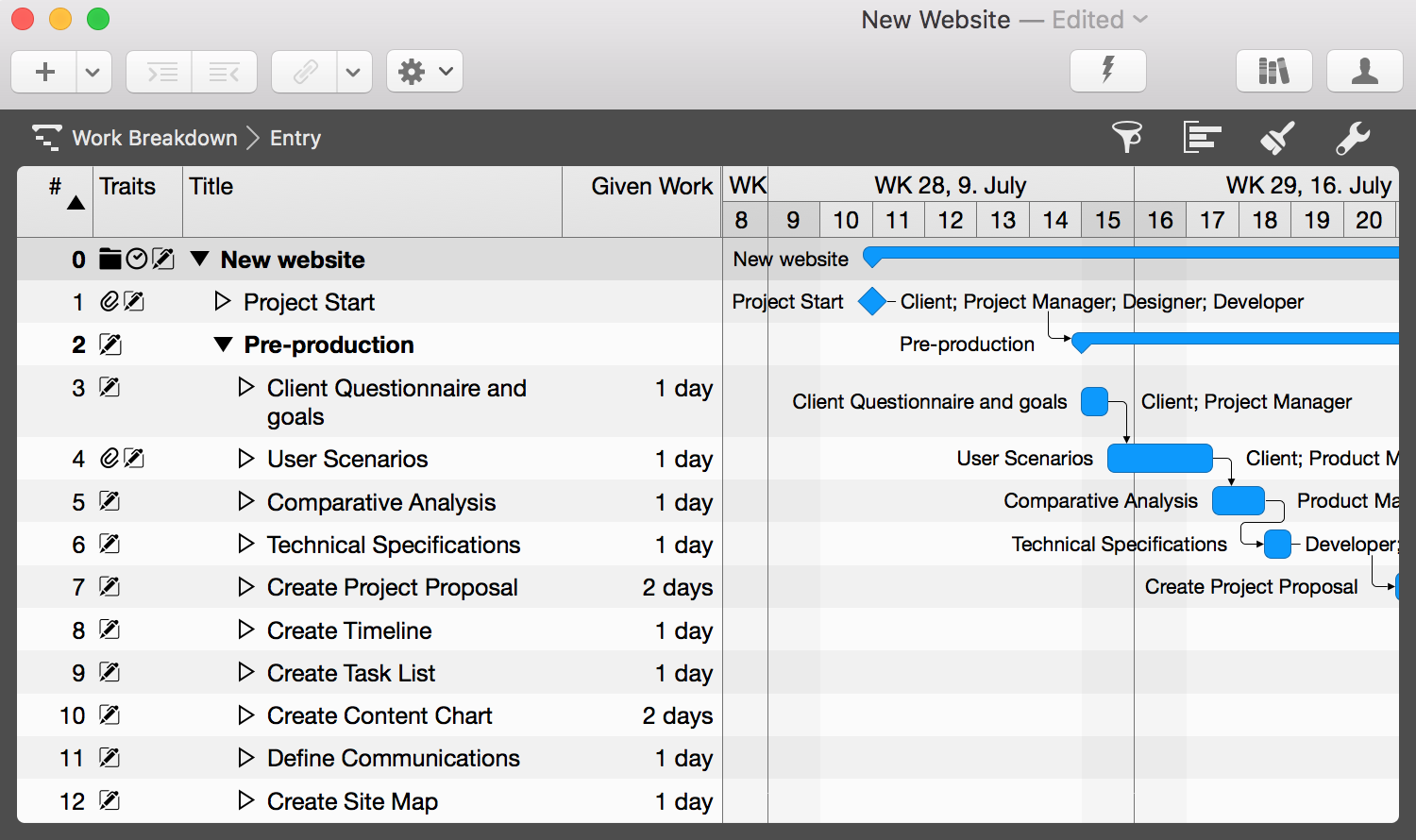
The content in the different views of Merlin Project can be moved around the visible section using input devices such as a mouse or a touchpad. The scroll bars only appear when scrolling.
|
|
With the Apple Magic Mouse and the Apple Trackpad, you can watch short animated guides to using gestures to move content under System Preferences → Mouse and System Preferences → Trackpad. |
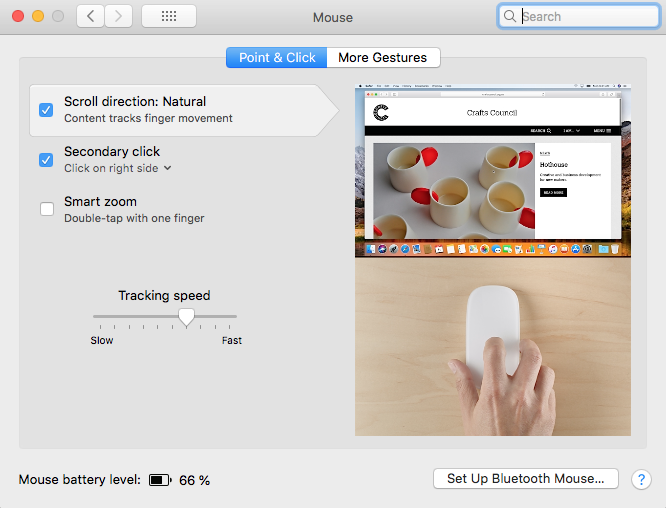
Displaying the scroll bars
Open the System Preferences in macOS and click the General icon. There you will find the options for displaying scroll bars when scrolling.
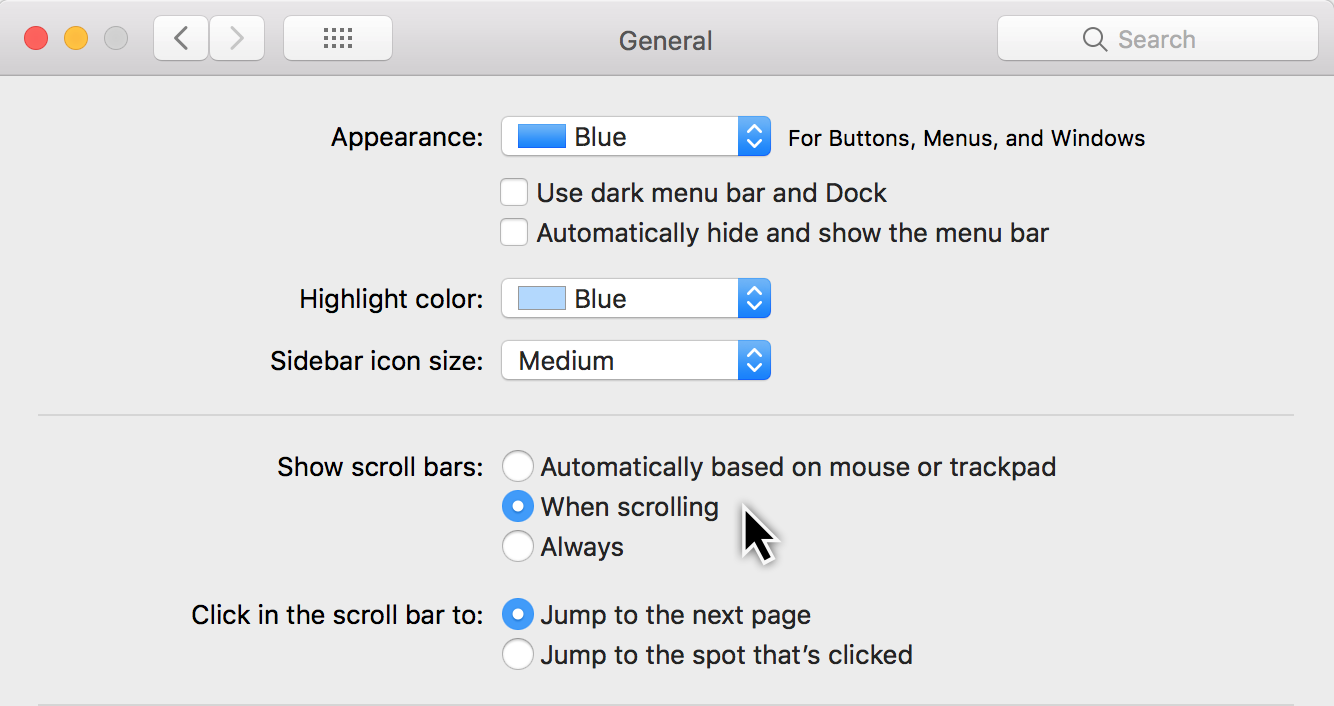
The three options for scrolling using the scroll bars are system-wide and apply to all programs used.
-
Automatically based on mouse or trackpad
-
When scrolling
-
Always
If you select Always, the scroll bars will then always appear in Merlin Project and in all other programs.
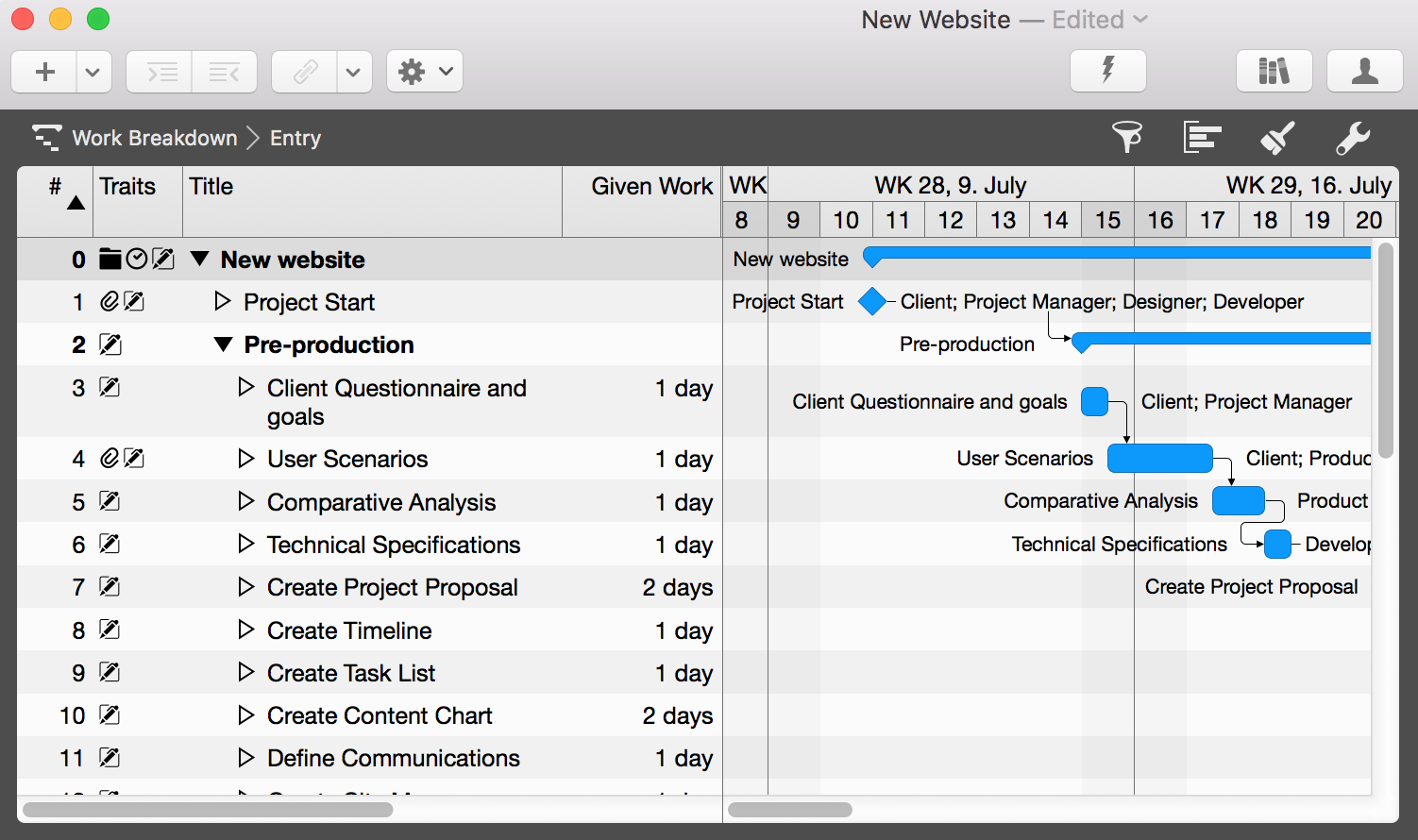
Advanced Topics…
Subscribe projects
Do you have a Merlin Server installation and shared projects there? In this case, you have to subscribe to these Merlin Server projects first to be able to open and edit them in Merlin Project.
Just call File > Merlin Server > Documents.
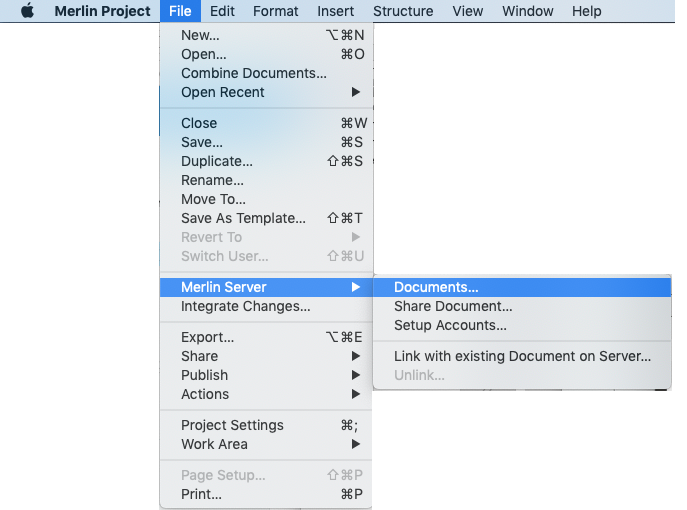
If a Merlin Server is active in your LAN, it will be detected via Bonjour and automatically displayed. Otherwise, you should create a Merlin Server account. Select the required file and subscribe to a get a local copy.
|
|
Subscribed copies should be stored in a directory on your local hard drive and not in Google Drive, Dropbox or other cloud services. |
You will then be working with the local copy of the subscribed file. There is no need to re-subscribe to the file.
Share documents
You have prepared a project file and want to share it on your Merlin Server? If the administrator of your Merlin Server agreed to give you the remote management password, go to File > Merlin Server > Share Document , click on 'Share' and enter the password.
|
|
Without the remote management password, you must provide the document to the administrator of your Merlin Server installation, who will add it to the Server documents via the Merlin Server program’s user interface. |
Synchronization notes
Whenever you save the project file using cmd+S or when the project file is saved automatically, changes are synchronized with the project file on Merlin Server. If the device on which Subscribe projects is installed has temporarily no connection to Merlin Server (because the device or Merlin Server are offline or Merlin Server is currently not accessible via the Internet), the changes will be saved locally and synchronized the next time Merlin Server is successfully accessed (for example when the Mac returns and logs into the same LAN).
When synchronizing, the local file sends the locally saved changes to the server and receives changes made by other users from the server.
|
|
If you do not want your local copy to be synchronized with the server anymore, e.g. if you need a backup of its current state, click File > Merlin Server > Unlink. |
A thus decoupled file can be synchronized with the server again if you call File > Merlin Server > Link with existing Document on Server.
Finance
Merlin Project offers you finance options for your project. Every activity, milestone, activity group or assignment can be assigned a budget and base costs.
The easiest way to do this is to use the Finance tab in the Inspector.
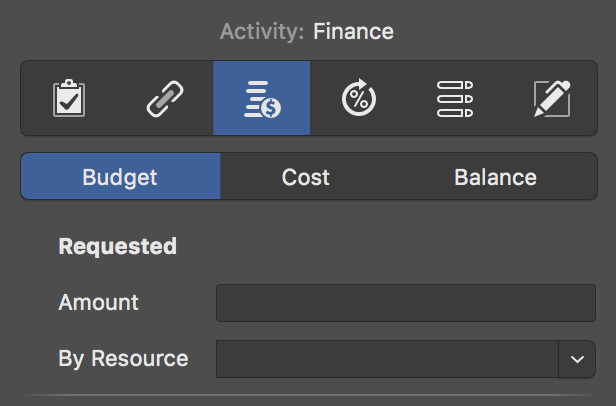
There you will find three more tabs:
Budget
Budget means money that is available for the project.
Select an activity, milestone, or assignment and then click the Finance → Budget tab in the inspector. Here you can enter all budget information in the fields provided.
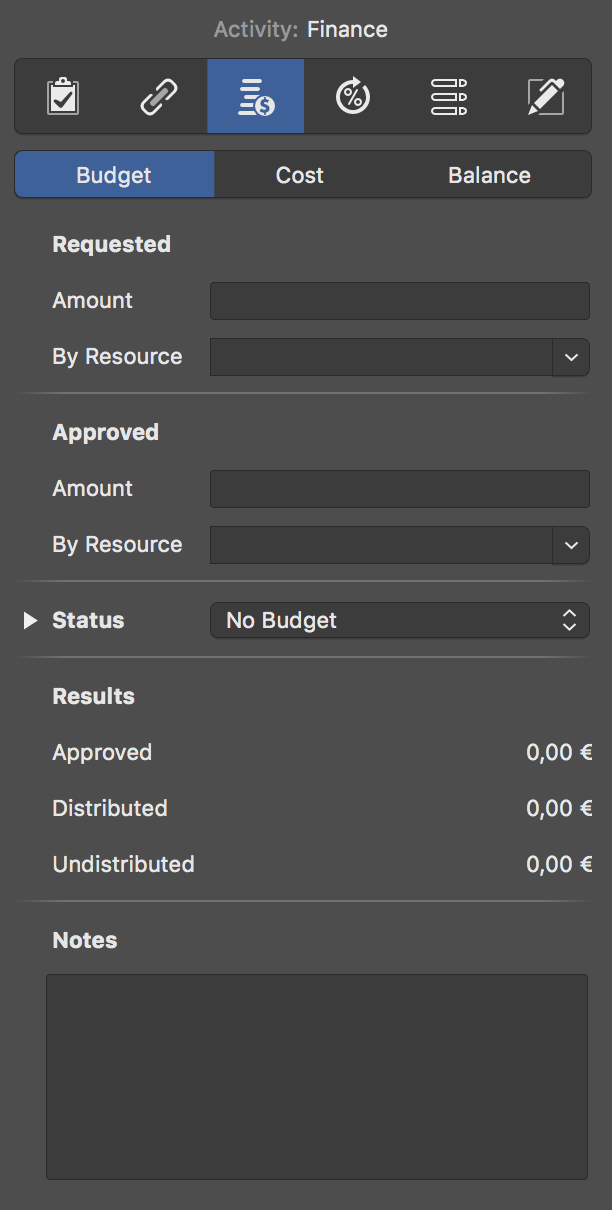
|
|
If you do not have a budget and would like to record base costs in your project, use the tab Finance → Cost. |
Cost
In the tab Finance > Cost you can enter base costs for the selection.
|
|
Base Costs are fixed costs that arise during planning and execution of the project and add up to existing work costs or attachment cost. |
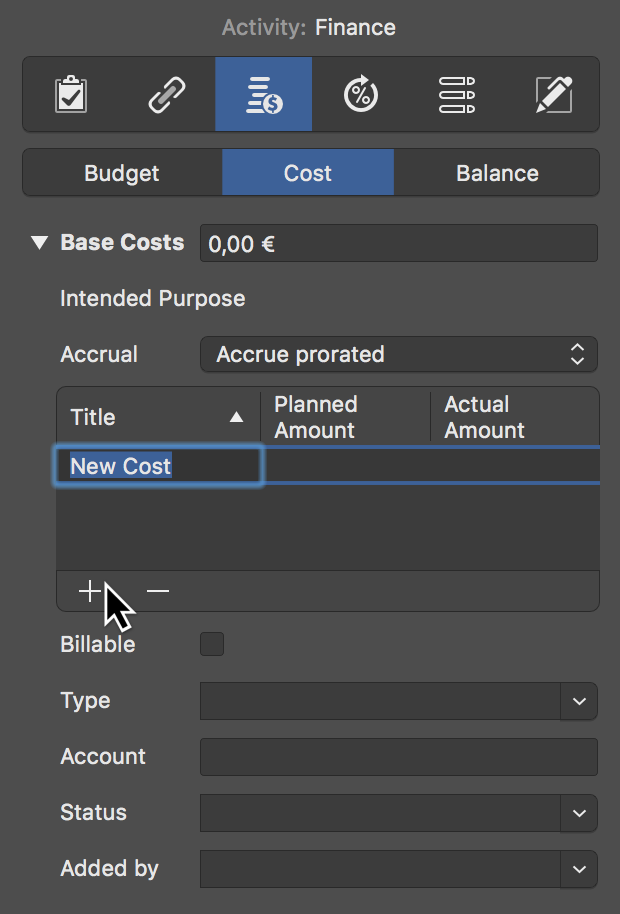
If you have several cost items, first click the triangle next to Base Costs and create new entries one after the other by clicking the + icon. Merlin Project will then add up the individual cost items automatically. The Base Costs field lists the total of all cost items.
You can select one of the possible accruals:
Accrue immediately
Basic costs with Accrue immediately appear immediately and in total in the Actual Base Costs.
Accrue at start
Basic costs with Accrue at start appear in total in the Actual Base Costs but only from the moment on when there is actual progress.
Accrue prorated
Base costs with Accrue prorated appear pro rata to the actual progress in the Actual Base Costs.
Accrue at end
Base costs with Accrue at end appear in total in the Actual Base Costs but only from the moment there is a 100% completion.
Balance
Under the Finance → Balance tab you will find an overview of cost values listed by Expected, Planned, and Actual.
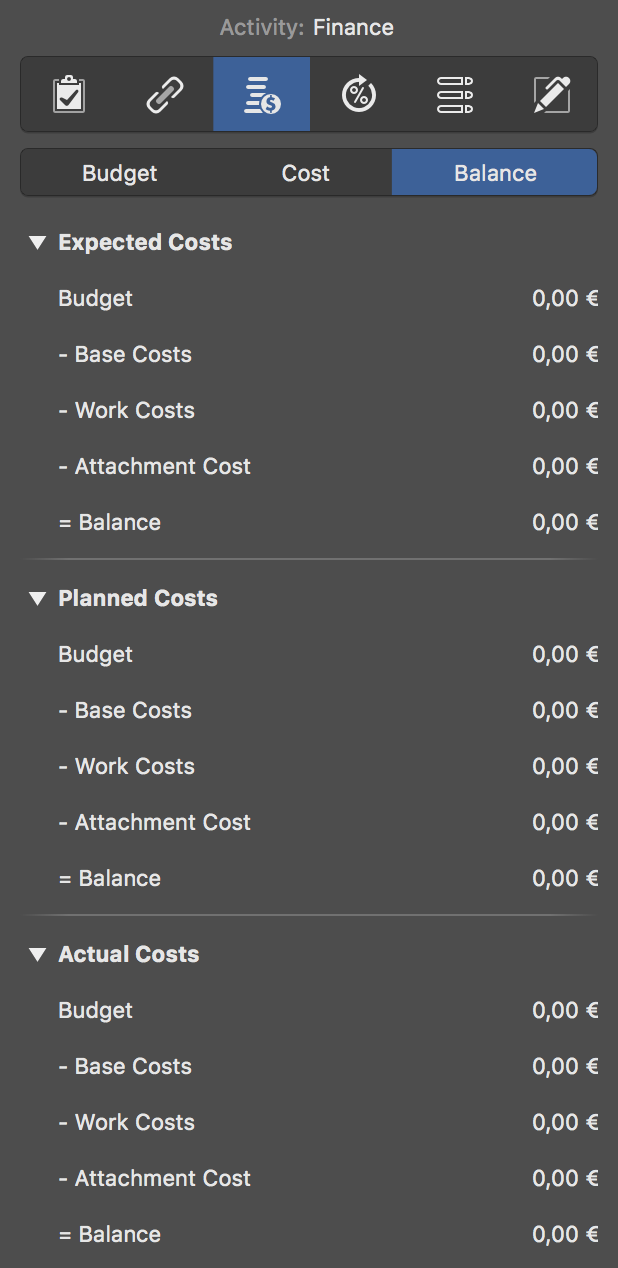
|
|
Select the project in row #0 and go to Finance → Balance in the Inspector. You will see the total Planned, Expected and Actual Costs of your project. |
Work costs
Work costs are costs generated by work from resources allocated to the activity.
A resource can have following cost information:
-
Standard Rate
-
Overtime Rate
-
Base Costs
|
|
Enter cost information for your resources in a Resources or Assignments view in the Cost inspector. |
Attachment cost
Attachment cost are costs due to base costs on attachments.
|
|
Enter the basic costs of your attachments in an Attachments view in the Cost inspector. |
Cost views
In Merlin Project you’ll find following pre-configured cost views:
-
Work Breakdown > Budgeting
-
Work Breakdown > Cost Expectation
-
Work Breakdown > Cost Planning
-
Work Breakdown > Plan/Actual Comparison (Cost)
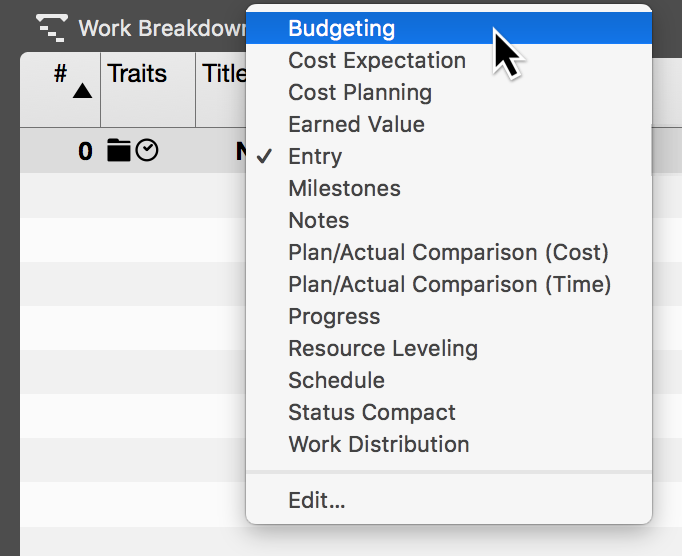
-
Assignments > Cost Expectation
-
Assignments > Cost Planning
-
Assignments > Plan/Actual Comparison (Cost)
-
Resources > Cost
They contain column sets that give you an overview of the costs for individual groups, activities, milestones, assignments or resources.
|
|
Go to one of the many cost views for quick access to budget information in the project. |
Kanban
This guide contains information about the Kanban system in Merlin Project.
Kanban is a Japanese term and has a wide range of meanings such as card, board or document.
What is Kanban?
Alongside Scrum, Kanban is one of the most widely used methods in project management.
It was originally developed for production management, meanwhile the agile method is now also used widely in project management.
The use of Kanban offers improved utilization, higher transparency, and faster iterations during the project.
Kanban principle
The Kanban system is based on cards that can be moved from left to right in column rows along a board.
Every to do is noted on a card. Depending on the processing status, a card moves along the board from left to right until it is completed.
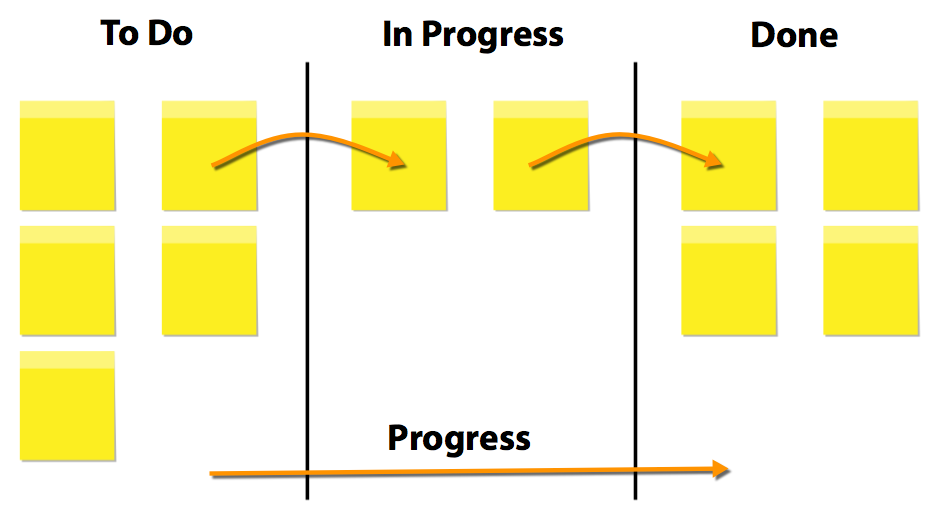
In moving along the columns, the cards are given a defined status. As the project progresses, an increasing number of cards move from left to right.
Columns in Kanban
In the simplest Kanban system, the Kanban board is split into three columns. The cards always move from left to right.
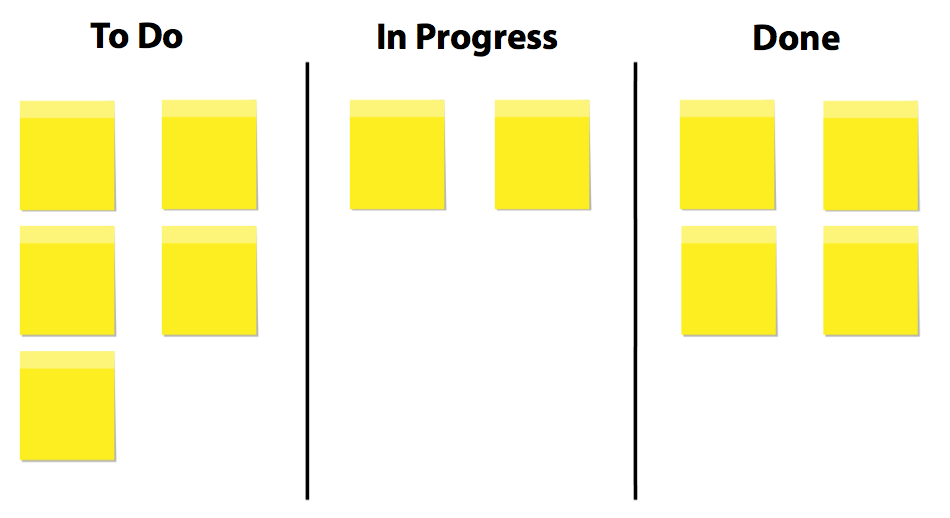
To Do: In the left-hand column, to dos are entered that have not been worked on yet. These to dos are planned and are to be worked on soon.
In Progress/Doing: As soon as work starts on a to do, its card is moved to the center column. The card remains in this column while being worked on.
Done: Once the to do is done, the card moves to the right-hand column. This means that the to do has been completed successfully.
Kanban in Merlin Project
Merlin Project lets you plan using traditional and agile project management methods, and to switch between them or even use both simultaneously whenever you want.
The progress and thus the status between the traditional and agile planning method views is updated automatically. This unique function lets you work flexibly and plan using different methods.
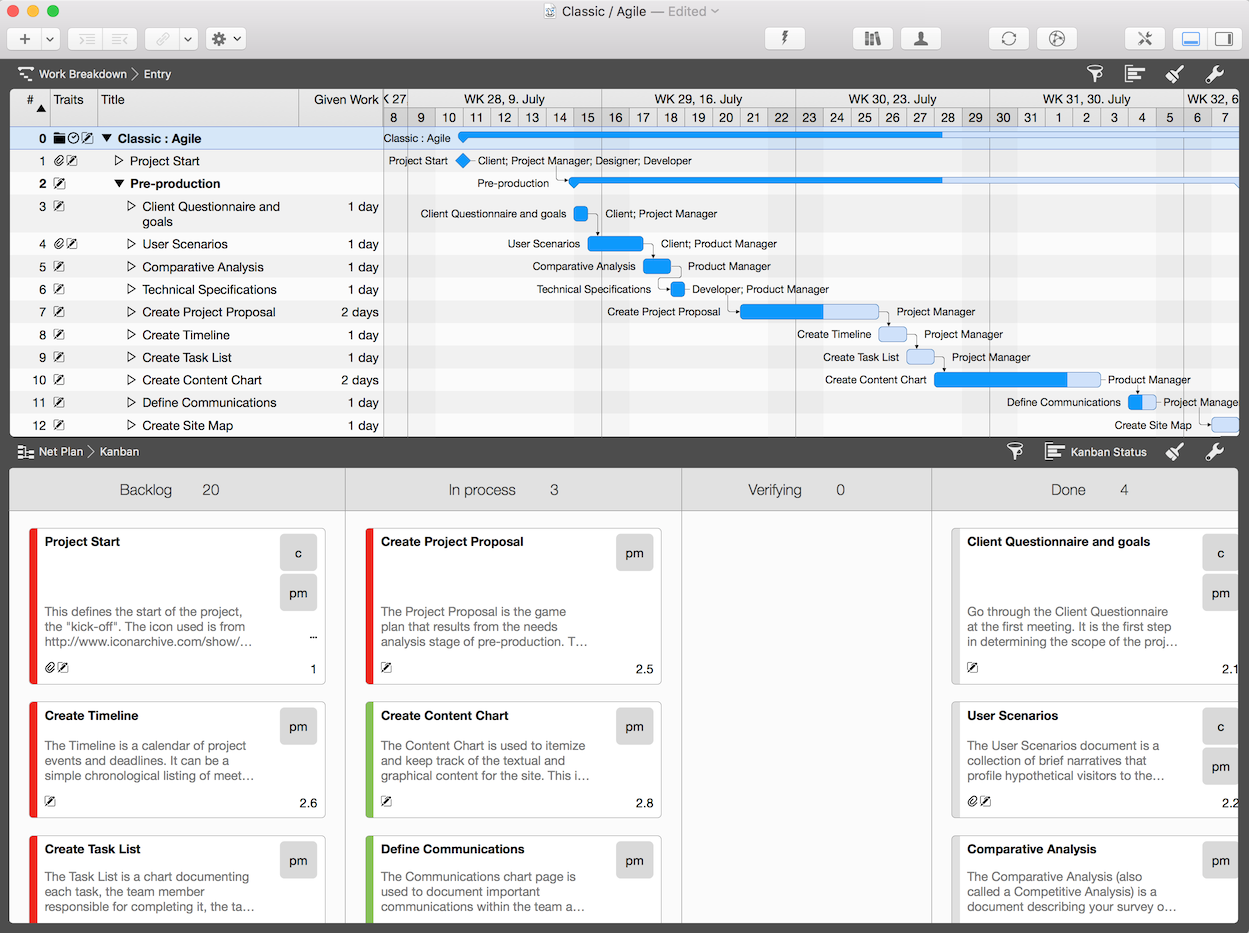
The boundaries between agile and traditional project management have finally vanished with the introduction of Merlin Project.
|
|
You can switch whenever you want between the traditional Work Breakdown > Entry and Net Plan > Kanban view. Activate the secondary project view for a simultaneous overview of both methods. |
Choose between two Kanban display modes in Merlin Project: Traditional and Compact. For the compact view, from the Net Plan drop-down menu select the Kanban Compact view.

Using the Kanban view
Kanban offers a very flexible approach to working with projects. Read on to learn how you can get off to a quick start with Kanban in Merlin Project.
Open a new or existing project. To do so, click File > Open or use the keyboard shortcut cmd + O.
To create a new project, click File > New or use the keyboard shortcut alt + cmd + N.
Change from the Work Breakdown > Entry view to the Net Plan > Kanban view.

|
|
You can switch quickly between views using the View menu. Just click View > Net Plan > Kanban. |
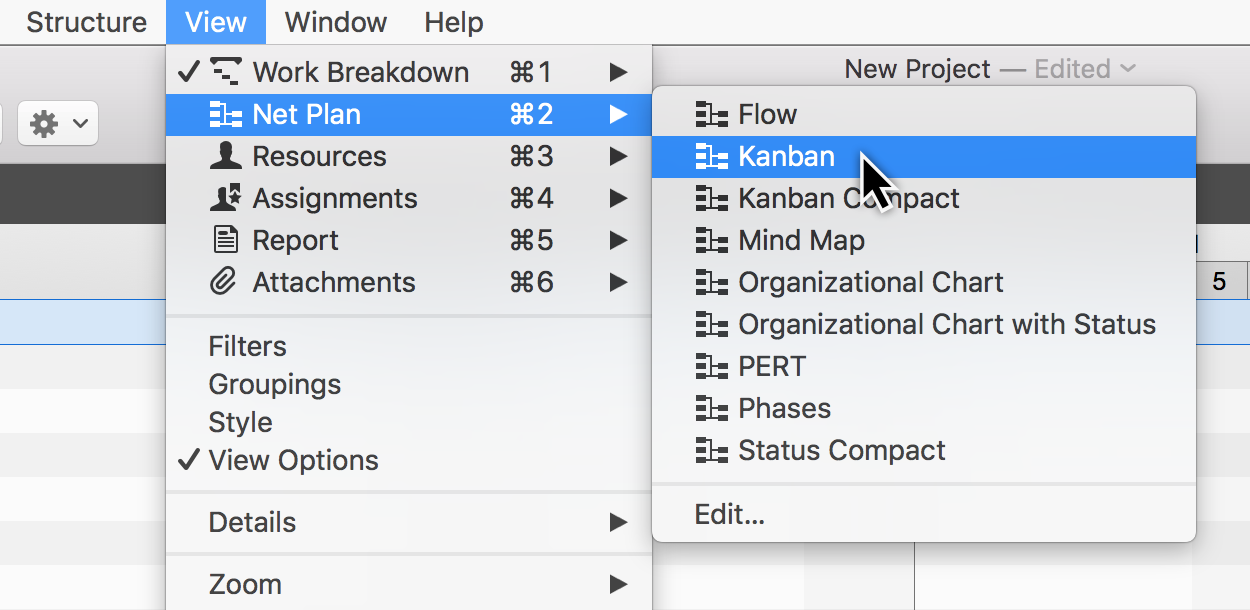
Creating the Kanban view
When you first access the Kanban view a notification will appear with the button Group by status field.
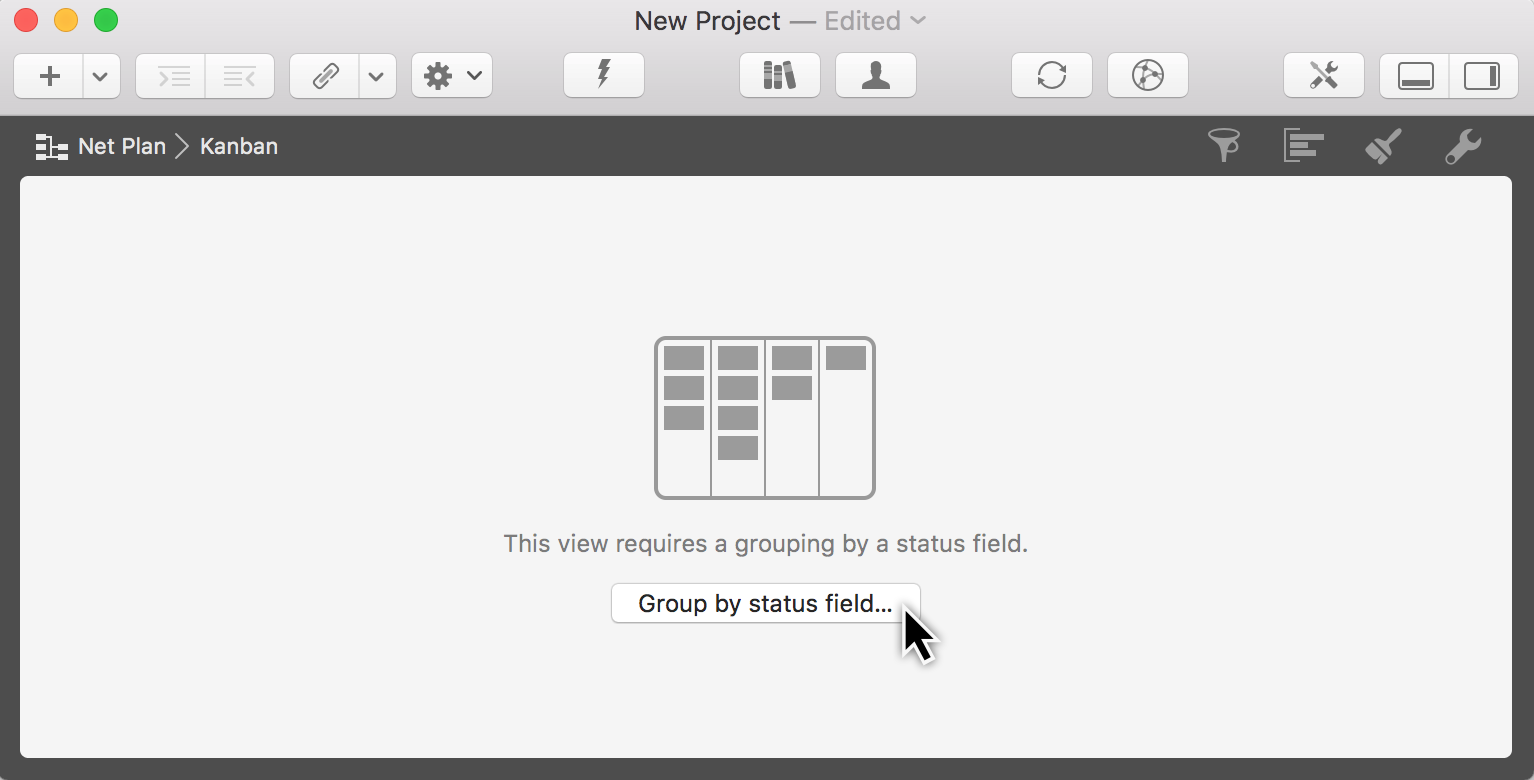
|
|
Kanban needs to be grouped by a status field and the status values it contains for the Kanban columns. |
Click the button to open the Grouping by Status Field wizard.
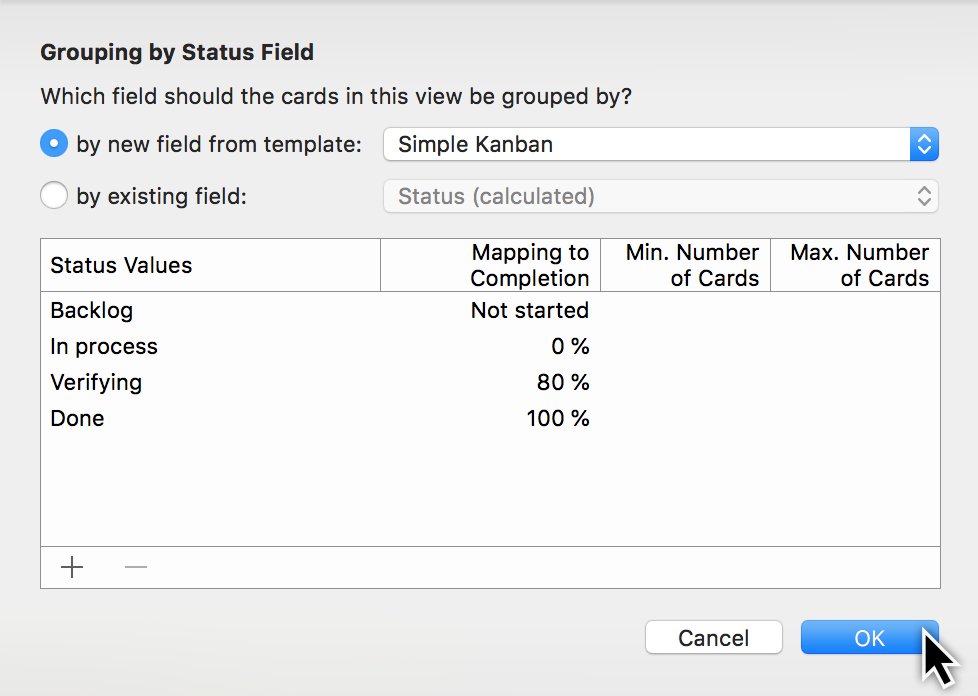
The wizard includes pre-defined status field templates.
|
|
See the »Groupings« guide for further information on "groupings" in Merlin Project. |
The options »by new field:« and »Simple Kanban« are preset automatically. Click OK to work with this Kanban status.
|
|
"Field" refers to custom fields. These fields can be created and managed in any Activity Inspector under the »Tags and Fields« tab. |
The status values in the supplied »Simple Kanban« field can be seen as columns in the Kanban board.
|
|
New fields can be created or existing ones edited quickly. See the Tags and Fields guide for further information. |
You can arrange the Kanban cards based on these status values and edit them with a defined Kanban status in the traditional view.
The status values can be changed in the wizard. Click on an entry to change it.
|
|
Read on to learn more about the individual status value options. |
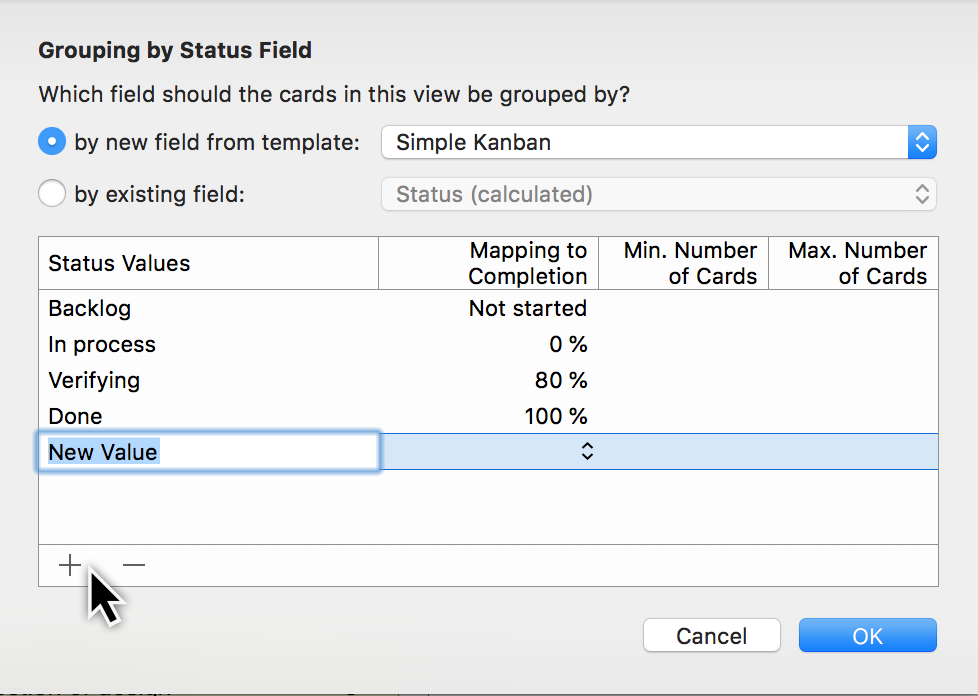
Click the plus to create new status values or click minus to remove them.
|
|
The »Simple Kanban« field is perfect for a variety of projects. It makes it quick and easy to get started with the Kanban methodology. |
Applying the Kanban methodology
The following tells you more about using Kanban in Merlin Project.
The status values from the »Simple Kanban« field appear in separate columns in the Kanban board.
The columns are arranged from left to right with the following status values:
-
Backlog
-
In process
-
Verifying
-
Done

If the project has activities, these appear automatically in the columns as Kanban cards. The card’s status in the project dictates in which column they are arranged.
You can create new Kanban cards by clicking the plus icon or using the keyboard shortcut cmd + N.
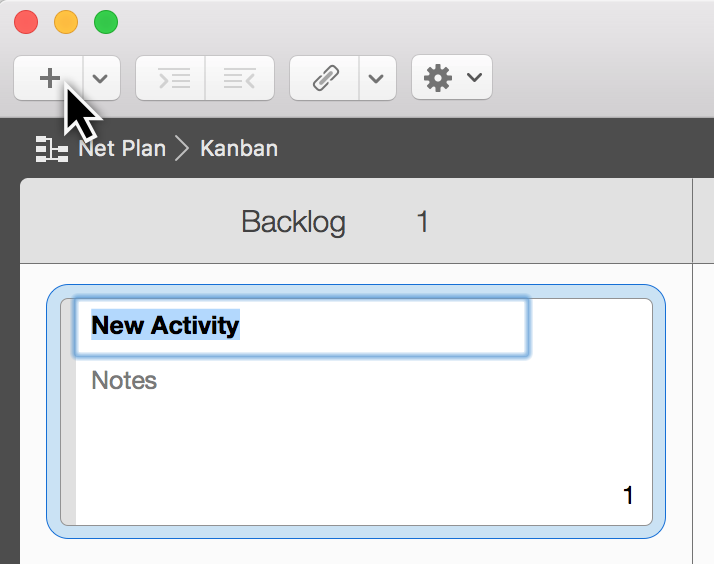
The card that is created appears automatically as an activity in the traditional view. Click the arrow on the right next to the plus icon to create further card types as well as attachments.
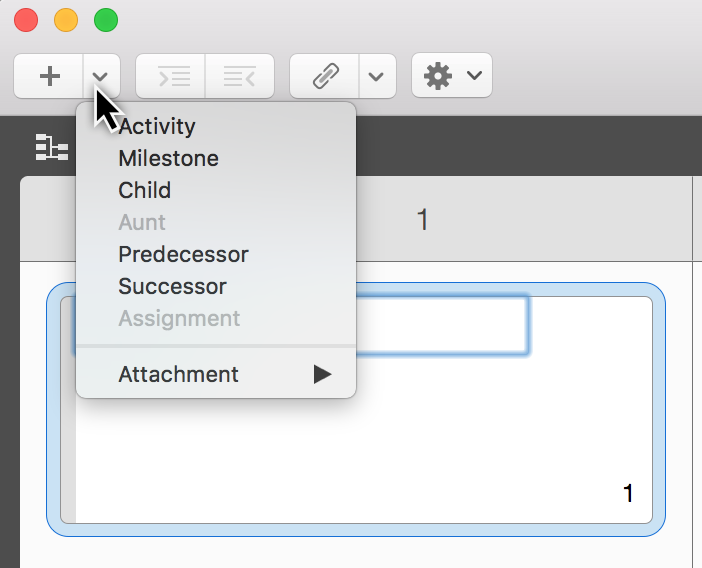
|
|
The same functions as appear under the arrow can also be found in the Insert menu. |
Select one or more cards and then click Attachment.
This option lets you add any files or information to the selected card(s). Attachments are represented by a paperclip in the lower left corner of the card.
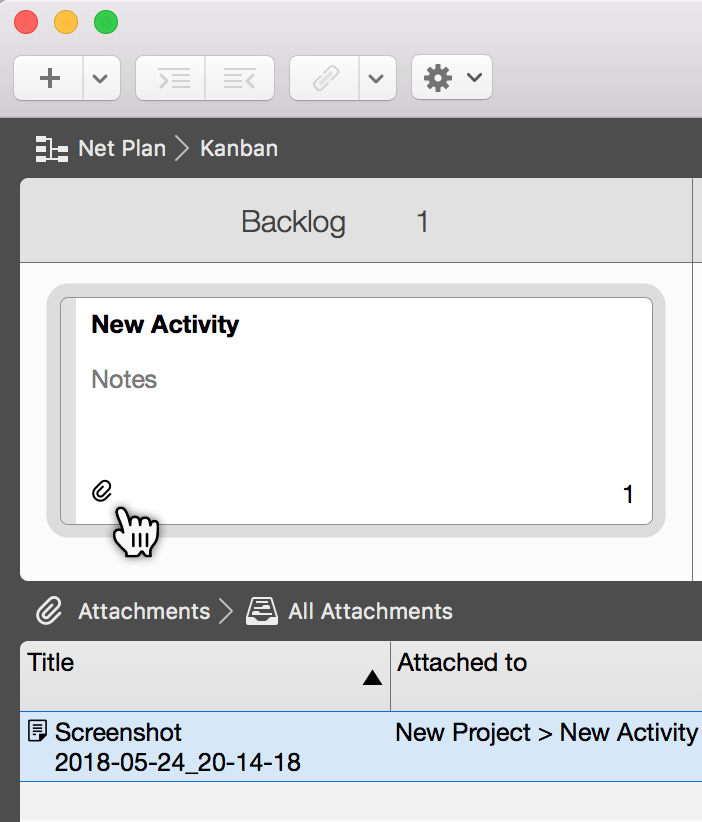
Wizard: grouping Kanban by status field
Grouping by status field is required for the Kanban view.
The wizard includes the following status field selection options:
-
by new field from template:
-
Simple Kanban
-
Software Development
-
Issue Fixing
-
Editor
-
Exhibitor
-
Sales
-
Attention level
-
Field with custom status values
-
-
by existing field:
-
Status (calculated)
-
Once you have selected the status field, a preview will appear of the status values contained in the status field.
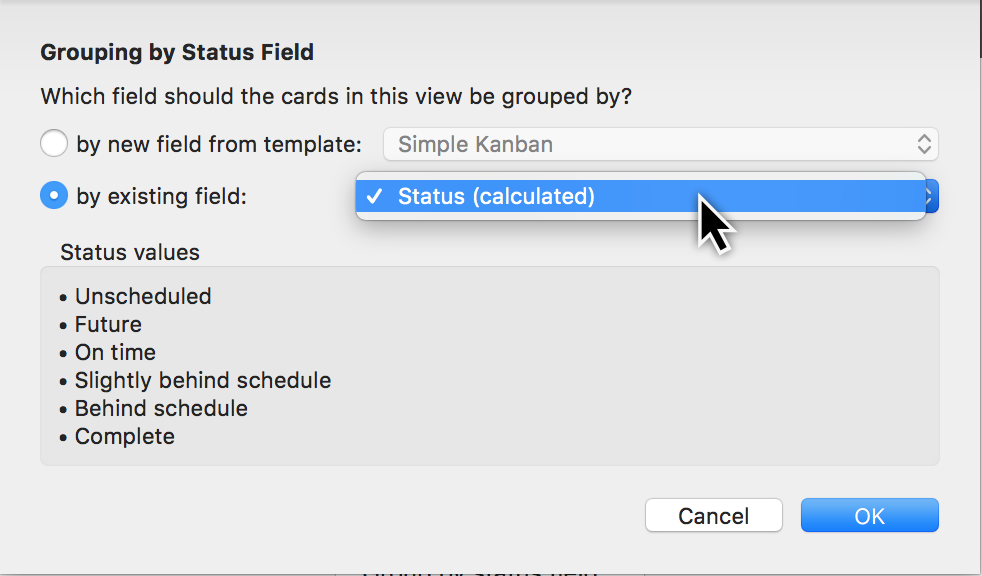
The by new field from template option lets you start directly with a new pre-defined template. This is the easiest way to create a Kanban.
The drop-down menu options can already be used for a variety of projects. The by new field from template option lets you select custom fields, that are already included in the project, to group the columns.
|
|
In newly created projects, the existing Status (calculated) field appears in the drop-down menu. |
The Status (calculated) field differs from most fields as it accesses the values calculated in the project. This means you can no longer move the Kanban cards in the Kanban view manually; they are moved automatically by the values calculated in terms of the project’s progress.
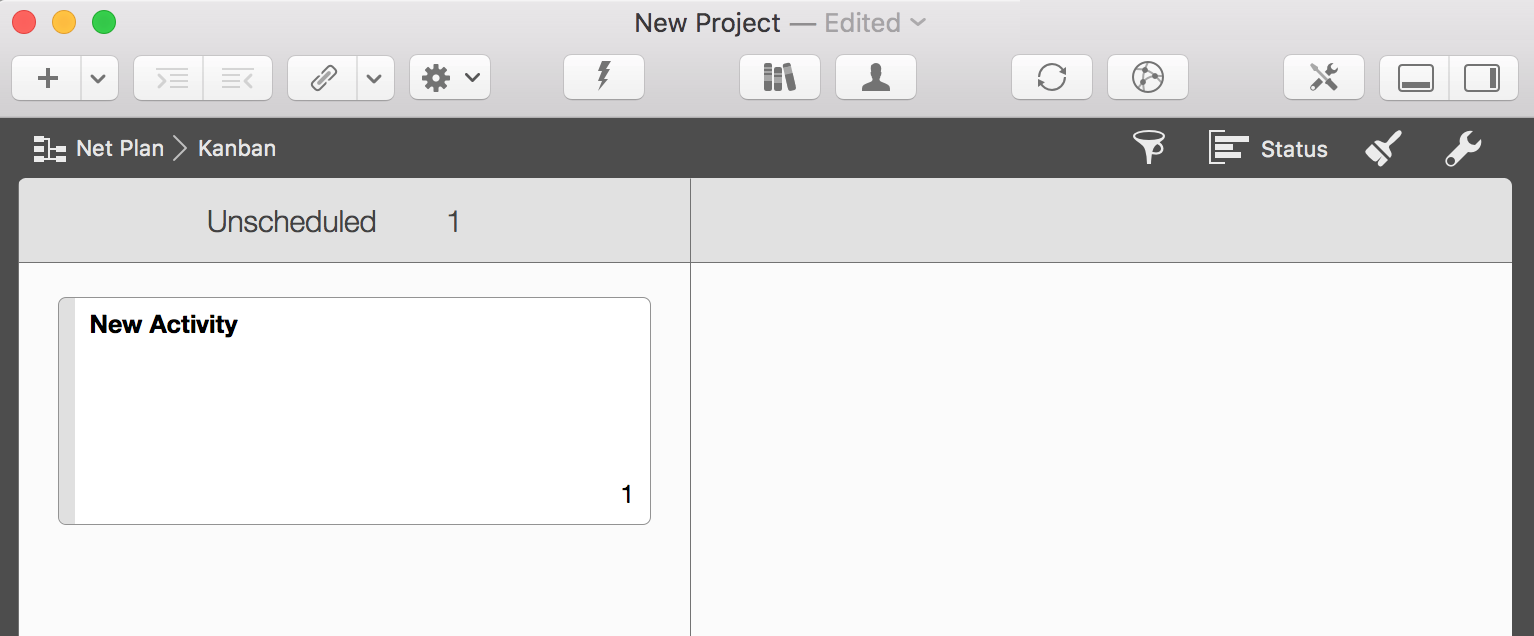
Should a Kanban board be grouped by Status (calculated), the Unscheduled column is shown as a single column until the project is progressing within actual values.
The status can be also shown in a column with the same name in the Work Breakdown > Entry view.
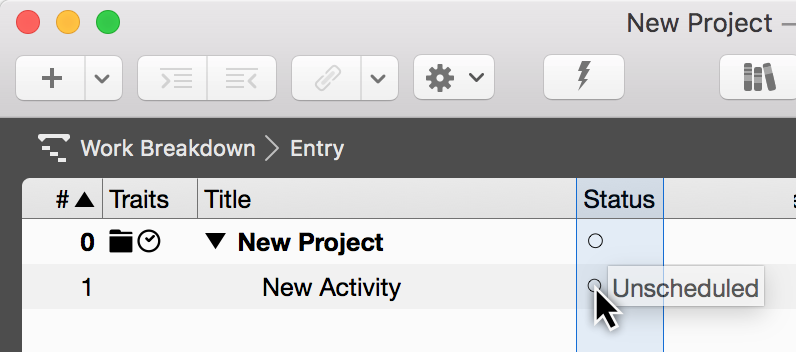
Re-accessing the grouping wizard
Click the Grouping icon to display the list of built-in groupings.

Click the gear icon in the Group Inspector and a drop-down menu will appear as shown. Click the option Group by Status Field.

The Grouping by Status Field wizard will appear. Select your desired grouping for the Kanban view.
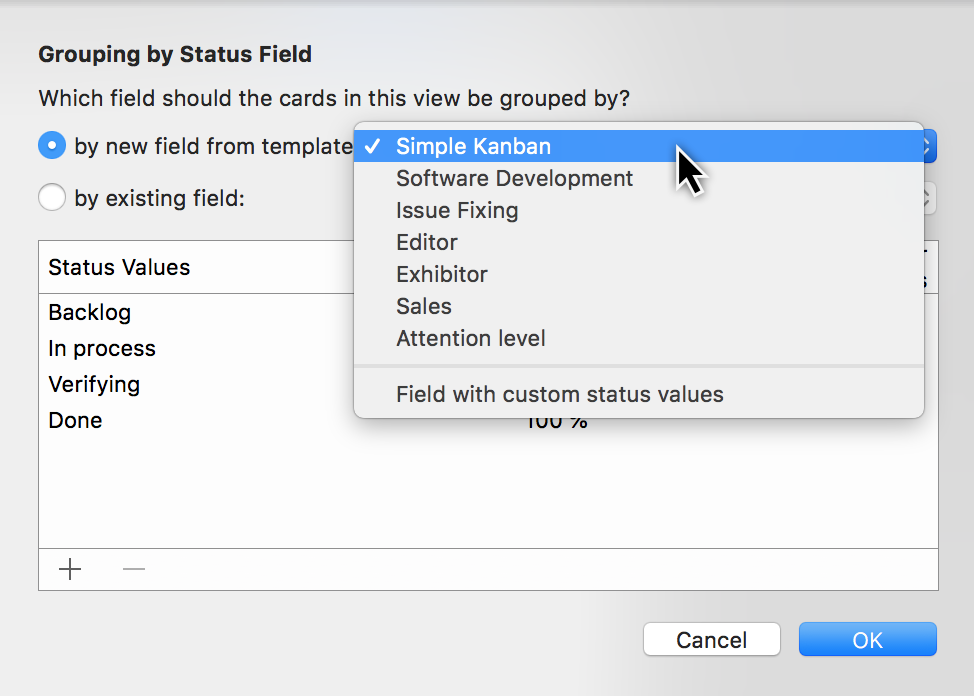
Creating custom groupings
Click the Grouping icon to display the list of built-in groupings.
Click the plus icon on the bottom left in the Group Inspector. A new grouping in the "Custom" category will be created.
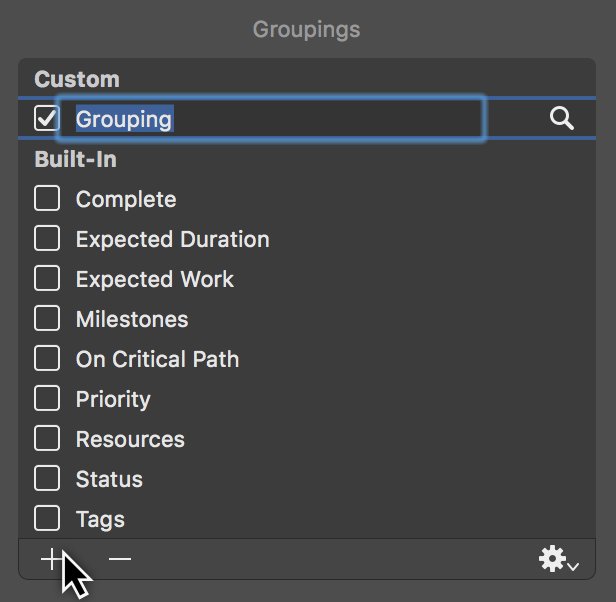
Name the grouping and then click the magnifying glass.
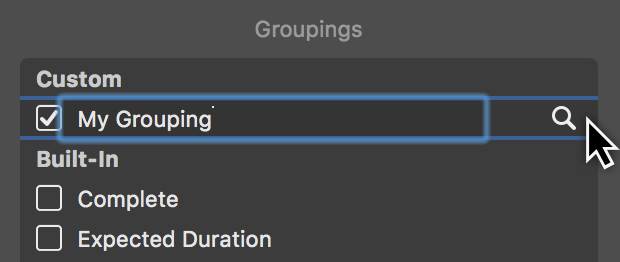
The dialog for modifying the grouping will be displayed. You can set the grouping options here. The view will be grouped based on these options. To do so, use the drop-down menu.
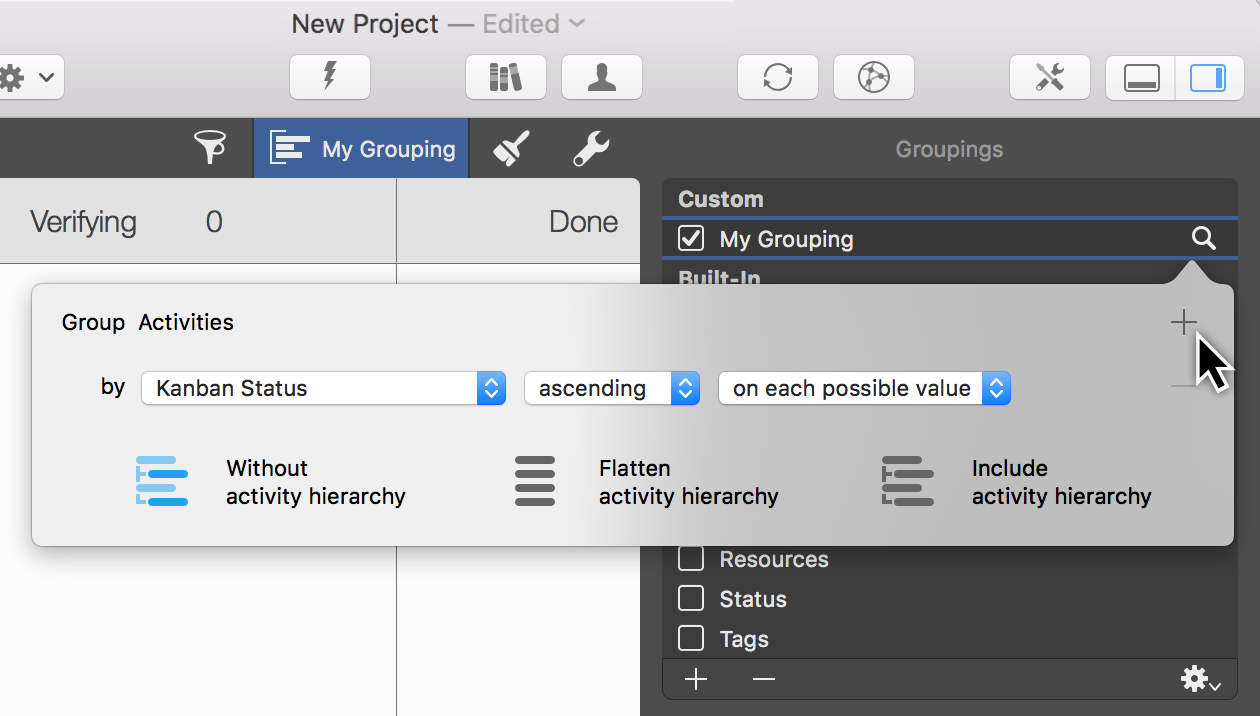
Click the plus icon to add additional grouping conditions. Click the minus icon to remove them again.
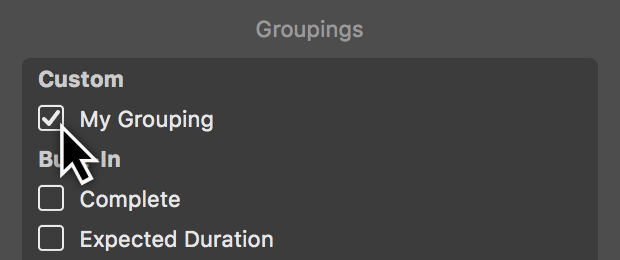
Click the rectangle on the left next to a grouping to activate it and apply it directly in the Kanban view.
|
|
You can modify existing groupings if required. To do so, select an existing grouping and click the magnifying glass to the right of it. Once you have modified it, the new configuration will be adopted in the selected grouping. |
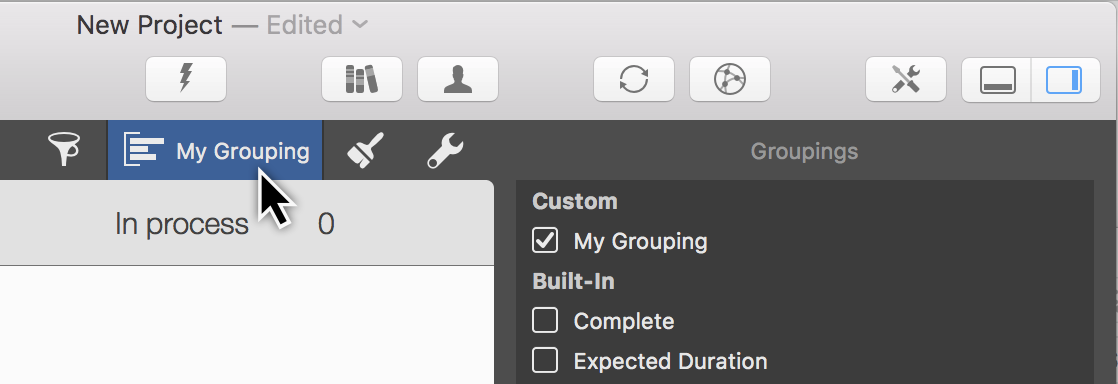
The active grouping will be displayed next to the grouping icon. Click it to access the list where you can change or modify the grouping whenever you want.
Adjusting status fields
Click a column title in the Kanban view to display the "Group" Inspector. The clicked value of the status field will be displayed there and can be adjusted.
|
|
Columns with calculated values are an exception as these cannot be changed or adjusted in the Inspector. |
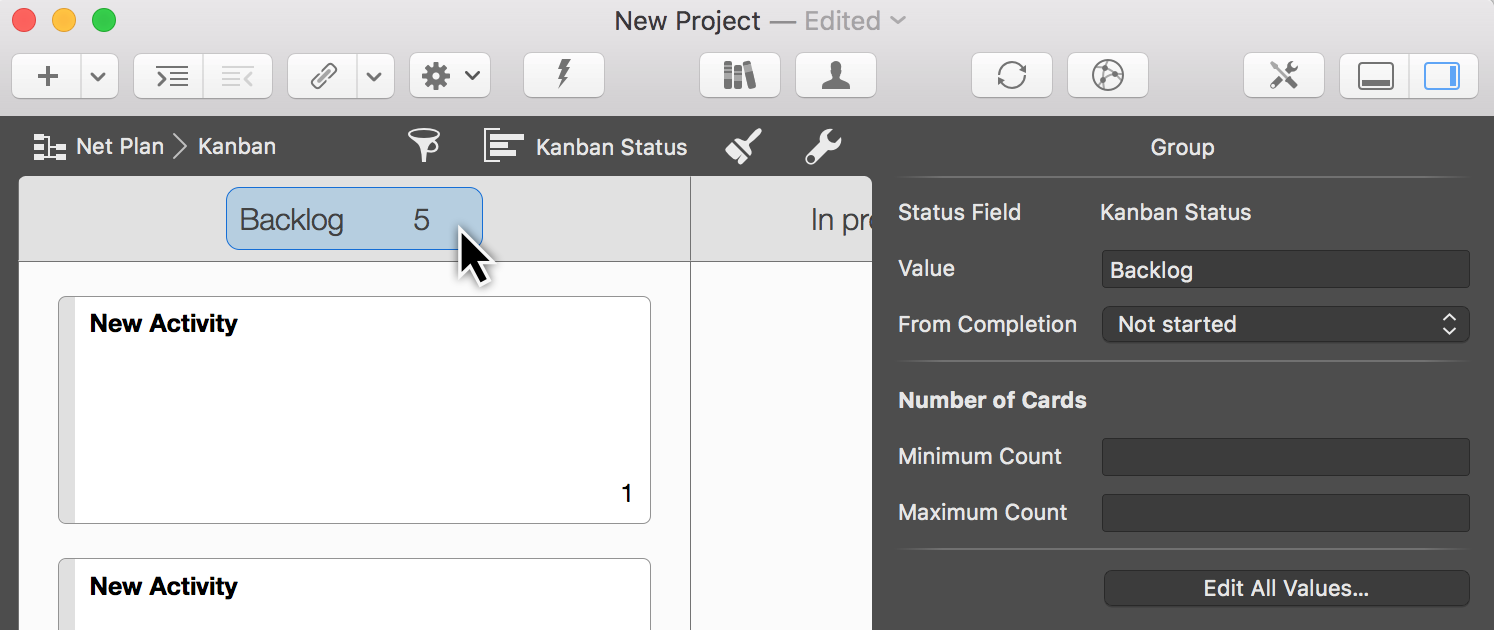
You can choose from the following options in the "Group" Inspector:
-
Value (column title name)
-
From Completion (drop-down menu with completion values from 0% to 100%)
-
Edit All Values… (displays the Custom Fields Inspector)
-
Select Status Field (displays the Grouping by Status Field wizard)
-
-
Number of Cards
-
Minimum Count
-
Maximum Count
-
|
|
The Grouping by Status Field wizard includes the same settings for the values. |
Click the Edit All Values option in the Group Inspector to open the Inspector for the current grouping values. See the Field Values Inspector section for further information.
The Minimum Number option lets you set the minimum number of cards displayed in the column.
If you set a minimum number of cards, a counter with the current number of cards and the minimum number set is displayed in the title column.
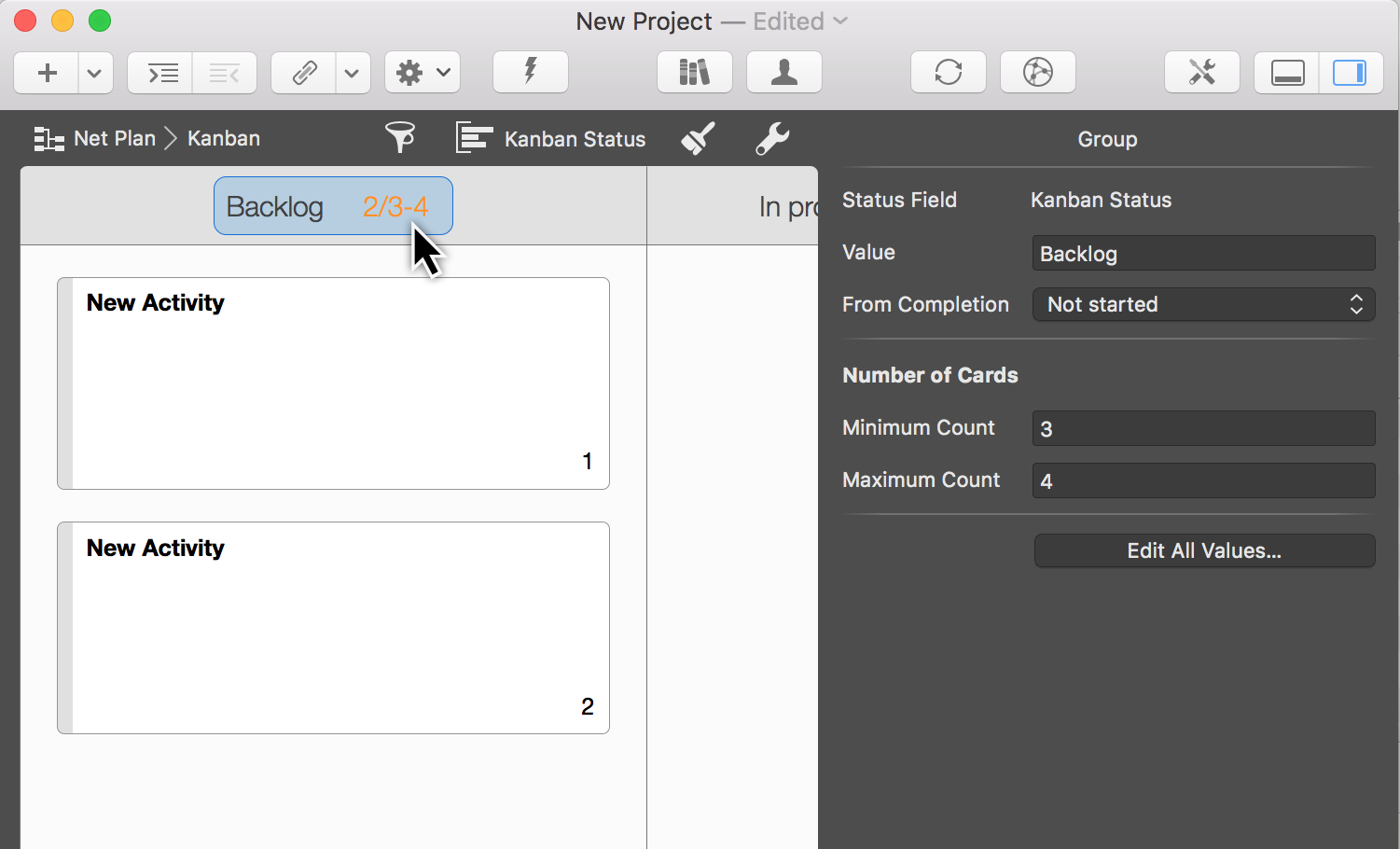
|
|
If the minimum value is higher than the current number of cards, the title column is highlighted in orange. |
The Maximum Number option lets you set the maximum number of cards displayed in the column.
If you set a maximum number of cards, a counter with the current number of cards and the maximum number set is displayed in the title column.
Kanban fields
You can edit and adjust the field values in the Custom Fields Inspector.
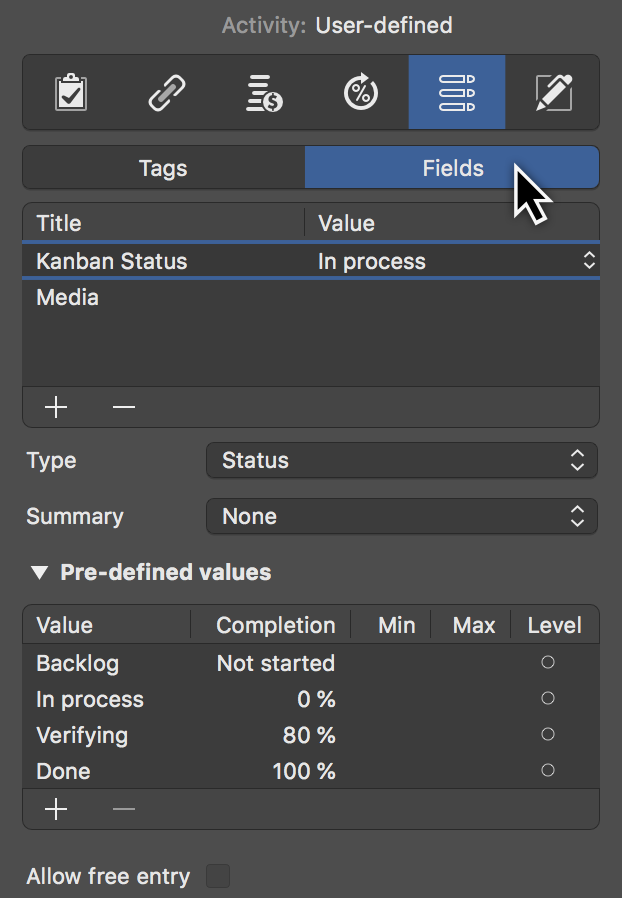
These field values set the progress for the cards and in doing so for the activities in the Kanban view and other views in Merlin Project.
Field Values Inspector
The current grouping and associated values can be found in the Custom Fields Inspector.
Click the icon to the right of the value and all available values in the active grouping will appear in the drop-down menu. These values are used for the columns in the Kanban view. The selection is applied immediately for the selected card(s).
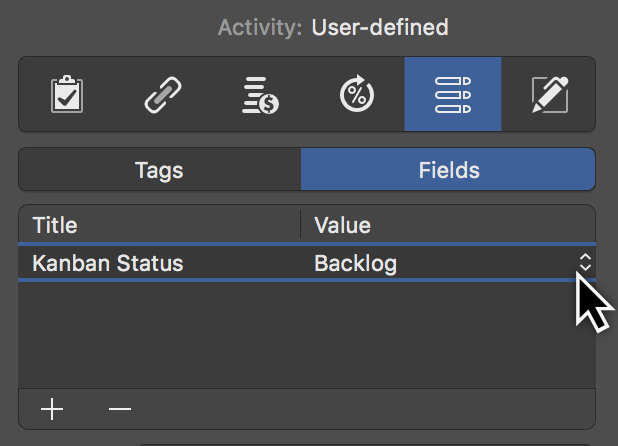
Pre-defined values
You will find a list of pre-defined values for the active grouping further down in the Inspector. Click the plus icon or minus icon to add/remove values to the grouping.
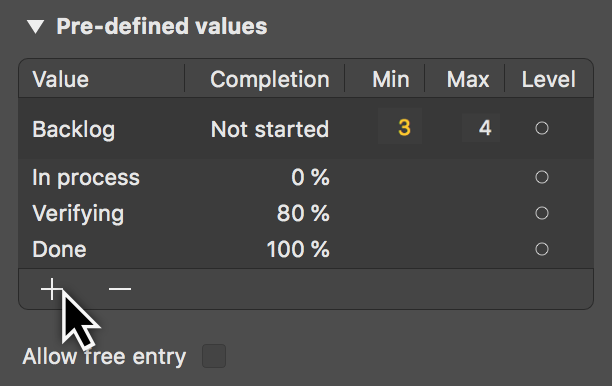
The values can have different properties. These are:
-
Value
-
Completion
-
Min
-
Max
-
Level
Value is also the title of the column in the Kanban view
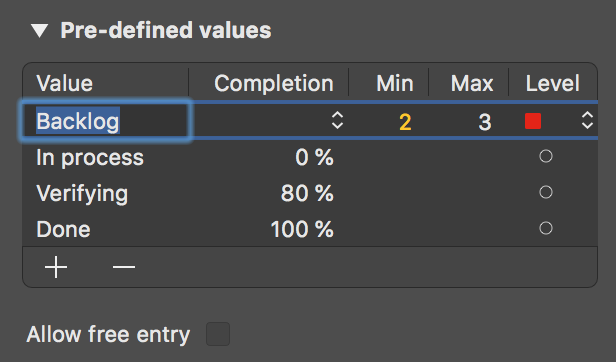
Completion controls the progress of the activities both in the Kanban view and in all other views.
The following options are available:
-
Empty (no completion)
-
Not started
-
0% to 100% (in increments of ten)
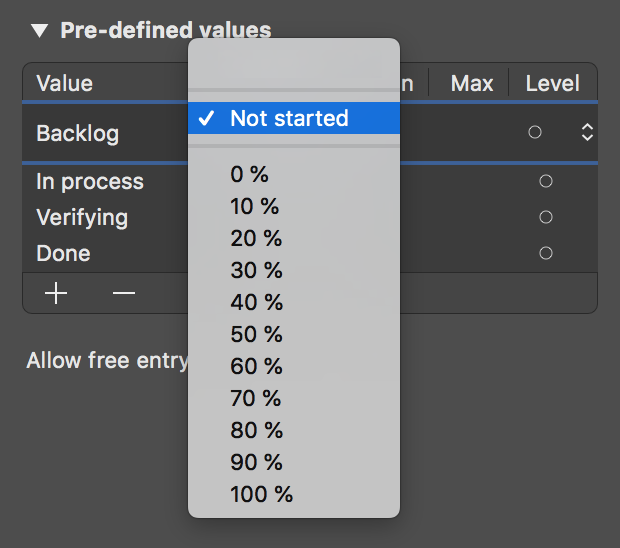
When entering a % value for an activity that corresponds to the % value in the Completion column, the card associated with the activity is moved automatically in the Kanban column.
Conversely, you can also move a card manually. If you move a card in this Kanban column, the activity is assigned the % completion value automatically.
Min is the minimum number of cards in the Kanban column. This value corresponds to the Group Inspector option with the same name.
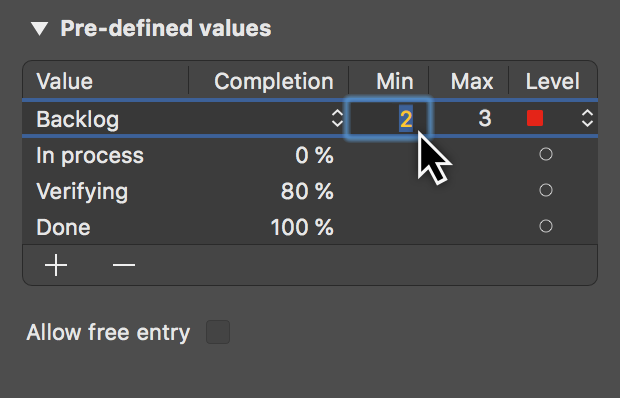
Max is the maximum number of cards for the Kanban column. This value corresponds to the Group Inspector option with the same name.
Level includes the optional categorization of the value in:
-
Neutral (white circle)
-
Normal (green dot)
-
Warning (yellow triangle)
-
Critical (red rectangle)
This categorization is only visible in the list of vales and has no planning impact; it is for the planner’s information only.
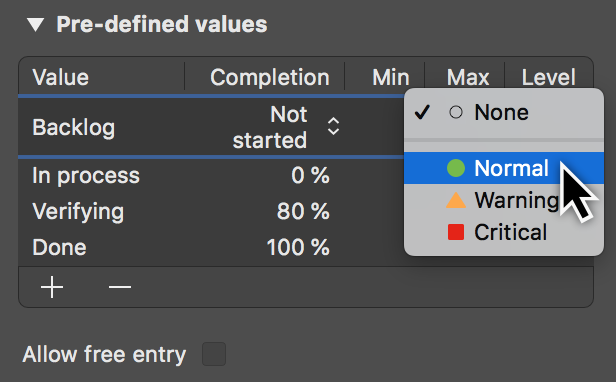
|
|
The Allow free entry option is deactivated as the status fields use pre-defined and/or calculated values. Free entry is therefore not possible. |
Conflicts
Merlin Project visualizes your planning and warns you if it identifies any scheduling conflicts in your project. Scheduling warnings are shown when a specified value cannot be used. It is possible to disable the warnings in the View Options.
Merlin Project categorizes conflicts in two groups; strong and weak. Rows with strong conflicts will show titles in red. Orange colour indicates weak conflicts.
Hover with the mouse over one of those red or orange items to see in the tool tip the related conflict.
If you have enabled the Traits column, you also see related symbols for conflicts.
Also, all conflicts with a brief description will listed in the Notifications window.

Remove the checkmark next to Show weak conflicts and only strong planning conflicts will appear in the list.
Weak conflicts
-
Expected work exceeds given value.
-
Expected duration exceeds given value.
-
Budget sum exceeds approved budget.
Strong conflicts
-
Activity starts before entered date.
-
Activity starts after entered date.
-
Activity ends before entered date.
-
Activity ends after entered date.
-
Dependency order is violated.
-
More than n activities have the status "…"
Conflict resolving
There can be several reasons why a conflict arises and various ways dealing with them. An algorithm cannot possibly tell which conflicting setting should be ignored. So the app isn’t supporting conflicts solving automatically.
Feel free to contact our support with your project so we can try to help you with your options.
|
|
In our blog we provide some possible resolve solving approaches. Just click the individual conflict for more information. |
Resource Pool
A resource pool lets you use the same resources in multiple projects centrally and to level this use across projects.
What’s special about a resource pool is that the resources are available for multiple projects, whereby all resource changes are synced automatically across all projects that are using the resource pool.
Advantages in project planning
The resource pool is the perfect solution when working on more than one project where the same resources are used regularly.
The resource pool lets you use the same resources with multiple projects, whereby all the resource information from the resource pool is available to everyone working with projects linked to the resource pool file.
If resources change in the resource pool file, the information is updated automatically in the connected projects.
Using resource pools makes it easier to work on a number of projects with the same resources and assignments.
Create a resource pool
You need a new project file to create a new resource pool.
Start Merlin Project and open a new project. To do so, click File > New or use the keyboard shortcut alt + cmd + N.
|
|
Alternatively, click the New Document button on the bottom left in the Open dialog. |
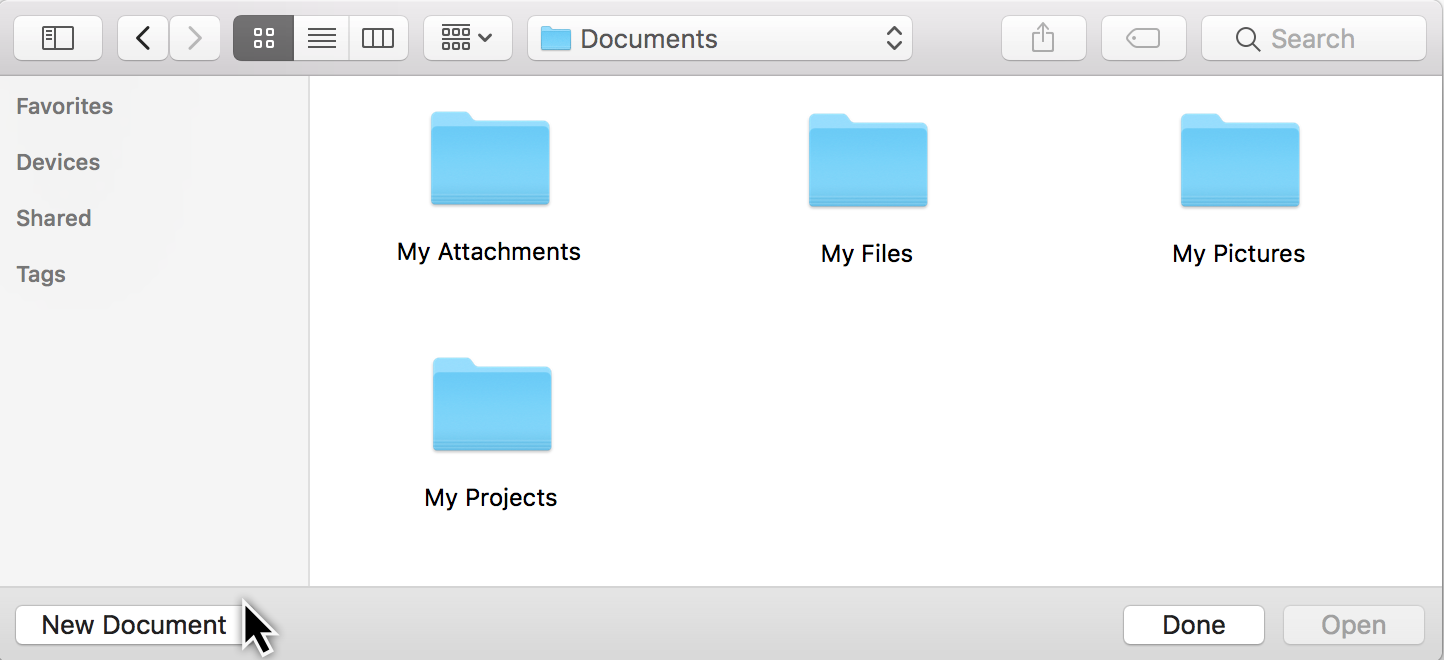
Creating resources
It’s quick and easy to create new resources for the resource pool.
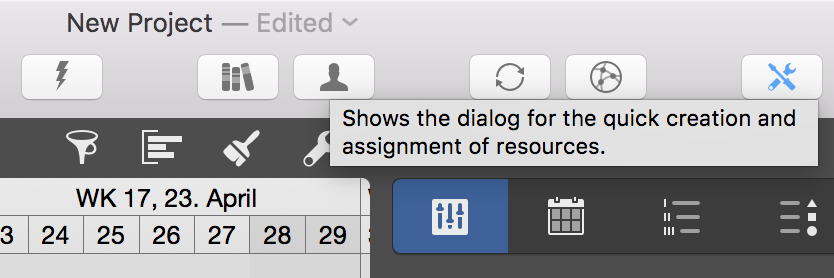
Click the Resources icon in the toolbar.

Then, click the plus icon to create a new resource.
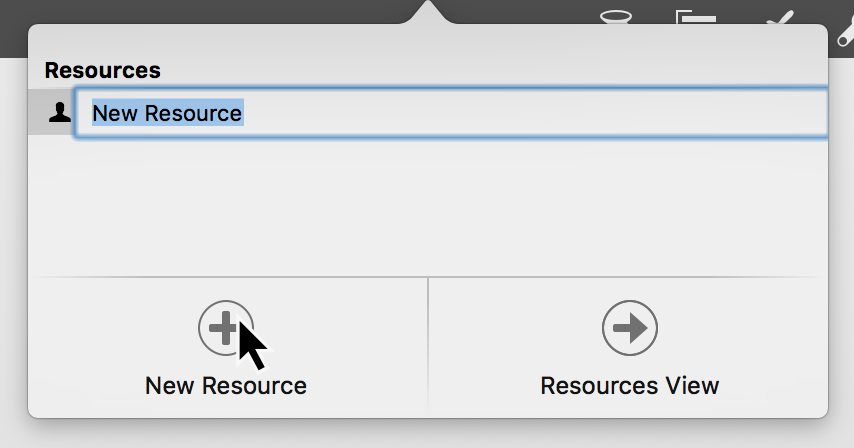
Name the new resource. Continue by clicking the plus icon. Repeat these steps until you have added all required resources to the resource pool.
|
|
If you’re in the Resources view, click Insert and then the option Resources or use the associated keyboard shortcut cmd + N to add new resources. |
Resources view

Switch to the Resources > Entry view to edit resources in more detail. In this view, you can find various columns with further information to your resources.
If you select a resource, the Resources Inspector is also displayed. It contains all the fields to modify the selected resource.
Click the insert button as shown in the Image column, to insert an image for your resources.


|
|
The image will show up in Kanban cards and in any comments this resource inserts into the project. |
Create resources from contacts
If the Contacts.app or Microsoft Outlook already includes contacts, you can add them directly in the Resources > Entry view by using your mouse to drag and drop them, thereby adding them as resources to the resource pool.
Please note that the blue lines perform different functions when adding contacts.

Place the business card between the rows and the contact from this card will be added to the resource list.

If you place the business card on top of an existing resource (on the line), the contact on the card will replace the resource.
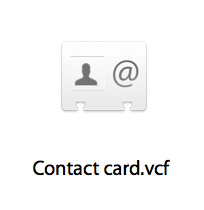
|
|
When adding a contact from the Contacts.app or Microsoft Outlook, business cards are used in the vCard format. |
If you use other apps that export to the vCard (.vcf) format, these contacts can also be dragged and dropped to the Resources view and used as resources.
The information in the vCards is imported automatically into the individual columns in the Resources view. This includes the contact’s photo, email address, and telephone number if these details are included in the vCard.
Add a resource pool to projects
Once all the resources and required information, such as standard rates (meaning the cost of the resource per time unit), have been fully entered in the resource pool, save the file.
To do so, click File > Save or the keyboard shortcut cmd + S.
Name the resource pool file and then click Save.
|
|
The filename will be used for the resource pool in the Resources view. |
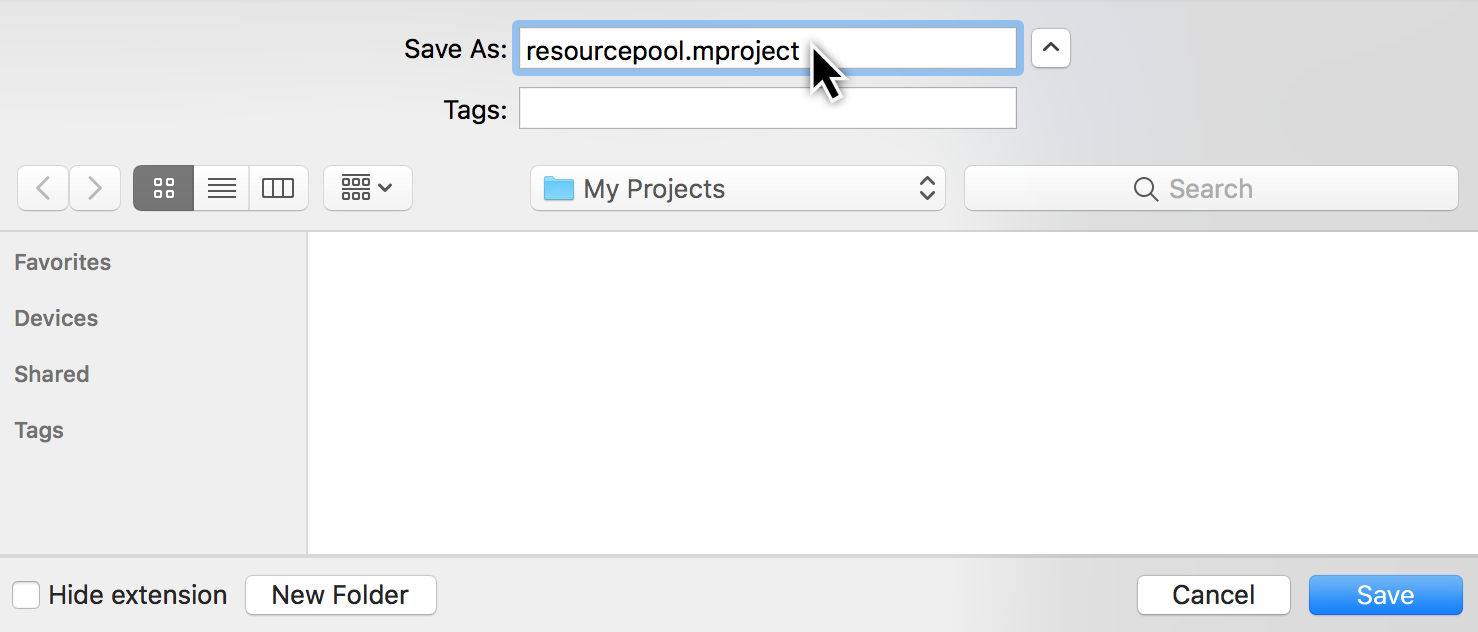
Open a new or blank project in which you want to use the resource pool file.
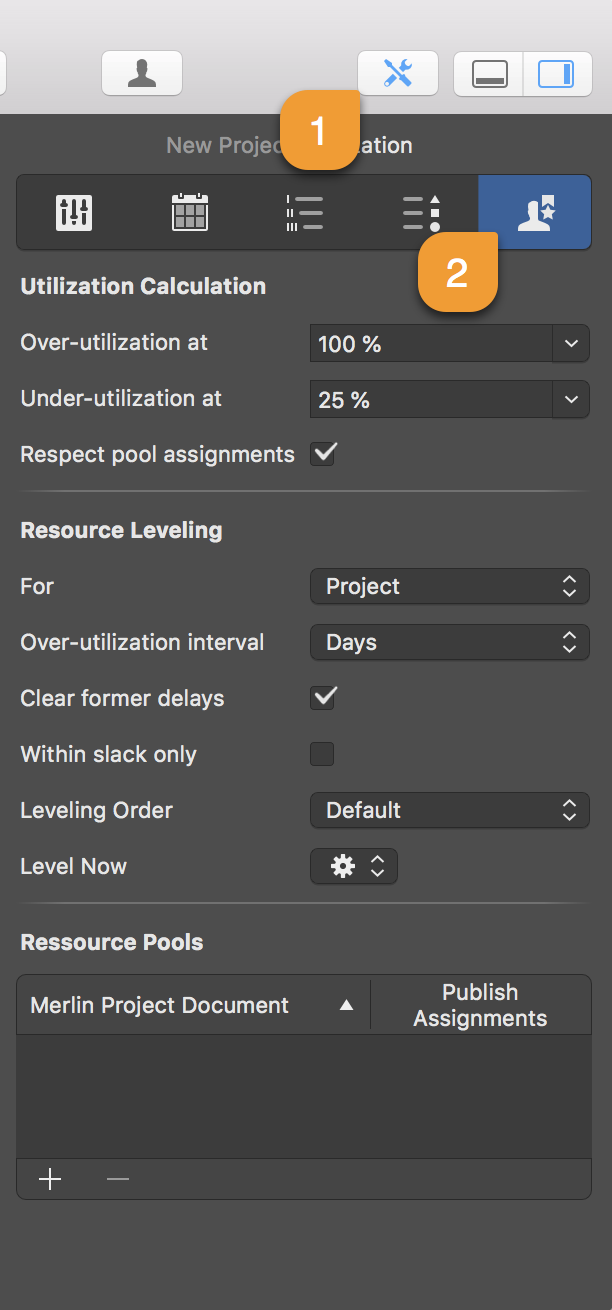
In the toolbar, click the Settings icon (1) and select the first icon on the right, the Utilization tab (2).
In the Utilization Inspector you will find the Respect pool assignments option in the Utilization Calculation area.
It is activated by default. If the project includes resource assignments from resource pools, they are taken into consideration in the utilization calculation. Unmark the checkbox and the pool assignments will not be included in the utilization calculation.
The Resource Pools list is located in the lower area.
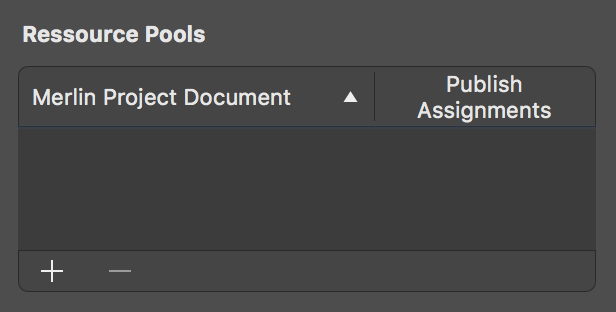
Here you can add, remove, and edit pool files for the opened project as resource pools.
The Publish Assignments option shows all assignments from the projects in the resource pool file. This option is activated by default. Unmark the checkbox if you do not want assignments to appear in the pool file.
|
|
This is useful for projects containing confidential information where you do not want this information to appear in the pool file. |
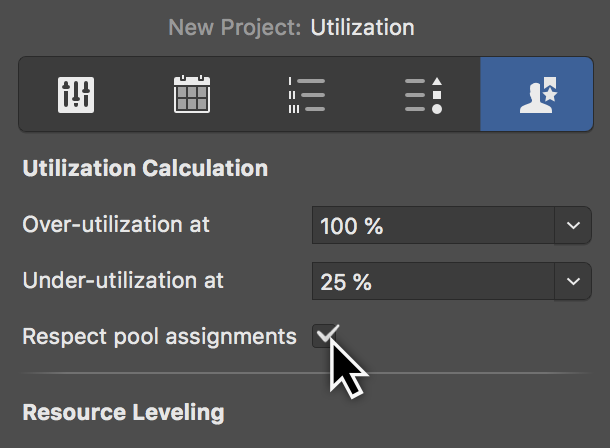
|
|
See the Utilization guide for further information on the topic. |
Add a resource pool using the mouse
The easiest way to use one or more project files as a resource pool is to drag and drop it/them into the Inspector field using the mouse.
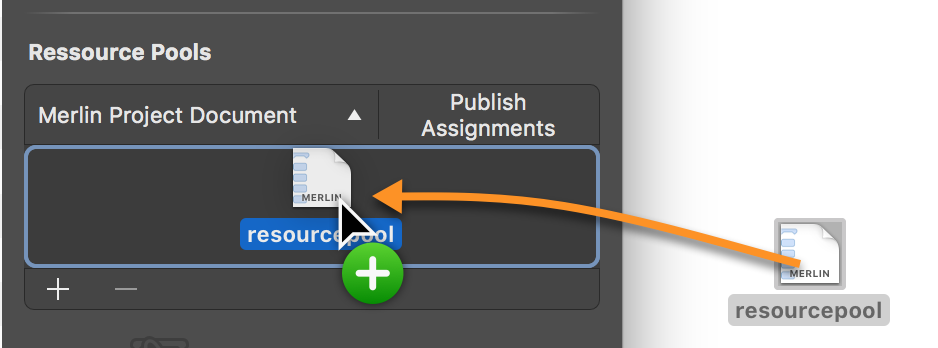
When adding the resource pool, you can adopt all resources automatically.

|
|
Project files with activities cannot be used as a resource pool. If the project file contains activities, the following dialog is displayed. |
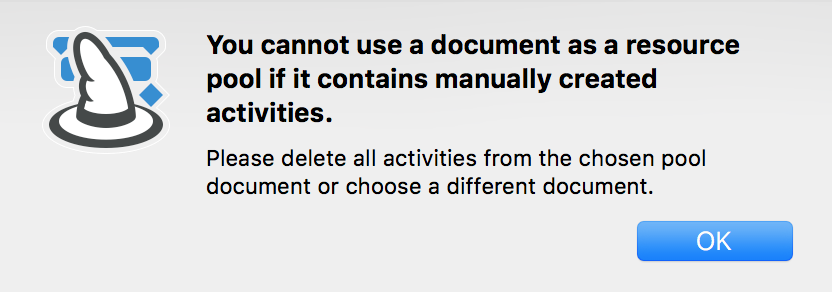
First delete the activities from the project file to then use it as a resource pool.
Add a resource pool using the icon
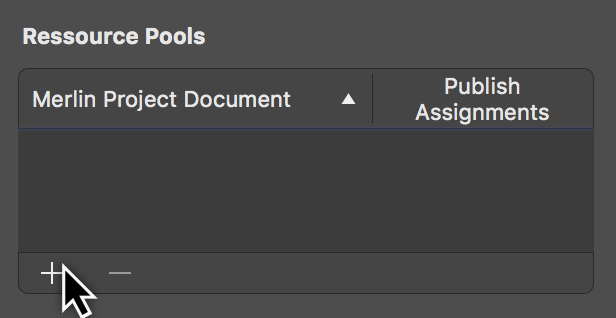
Use the plus icon to add one or more resource pools.
In the Open dialog click a project file you want to use as a resource pool.

Repeat this process if you want to add further resource pools.
Removing resource pools
Select one or more resource pools from the list and either use the delete key or click the minus icon.
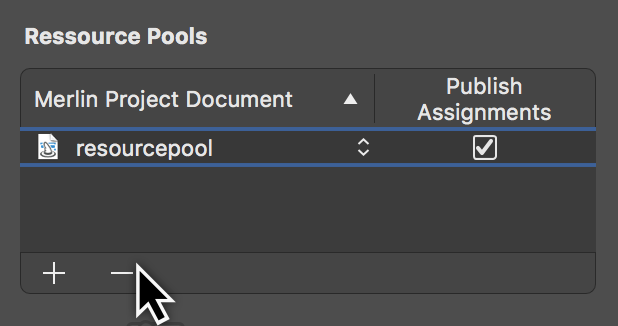
The connection to the resource pool will be removed from the project and the following notification will be displayed.

Only delete the connection if you are certain that you no longer want to update the resources. While the resources will remain in the project, they won’t be updated by any changes. This means that the original resource pool file will no longer be connected to.
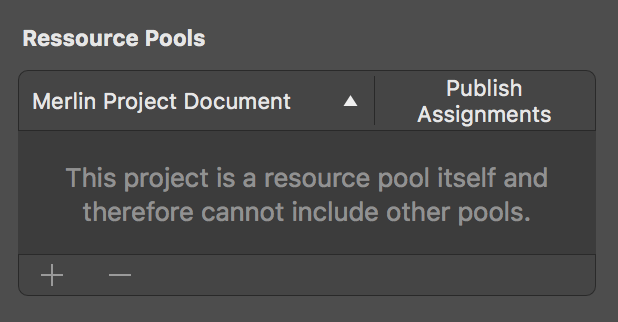
|
|
No resource pools can be included in a project file that is already being used as a resource pool. |
Using resource pools
After including a resource pool in the project, the resources are listed in the Resources view.
In this view, all resources from the resource pool are included and listed in the project. These resources are marked with a double-headed arrow icon in the Info column.
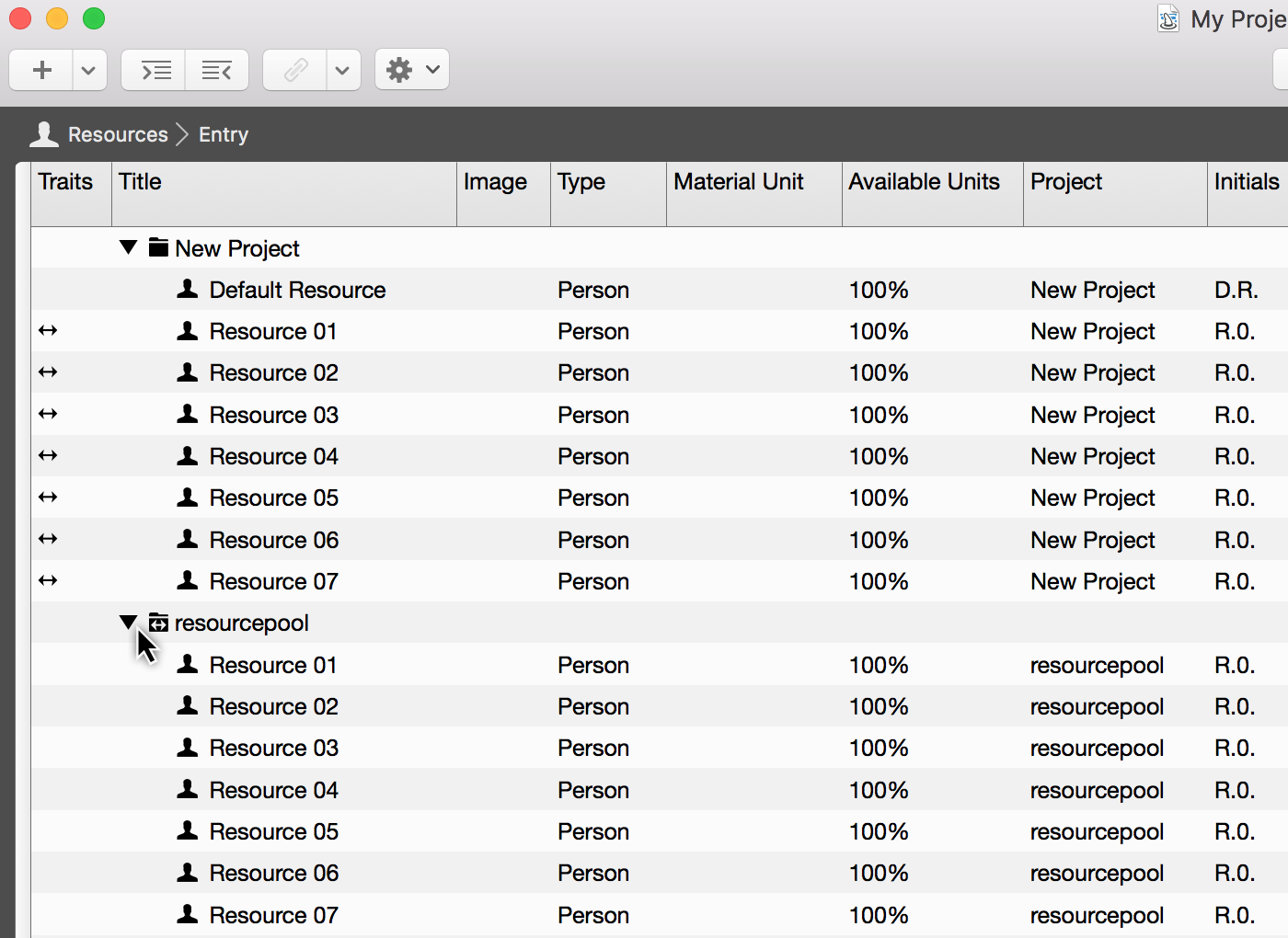
The resource group in the resource pool is represented below the project resources by a folder with a double-headed arrow icon.
Click the triangle to expand and collapse the resource folder.
|
|
The resource pool folder has the same name as the corresponding resource pool file from which it obtains the resources. |
Dragging and dropping resources from the pool into the project
To integrate resources from the resource pool into the project, switch to the Resources view.
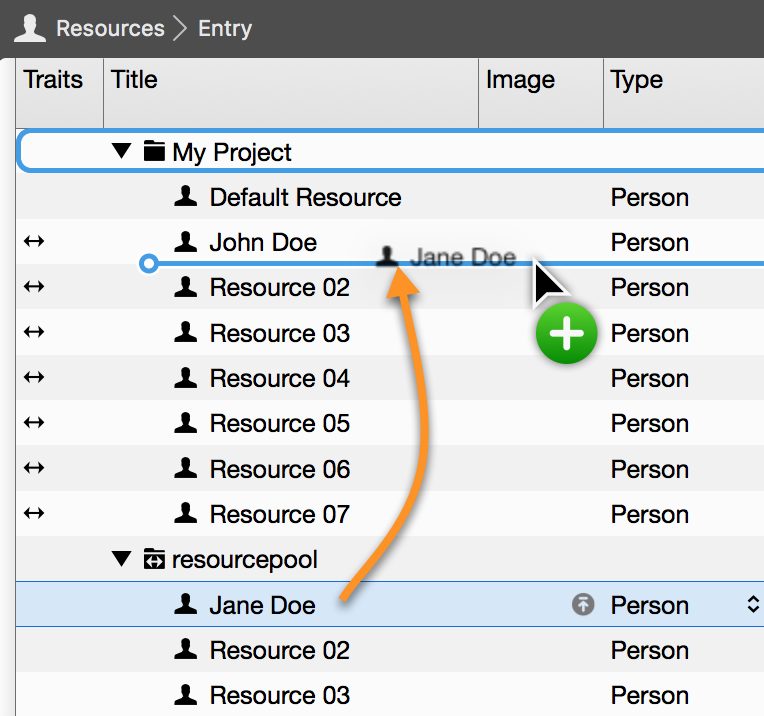
Using the mouse, drag and drop the desired resource(s) from the resource pool into the resources area in the project.
Dragging and dropping resources from the project into the pool
To integrate resources from the project into the resource pool, switch to the Resources view.
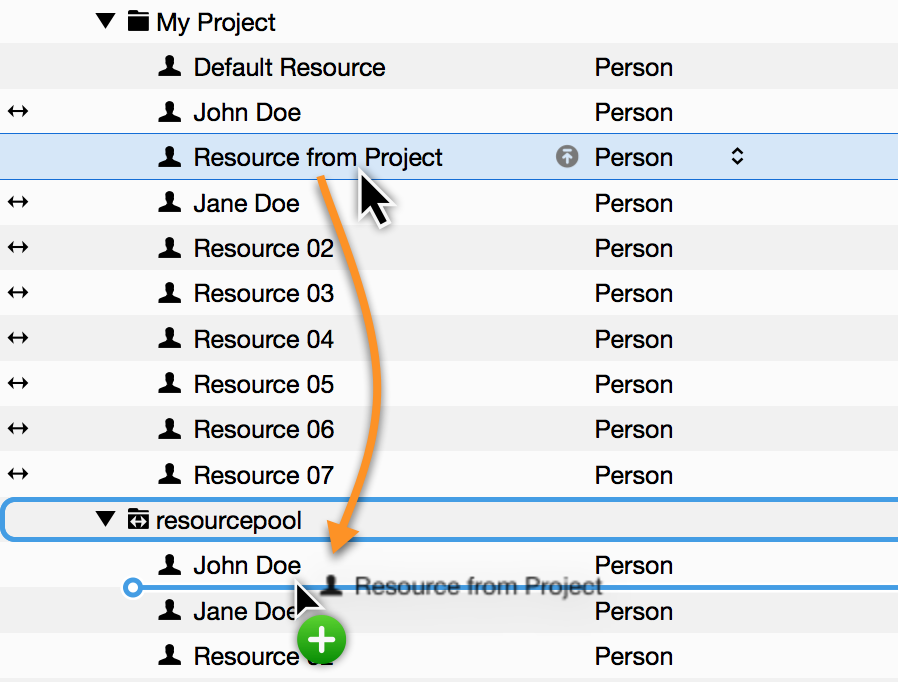
Using the mouse, drag and drop the desired resource(s) from the project into a resource pool area.
Updating from the resource pool
If you want to update project resource information to the latest status of the connected resource pool, switch to the Resources view.
Then, right-click one or multiple resources.
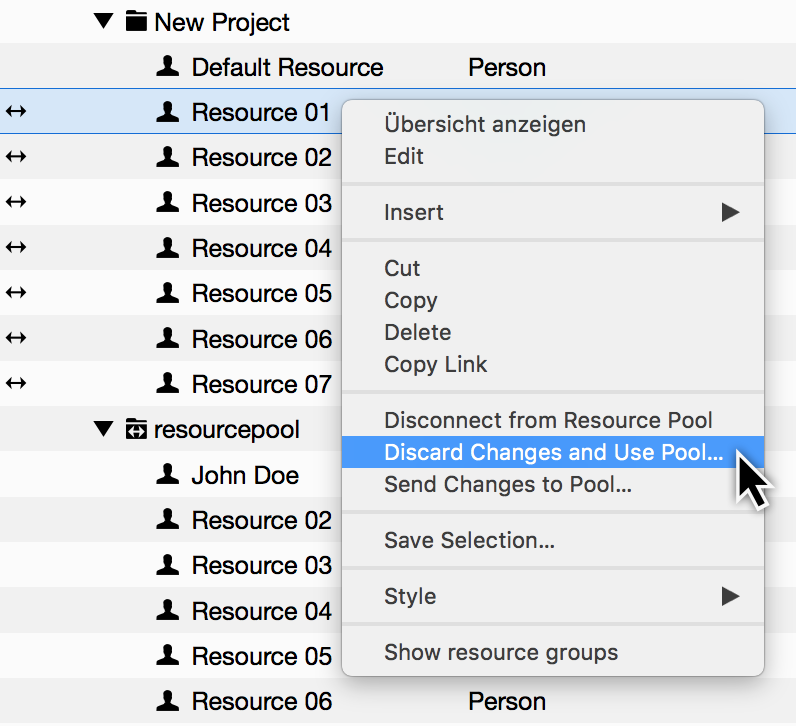
In the context menu, click Update From Resource Pool.
All new information on the resource will then be sent from the resource pool, thereby updating it.
Updating the resource pool
If you want to transfer information from resources in the project to the connected resource pool, switch to the Resources view.
Then, right-click one or multiple resources.
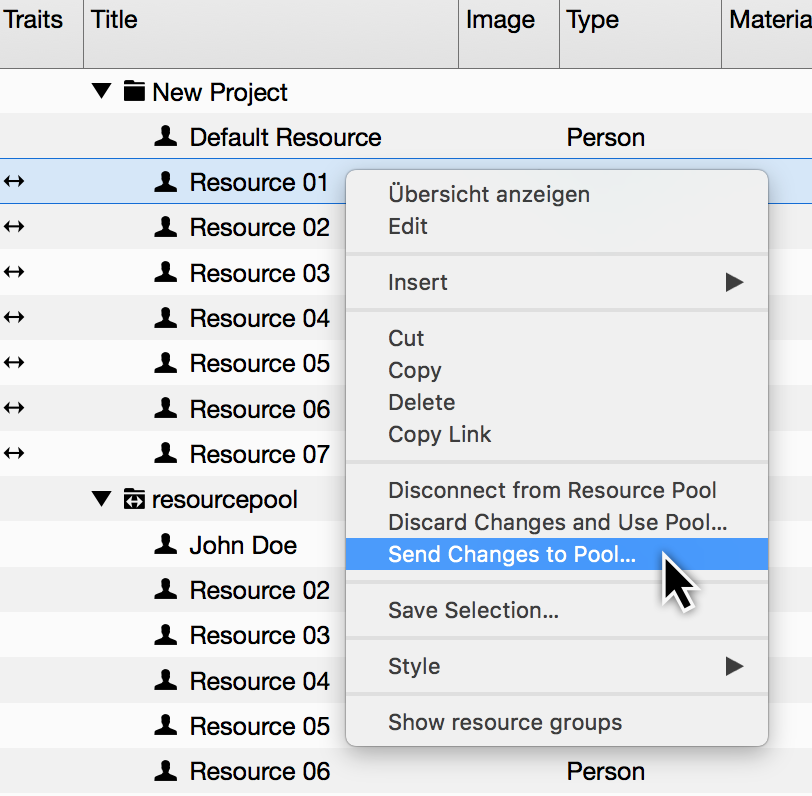
In the context menu, click Update Resource Pool.
All new information on the resource will then be sent to the resource pool, thereby updating it.
Disconnecting from the resource pool
If you want to make resources independent of the resource pool, switch to the Resources view.
Then, right-click one or multiple resources.
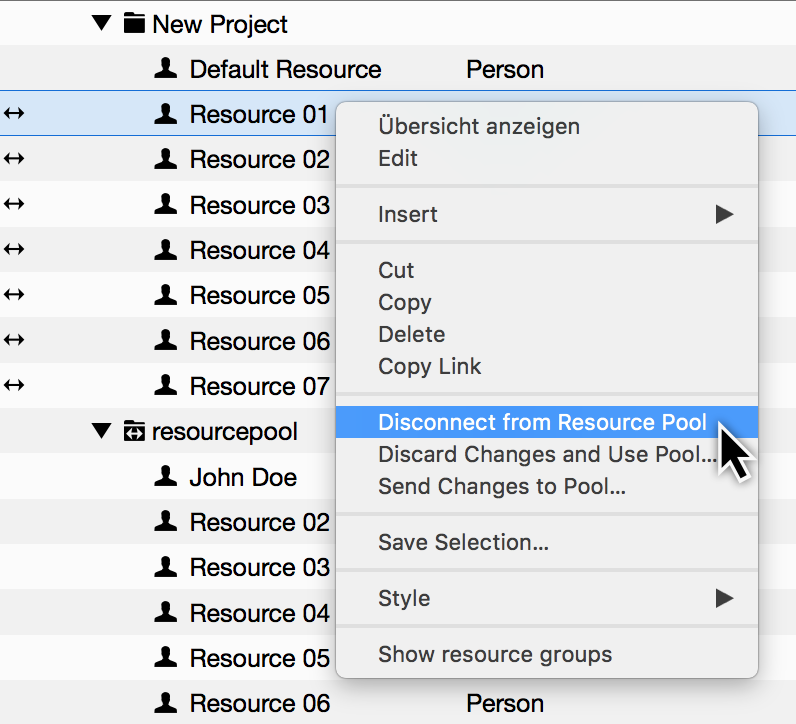
In the context menu, click Disconnect From Resource Pool.
All new changes and modifications to resources disconnected from the resource pool will now only be saved in the project, with no updates sent to or from the resource pool.
Showing/hiding the resource pool
The resource pool is show in the Resources and Assignments views. This causes resources to be displayed multiple times in the project and resource pools.
To show/hide these options, click the View Options icon.
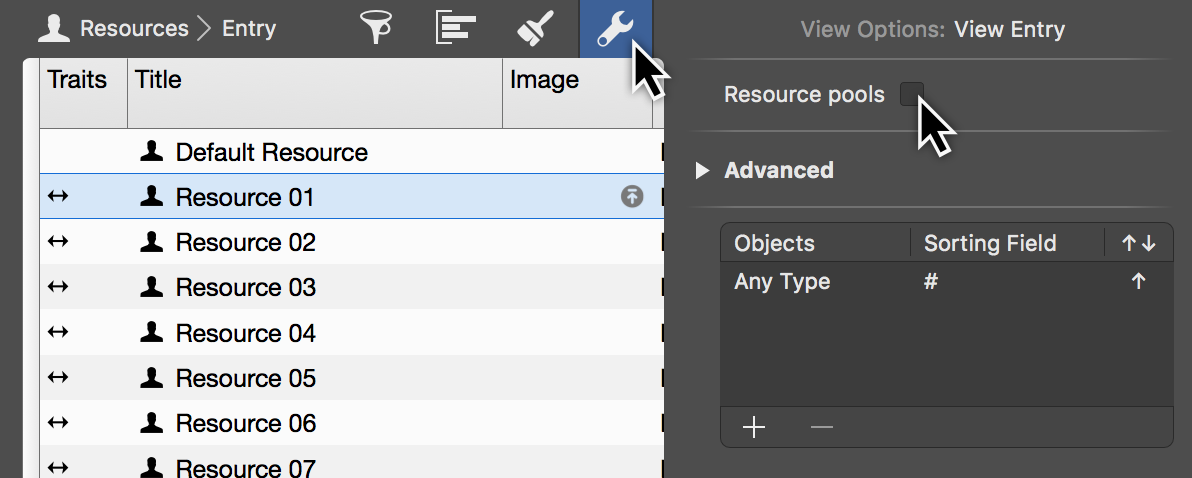
In the View Options Inspector mark/unmark the checkbox next to the Resource Pools option.
This option lets you show/hide all resource pools in the view.
|
|
The resources connected to a resource pool are marked by a double-headed arrow icon in the Info column if you have chosen to hide resource pools. |
Access permissions
Password protection
In Merlin Project you can protect individual project files with individual passwords and access permissions. To do this, at least one resource must be an active user.
|
|
Each project comes with guest access by default. That means it is unprotected and can be opened and edited by third parties using Merlin Project. |
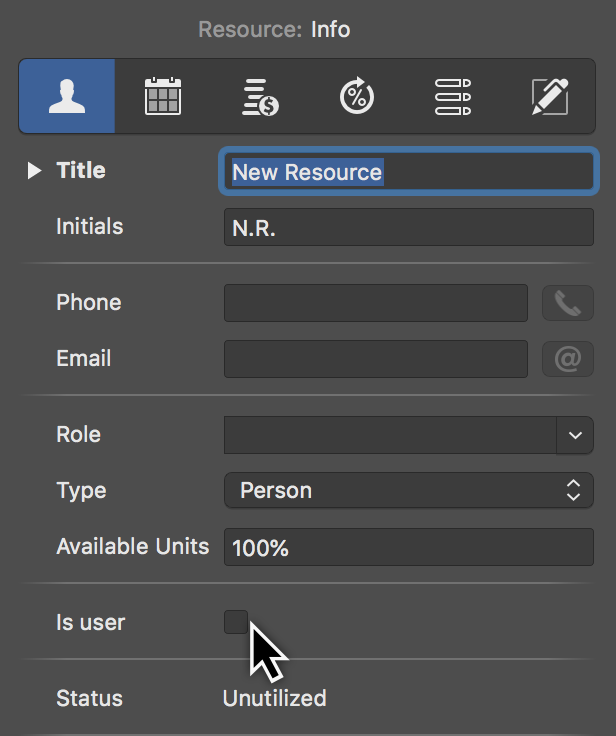
At least one resource is required in the project to activate password protection:
-
Create a resource if one doesn’t exist
-
In the resource Inspector, tick the checkbox next to the option Is User.
-
Click the Set Password button
-
Set a password
-
Disable guest access, so unauthorized people will no longer be able to access the project.

|
|
The password cannot be reset afterwards, that means you should memorize it well. |
Permissions
It is also possible to configure access permissions for all resources in the project.
The access permissions apply to the project when opened in Merlin Project and via Merlin Server.
Access permissions apply not only to logging in, but also to the user’s access to the respective project.
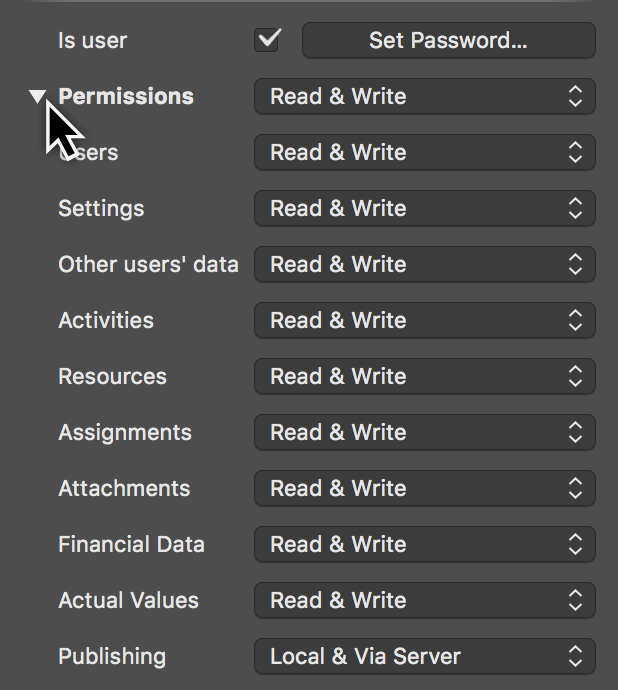
Click the triangle to expand the selection for the individual permission options.
Configure the access permissions for the selected resource as required.
|
|
Note that at least one resource in the project must have all permissions granted to him/her. |
For example, use access permissions to control whether a resource can only see and edit the activities *assigned to him/her in the project.
Login
The protected project files can now only be opened with a user name (resource) and password.
Merlin Project
When you open a protected project file in Merlin Project, a Login window appears.
If there are multiple users, select the name from the drop-down menu. Then enter the corresponding password for the user.
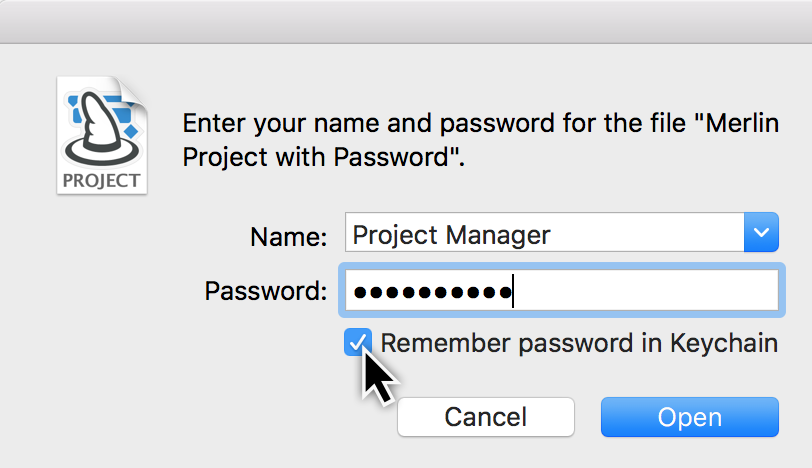
Optionally tick the checkbox next to Remember password in Keychain. This will save the password for your user in the Keychain. The next time the project file is called up, the Keychain password will be entered automatically in the password field.
Then click Open.
Merlin Project on iOS
When opening a protected project file in the iOS app, Authentication appears.
Select the name if there are several users. Then enter the relevant user password.
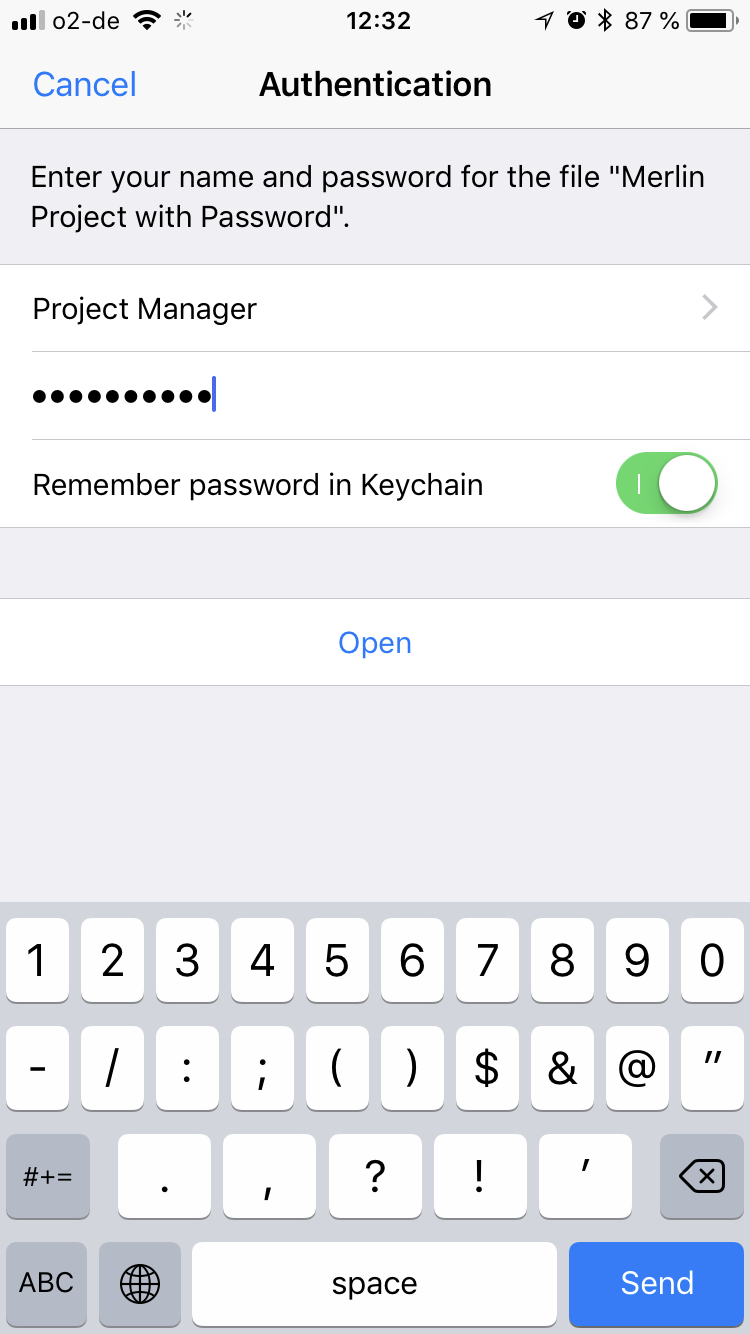
Optionally, tap Remember password in Keychain to save the password for your user in the Keychain. The next time the project file is called up, the Keychain password will be entered automatically in the password field.
Then tap on Open.
Merlin Server
In Merlin Server protected project files are identifiable by a padlock.
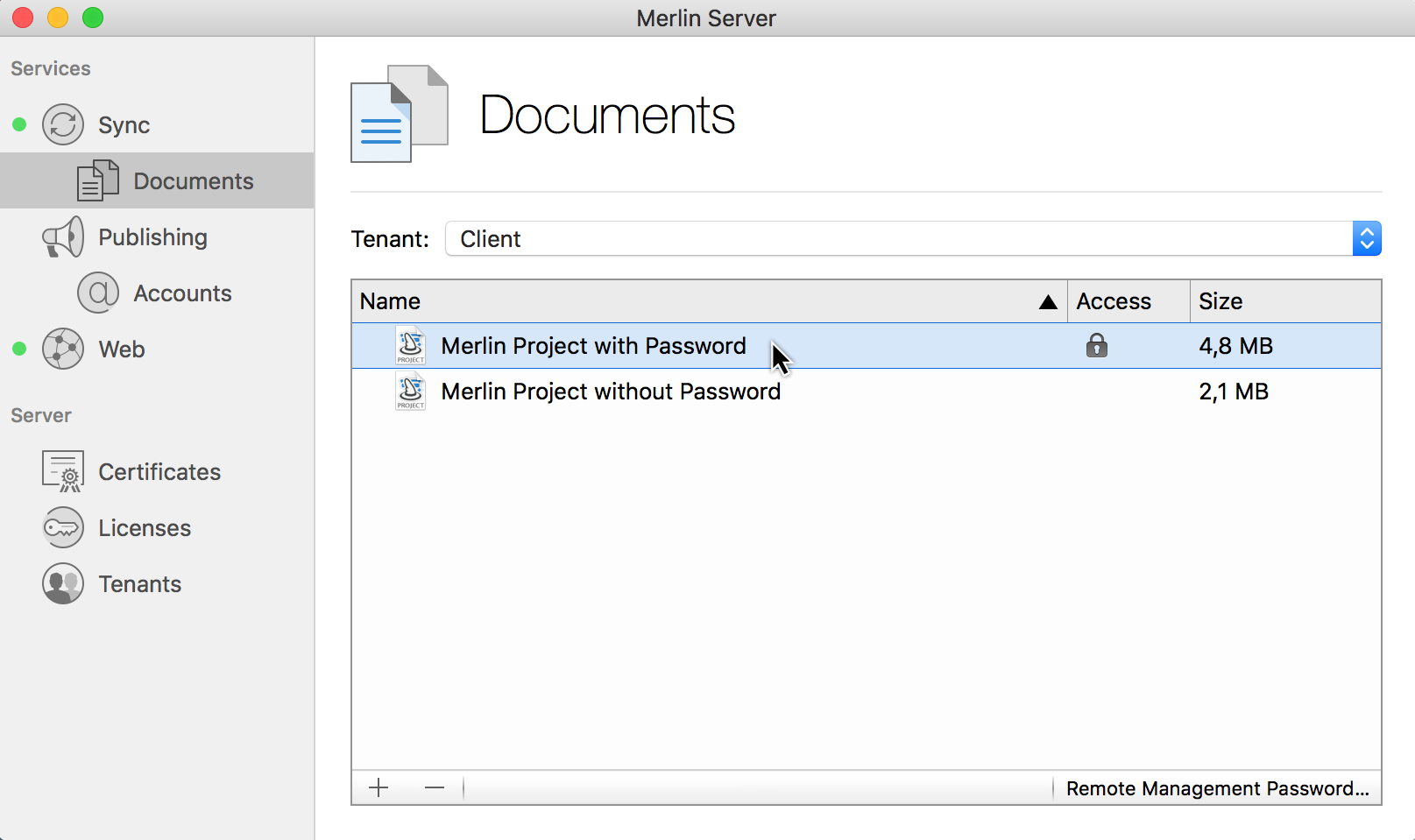
When opening a protected project file with Merlin Project, the Login window appears.
If a protected project file is opened with a web browser, it appears in the project list with a padlock.
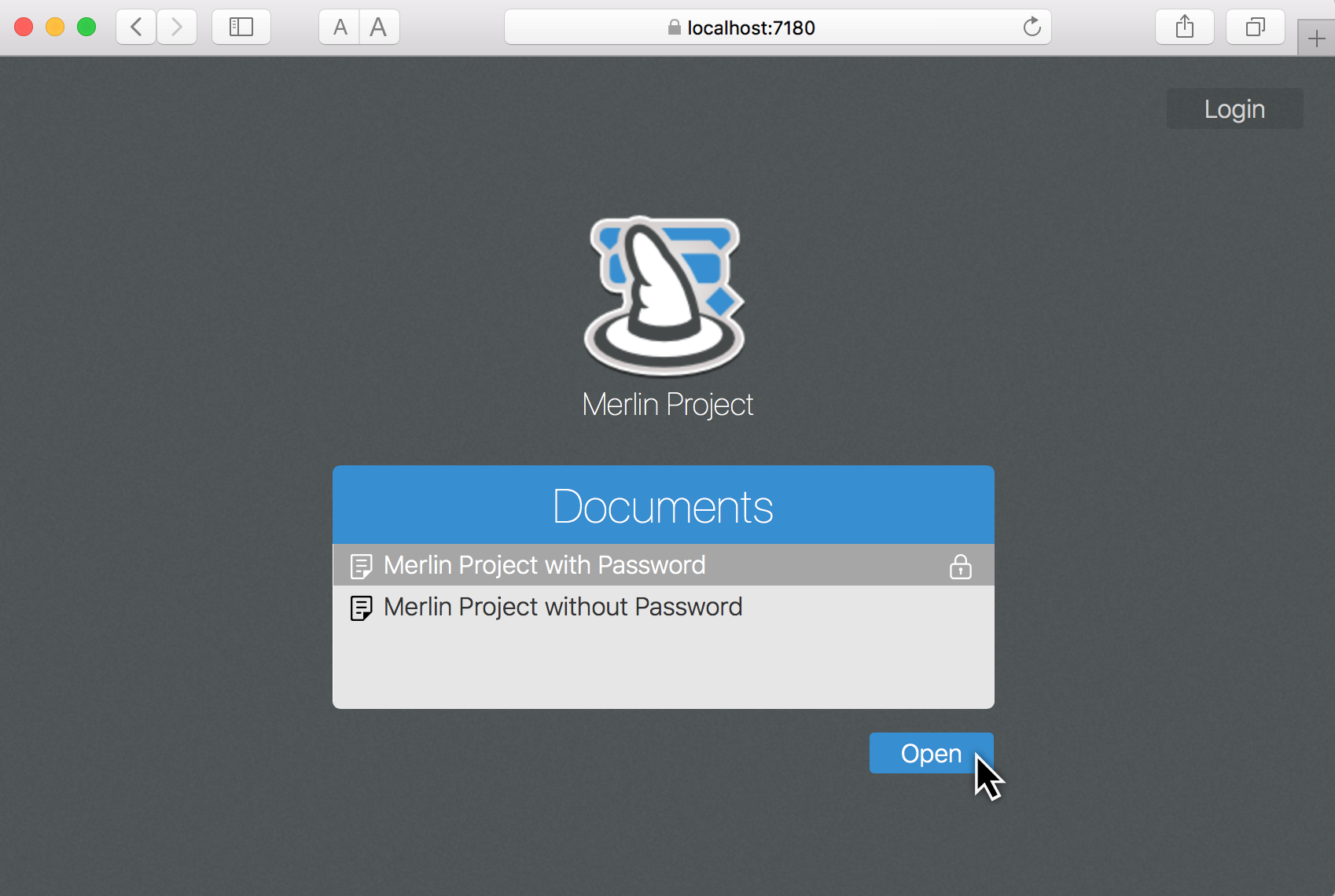
Click Open, then Login will appear.
Select the name if there are several users. Enter the relevant user password.
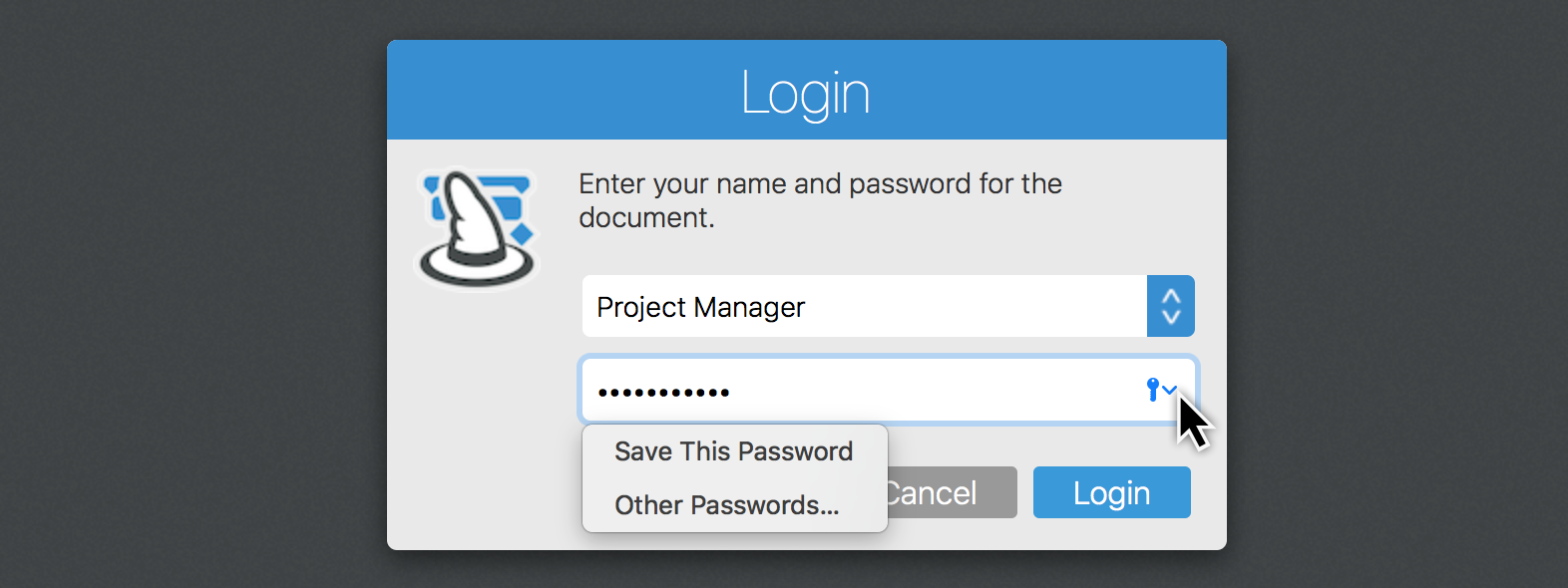
In Safari click the Key. A context menu will then appear in which you can save the password to the Keychain. The next time the project file is called up, the password from the Keychain is entered automatically in the password field.
Then click Login.
Visibility
The projects available in Merlin Server are displayed in a list when logging in using Merlin Project or any web browser.
You can make projects invisible to unauthorized persons. Only those who are users and have a corresponding password can log in and view the list of invisible project files.
|
|
By default, all projects are visible to everyone. |
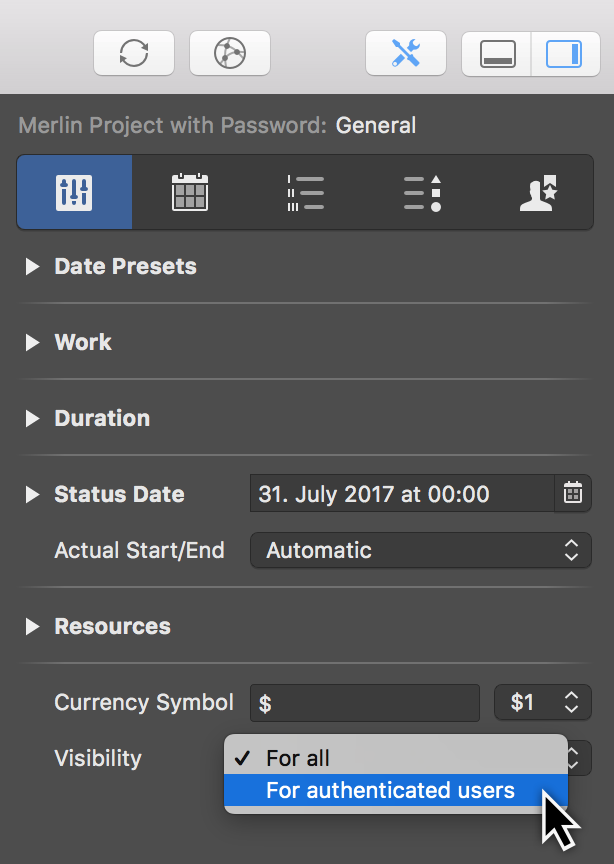
To change this, go to Settings → General, and under the Visibility option set the function For all to For authenticated users.
This means that the project will only be visible if a user created in the project logs in to Merlin Server or Merlin Project with the corresponding password.
Web browser login
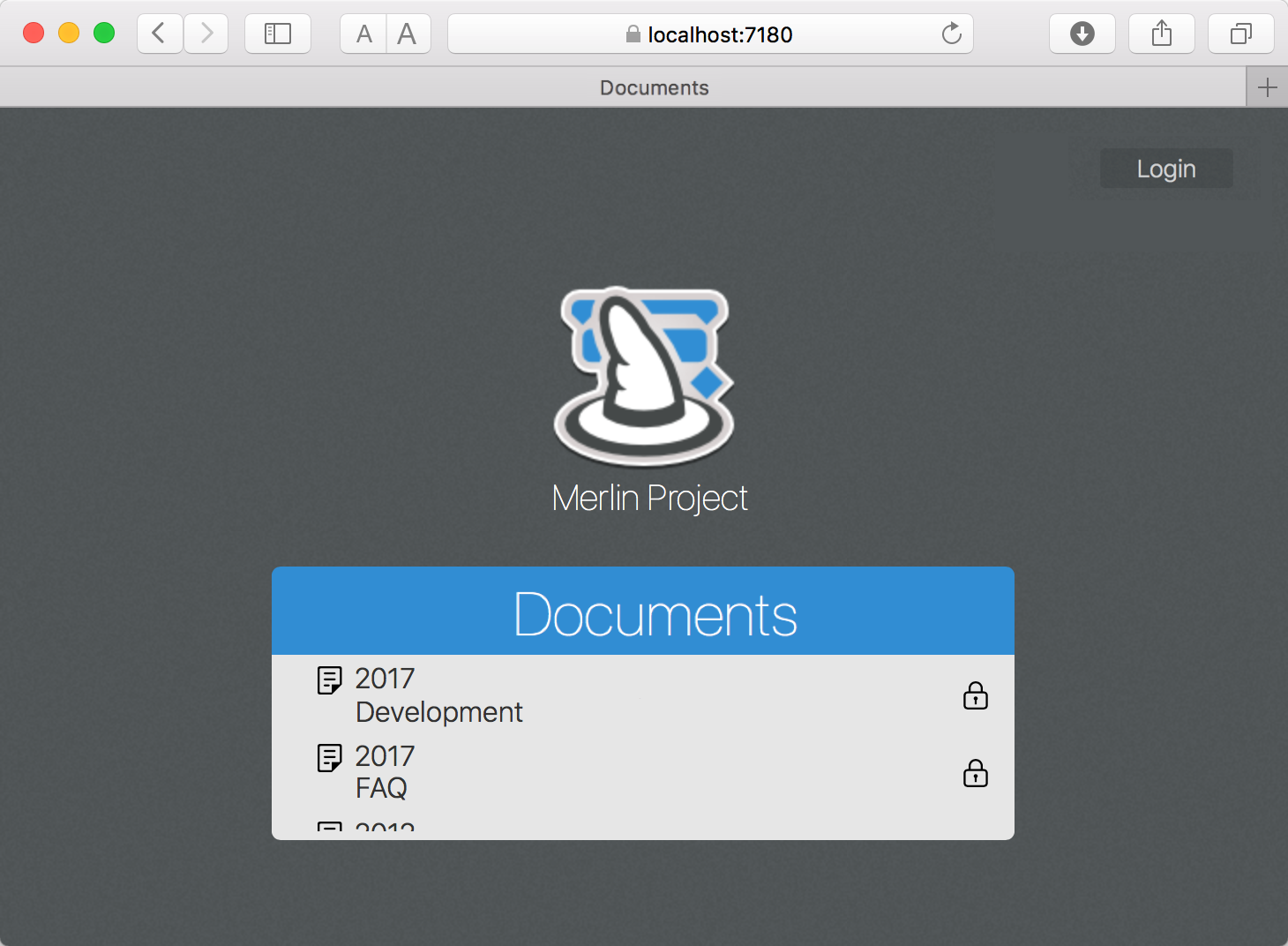
-
Click the Login button.
-
Log in with the username and password.
-
Now you will see all projects where you are included as a user.
Publishing
This short guide describes how to use the »Publish« function in Merlin Project and automate the export of project content.
The »Publish« function lets you configure Actions, with which you can provide project content on a regular basis to other users.
To configure your publishing actions:
-
Call from the menu File → Publish → Settings…
-
Click one of the three available publishing options or click the + symbol.
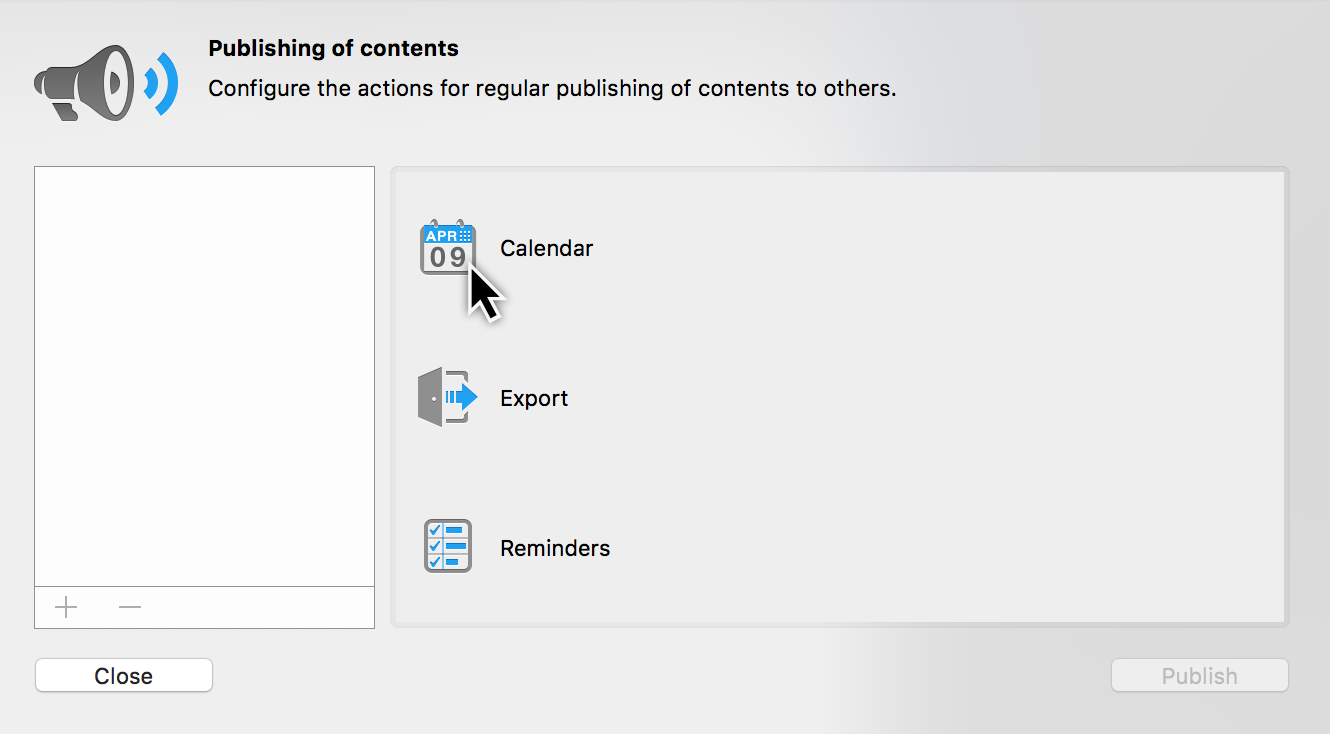
You can choose between three publishing options:
|
|
To be able to publish to Calendar and Reminders, you will need to allow access for Merlin Project to those apps in the macOS system preferences. |
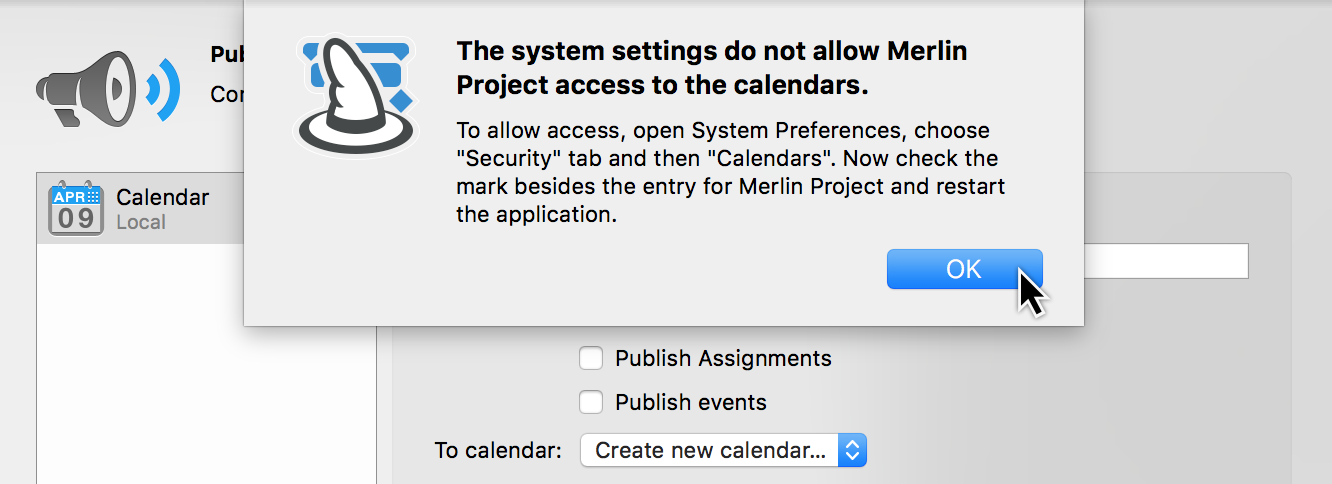
In macOS open System Preferences > Security & Privacy > Privacy. Select Calendar and check the mark besides the entry for Merlin Project. Select Reminders and check the mark besides the entry for Merlin Project as well.
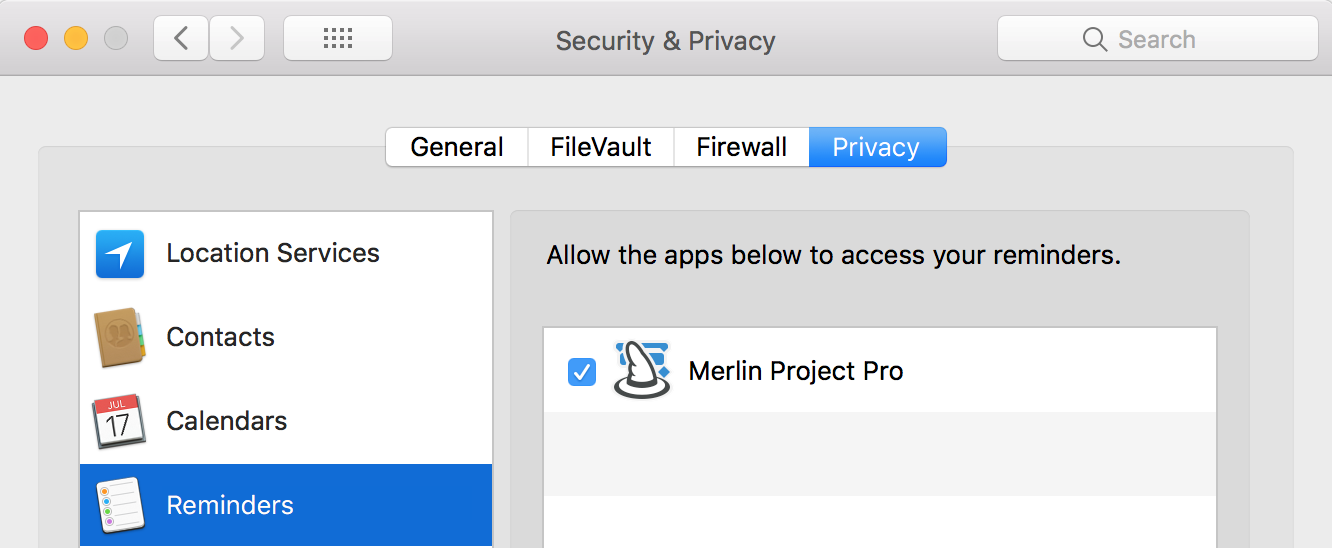
Calendar
The Calendar publish option lets you publish project content locally to the macOS Calendar app.
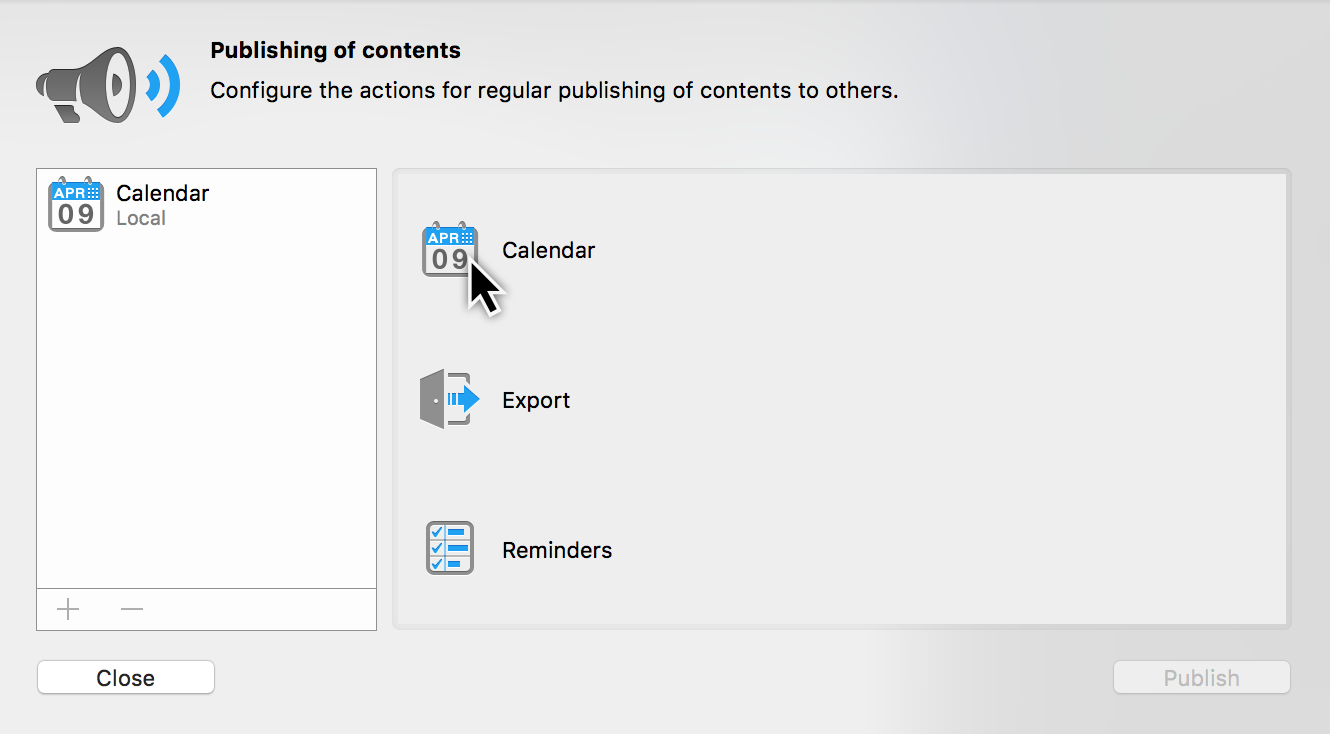
-
Click Calendar or the + symbol to create a new publishing action.
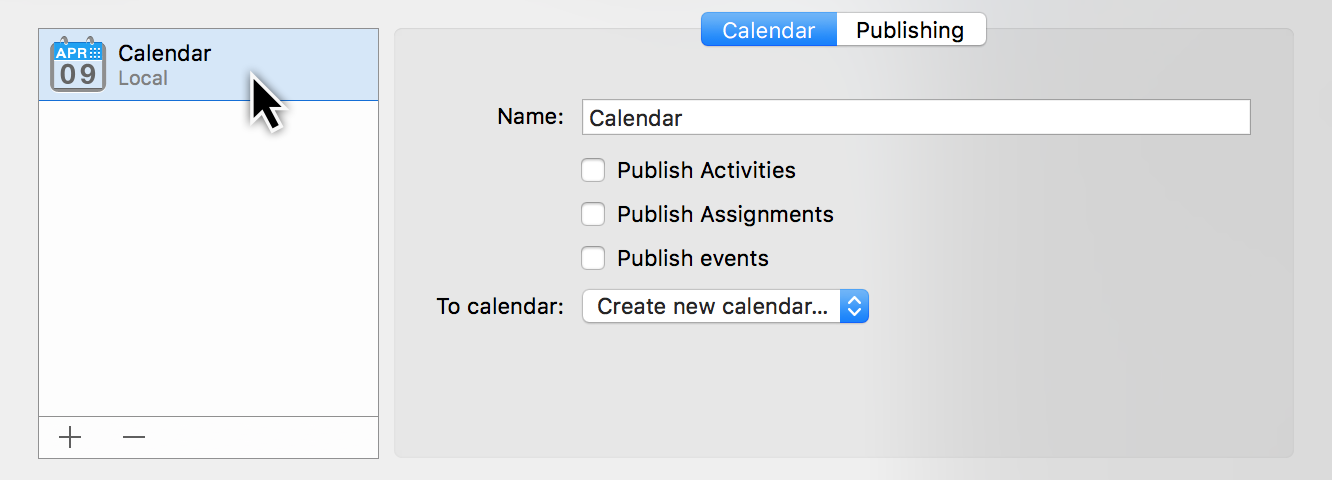
-
Enter a Name for the calendar publishing action.
-
Choose which information should be published and is to appear in the Calendar* app.
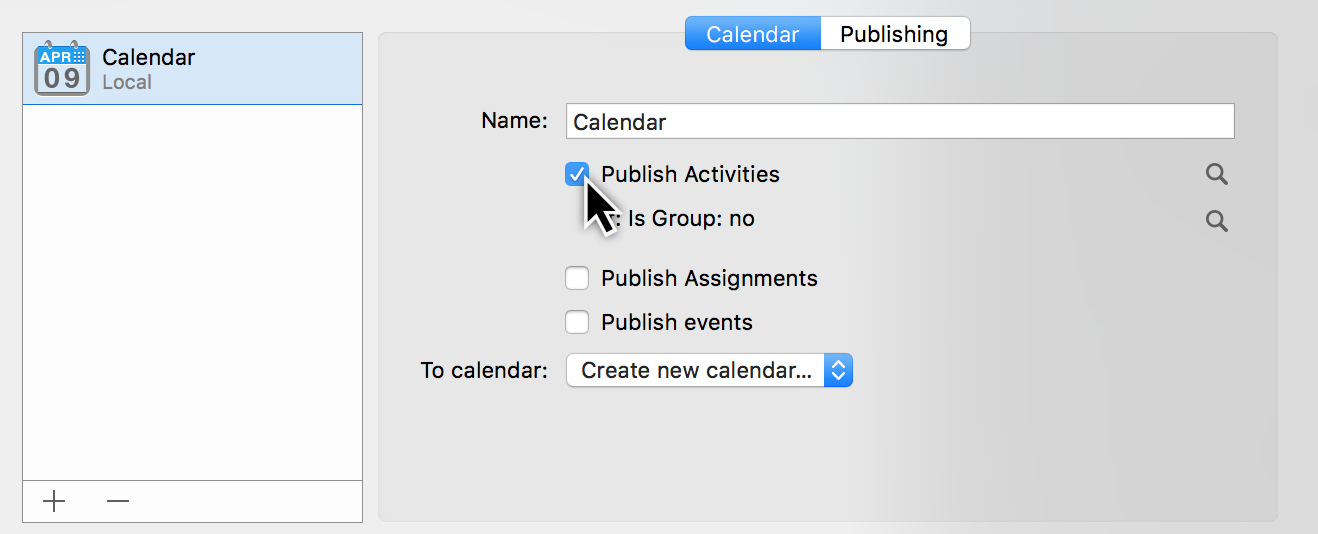
-
Publish Activities
-
Publish Assignments
-
Publish Events
Check which ever options desired.
Click the magnifying glasses to configure the options for publishing activities, assignments, and events to the calendar.
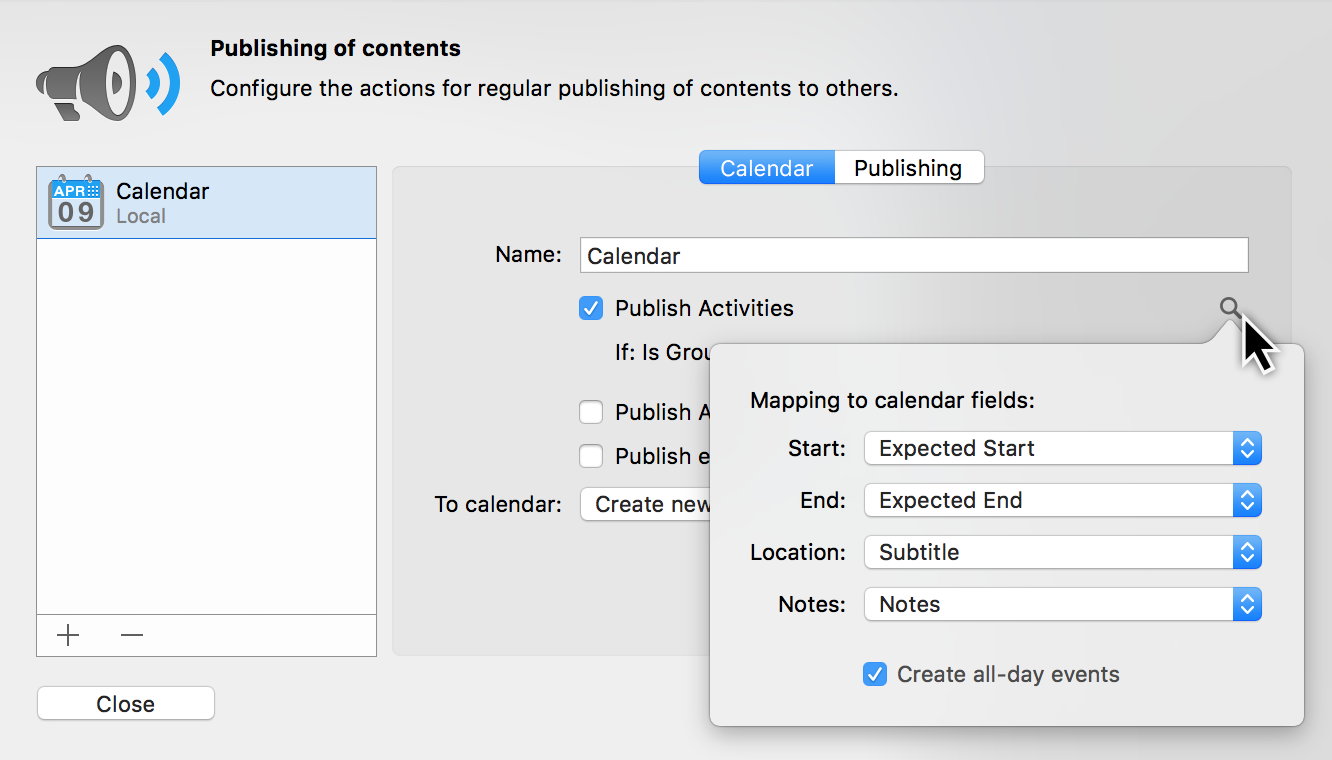
The first magnifying glass lets you map the Merlin Project information to the calendar fields. The calendar fields are set by the macOS Calendar app and cannot be changed.
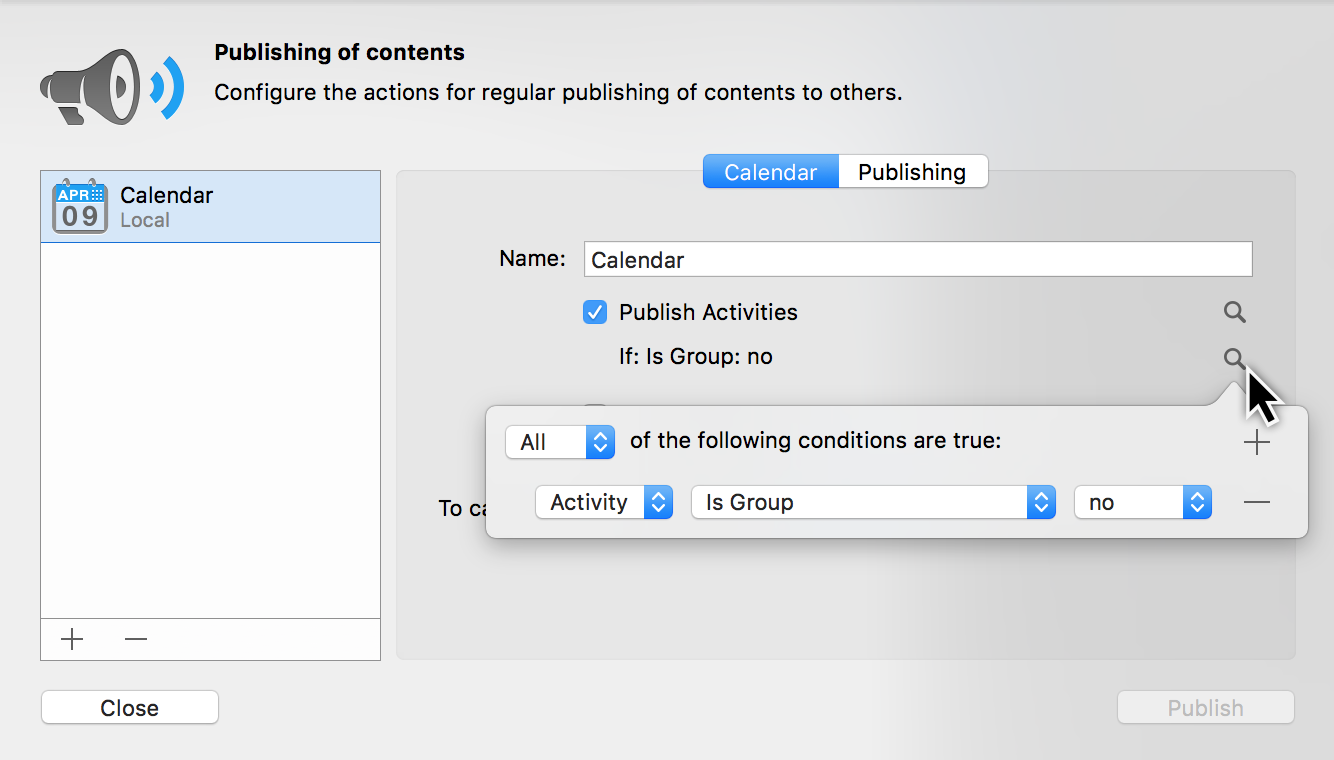
The second magnifying glass includes various publishing conditions. This allows you to filter the information you publish in the calendar.
You can also modify the above options for any of your calendar publishing actions at any time.
In the final step, under the To calendar option, select a calendar from the Calendar app or Create new calendar.
|
|
This step cannot be undone! If a calendar that already exists in the Calendar app is selected, publishing will delete the existing calendar entries. |
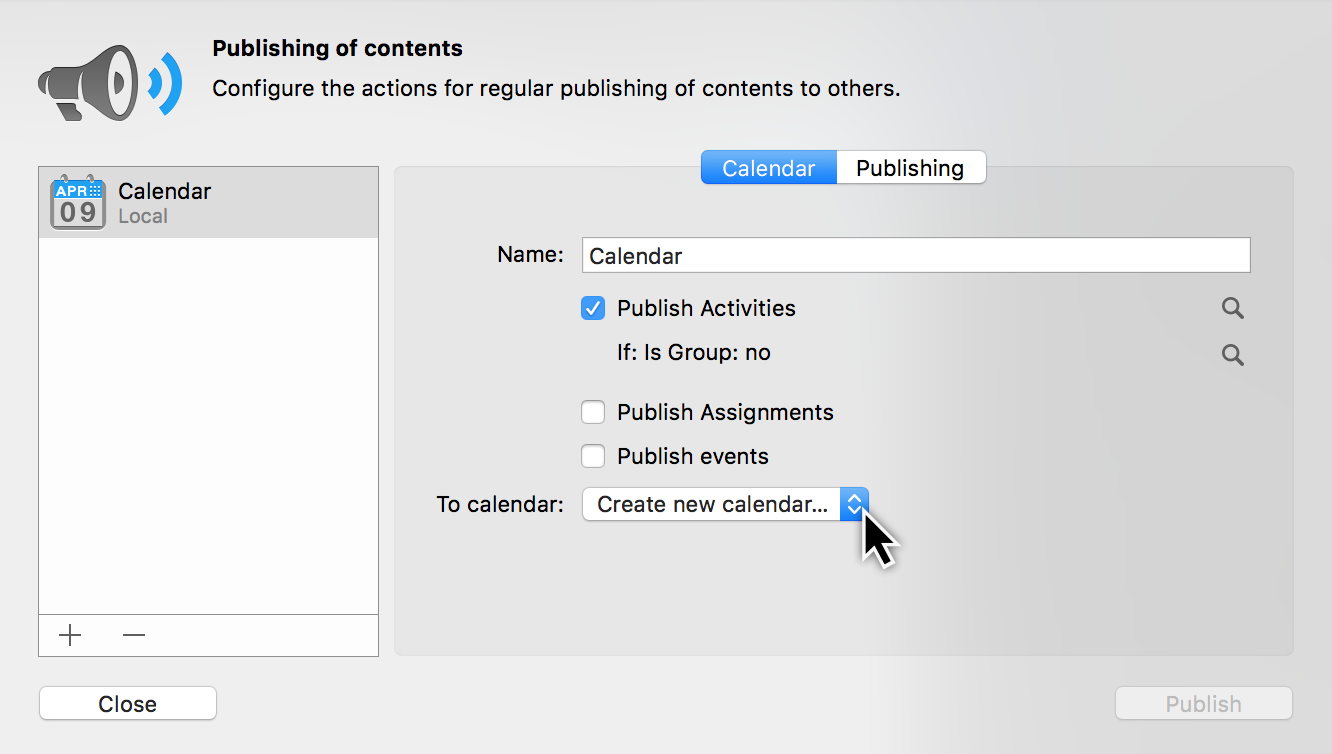
|
|
It is best to create a new calendar to publish to. To do so, select the Create new calendar… option from the drop-down menu. |
Export
The Export publish option lets you publish project content using the built-in exporter.
Click Export or the + symbol to create a new publishing action.
Configure the export publishing action. Following options are available:
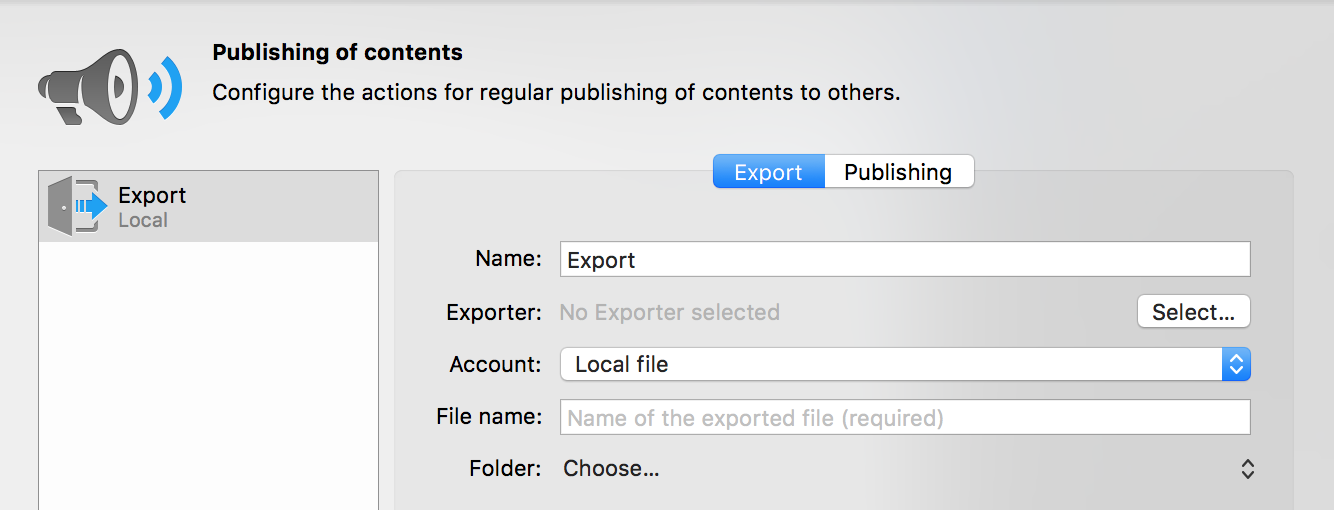
Name
Enter a Name for this publishing action.
Exporter
Click Select…. In the Export window, select a publishing format and configure it as required.
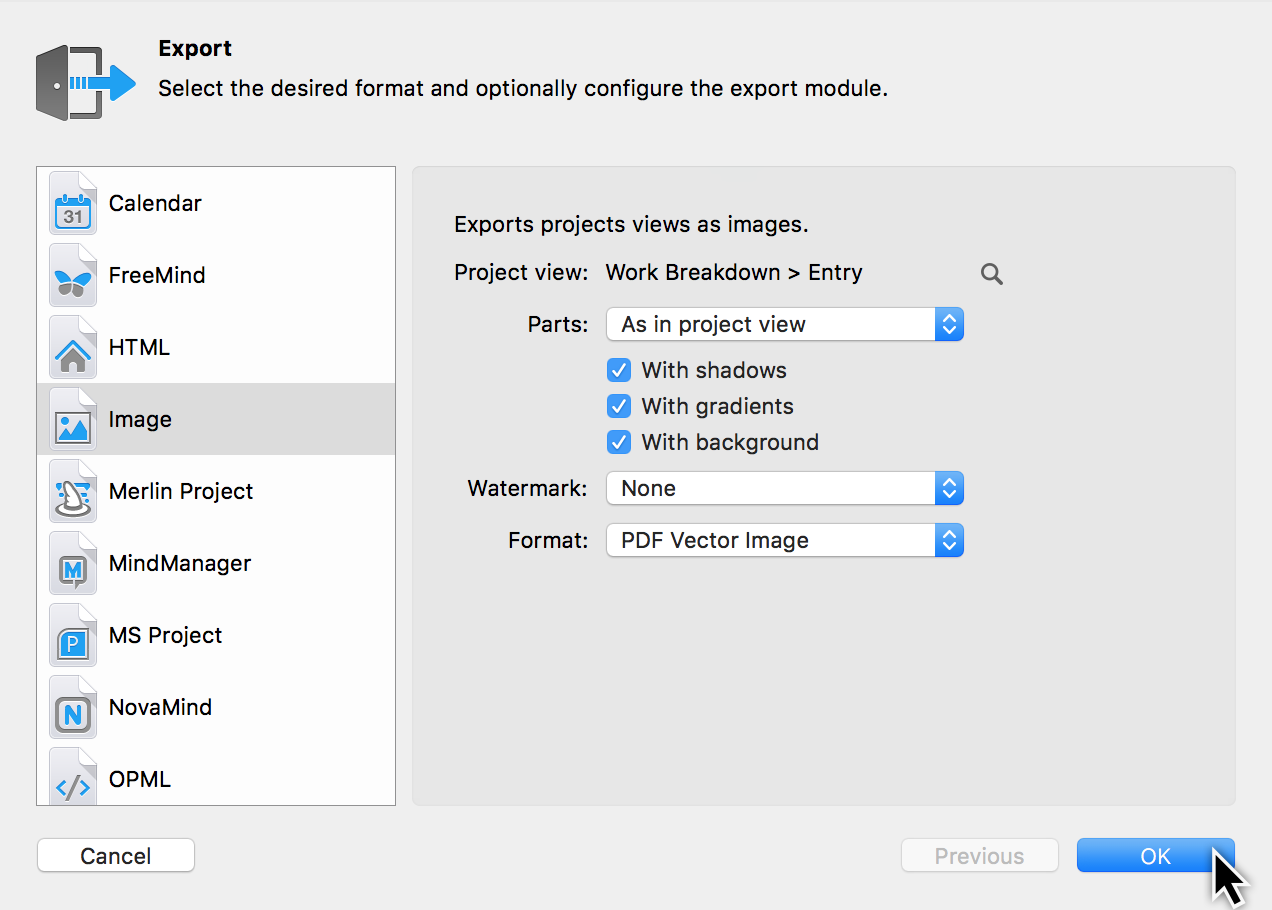
Account
The Account option is set to Local file by default. This means, the export is published in a folder locally to your Mac.

If you have defined FTP, WebDAV / SMTP Accounts in Preferences - Accounts, you can select an Account here in case you want to automatically upload the exported content on an FTP or WebDav Server or send it as e-Mail.
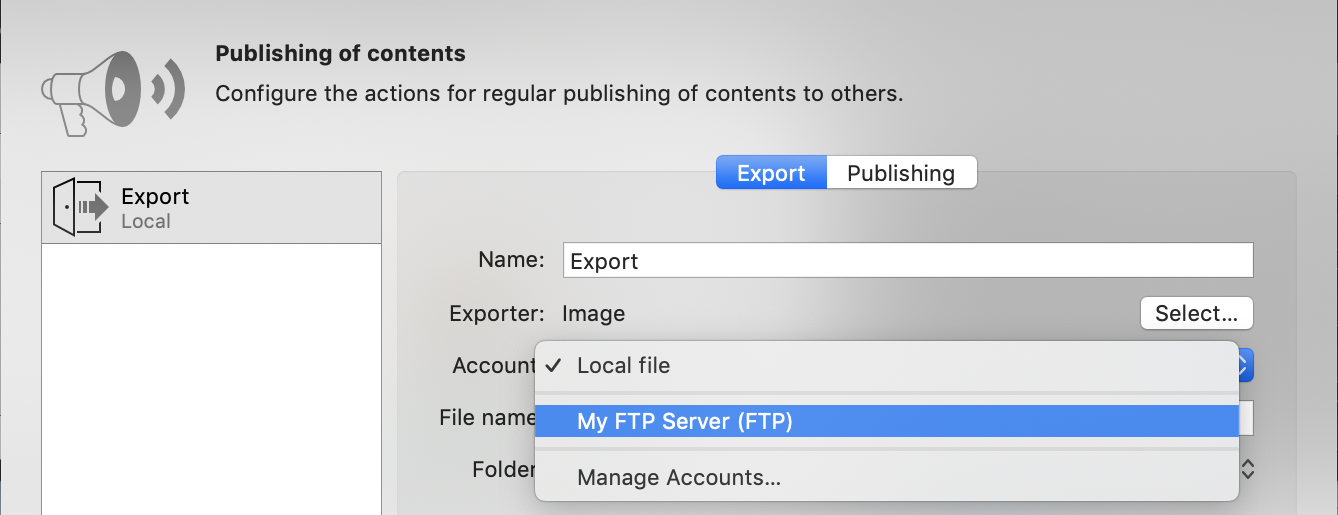
Select Manage Accounts… to insert new accounts if needed.
File name
Enter the name of the exported file.
Folder
Define the folder in which you want to save the file to. Click Choose… and select a folder on your Mac.
Exporting via Merlin Server publishing accounts
Do you have a Merlin Server installation and edit currently a subscribed project from there?
In this case, you can select an Account from that Merlin Server for your publishing action as well.

Reminders
The Reminders publish option lets you publish project content to the macOS Reminders app.
Click Reminders or the + symbol to create a new publishing action.
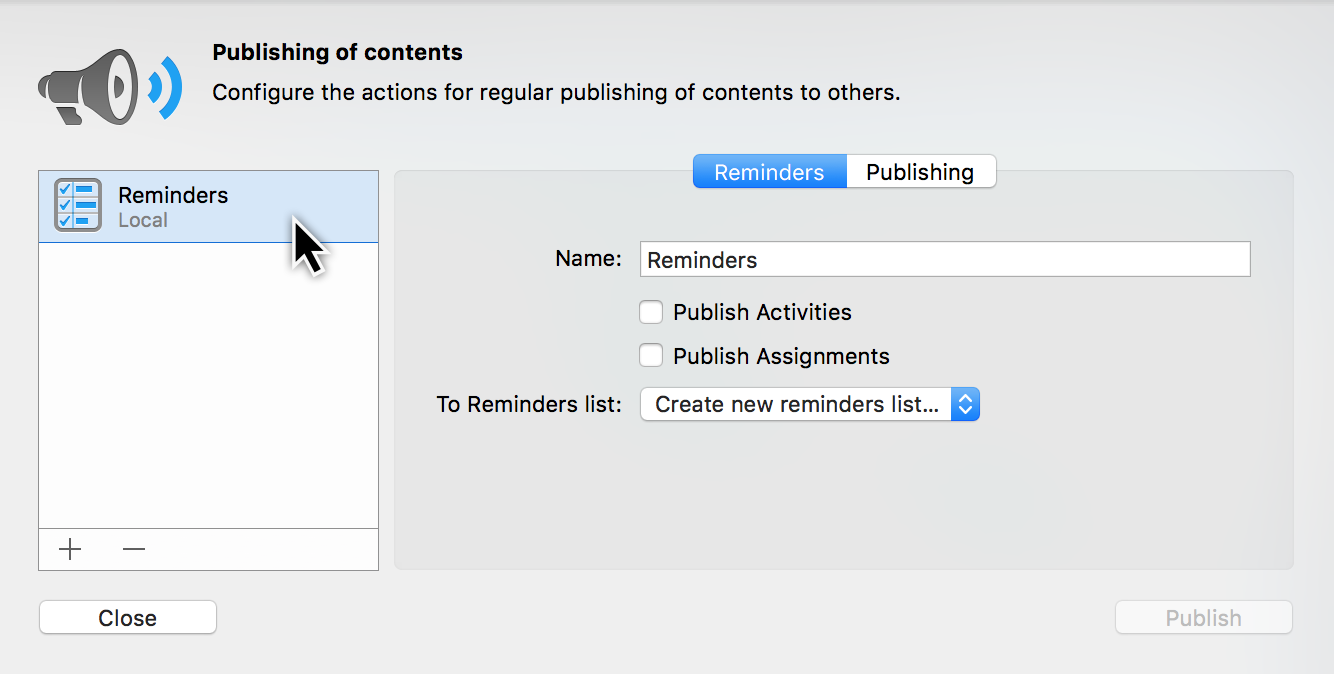
-
Enter a Name for the Reminders publishing action.
-
Choose which information should be published and is to appear in the Reminders app.
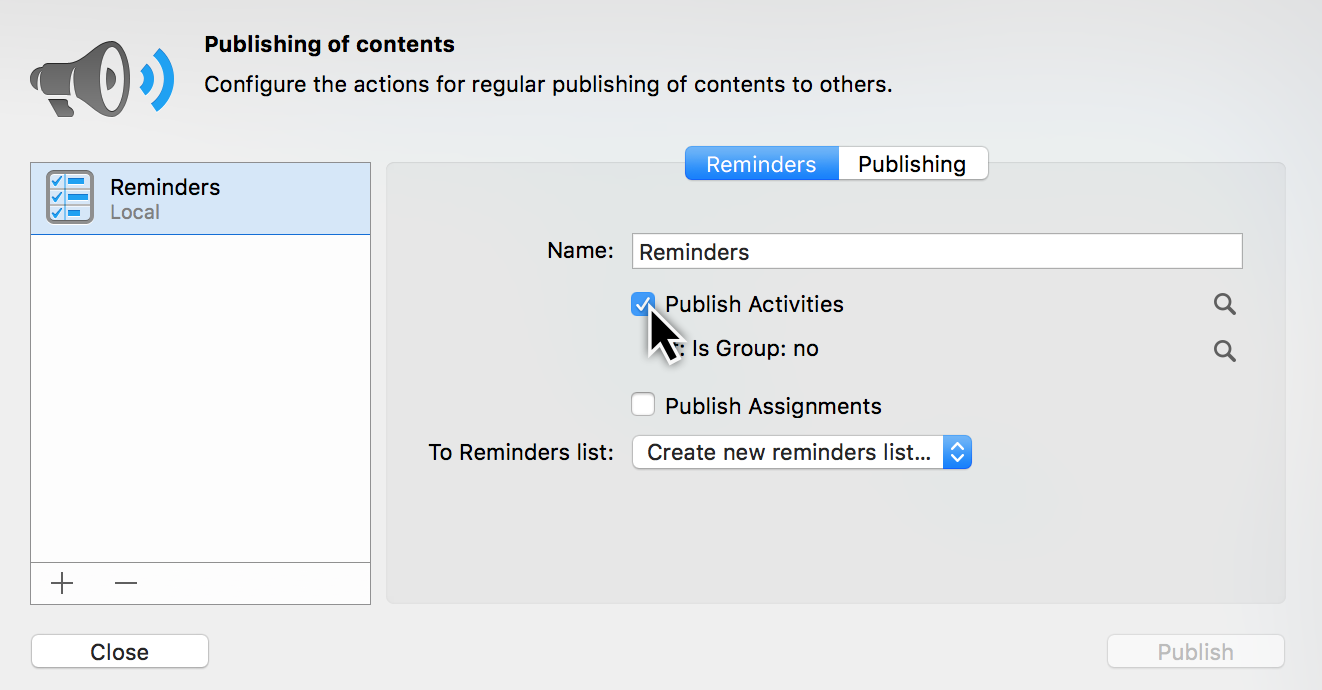
-
Publish Activities
-
Publish Assignments
Check which ever options desired.
Click the magnifying glasses to configure the options for publishing activities and assignments to Reminders.
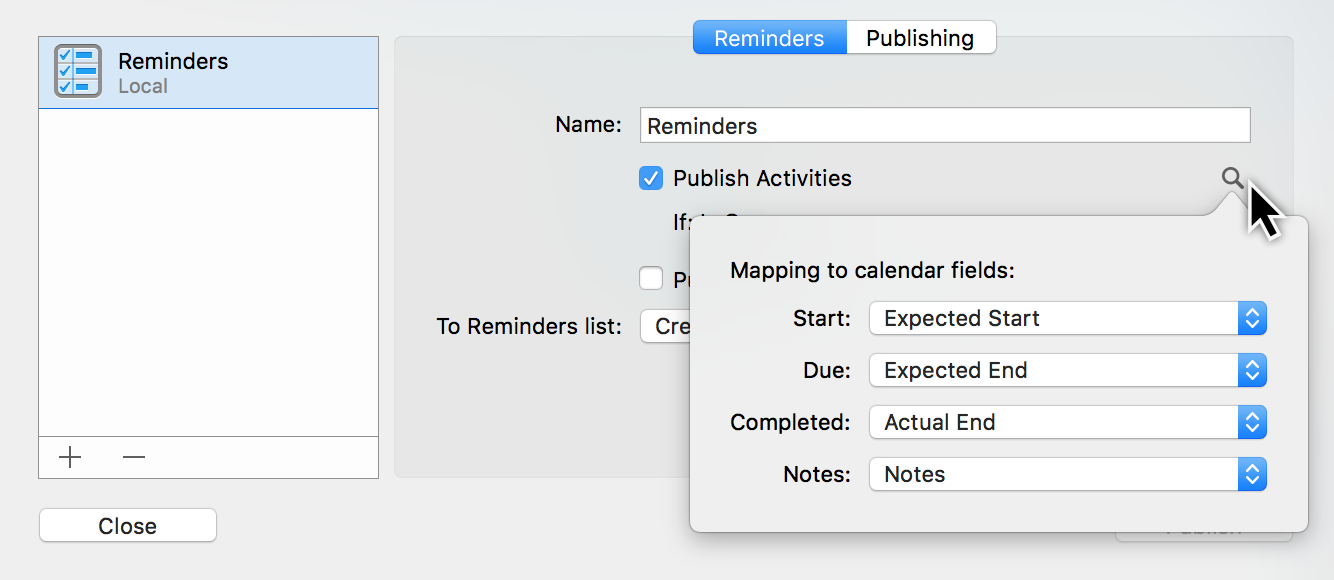
The first magnifying glass lets you map the Merlin Project information for the calendar fields.
|
|
Calendar fields are set by the macOS Reminders app and cannot be changed. |
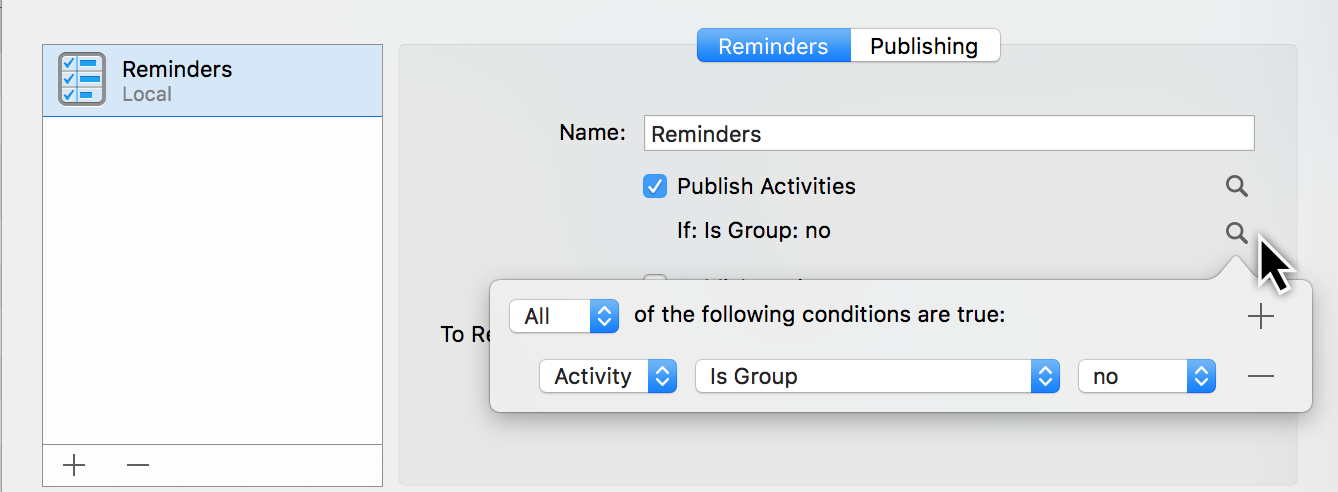
The second magnifying glass includes various publishing options. This allows you to filter the information you publish in the reminders.
You can also modify the above options for any of your calendar publishing actions at any time.
In the final step, under the To Reminders list option select a Reminders list from the Reminders app or create a new Reminders list….

|
|
This step cannot be undone! If a reminder that already exists is selected, publishing will delete the existing reminders. As such, it’s best to create a new reminders list to publish to. To do this, select the option Create new reminders list… from the drop-down menu. |
Publishing tab
In the Publishing tab you can configure your publishing action to:
-
publish when saving
-
publish regularly on defined days and time
Just enable the checkbox next to Publish: When saving. This will update the published content automatically each time you save your project.
Or you select the days and time your publishing action should automatically get activated on regular basis.
This dialogue will inform you about the last published time points and if an error occurred.
|
|
Test Publishing at least once to make sure that your publishing action is set correctly and works as desired. |
Publish all
To update content manually, click the Publish button or select from the menu File → Publish → Publish.
|
|
By File → Publish → Publish all configured publishing actions are executed. |
Modify Reports
Reports provide you with a better overview of project content and information, and are perfect for forwarding to project participants.
The Report view in Merlin Project includes several preinstalled reports.
Existing reports can be used directly or adapted to your own needs.
Each report uses modules which compile the content from the various project views to produce the report.

Report modules
The modules can be clicked in the report using the mouse and modified in the Inspector.
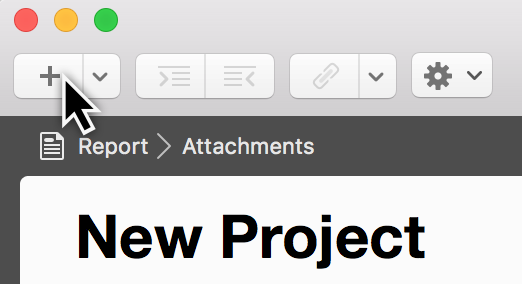
Click the plus icon to create new modules.
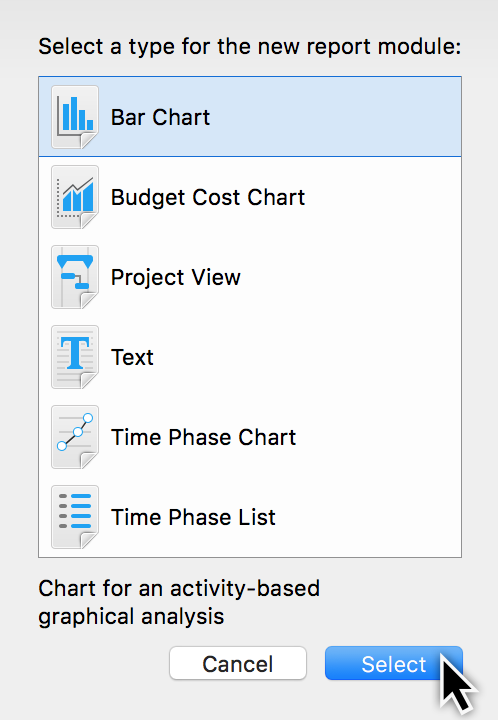
The following module types can be used in a report:
-
Bar Chart
-
Budget Cost Chart
-
Project View
-
Text
-
Time Phase Chart
-
Time Phase List
The Project View module is used most frequently. Project view columns and Gantt chart options can be modified and managed directly in the module.
Use the Filter and Filter Mode options in the Inspector to filter the display of information in the module.
Use the Grouping and Grouping Mode options in the Inspector to group the display of information in the module.
The Inspector offers different options depending on the type of report module selected.
The Budget Cost Chart provides budget columns for the chart, making it handy for creating reports with cost information.
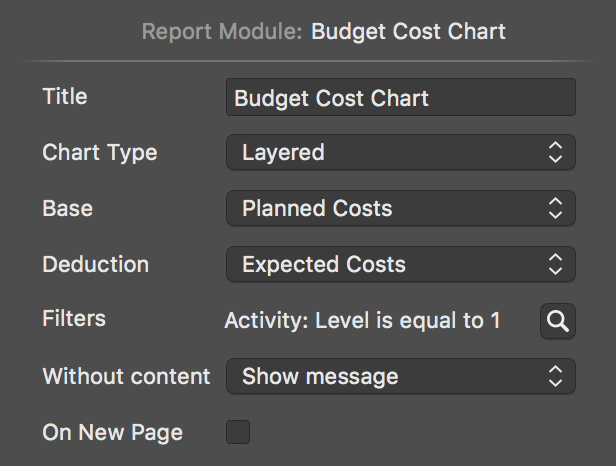
The Time Phase List, however, requires values for sampling duration and the fields.
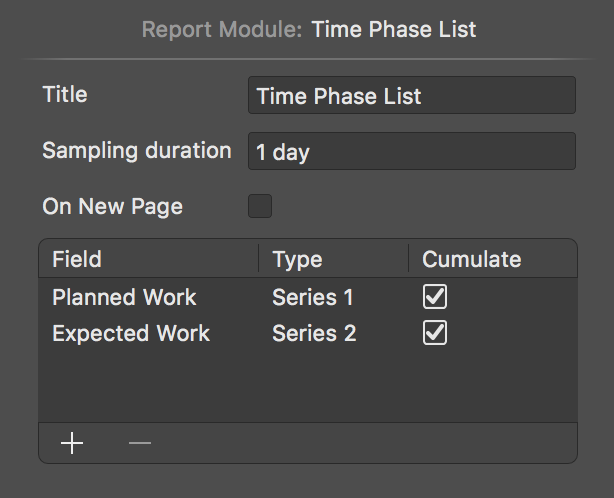
The same applies to the Time Phase Chart:
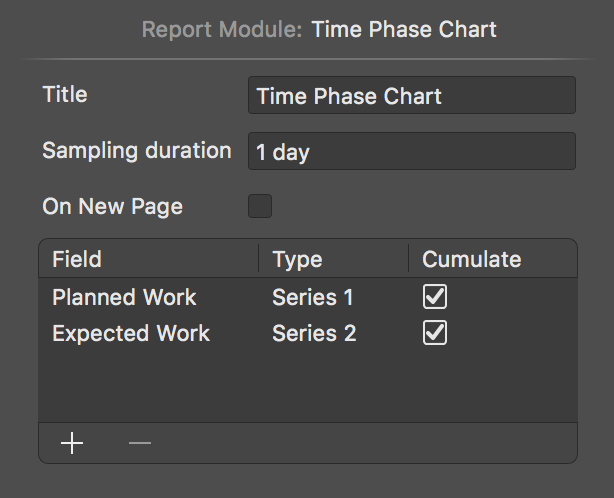
Click the plus icon to create a new field. In the Type column, set the chart display type. If you tick the cumulated checkbox you can display cumulated field values in the chart.
Creating custom report views
You can create a custom report view as follows:
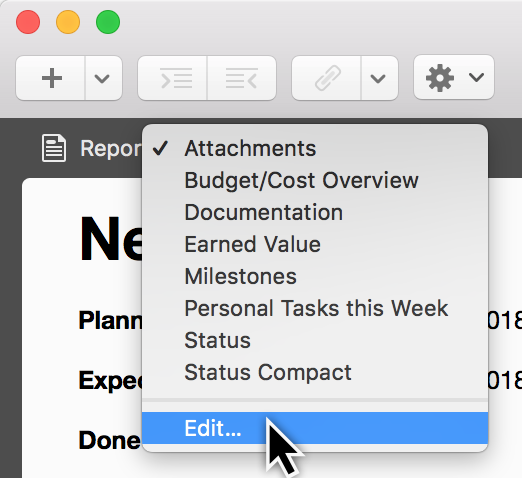
Click a report view and select the Edit option.
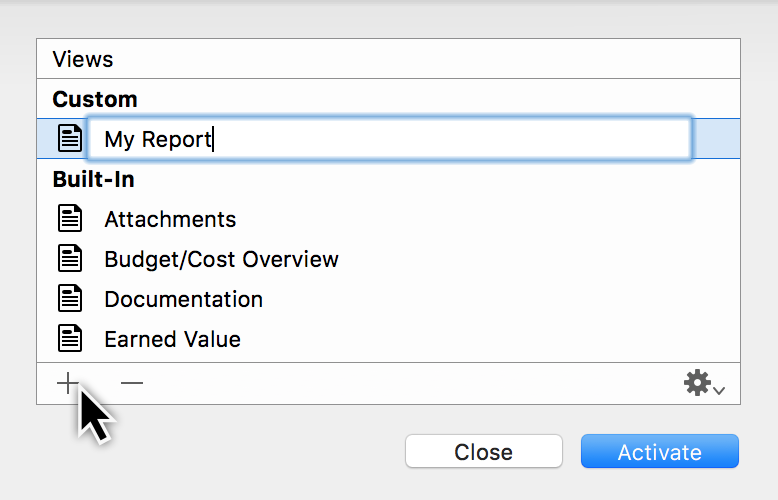
Name the new report view and click Activate.

Now continue by building the newly created report view with modules. Click the plus icon to add new modules.
Examples
To activate and deactivate columns in the Project View report module, you need to configure the actual project view instance.
Under Report → Status several project views are displayed in the modules. In the Inspector, the views for the module can be selected using the Type and View drop-down menus. In the example shown, the Slightly Behind Schedule module is selected. It uses the Work Breakdown → Status Compact view. This view is controlled by filters.
In this way, individual modules can be integrated with the filter option for activities that are, for example, on or behind schedule.
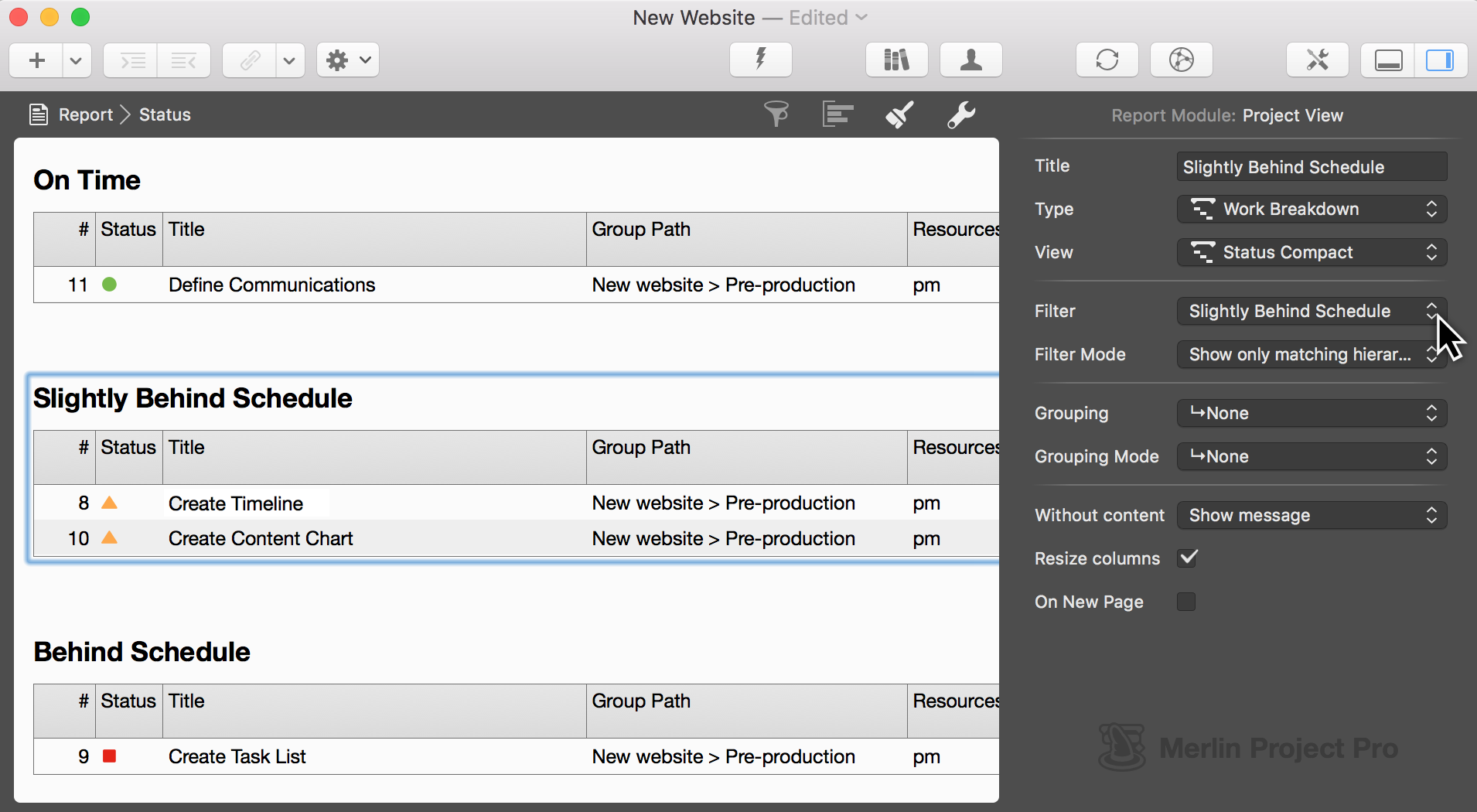
To insert another column in the module, first switch to the view that the module accesses (in this example Work Breakdown > Status Compact).
Insert the desired column by clicking the arrow in any column and then selecting the option New Column.
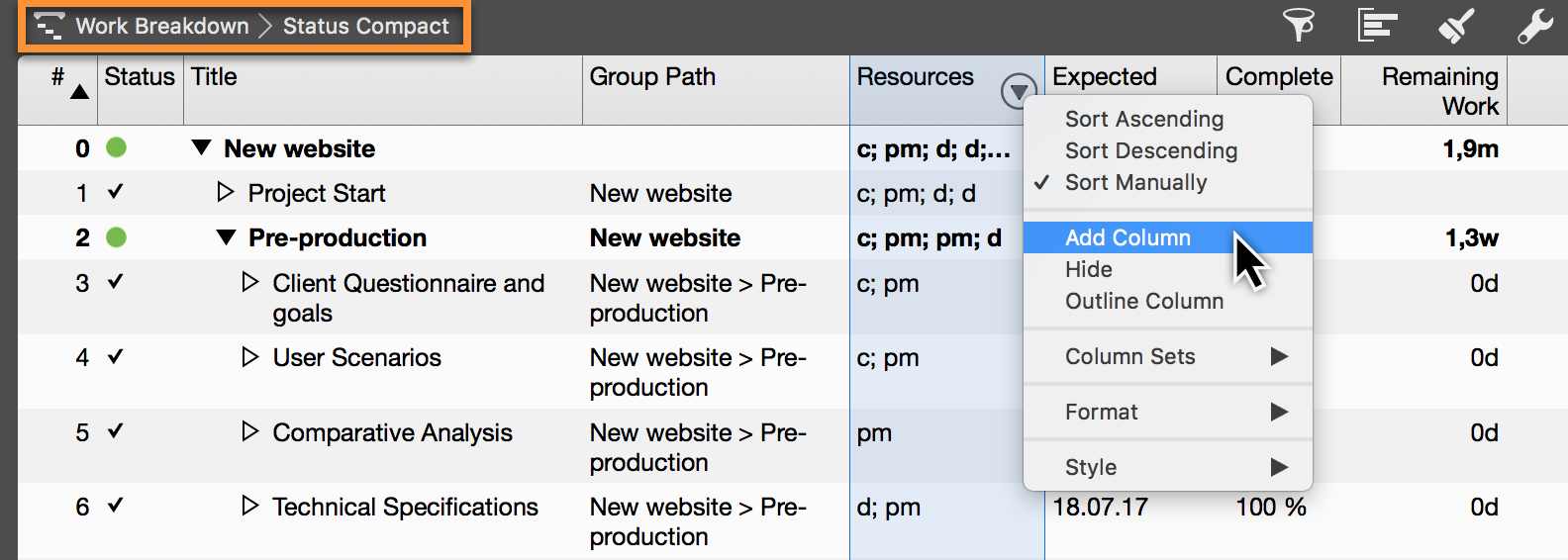
|
|
You can customize the format of the column either in the original project view or in the report module. If you want to apply the change to all report modules with this view, change the format in the original project view. |
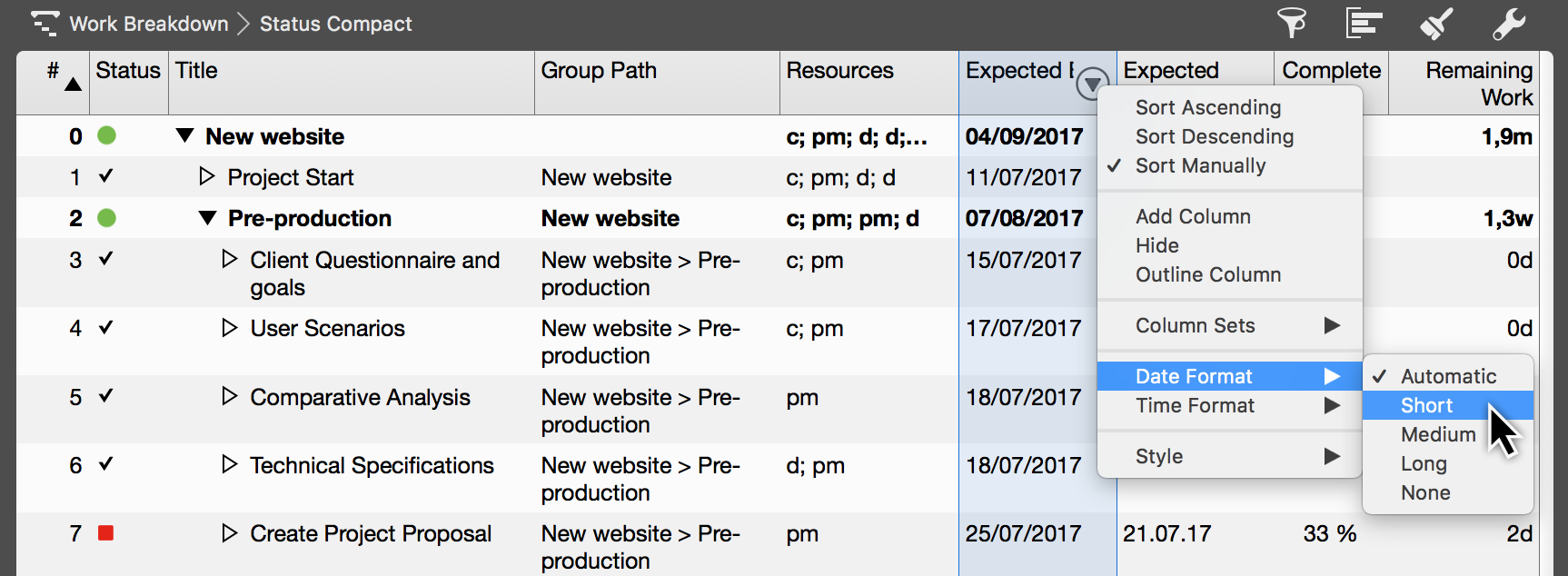
To remove the column use the delete key or click Hide in the column header.

The steps listed above produce the following column combination in the Status Compact view:

When you return to the Report > Status view, the changed columns from the view appear in the report modules.
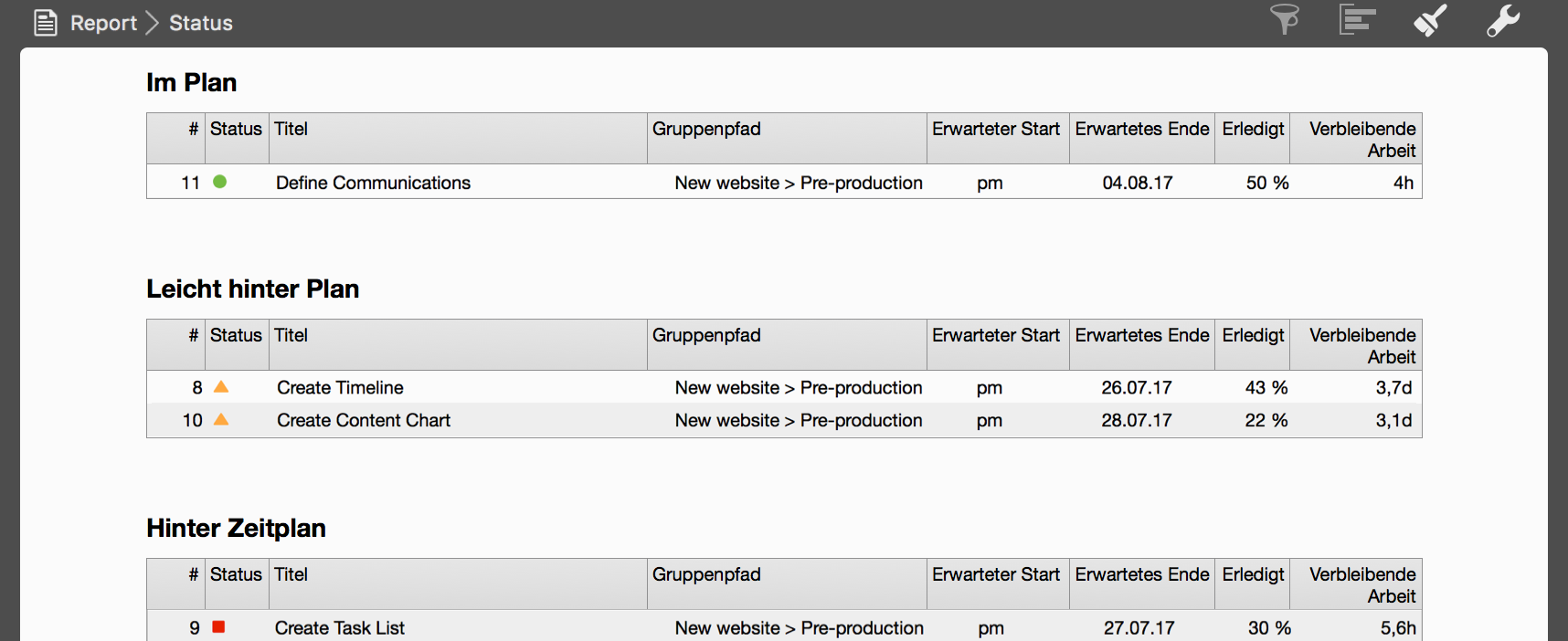
Switch to the report view Report > Earned Value.
Click the module with the Earned Value chart.
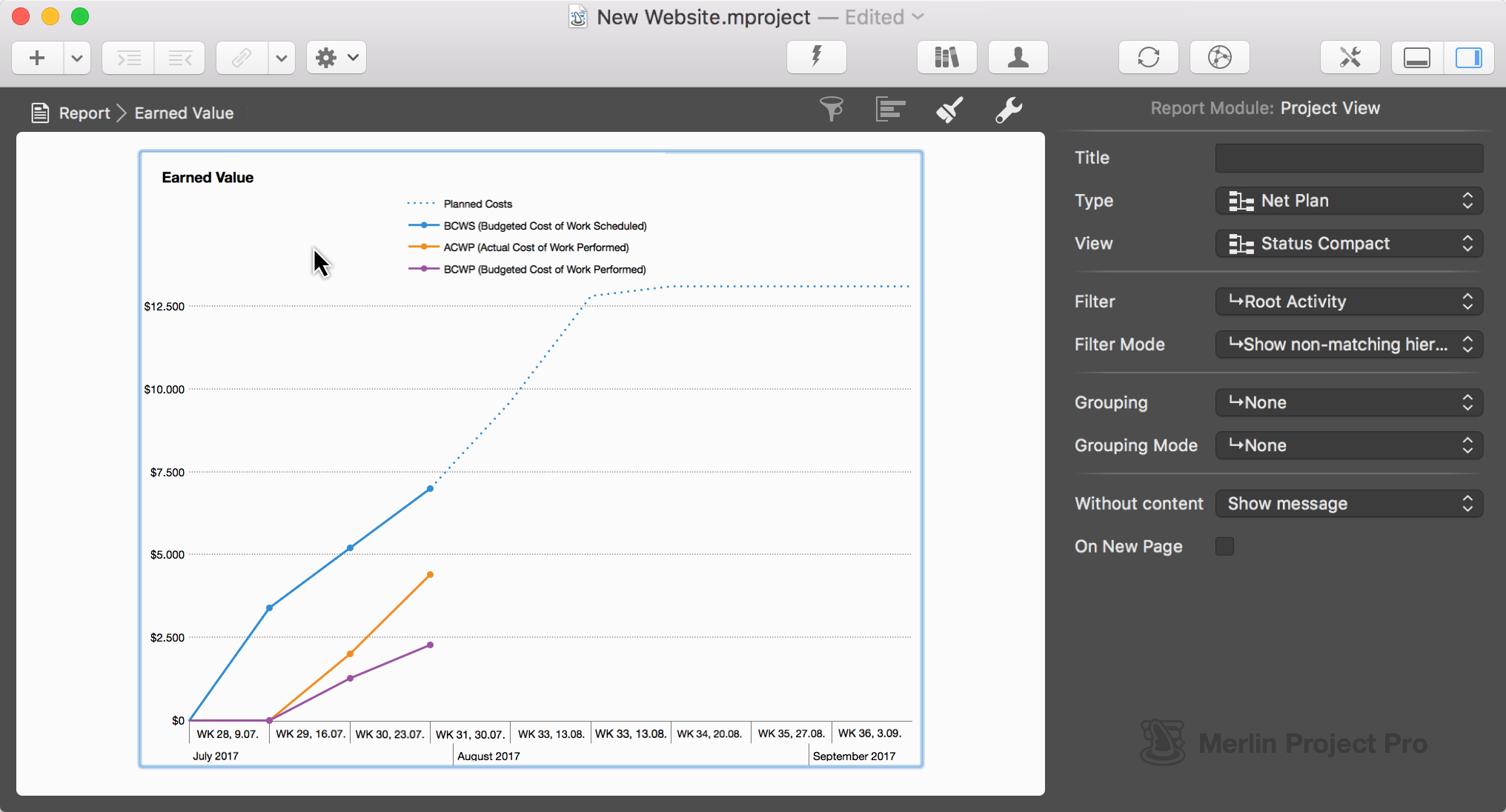
Enter the desired Sampling duration in the Time Phase Chart Inspector, for example 1 eday.
|
|
You can use days, weeks, quarters, and years. Alternatively, you can use edays, eweeks, equarters, and eyears. |
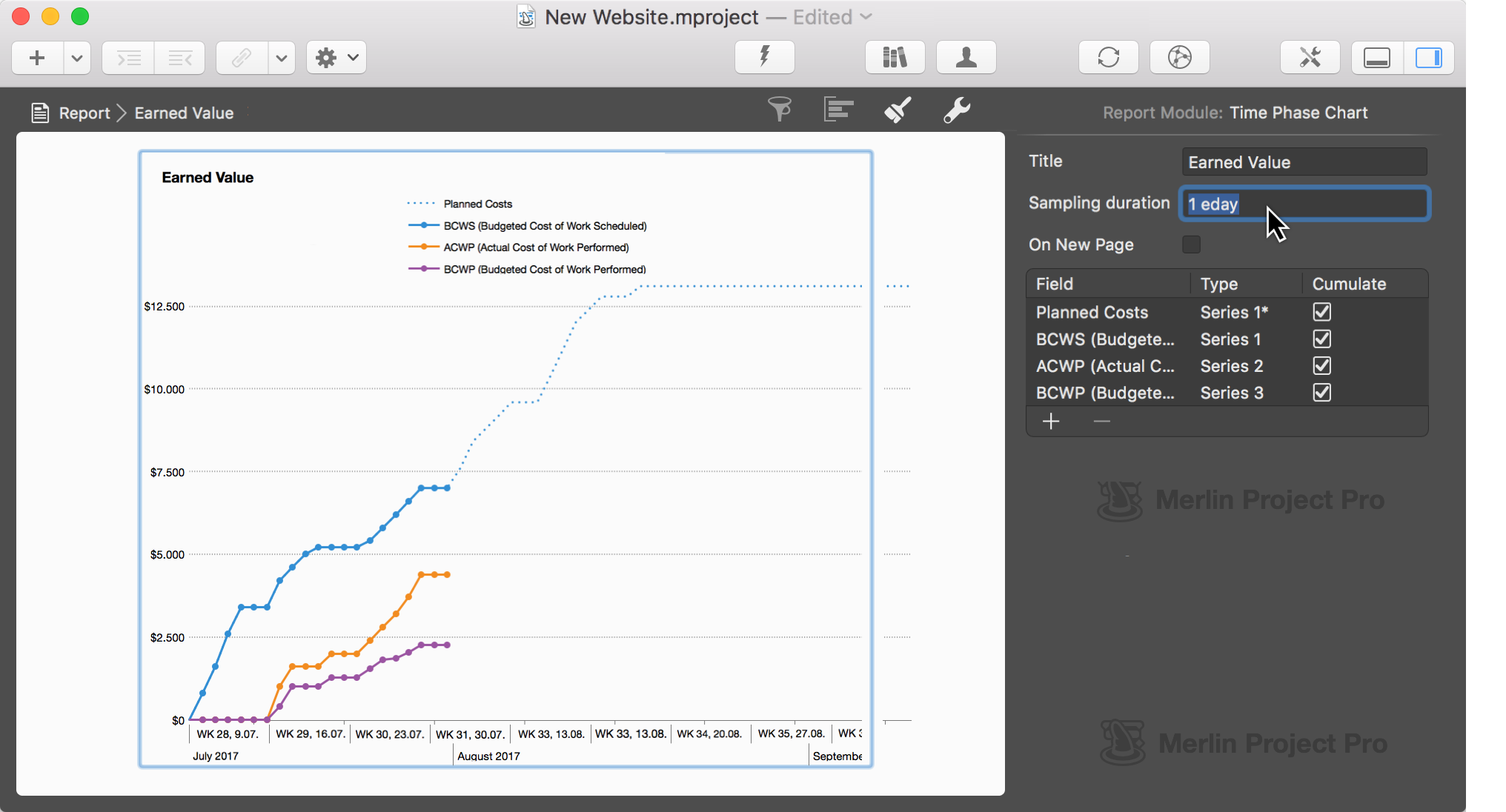
The accuracy of the chart increases because the values are calculated per consecutive day.
|
|
If you select a long sampling duration, the information is displayed linearly in the chart. |
In Merlin Project you can customize existing report views and save them as new views using custom report modules. In this example, switch to Report → Budget/Cost Overview.
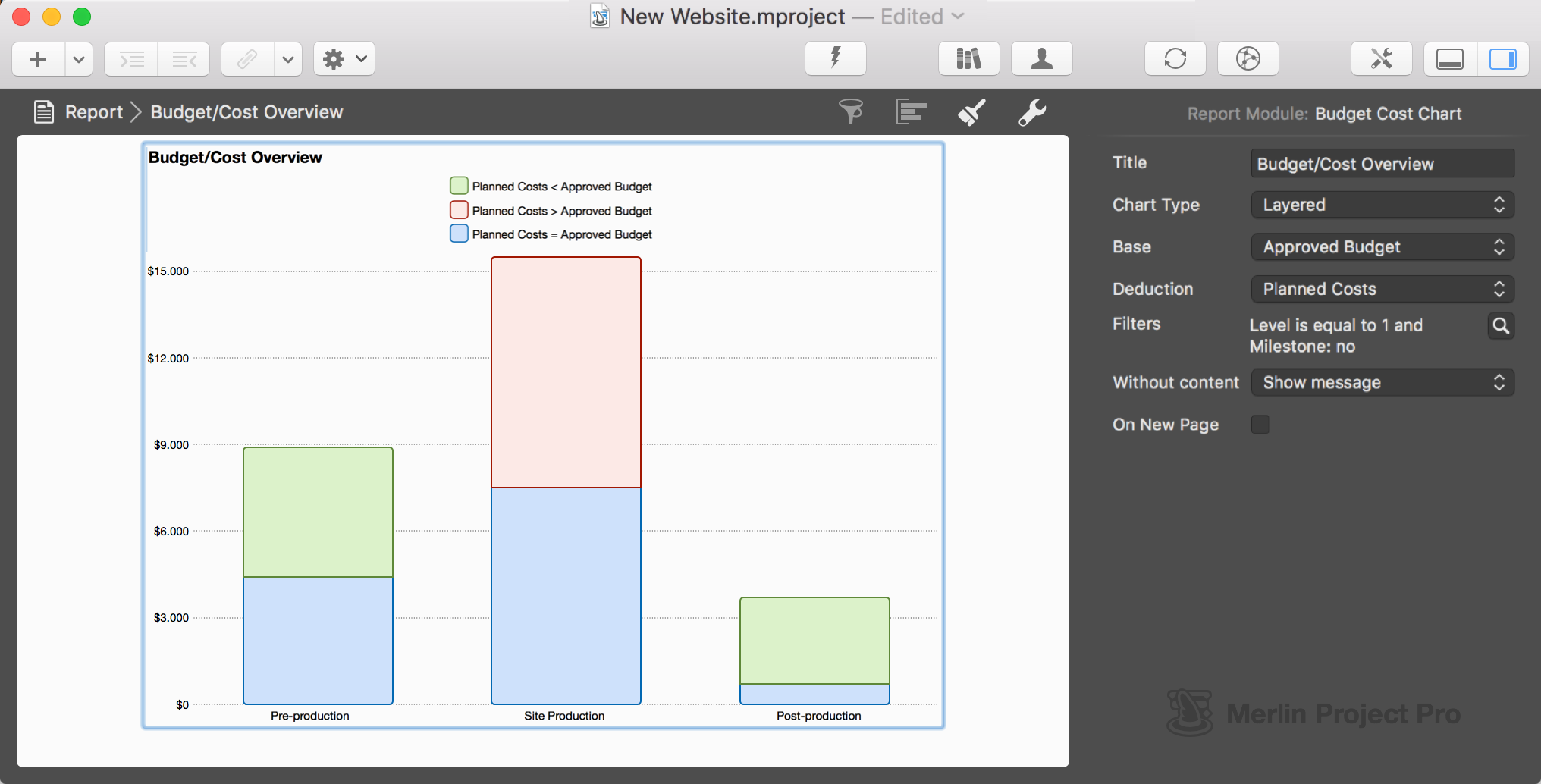
Under the View menu item, click Reports > Edit.
Select the Budget/Cost Overview view, then click the plus icon to duplicate the view.

Name your custom report and click Activate.
Delete the Budget Cost Chart and insert the Bar Chart module.
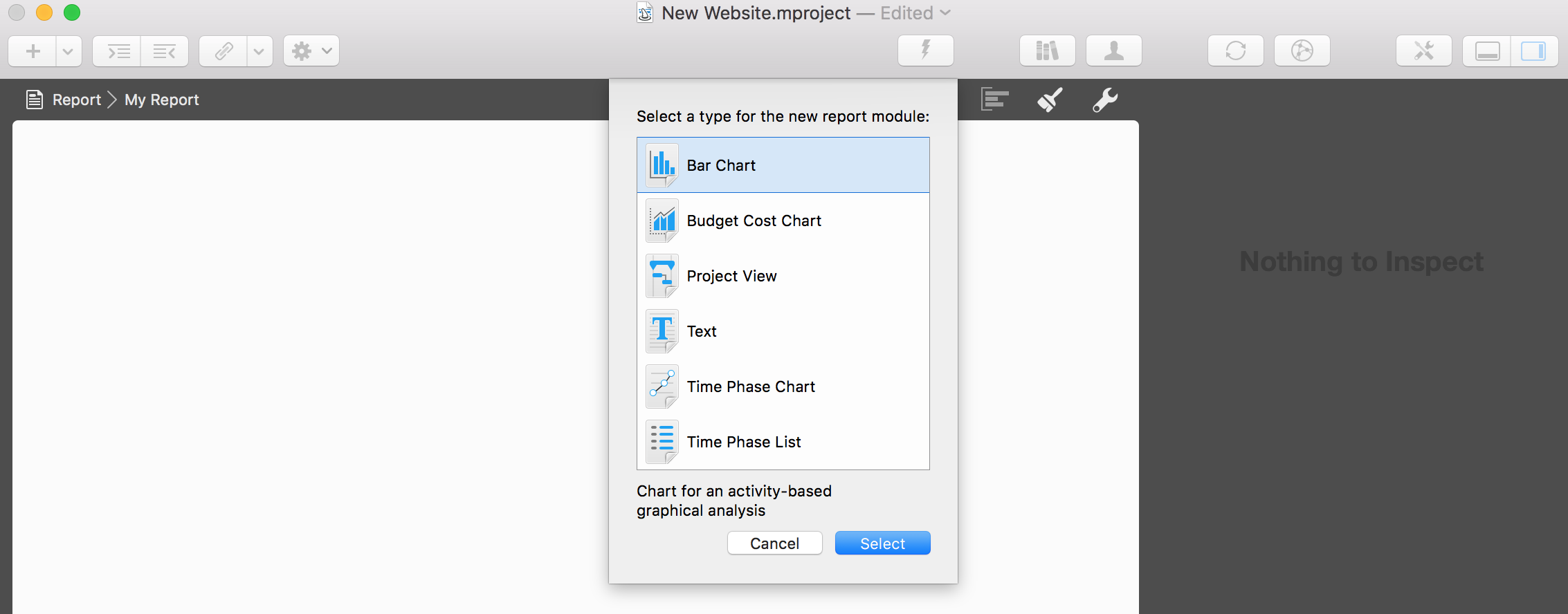
Edit the title (e.g. Work). Activate the filter by clicking the magnifying glass. Configure the filter setting for All Resources except the Default Resource.
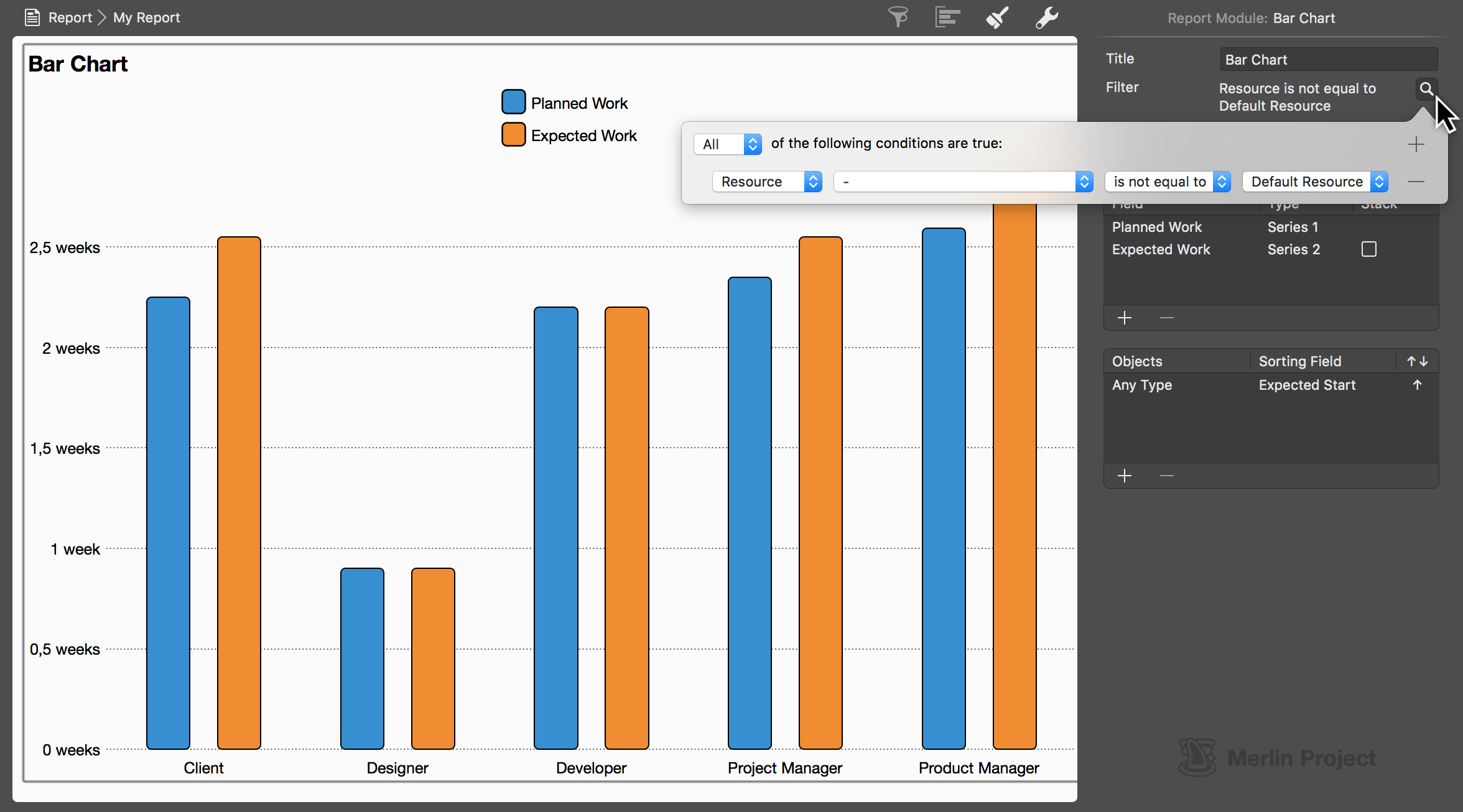
Add the Project View report module.
Set Type to Resource and View to Costs. Activate the Filter for Real Resources. Set the Grouping to Role.
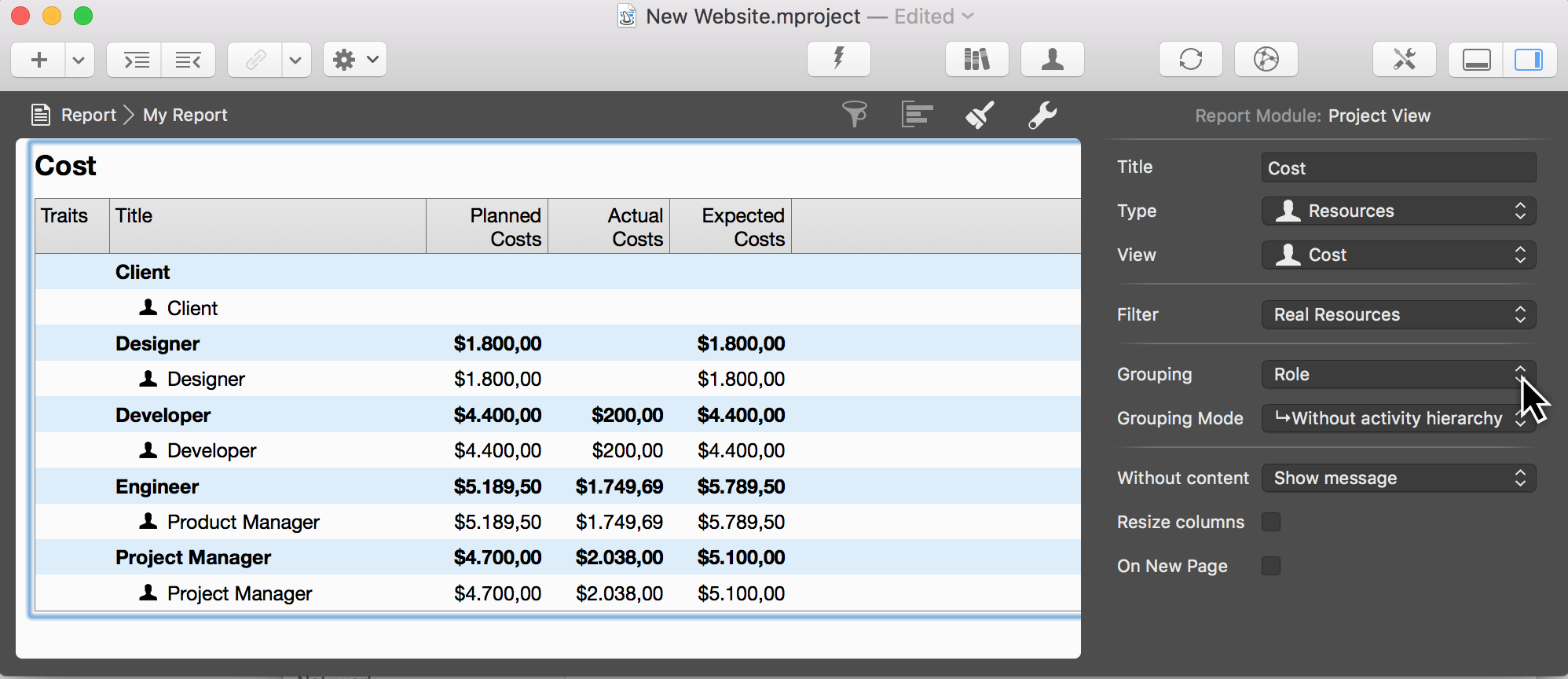
The result shows you all resource costs filtered by real resources and grouped by role.
Sharing the report view with other local documents
Under the Display menu item, select Reports → Edit.
Select a desired report view.
Click the gear icon and then click Share with other local projects.
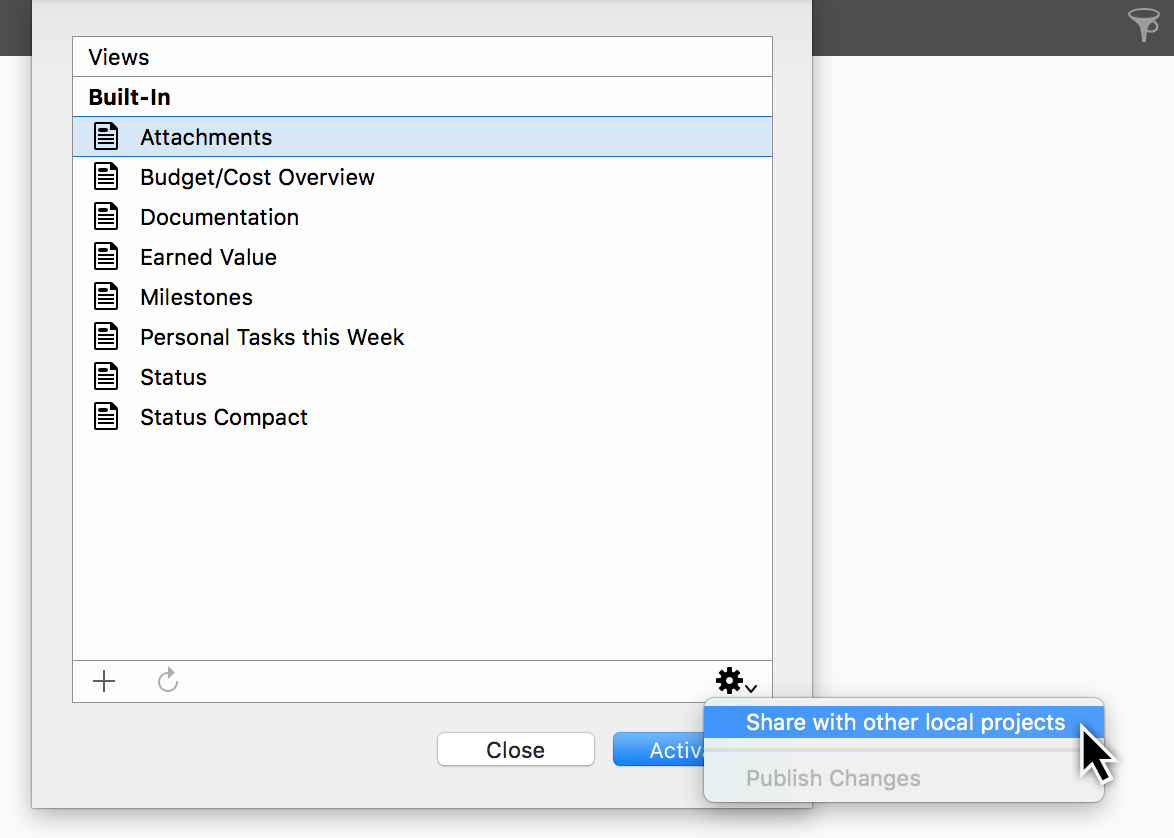
Earned value
The Earned Value analysis relates to the current status date.
For a better overview of the calculations:
-
Switch on the time line first. It shows a vertical line in the Gantt for the status date of the project.
-
Is the time line not onto today’s date? Check the configured project status date: *Settings > General > Status Date
Is the Status Date set to another specific date?
-
Keep this date if entered it intentionally,
-
or set to automatic for today’s date.
How values are calculated
BCWS corresponds to the budgeted costs up to the current status date in the project
ACWP corresponds to the actual costs up to the current status date in the project.
BCWP indicates the original budget cost of work performed so far. Merlin uses the current completion value whereby it utilizes the planned values (gray bars) to calculate the costs as if the planned bars had already been completed.
The Schedule Variance is calculated from: BCWP - BCWS
The Cost Variance is calculated from: BCWP - ACWP
The Cost Performance Index (CPI) is calculated from: BCWP/ACWP
The Total Cost Estimate is calculated from: ACWP + ((Planned Costs - BCWP) / CPI)
The Variance at Completion is calculated from: Planned Costs - Total Cost Estimate
|
|
All Earned Value fields contain only values up to the project’s current status date. |
Combine projects
If you want to run overall reports on your various projects, view or solve over-allocations due to overall assignments on their resources or simply work with your multiple project files in one Gantt chart, Kanban board, Mind Map etc you need to combine them into one, Master, file.
With Merlin Project you can combine your project files using drag & drop or the menus.
Combine projects by drag & drop
The quickest way to create a project with at least two sub-projects is to:
-
Create a new empty project
-
Name the project so you can easily identify it (e.g. Master Project)
-
Move at least two project files from a Finder window to the outline of the new Master Project.
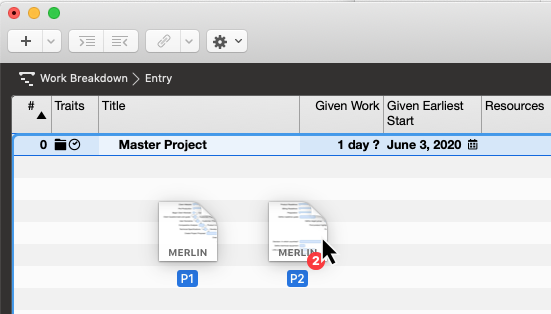
-
The program will prompt you following options:

-
Cancel
-
Attach
-
Create sub-project
-
Copy Content
-
Select Create sub-project or Copy Content depending on your needs.
-
Select Create sub-project to link the individual files as sub-projects and combine them into the Master project.
This option allows you to edit the contents in the Master or in the individual sub-projects. Changes will be kept synchronized once saved in both directions. This is equivalent to having combined by the Combine Documents menu item.
Select Copy Content to copy the content from the individual project files into the Master project. This won’t link to the individual files as sub-projects as they remain separate entities. So changes to the main project won’t get transferred to the individual projects, or vice versa.
Use this option:
-
if you don’t need to organise your work anymore in multiple files
-
or need a snapshot of the current state of your individual files in the Master file and maybe intending to create new Master files on later time points as further snapshots to be able to compare your overall progress with past values.
Select Cancel to abort further actions.
Select Attach to insert the files as File Attachments onto the row #0 of the empty project. This is not an option to choose when requiring the contents of the individual files in one Gantt, Kanban, Mind Map, etc.
Combine projects by menu
In Merlin Project you can also combine and link sub-projects by a menu option.
-
Call File > Combine Documents…
-
Click on '+'
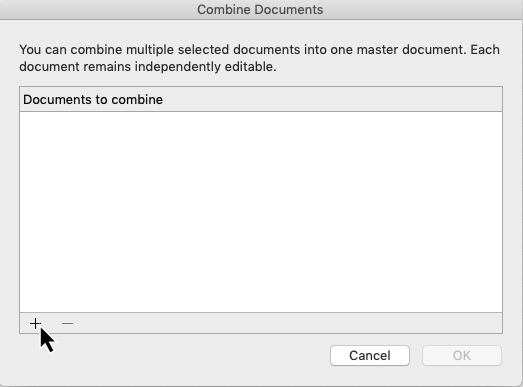
-
Select your individual files
-
Click 'Ok'
If the files you want to combine are currently open in Merlin Project, they will be listed in the '+' menu of the Combine Documents… dialogue so you can select them easily.
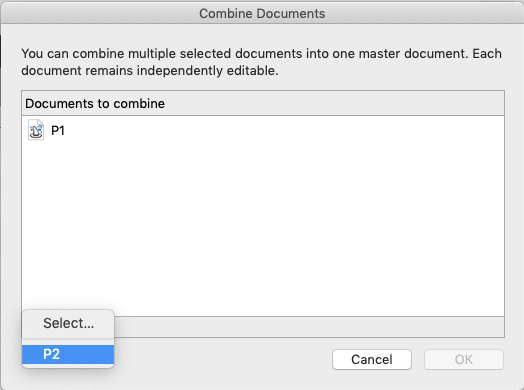
Insert projects
You can insert a project and link it as a sub-project in an existing project file also by clicking the '+' toolbar icon and selecting 'Project…'
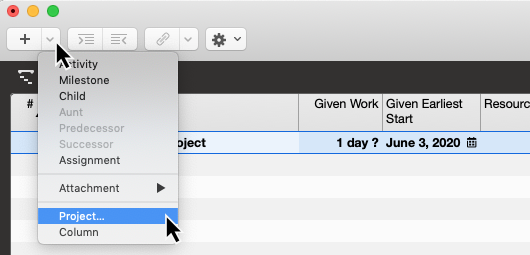
The same option is offered over the Insert menu.
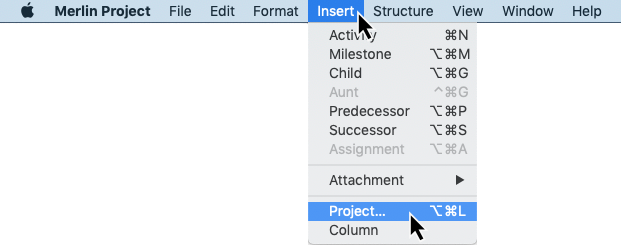
This is recommended when you have an existing Master Project in which you would like to insert further project files and manage them in the same master.
Work Areas
With Work Areas you can work on shared projects independently and separately from the other users.
Click the toolbar icon to access this function.
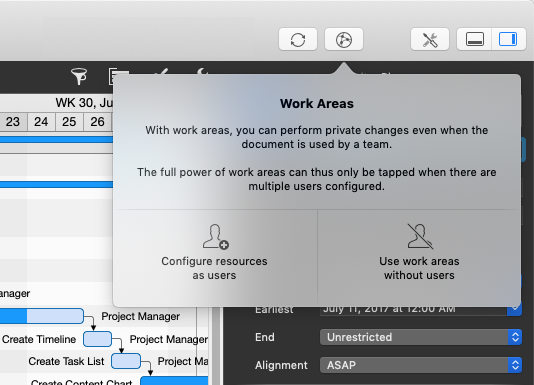
Configure resources as users or choose to Use work areas without users.
The active Work Area is depicted as an icon and shaded in the dialogue. You can switch between following work areas:
-
Public Work Area (default)
Public Work Area
All changes are made by default in the Public Work Area and are therefore visible to all users and any devices accessing the project. When the globe and the Public Work Area text are shaded, the Public Work Area is the active work area.
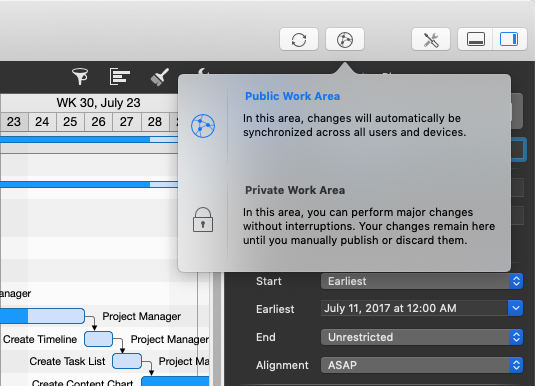
Private Work Area
Click on the padlock to switch to the Private Work Area.
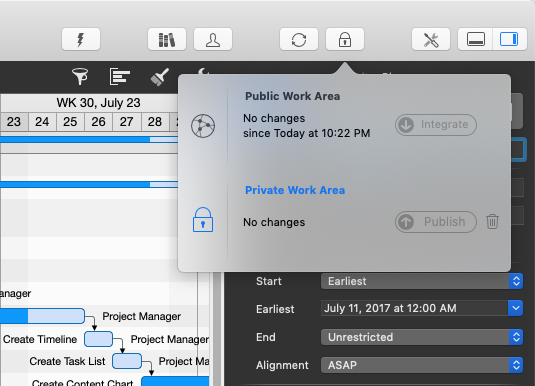
The padlock icon in the toolbar indicates that you are working in the Private Work Area.
As you perform changes in your private work area, the dialogue provides more information and options.
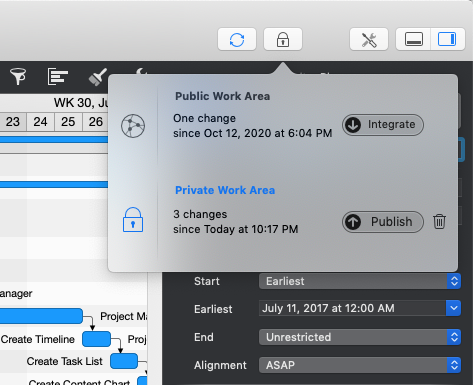
You see
-
The number of changes made by others in the Public Work Area.
-
An Integrate button to integrate changes made by others in the Public Work Area into your current Private Work Area.

-
The number of changes you made since you switched to the Private Work Area.
-
A Publish button to transfer your private changes and make them visible to all other users accessing the project in the Public Work Area.
-
A Trash icon to delete changes made in the Private Work Area. Doing so, you reset your Private Work Area.
Click onto the globe or the Public Work Area text, to switch back to the Public Work Area.
|
|
Switching from the private to the public work area or vice versa, does not automatically integrate or publish any changes from the various work areas. |
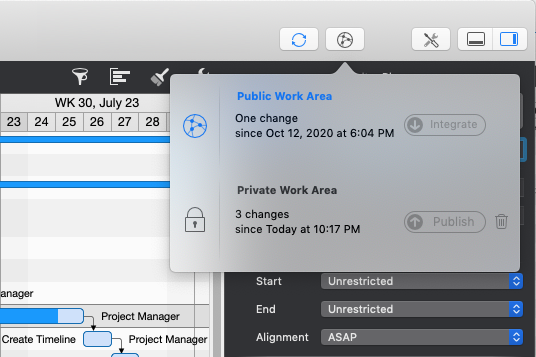
Central License Management
The Central License Management options are only available if you downloaded Merlin Project from our Website.
Extend Subscription
|
|
This option is only available if you downloaded Merlin Project from our Website. |
To extend the amount of users in your single user subscription, enter the Manage Existing Subscription settings and click on Extend Subscription.
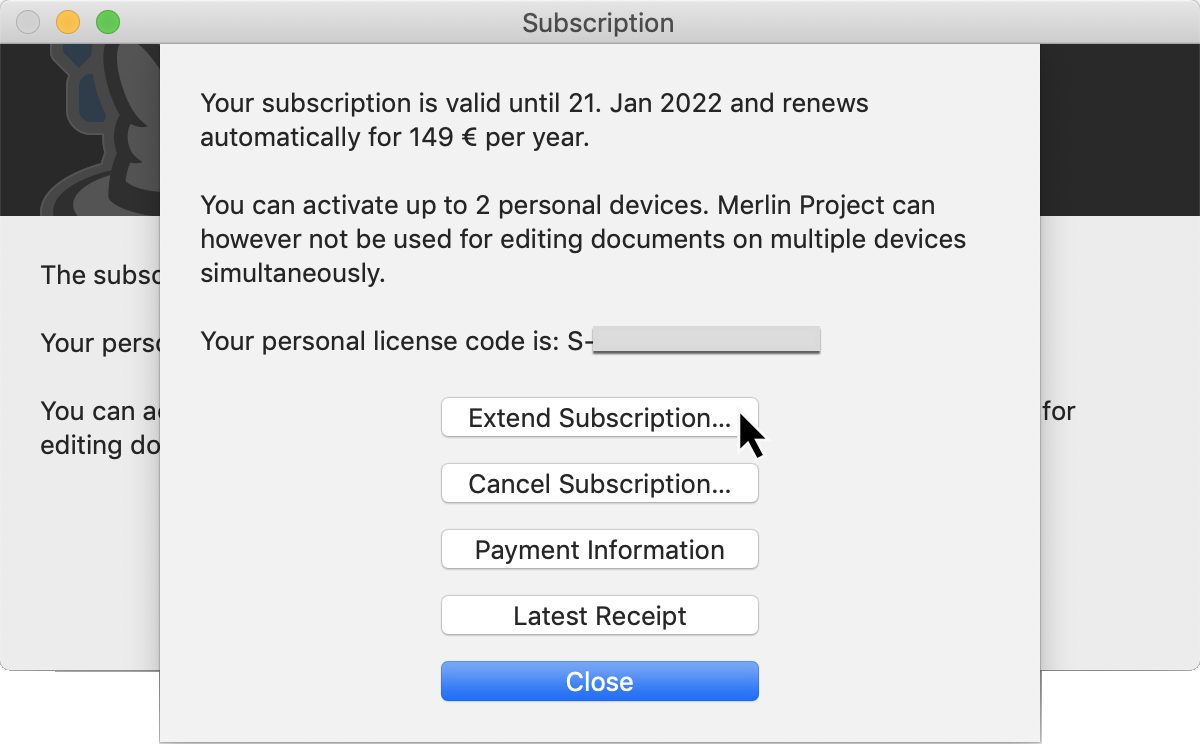
In the following dialog, select the desired amount of additional users.

Activate Team Device
|
|
This option is only available if you downloaded Merlin Project from our Website. |
For subscriptions with more than one user licenses (Multi User Subscriptions), call from the menu Merlin Project > Subscription and click on Activate Team Device.
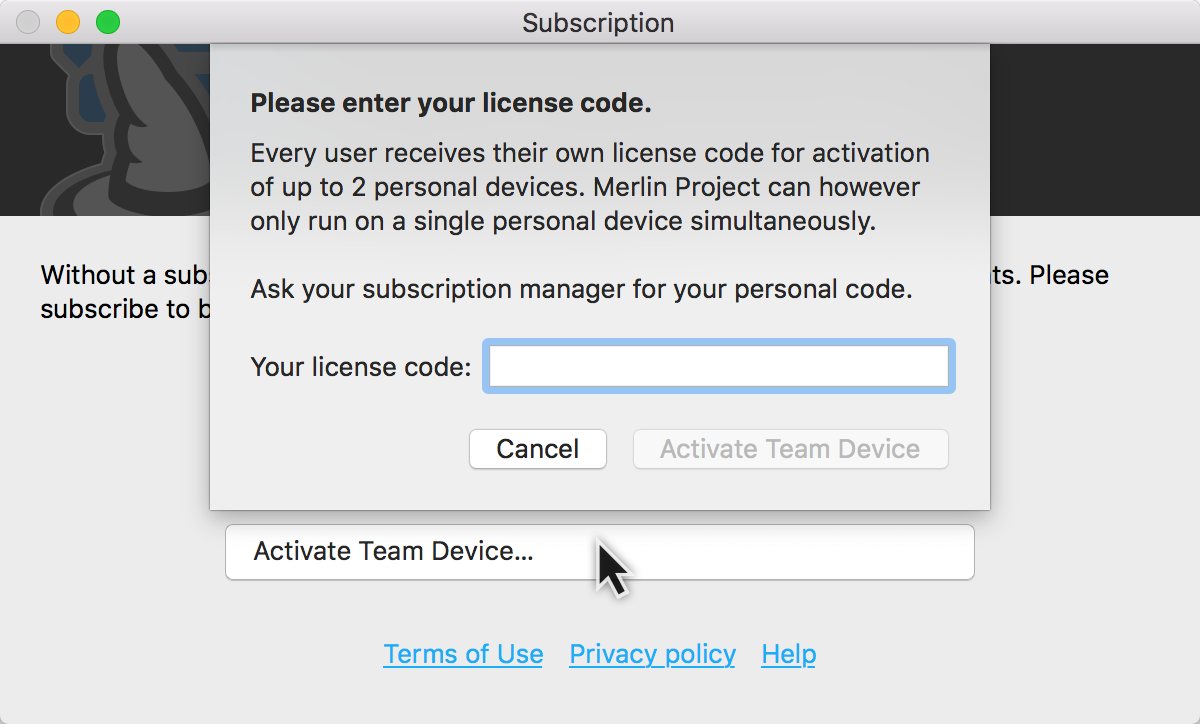
Enter a valid license code for this team device to use.
|
|
You may also use this option if you want to activate your subscription on another macOS device without entering your email and password credentials when knowing your license number. |
When administering a Multi User Subscription, read here how to share a license code with your team members.
Deactivate Device
|
|
This option is only available if you downloaded Merlin Project from our Website. |
To deactivate a specific mac from a running subscription, go to Merlin Project > Subscription.
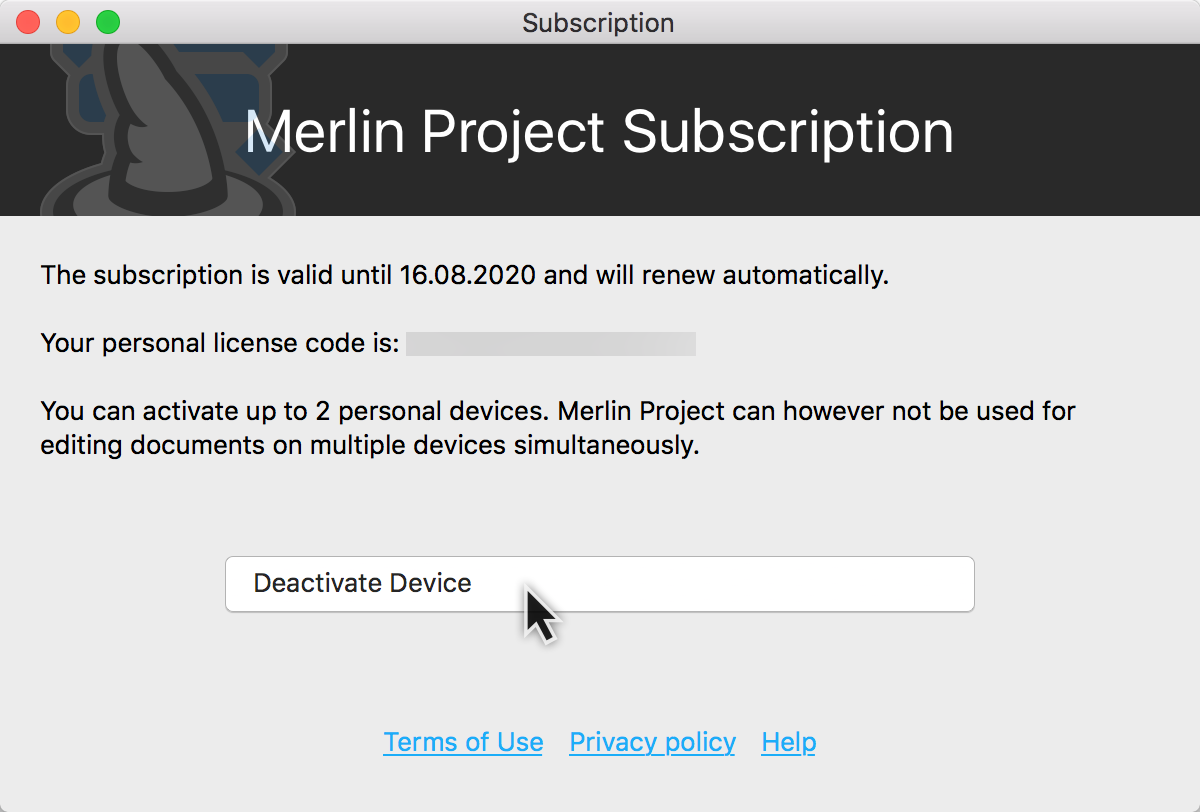
Press and hold the alt key. The Manage Existing Subscription button will change to Deactivate Device. Click on Deactivate Device.
|
|
This option does not cancel the subscription, it only frees a device where the subscription had been activated. |
Activate This Device
|
|
This option is only available if you downloaded Merlin Project from our Website. |
Do you have a single user license on one device and need to use it on a second mac? Open Merlin Project on the second mac and call Merlin Project > Subscription. Click Manage Existing Subscription. Enter the Email and Password for your subscription and click Continue…. Now click Activate this device….

|
|
Use the option Activate this device if you clicked on Deactivate Device by mistake. |
Payment Information
|
|
This option is only available if you downloaded Merlin Project from our Website. |
Your payment information has been stored for recurring payment at the time of subscription. To update this information, e.g. if your credit card has expired in the meantime, go to Merlin Project > Subscription panel.
-
Click onto Manage Existing Subscription
-
and in the following window on Payment Information
-
Enter the login data you defined as you subscribed the app
You will be forwarded to our billing partner Paddle where you can enter your credit card details for the next payment.
When you complete your changes, Paddle will confirm the successful update of your payment data.
Multi User Subscriptions
|
|
This option is only available if you downloaded Merlin Project from our Website. |
To manage a multi user subscription, enter the Manage Existing Subscription dialogue.
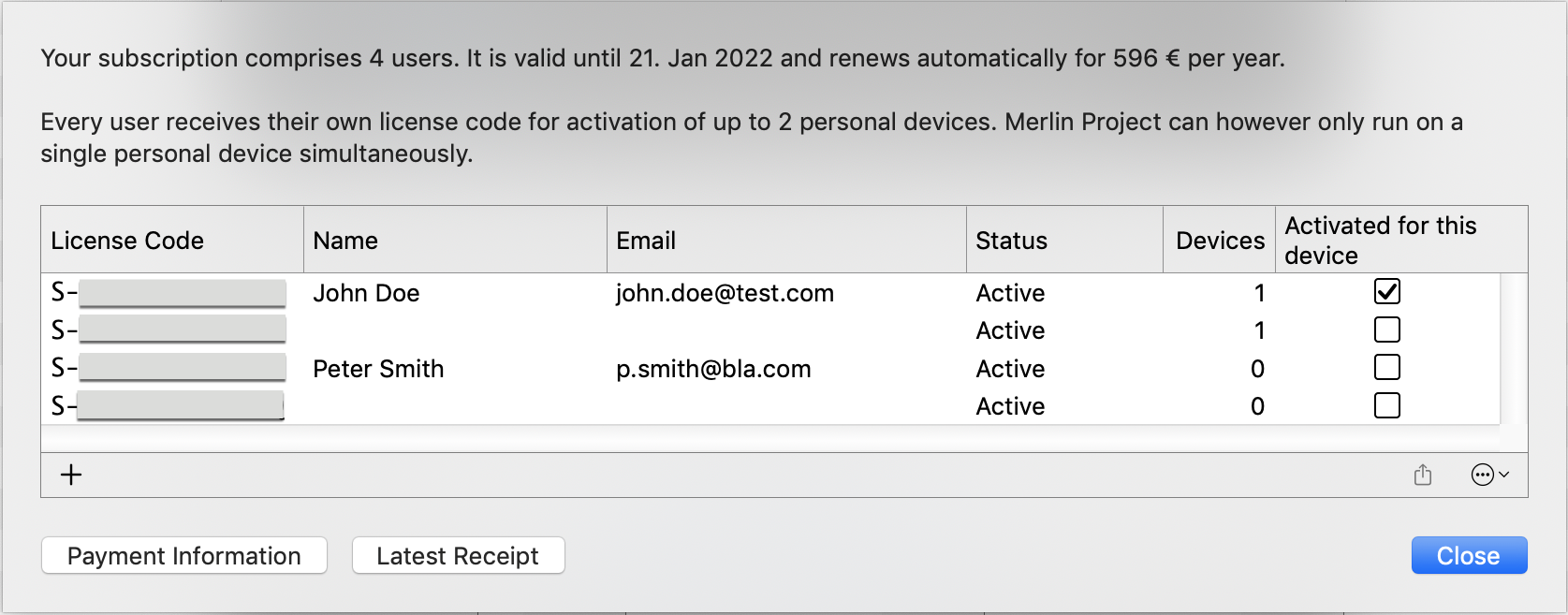
The dialogue lists all purchased licences and their individual information:
-
License Code
-
Name
-
Email
-
Status
-
Devices
-
Activated for this device
Name and email is optional information which you can fill in to easily identify the user of an individual license code.
Status shows if a license is still active or canceled.
Devices shows the amount of devices on which the individual license code was entered.
A checkbox in the Activated for this device column indicates that a license had been activated on this mac.
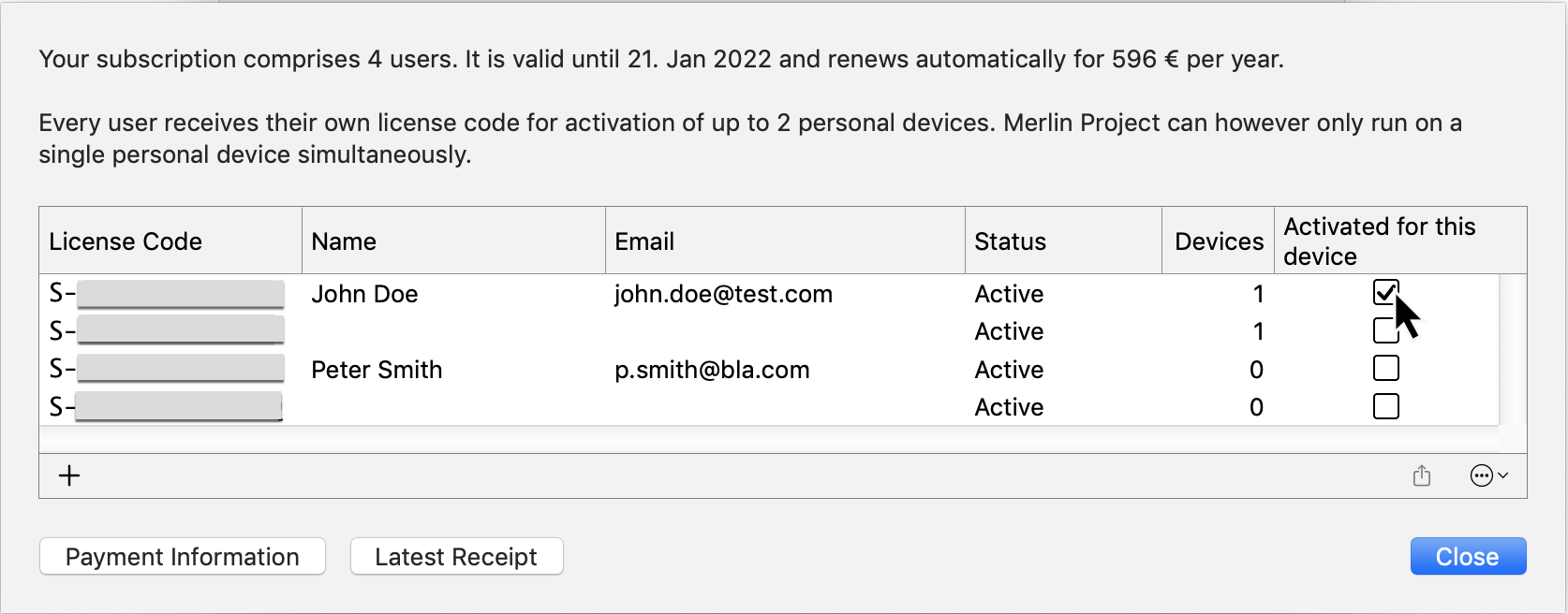
Extend Multi User Subscriptions
|
|
This option is only available if you downloaded Merlin Project from our Website. |
In the bottom left corner of the list you’ll find a '+' icon. Click there to purchase further licenses for your subscription.
In the following dialog, select the desired amount of licenses for additional users.
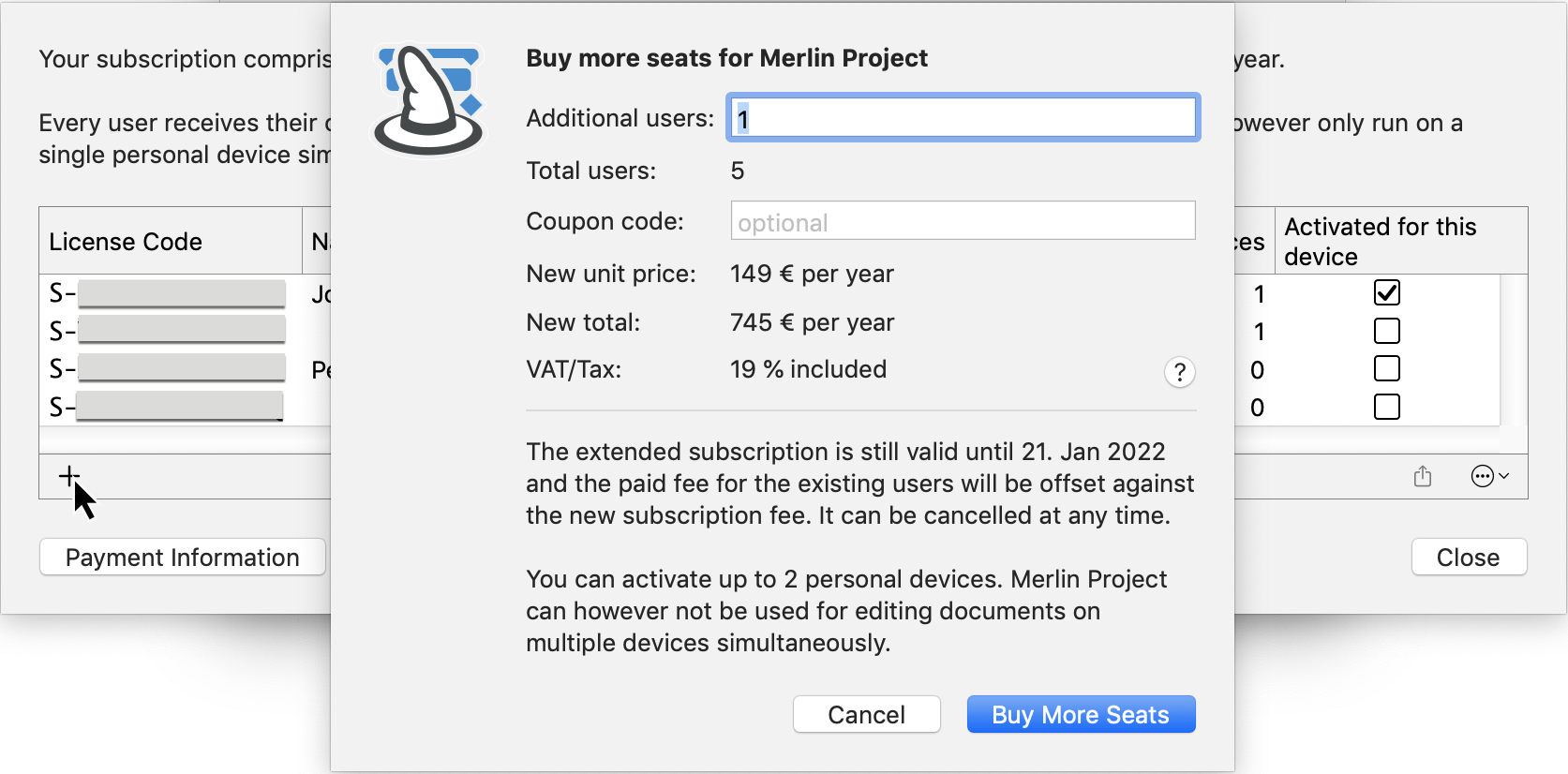
Further Options
In the bottom right corner of the list, you’ll find two icons:
-
Share (to forward a specific license to your users)
-
(…) button (for Additional Options)
To forward license codes to your users, use the Share option.
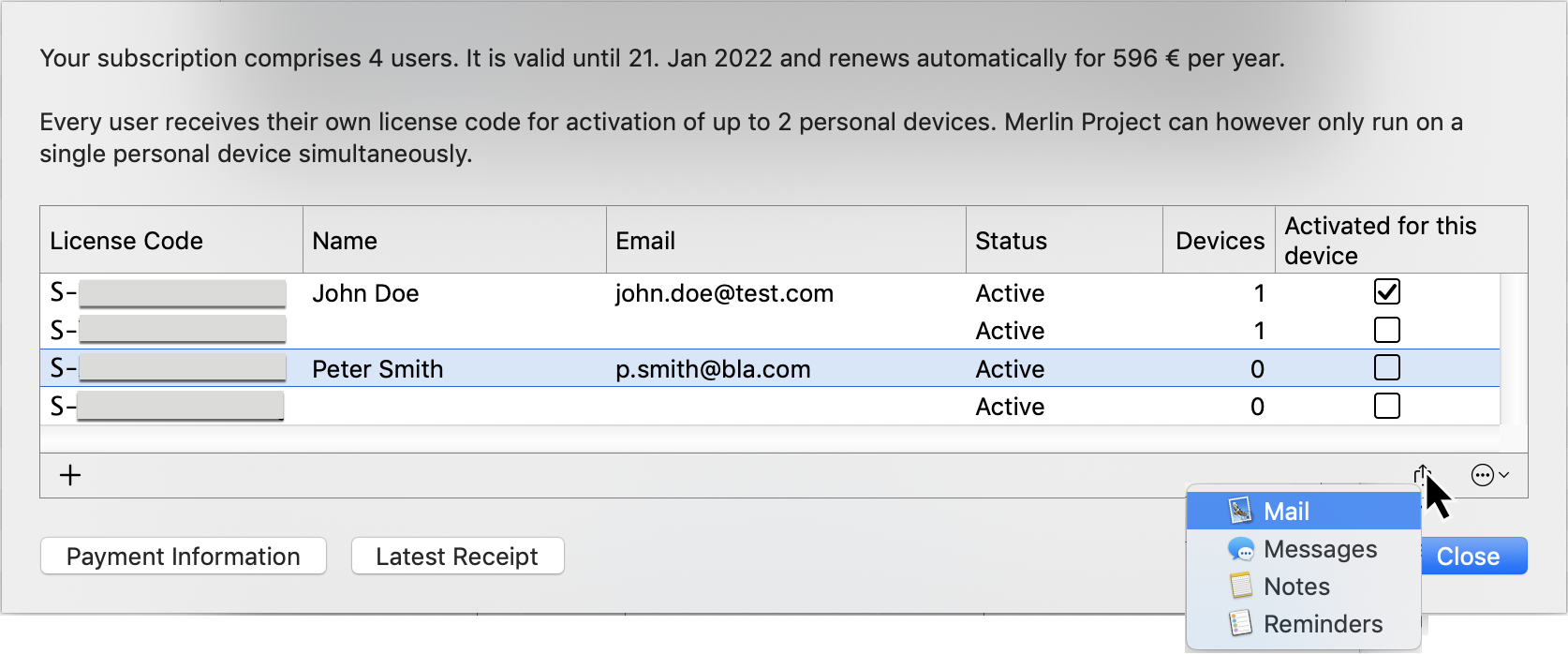
Select first one or more licenses from the list. Click the Share icon and select one of the offered options:
-
Mail
-
Messages
-
Notes
-
Reminders
Choose Mail or Messages to send the license code to the various users by those services. The users can then apply this information to activate their team device.
Choose Notes to save all related information of the selected license(s) to the Notes.app.
For additional options regarding your multi user subscriptions, use the (…) icon.
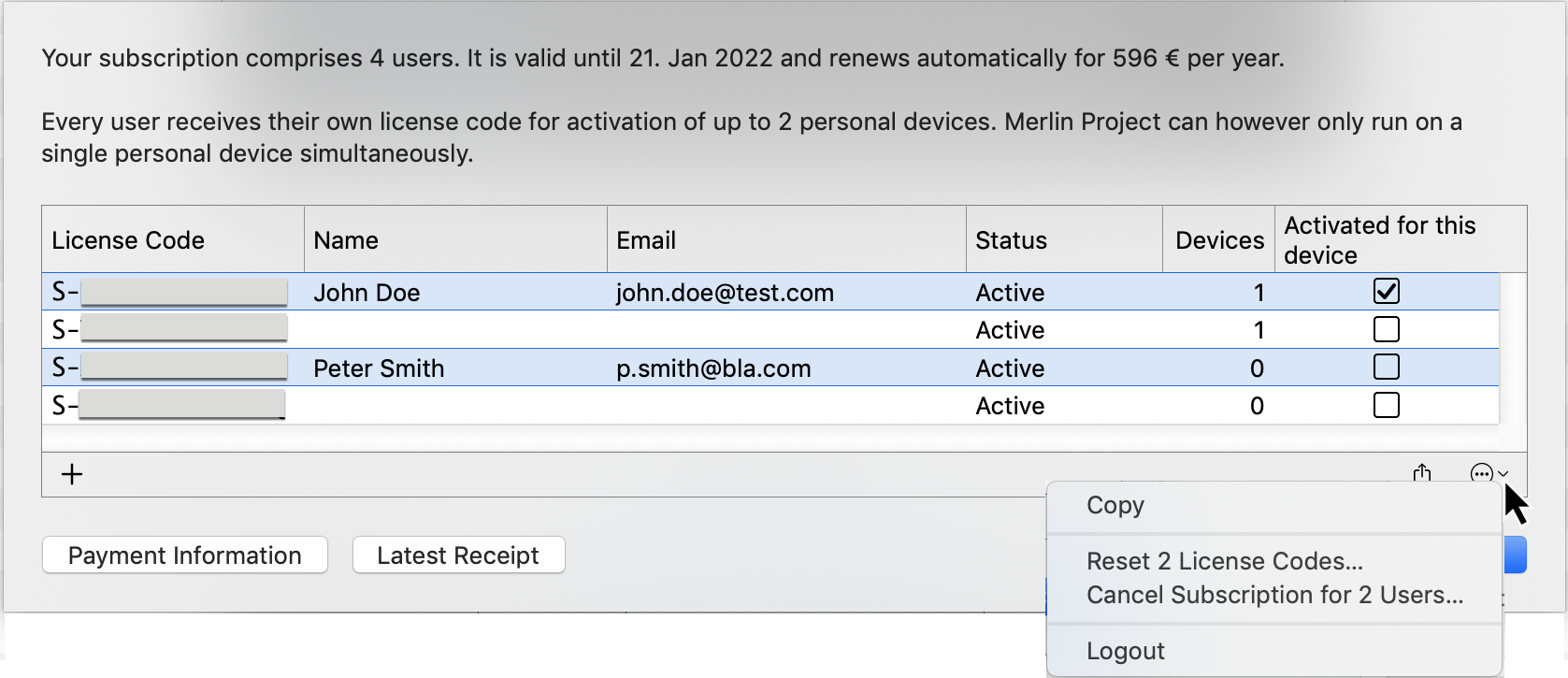
Select first one or more licenses from the list. Click the (…) icon and select one of the offered options:
-
Copy
-
Reset n License Codes…
-
Cancel Subscription for n Users…
-
Logout
To copy all related information of the selected license(s) to the clipboard, use this option.
Use the option Reset n License Codes… to free a license which you gave to a user who is no longer by the company. You can forward afterwards the new generated license code for the free license to another user.
To Cancel Subscription for n Users use this option.
If you like to manage another subscription account, select Logout to be able to login again.
Appendix…
Traits column
Trait column icons
The Traits column contains various icons.

These icons result from different entries already made by the user in the project.
| Icon | Name | Meaning | Note |
|---|---|---|---|
|
Project |
Row #0 is the project row and is always marked with this icon. |
When projects are collapsed, the sub-projects are marked using this icon. |
|
Attachment |
This icon indicates that an activity includes one or more attachments. |
Groups, milestones, and assignments also support attachments. |
|
Alignment »ASAP« |
An activity, group, or milestone is aligned with an early start. |
This icon is only displayed with backward-planned projects. In a forward-planned project, all activities, groups, and milestones are assigned ASAP starts automatically. |
|
Alignment »ALAP« |
If an activity, group or milestone in a forward-planned project is aligned with a late start, this icon appears. |
|
|
Ellipsis |
This icon indicates that further information is available in the Traits column, but not all of it is visible. |
Change the column width to display all the icons. |
|
Calendar |
This icon indicates that the activity has a specified calendar. |
The selected calendar is shown in the »Advanced« options of the »Plan« tab in the inspector. |
|
Date |
This icon indicates that the activity has a fixed date. |
Use the »Plan« tab in the inspector to see any activity start or end dates entered. |
|
Note |
This icon indicates this item has a note. |
Click on the icon, it opens the »Notes« tab in the inspector. |
|
Resource Pool |
This icon means that the resource comes from a resource pool. |
|
|
Comments |
This icon indicates that this item includes one or more comments. |
Click on the icon, it opens the tab for comments in the Inspector. |
|
Unread Comments |
This icon indicates that this item includes one or more unread comments. |
Click on the icon, it opens the tab for comments in the Inspector. |
Planning conflicts
If logical problems occur during planning, planning conflict symbols appear in the Traits column.
| Icon | Name | Meaning | Note |
|---|---|---|---|
|
Planning conflict (weak) |
This icon indicates that the activity has at least one weak planning conflict. |
Click the icon. A »Notifications« window will open with a list of all planning conflicts in the project together with further information. |
|
Planning conflict (strong) |
This icon indicates that the activity has at least one strong planning conflict. |
In contrast to a weak conflict, a strong planning conflict prevents planning. This could be because the activity commences before the project starts. This issue will need to be resolved. |
Title column
The title column includes the titles of the activities, groups, milestones, and assignments. Two icons are used in the title column: one black and one light triangle.
The triangles indicate groups (black) and assignments (light).
Group
This icon indicates a group. Click the triangle to expand or collapse the group.
This allows you to show or hide all group content.
Assignment
This icon indicates that an activity, group or milestone has one or more assignments. Click the triangle to see the assigned resource.
|
|
The menu items Structure → Expand and Structure → Collapse let you expand or collapse several groups and assignments simultaneously. |
Given values
Given values are presets required for planning. As a project manager, you choose the presets based on your experience and other requirements for the planned course of the project.
Given values can be used to define work, duration, start and end dates, calendar and alignment settings for the respective activities in the project.
Insert a new column and type Given. Merlin Project will list all columns with Given values that are available for the project and its individual elements.
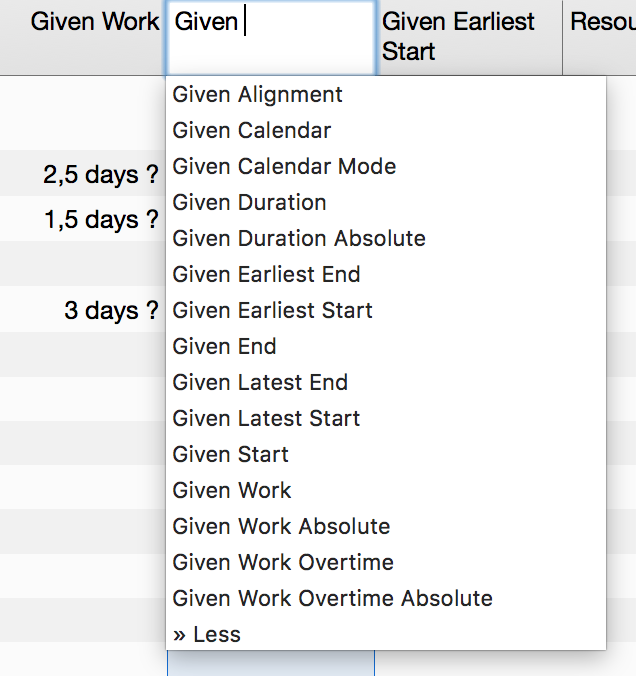
The Given presets for work, duration, start, and end are most frequently required for planning. They can be visible in the outline or hidden if not required. Most of the Given values are editable in the outline and the Plan inspector.
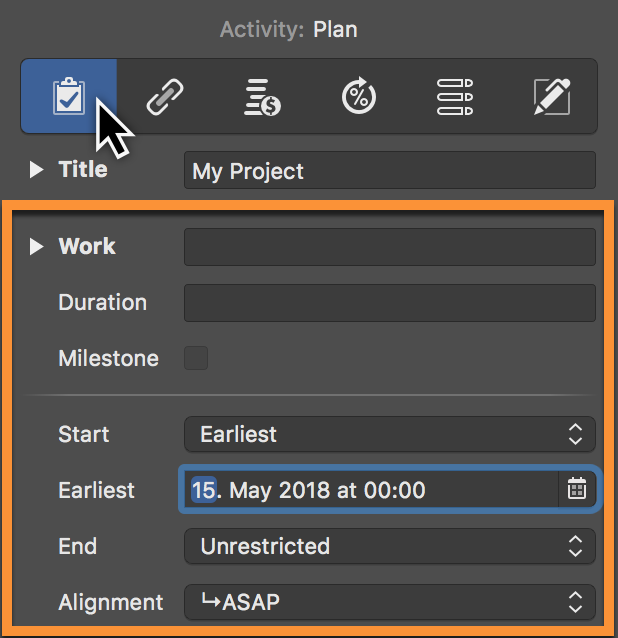
|
|
For dynamic planning, simply configure a preset for the work or duration and link the activities, groups, and milestones using dependencies. Merlin Project will then calculate the Planned and Expected values from the presets. |
Given Work
Per default new activities are created by a Given Work of '1 day ?'.
You can choose to show the value of Given Work in the outline and edit it there. The value of Given Work is also shown in the Work field of the Plan inspector, where you can also edit it.
Given Work Absolute
Given Work Absolute is a calculated value and cannot be edited.
You can choose to show the value of Given Work Absolute in the outline.
It calculates based on the value of Given Work. If you enter the Given Work as time duration, Given Work Absolute calculates the same value.
If you enter the Given Work as a fraction of the work, Given Work Absolute calculates the amount based on the Given Work defined in a higher level activity group.
Activity group is defined by effort of 10 days, thus Given Work 10 days. Child activity within is defined by 25% of the effort, thus Given Work 25% The Given Work Absolute of the child activity will calculate as 2.5 days.
Given Duration
Per default new activities are created by blank duration. That means, that the Given Duration column is empty and that Given Work value defines the duration of the activity as well.
To change the Given Duration of existing activities, select the activity row and use the Plan inspector to enter the desired value in the Duration field.
You can choose to show the value of Given duration in the outline and edit it there.
Given Start / End
Per default new activities are created by blank start or end dates. That means, that Given… date columns are empty and that dependencies or the date constrains and durations of higher level activity groups define the start or end of the new activities.
To set a Given Start for an existing activity, select the activity row and use the Plan inspector to select a Precise Start or End date.
|
|
For flexible planning and easier adjusting through-out your project’s life time, we recommend you define as less start and end dates as possible, and as many as absolutely binding to your deliverables. |
Given Earliest Start / Earliest End
Per default new activities are created by blank start or end dates. That means, that all Given… date columns are empty and that dependencies or the date constrains and durations of higher level activity groups define the start or end of the new activities.
To set a Given Earliest Start or Given Earliest End for an existing activity, select the activity row and use the Plan inspector to select a Earliest Start or Earliest End date.
|
|
For flexible planning and easier adjusting throughout your project’s life time, we recommend you define as less start and end dates as possible, and as many as absolutely binding to your deliverables. |
Given Latest Start / Latest End
Per default new activities are created by blank start or end dates. That means, that all Given… date columns are empty and that dependencies or the date constrains and durations of higher level activity groups define the start or end of the new activities.
To set a Given Latest Start or Given Latest End for an existing activity, select the activity row and use the Plan inspector to select a Latest Start or Latest End date.
|
|
For flexible planning and easier adjusting throughout your project’s life time, we recommend you define as less start and end dates as possible, and as many as absolutely binding to your deliverables. |
|
|
If you have to define for an activity all four date values (Given Earliest Start, Given Latest Start, Given Earliest End, Given Latest End) select the activity row and use the Plan inspector to select Between for Start and End dates. |
Given Calendar
Per default new activities are scheduled according to the project calendar.
To change the Given Calendar of existing activities to another calendar of your project, select the activity row, use the Plan inspector, expand the Advanced options and select the desired item from Calendar list.
You can choose to show the value of Given Calendar in the outline and edit it there.
Given Alignment
Per default new activities are scheduled according to the project’s direction.
In a forwards planned project, new activities are inserted by the ASAP Alignment. In a backwards planned project, new activities are inserted by the ALAP Alignment.
To change the Given Alignment of existing activities, select the activity row, use the Plan inspector and select the desired option from the Alignment list.
You can choose to show the value of Given Alignment in the outline and edit it there.
Planned values
Merlin Project calculates planned work and duration for each activity based on the Given values. Planned values are read-only
The inspector outputs planned values for Start, End, Work, Duration, Elapsed Duration and Utilization in the Actual Values inspector.
If you have entered values in Given Start, Given End, Given Work, Given Duration and Given Utilization, the planned values will reflect them.
If not, Merlin Project will calculate them based on presets on dependencies, higher level activity groups or other default values.
An activity is defined by 2 days Given work to start due to its predecessor on Friday at 8am.
-
Planned Work calculate as Given Work, thus 2 days
-
Planned Start calculate as Friday at 8am
-
Planned End calculate as Monday at 5pm
-
Planned Duration calculate as 2 days
-
Planned elapsed Duration calculate due to the weekend in between as 3.38 edays
-
Planned utilization calculate as 100%
If you have defined cost rates on your resources, base or attachment costs on your activities, the Planned Costs will show up in the Finance inspector in the Balance tab.
Actual values
Actual values are the values you enter to record actual progress of your planning. You update this information as often as new information from your resources arises regarding the actual work or the completion level of the various assignments.
Insert a new column and type Actual. Merlin Project will list all columns with Actual values that are available for the project and its individual elements.
You can choose to show or hide them from the outline. Actual values are editable in the outline and the Actual Values inspector.
An activity is defined by 2 days Given work. You want to update the activity to reflect 50% completion level.
-
You select the activity
-
Use the Actual Values inspector
-
You select the correct date for Actual Start
-
You select 50% from the Complete list
This means:
-
Actual Work calculates as half of Given Work, thus 1 day
-
Actual Start is the date you just entered
-
Actual End is blank (the task isn’t completely done yet)
-
Actually Completed Through calculates the date until current completion.
An activity is defined by 2 days Given work, which was recorded as 50% completed is now completed.
-
You select the activity
-
Use the Actual Values inspector
-
Click on 100%
This means:
-
Actual Work is now as much as the original Given Work, thus 2 days
-
Actual Start is the date set
-
Actual End is the date the remaining 1 day work would need to complete
-
Actually Completed Through calculates the date until current completion, thus the same as Actual End.
An activity is defined by 2 days Given work, which was recorded as 50% completed, is now 75% completed but needs some 1 more day work as originally estimated.
-
You select the activity
-
Use the Actual Values inspector
-
Enter 75% in the Complete field
-
Check the value in the Remaining Work field
-
Adjust it from 4 hours to 12 hours
The overall activity will be adjusted and the new completion percentage will be calculated. It is now 100% * Actual Work / (Actual Work + Remaining Work) = 50%
This means:
-
Actual Work was originally 75% of the original Given Work, thus 1.5 days
-
Actual Start is the date set
-
Actual End is blank (the task isn’t completely done yet)
-
Actually Completed Through calculates the date until 75% completion was achieved.
If you have defined cost rates on your resources, base or attachment costs on your activities, the Actual Costs will show up in the Finance inspector in the Balance tab.
Expected values
Expected values reflect both Given and Actual values.
Expected values are read-only and you’ll find them in the Plan and Actual Values Inspector.
When an activity is not yet started, expected values reflect the Given values.
When an activity is started and actual values are entered, expected values reflect the Actual values.
An activity requires 2 days Given work. It is not yet started.
This means:
-
Expected Work calculates as Given Work, thus 2 days
-
Expected Duration calculates as Given Duration. If Given Duration is empty the duration it needs according to the Given Work and defined assignments.
-
Expected Start calculates as Given Start. If Given Start is empty, the date it can be scheduled due to dependencies to predecessors or higher level groups.
-
Expected End calculates as Given End. If Given End is empty, the date it can be scheduled to end due to dependencies to predecessors or higher level groups and its defined duration.
An activity is defined by 2 days Given work and by 50% completed.
This means:
-
Expected Work calculates as Actual Work plus Remaining Work, thus 2 days
-
Expected Duration calculates as the duration until 100% completion.
-
Expected Start calculates as Actual Start
-
Expected End calculates the date until 100% completion
An activity is defined by 2 days Given work and as 50% completed, remaining work was updated to 12 hours. This recalculates a complete of 40%.
This means:
-
Expected Work calculates as Actual Work plus Remaining Work, thus 2.5 days
-
Expected Duration calculates the duration until 100% completion
-
Expected Start calculates as Actual Start
-
Expected End calculates the date until 100% completion of the new Expected Work
An activity is defined by 2 days Given work and as 40% completed, Actual work was 1 day, Remaining work 12 hours. The activity was completed by a click to '100%'. This recalculates Remaining work to blank value, its amount will be added to the Actual Work.
This means:
-
Expected Work calculates as Actual Work plus Remaining Work. Remaining Work is now 0, Actual Work is 2.5 days. That means Expected Work is 2.5 days
-
Expected Duration calculates the duration until 100% completion
-
Expected Start calculates as Actual Start
-
Expected End calculates as Actual End
If you have defined cost rates on your resources, base or attachment costs on your activities, the Expected Costs will show up in the Finance inspector in the Balance tab.